|

|
|
AGENDA
Ordinary Council meeting
Monday, 9 December 2024 &
Tuesday, 10 December 2024
|
|
I hereby give notice that an Ordinary meeting of
Council will be held on:
|
|
Date:
|
Monday, 9 December 2024
|
|
Time:
|
9.30am
|
|
Location:
|
Bay of Plenty Regional Council Chambers
Regional House
1 Elizabeth Street
Tauranga
|
|
Please note that this
meeting will be livestreamed and the recording will be publicly available on
Tauranga City Council's website: www.tauranga.govt.nz.
|
|
Marty Grenfell
Chief Executive
|
Terms of reference – Council
Membership
|
Chairperson
|
Mayor
Mahé Drysdale
|
|
Deputy Chairperson
|
|
|
Members
|
|
|
Quorum
|
Half of the members
present, where the number of members (including vacancies) is even;
and a majority of the members present, where the number of members
(including vacancies) is odd.
|
|
Meeting frequency
|
As required
|
Role
·
To ensure the effective and efficient governance
of the City.
·
To enable leadership of the City including
advocacy and facilitation on behalf of the community.
Scope
·
Oversee the work of all committees and
subcommittees.
·
Exercise all non-delegable and non-delegated
functions and powers of the Council.
·
The powers Council is legally prohibited from
delegating include:
○ Power to make a rate.
○ Power to make a bylaw.
○ Power to borrow money, or purchase or dispose of assets, other than
in accordance with the long-term plan.
○ Power to adopt a long-term plan, annual plan, or annual report.
○ Power to appoint a chief executive.
○ Power to adopt policies required to be adopted and consulted on
under the Local Government Act 2002 in association with the long-term plan or
developed for the purpose of the local governance statement.
○ All final decisions required to be made by resolution of the
territorial authority/Council pursuant to relevant legislation (for example:
the approval of the City Plan or City Plan changes as per section 34A Resource
Management Act 1991).
·
Council has chosen not to delegate the
following:
○ Power to compulsorily acquire land under the Public Works Act 1981.
·
Make those decisions which are required by
legislation to be made by resolution of the local authority.
·
Authorise all expenditure not delegated to
officers, Committees or other subordinate decision‑making bodies of
Council.
·
Make appointments of members to the council-controlled
organisation Boards of Directors/Trustees and representatives of Council to
external organisations.
·
Undertake all statutory duties in regard to
Council-controlled organisations, including reviewing statements of intent and
receiving reporting, with the exception of the Local Government Funding Agency
where such roles are delegated to the Accountability, Performance and Finance
Committee. This also includes Priority One reporting.
·
Consider all matters related to Local Water Done
Well.
·
Consider any matters referred from any of the
Standing or Special Committees, Joint Committees, Chief Executive or General
Managers.
Procedural matters
·
Delegation of Council powers to Council’s
committees and other subordinate decision-making bodies.
·
Adoption of Standing Orders.
·
Receipt of Joint Committee minutes.
·
Approval of Special Orders.
·
Employment of Chief Executive.
·
Other Delegations of Council’s powers,
duties and responsibilities.
Regulatory matters
Administration, monitoring and
enforcement of all regulatory matters that have not otherwise been delegated or
that are referred to Council for determination (by a committee, subordinate
decision‑making body, Chief Executive or relevant General Manager).
1 Opening
karakia
2 Apologies
|
Ordinary Council meeting Agenda
|
9 December 2024
|
7 Confirmation
of minutes
7.1 Minutes
of the Council meeting held on 29 October 2024
File
Number: A17251651
Author: Anahera
Dinsdale, Acting Team Leader: Governance Services
Authoriser: Anahera
Dinsdale, Acting Team Leader: Governance Services
|
Recommendations
That the Minutes of the
Council meeting held on 29 October 2024 be confirmed as a true and correct
record.
|
Attachments
1. Minutes
of the Council meeting held on 29 October 2024
|
Ordinary
Council meeting minutes
|
29 October 2024
|
|

|
|
MINUTES
Ordinary Council meeting
Tuesday, 29 October 2024
|
Order of Business
1 Opening karakia. 3
2 Apologies. 3
3 Public forum.. 3
4 Acceptance of
late items. 4
5 Confidential
business to be transferred into the open. 4
6 Change to the
order of business. 4
7 Confirmation of
minutes. 4
7.1 Minutes
of the Council meeting held on 26 August 2024. 4
7.2 Minutes
of the Council meeting held on 16 September 2024. 4
8 Declaration of
conflicts of interest 5
9 Deputations,
presentations, petitions. 5
Nil
10 Recommendations from other
committees. 5
10.1 Appointment
of Deputy Chair of Nga Poutiriao o Mauao. 5
11 Business. 5
11.1 Chief
Executive's Summary Report 6
11.2 Reforecasting
2024-25 Capital Programme Budget 6
11.3 Implications
of National Land Transport Programme 2024–27 on Transport Programme. 7
11.4 TravelSafe
funding. 10
11.5 Remuneration
fees for external representatives on Council Committees. 11
11.6 Delegations
Manual Review.. 13
11.7 Adoption
of 2023/24 Annual Report 14
11.8 Council-Controlled
Organisations' Annual Reports 2023/24. 15
11.9 Memorial
Park Aquatic Centre Update. 24
12 Discussion of late items. 25
13 Public excluded session. 25
13.1 Public
Excluded minutes of the Council meeting held on 26 August 2024. 26
13.2 Public
Excluded minutes of the Council meeting held on 16 September 2024. 26
13.3 483
Cameron Road - Sports Courts Refurbishment Project Funding Update. 26
13.4 Memorial
Park Aquatic Centre Updated Business Case. 27
11 Business (continued) 27
11.2 Reforecasting
2024-25 Capital Programme Budget (continued) 27
14 Closing karakia. 29
MINUTES
OF Tauranga City Council
Ordinary Council meeting
HELD
AT THE Bay of Plenty Regional Council
Chambers,
Regional House, 1 Elizabeth Street, Tauranga
ON
Tuesday, 29 October 2024 AT 9.35am
|
MEMBERS PRESENT:
|
Mayor Mahé Drysdale
(Chairperson), Deputy Mayor Jen Scoular (via Teams), Cr Hautapu Baker, Cr
Glen Crowther, Cr Rick Curach, Cr Steve Morris, Cr Marten Rozeboom, Cr Kevin
Schuler, Cr Rod Taylor
|
|
LEAVE OF ABSENCE:
|
Cr Mikaere Sydney
|
|
IN ATTENDANCE:
|
Marty Grenfell (Chief Executive),
Paul Davidson (Chief Financial Officer), Barbara Dempsey (General Manager:
Community Services), Nic Johansson (General Manager: Infrastructure),
Alastair McNeill (General Manager: Corporate Services), Gareth Wallis
(General Manager: City Development & Partnerships), Sheree Covell
(Treasury and Financial Compliance Manager), Kathryn Sharplin (Manager:
Finance), Susan Braid (Finance Lead Projects Assurance), Mike Seabourne (Head
of Transport), Karen Hay (Acting Manager: Safety and Sustainability), Caroline
Lim (CCO Specialist), Mike Naude (Director of Civic Development), Alison Law
(Manager Spaces and Places), Ross Hudson (Manager: Strategic Planning and
Partnerships), Helen Andrews (Financial Analyst), Coral Hair (Manager:
Democracy & Governance Services), Anahera Dinsdale (Acting Team Leader:
Governance Services), Aimee Aranas (Governance Advisor), Janie Storey
(Governance Advisor)
|
|
EXTERNAL:
|
Anton Labuschagne (Manager) and Leon Pieterse (Director)
- Audit NZ
Stephen Boyle - BOPLASS
Simon Clarke (Chair), Chad Hooker (CEO), Adam Ellmers
(CFO) and Nick Lowe, (Director) - Bay Venues
Rosemary Protheroe (Chair) and Sonja Korchina (Director)
-Tauranga Art Gallery
Russ Browne (Chair), Oscar Nathan (General Manager) and
Richard Beer - Tourism BOP
Kim Wallace (Chair) -Te Manawataki o Te Papa Ltd
|
1 Opening
karakia
Cr Hautapu Baker opened the meeting with a karakia.
2 Apologies
Cr Mikaere Sydney had been granted leave of absence
3 Public
forum
Nil
4 Acceptance
of late items
|
Resolution CO22/24/1
Moved: Cr
Rod Taylor
Seconded: Cr Marten Rozeboom
That the following items be
included in the agenda:
Accepts the following late items for consideration at the
meeting:
·
11.9 Memorial
Park Aquatic Centre Update
·
13.4 Memorial
Park Aquatic Centre Updated Business Case (Public Excluded)
The above suplementary items
were not included in the original agenda because they were not available at
the time the agenda was issued, and discussion cannot be delayed until the
next scheduled meeting of the Council because a decision is required in
regard to these items.
Carried
|
5 Confidential
business to be transferred into the open
Nil
6 Change
to the order of business
It was noted that the Adoption of Annual report would take
place at 1.30pm and the CCO’s would present their Annual Reports at
1.45pm.
7 Confirmation
of minutes
|
7.1 Minutes
of the Council meeting held on 26 August 2024
|
|
Resolution CO22/24/2
Moved: Cr
Rick Curach
Seconded: Cr Rod Taylor
That subject to
the following correction the Minutes of the Council meeting held on 26 August
2024 be confirmed as a true and correct record:
·
Spelling of Jan Gyenge on pages 10, 12 and 14.
·
Item 11.3 to read “staff were working with the
government, hapū and iwi to get
clarity with regards to Te Mana o te Wai.”
Carried
|
|
7.2 Minutes
of the Council meeting held on 16 September 2024
|
|
Resolution CO22/24/3
Moved: Cr
Kevin Schuler
Seconded: Cr Rod Taylor
That subject to
the foregoing correction the Minutes of the Council meeting held on 16
September 2024 be confirmed as a true and correct record:
·
Item 11.8 – change the increase in debt from $155.5M to
$151.5M.
Carried
|
8 Declaration
of conflicts of interest
Nil
9 Deputations,
presentations, petitions
Nil
10 Recommendations
from other committees
|
10.1 Appointment
of Deputy Chair of Nga Poutiriao o Mauao
|
|
Staff: Anahera
Dinsdale
|
|
Resolution CO22/24/4
Moved: Cr
Rod Taylor
Seconded: Cr Rick Curach
That the Council:
(a) Receives the report
"Appointment of Deputy Chair of Nga Poutiriao o Mauao".
(b) Accepts the recommendation of
Ngā Poutiriao ō Mauao and approves reviewing the appointment of
Deputy Chair of Ngā Poutiriao ō Mauao in early 2025 pending the
return of Councillor Sydney (Te Awanui Ward).
(c) Accepts
the recommendation of Ngā Poutiriao ō Mauao and appoints Councillor
Baker as the Deputy Chair of Ngā Poutiriao ō Mauao.
Carried
|
11 Business
|
Message from Mayor Drysdale
|
|
Mayor Drysdale spoke to the meeting and advised:
·
That Council were commmited to being transparent which had been
seen in a a number of reports, however there had been a lot of chatter and
communication and he was disappointed to see personal attacks occuring on
staff.
·
This was unacceptable as staff were doing the best job they could,
and, as governors Councillors were there to make sure to hold staff to
account but it was not acceptable to attack them. Nor was it acceptable
for staff to be attacked by the public who may not know as much as the
Councillors, whether they agree or disagree with the information.
·
He asked that Councillors work with staff and to make sure that
even, if not agreeing with decisions, there was a need to be respectful to
staff.
·
All of these types of comments seen would be investigated and
unless there was actually evidence of dodgy dealings, it was up to each
person to absolutlely take accountablity as if they made that decision.
·
Mayor Drysdale advised that he was happy for the public to come
to him and ask questions and he would share the information that he could.
·
The Mayor reiterated that he did not want to see either staff
or Councillors attacked when they were doing the best job they could and
noted that we all needed to move forward. If information was used in the
wrong way it would be harmful.
|
|
11.1 Chief
Executive's Summary Report
|
|
Key Points
·
Of note in the report was the capital programme for 2024/25,
the decisions and considerations to reforecast the capital programme and
budgets and the adoption of the annual report.
Discussion points raised
·
Councillors noted their appreciation for the report advising
that it was a great addition to the agenda.
|
|
Resolution CO22/24/5
Moved: Cr
Rick Curach
Seconded: Cr Marten Rozeboom
That the Council:
(a) Receives
the Chief Executive’s Summary report.
Carried
|
|
11.2 Reforecasting
2024-25 Capital Programme Budget
|
|
Staff Kathryn
Sharplin, Manager: Finance
Susan
Braid, Finance Lead Projects Assurance
Paul
Davidson, Chief Financial Officer
Key Points
·
Seeking to reforecast the budget changes made since adopting
the Long Term Plan (LTP) in relation to funding for Te Manawataki o Te Papa
and amendments to the National Land Transport programme.
·
The amendments took Council to a 275% debt to revenue ratio and
in terms of the existing borrowing covernance, conversations were being held
for the growth councils to remain within 280% debt to revenue ratio.
·
There were capital programme deferrals of $88M (reduced from
$102M) and budget approval changes to be made, some of which were included in
separate reports for discussion at this meeting.
·
Included were reductions in interest charges and savngs in
operational costs.
·
Changes to consider included defering projects, subject to
Council decisions in the annual plan, of $250-300M, the details of which
would be included in the upcoming annual plan workshops.
·
The Chief Executive had delegation to approve amendments to
$500,000 and could bring projects forward when timing allowed and reported
these to the Accounabilty, Performance and Finance Committee.
Cr Steve Morris
left the meeting at 10.02am
·
All amendments needed to stay within the cap and be identified
in reporting to Accounabilty, Performance and Finance Committee.
·
Attachment 1 provided a fulll project list with the budget that
existed in the annual plan year. Not all of these projects had been
included in the LTP.
·
Year 1 included the revised LTP budget, adjustments, carry
forwards and rephasing of projects.
·
Deferments were included until the 2026 annual plan process
with two exceptions, an absolute reduction in the green area and $100,000 for
the Kopurererua Valley development cycle path
·
Corrections – the library archive off site climate
control was reduced from $1.6M to $228,000 as the lease option had been
chosen.
·
Water fluoridation had reduced from $866,000 to $850,000.
·
Kopurererua Valley provision of $300,000 not $400,000 which
included the cycle path.
In response to questions
·
In response to a query as to whether deferals were prudent with
some projects to be delivered over multiple years, it was noted that in most
cases these were multi-year projects and were likely to call upon the
contingencies within that time.
·
In response to what was driving the decision to increase the
reforecasts presented at the workshop by another $16M, it was noted that
staff had used stage gates to manage this process, before coming back in
March 2025 for the next stage of the annual plan. Some projects were
given more to spend to get them through to completion. Information
would be provided on this later in the meeting.
·
$200,000 included for Baypark was a lump sum in readiness for a
decision around the netball court concept plan and to allow them to be
expanded.
Cr Steve Morris
returned to the meeting at 10.13am
·
Savings were identified when projects were set in the LTP. Some
of the costs had been identified as concrete amounts and others would be
worked on throughout the year. There was a net impact on the opex costs
as the debt this year ensured the Council did not exceed the rate requirement
for the year.
·
In relation to getting better value for money, the meeting was
advised that opportunities were sought within each project when it got to the
design phase.
|
|
Resolution CO22/24/6
Moved: Cr
Glen Crowther
Seconded: Cr Kevin Schuler
That the Council:
(a) Agrees
to let the report lie on the table until the end of the meeting to allow for
decisions to be made on the separate reports included in this agenda.
Carried
|
|
11.3 Implications
of National Land Transport Programme 2024–27 on Transport Programme
|
|
Staff Mike
Seabourne, Head of Transport
Nic
Johansson, General Manager: Infrastructure
Key Points
·
Information gleened from the recent workshops had been included
in the report, noting the impact of the new National Land Transport Programme
(NLTP), borrowing, the debt limits and what could be accomplished with the
local share.
·
It was financially imperative to meet the budget target for
2024 with the focus on Year 1 as there were also implicatons in Years 2 and
3.
·
The annual plan process and feedback would be used to give an
analysis and to assist with making decisions.
·
There was a shortfall of $160M with a lot of reaction to
reprioritise within the programme, to deliver projects and meet the reduced
level of contribution to Council.
·
As well as the major projects, there were those in the Waka
Kotahi space including the small safety projects, with cycling the hardest
hit with fuding declines in Years 2 and 3. Unless Council was to match
the Waka Kotahi funding with their own, projects like these would not be
commenced in Years 2 and 3.
·
Policy changes were made through a strategic lens. The
previous LTP was the starting point and then adjusted, with the table noted
in the report giving a sense of those changes.
·
Minor improvements subsidy was $2M less and the large
improvements around the CBD bus hubs and the like would also receive $2M less
funding. Network operations received an increase in funding as this was
the government’s focus and withTauranga being a trusted partner they
had received more.
·
There were major projects in construction, including the
Tauriko West.
·
The implications of the NLTP and what steps needed to be taken
now to build the pipeline to get value for money would be carried out when
opportunities arose in the future.
·
Staff had interpreted the Government Policy Statement (GPS) as
a way of prioritisng the existing programme. Many of the candidate
projects were under the old GPS not the new one so staff wanted to ensure
there was sufficient resilience and optimisation projects flowing through.
·
Within the chart noted in the report was a renewals programme
and capital projects under the maintenance banner of $90M in 3 years and the
development of projects with an arrangement made for $30M a year.
·
If Council was to continue with the planned works, there would
be a big drop off in Year 3.
·
Appendix 1 was put together to explain the projects where there
were some projects stopped in 2025/25 and some spanning several years and
noting where the money ran out. Prioritisation was a key
discussion as to what should and should not be included in the programme and
had been ranked by staff against the GPS.
In response to questions
·
The projects were over the 3 years of the LTP with some having
started in Y1, others could slide forward and some not done at all.
Those projects noted in purple of over $2M usually took more than a year,
with others on the list being done within one year.
·
There were principles on how projects should be run and to
ensure those that were started did not run out of money. The community
told Council about risks in the network and safety items were always on the
lists, however the ability to do that now was constrained, so Council needed
to either repriortise or find the money. This would be a balancing act
and there were some councils that were using their share money to respond to
those types of issues.
·
As projects included in the to-do-list progressed to the design
phase, the problem would be considered along with what would work to solve
the issue. These principles helped with tradeoffs, and while the aim
was to meet the required standard with 51% subsidy, it was not the same with
other partners.
·
Staff needed to ensure all candidate projects were on the list
and to run a ruler over it before bringing it back to Council. It was a
methodical process that happened regularly.
·
The information provided was the first cut and would be adpated
prior to the annual plan process. Staff had clearly heard the value for
money message and would continue to look at costs.
·
In response to how the cuts would impact on the ability to
provide housing growth areas over next two years, it was noted that it was a
more direct element when paying for infrastructure as there were provisions
for that, however there was a need to balance the cash flow and programme
management. Wider management of the provision of housing was left to
the planners.
·
It was noted that the asteriks in the table related to
notations or place holders that had not been removed from the
spreadsheet.
·
In answer to a query as to what was being sought going forward
it was noted that this was the start of a two stage conversation, with the
second stage being in the annual plan process. This could not be
completed until the capital projects conversations had been had as Council
was responsible for 42 activities of which transport was one.
·
The early anticipation of what could be delivered was included
in the report, but there were a range of other activities that would inform
the overall annual plan decision making. Decisions should not be made
in isolation without understanding the whole annual plan.
·
Decisions made by NZTA would determine how much money Council
had and the prioritisation process would provide what could be delivered with
that funding. Council could chose to allocate additional funding to get
different or greater outcomes. This report was starting with how much,
whether there was an appetite to put more in or take some out, providing an
early indcation of that base line and the options for additional projects.
·
The Cameron Road Stage 2 business case was being self-funded,
with no co-funding from Waka Kotahi at this stage. Council would seek
retrospective funding if the business case was approved.
·
In reponse to a query relating to the $1.7B included in the
LTP, the proposed reforecast figure of $1.748B and the annual plan of $1.4B
it was noted that it was the most ambitious version and highlighted the
substantive changes in the LTP. This would continue to change as Council
worked the flow through to the annual plan. The workshop on 5 November
2024 was to set high level financial framing to the annual plan and a range
of programmes and how they related to the LTP. This would include high
level capital project limits by acrtivity to get right mix of community,
transport and waters. The figures did not pick up some of the projects
such as those in the CBD, but these would be included in the workshop.
·
In response to the differention between projects in green and
red in the report, it was noted that it was a calculation for the next three
years and what it looked like over the 10 years of the LTP to provide a
better understanding. The information was a snapshot of a point in time
as there were a lot of factors and business cases needed before any
approvals.
·
Concern was expressed that the Hairini Street bus lane was not
on the list with the safety risks and the engagement that had taken place
with hapū and the community. It
was noted that this was an example of the transport funding nationally.
There were often programmes where there had been a lot of effort in
consultation and then changed leaving a negative impact. The Project,
Planning and Monitoring Committee would be kept up to date with the risks,
the closing off conversations and a list of what was being progressed on a
project by project response.
Discussion points raised
·
Consideration needed to be given to the community, while they
wanted to engage there were times that they became fatigued. It was
requested that there be a high level of certainty of tangible outcomes
before consulting rather going out with wishy washy projects.
·
Acknowledgement of the staff effort which would provide for
some good discussion and was clear that the transport team were competent at
identifying issues, showing how vunerable decisions were made elsewhere and
noting the government constraints.
·
Receiving the report was not accepting any direction, those
decisions would be a separate report and resolution.
·
The Bureta Road intersection was also a hot topic that was
unlikely to be funded.
·
It was suggested the Council listen to the communty and fund a
consultation engagement process on strategic transport seeking views of the
public on what projects they wanted the Council to do.
·
There was a need to give the issue a lot more thought as it was
going to be difficult, with some genuine life and death issues that needed to
be considered when government funding was available.
|
|
Resolution CO22/24/7
Moved: Cr
Rod Taylor
Seconded: Cr Hautapu Baker
That the Council:
(a) Receives
the report "Implications of National Land Transport Programme
2024–27 on Transport Programme".
Carried
|
|
11.4 TravelSafe
funding
|
|
Staff Mike
Seabourne, Head of Transport
Karen
Hay, Acting Manager: Safety and Sustainability
Nic
Johansson, General Manager: Infrastructure
Key Points
·
A delivery programme was being held, with staff wanting a steer
to understand the priorities.
·
The programme was one of the critical points for which the
community had successfully engaged with Council.
·
Greater outcomes would be achieved by working with all parties
to address the targeting of at risk areas.
·
The programme was funded by the LTP to train young people on
long term changes in behaviour, including learning road rules and the safe
use of the roading and cycling networks.
·
There had been a significant reduction in incidences across the
areas within the programme.
·
The proposed reduced programme would still deliver the
community’s needs but some would have a reduced level of service in the
cycling and workplace reductions.
·
3,500 students had been given access to learn better skills and
build their confidence so they could travel to and from school safely.
In response to questions
·
In reponse to a query as to why Council would reduce the
funding when the programme was so important, it was noted that it was the way
safety was managed with Waka Kotahi as a series of acticvities with items
being removed that did not allign with the NLTP. The agency had
disbanded the road safety unit and it was now a policy role.
·
The majority of other councils were using their own share to
deliver the programme, or accessing external funding opportunities.
·
It was noted that Council already received some external
funding support from roading contractors such as Downers and Fulton
Hogan. Other funding organisations such as TECT were challenged with
the number of requests they received. Council was still able to provide
a good level of service at present with the use of the local share.
·
It was considered that it was time to review what Council was
delivering to ensure it was right and gave value for money. A report
would be provided once this had been carried out.
·
The level of service was around how Council delivered a safety
programme to the right targeted group, through the use of other people.
·
School children provided the opporuntiy for changes in
behaviour with regular reports being provided to take stock on how it was
tracking.
·
There were 37 schools currently participating in the Tauraunga
and Western Bay of Plenty schools, but with the cut it would reduce to
between 30-33 schools. Those participating was based on the highest
demand from the school or the surrounding community.
·
In response to a question as to how much Council would need to
contribute to continue with all 37 schools, it was noted that figure would
need to be provided.
·
Western Bay of Plenty District Council had confirmed their
contribution to the programme.
·
In response to a suggestion of a small user pays fee towards
the cost of running the programme it was noted that could be a possibility,
but many school budgets were constrained. Staff were open to potential
options such as a local sponsor for a local school.
·
It was noted that all schools were not participating and
suggested to target a larger programme rather than just maintaining it.
·
The $65,000 reduction noted was partially salaries and
partially other reductions. The program would remain the same size and
staff would review what could be carried out in-house and understand the
impact of that.
·
Very few schools do not participate if given the
opportunity. The programme commenced in 2007.
·
Six monthly updates would be provided to the Community,
Transparency and Engagement Committee.
Discussion points raised
·
Councillors noted that it was an important programme that had
visible effects of saving lives through the training of children. The
government retreating funding was against Section 10 of the Local Government
Act 2002 which required Council to provide stability. Dissatisfaction
was expressed at the extent of the government seeking to reduce costs noting
this was a backward step for the communty and it was considered that Council
needed to step in on behalf of the community.
·
Council needed to look at the social return on the investment
and when Council had the capacity it needed to do more so that the level of
service remained the same.
·
Councillors agreed it was an essential programme and needed to
work alongside the government to retain the funding as road safety was
crutial.
·
The programme had clear outcomes with safety initiatives that
were working. The decision put staff under pressure and if there was a
reduction in the programme Council would become the messenger and may end up
getting blamed.
At 11.38am the meeting adjourned.
At 12.03pm the meeting
reconvened.
Additional information
·
To provide the “Kids can Ride” programe to the full
compliment of 43 schools in Tauranga was $120,000 of the $330,000. It
would cost $70,000 to bring it back to the current number of 37 schools, but
would mean that funding would need to be taken off another activity.
·
It was suggested that the recommendations be accepted and to
provide staff with guidence of Council’s objectives, so that a proposal
could be provided based on those clearly defined objectives.
·
The programme was resouce intensive with the use of contractors
to deliver and added to the overall road safety programme. Staff were
always aware of how to make the best use of every dollar.
|
|
Resolution CO22/24/8
Moved: Cr
Steve Morris
Seconded: Cr Hautapu Baker
That the Council:
(a) Receives the report
"TravelSafe funding ".
(b) Approves
the programme noting a reduced level of service.
(c) Approves
a decrease in annual investment from $667k to $602K.
Carried
|
|
11.5 Remuneration
fees for external representatives on Council Committees
|
|
Staff Coral
Hair, Manager: Democracy & Governance Services
Key Points
·
Strategic Pay had been used to provide information on the range
of fees for external repsresentatives on Council’s committees and
forums.
In response to questions
·
In relation to a query as to whether any benchmarking had been
undertaken with other councils it was noted that Strategic Pay was had not
been specifically requested to include benchmarking as part of their
methodology and relied on the Cabinet Fees Framework and other data to
provide their recommended range of remuneration.
·
The recommendation near the top of the range was to cover the
four-year term so that Council did not have to revisit the matter within that
time. It was also based on the amounts that had been paid for these
positions in the past.
Discussion points raised
·
Recommendation (b) was amended for the Audit and Risk Committee
Chair to change from $53,000 to $1,430 per day or $800 per half day, to a
maximum of 30 days per annum.
·
The statement made by Strategic Pay indicating a Chair may take
up to 40% of the time spent by Councillors, was questioned, and it was
suggested that any Chair involvement would be at the lower end of the range.
·
It was considered it made more sense to consider the fees on an
annual basis rather than set them now for the term.
·
It was important to see the benchmarking of similar Councils
such as Hamilton and Dunedin before making a decision.
|
|
A motion was proposed by Deputy
Mayor Jen Scoular
seconded by Cr Hautapu Baker
That the Council:
(a) Receives the report
"Remuneration fees for external representatives on Council
Committees".
(b) Approves the remuneration of $1,430 per day, $800 per half
day, to maximum of 30 days per financial year for the Independent Chair of
the Audit and Risk Committee.
(c) Approves the remuneration of
$8,500 per annum for the Independent Chairperson of the Tangata
Whenua/Tauranga City Council Committee.
(d) Approves the remuneration of
$605 per meeting for the Tangata Whenua representative appointed to the
Chairperson or Deputy Chairperson role on the Wastewater Management Review
Committee.
(e) Approves the remuneration of
$435 per meeting for Tangata Whenua members appointed to the Wastewater
Management Review Committee.
(f) Approves the
remuneration of $297 per meeting for the Tangata Whenua members appointed to
the Tangata Whenua/Tauranga City Council Committee.
(g) Approves changes to the
Tangata Whenua Remuneration Policy 2021 as follows:
(i) Levels of remuneration
- section 5.1.2 – a meeting fee set at $297 will be paid to tangata
whenua representatives appointed to all other governance committees, advisory
groups with joint tangata whenua and elected member membership.
(ii) Te Rangapū Mana Whenua
o Tauranga Moana section 5.2.5 – Council will pay a meeting fee of $297
per individual mandated member (except the chairperson) (one per iwi or hapū) per meeting.
(iii) Te Rangapū Mana Whenua
o Tauranga Moana section 5.2.6 – The Chairperson will be paid a meeting
fee of $402 in recognition of the extra duties undertaken by the Chairperson.
|
|
Procedural
motion
|
|
Resolution CO22/24/9
Moved: Cr
Steve Morris
Seconded: Cr Glen Crowther
That the Council:
(a) Agrees
to let the report lie on table until additional information on benchmarking
from other Metro Councils such as Hamilton and Dunedin was obtained.
Carried
|
|
11.6 Delegations
Manual Review
|
|
Staff Paul
Davidson, Chief Financial Officer
Key Points
·
The manual had been updated to reflect changes from
Commissioners to Council and some changes to staff titles, with no quantum
changes proposed.
In response to questions
·
In response to a query as to whether the level of delegations
had been benchmarked and how long they had been in place it was noted that
some had been reviewed over time and some set in 2014.
·
Procurement had been reviewed by the Commisisoners and
financial delegations were benchmarked with similar sized councils at the
time but were now dated. There was a wide variations of delegation even with
those of similar sized councils and it depended on the council what
delegations were given.
·
Councillors could be provided with the 2014 report to Council
which included the information on benchmarking of the delegations. At
that time this Council were significantly lower than others and some moved
into the average bracket.
·
The Chief Executive noted that being given a delegation did not
mean that he would exercise it. In the event that he did it was
reported to the Audit and Risk Committee. The Chief Executive would not enter
into a settlement agreement without seeking authority, unless there was an
absolute extraordinary reason to do so. He had not done this in the
past and did not envisage doing it in the future and suggested that
delegation could be revisited.
·
The report sought a delegation resolution which was explicit in
the limits for any unbudgeted items, bringing forward of budget items
included in the LTP, but not for settlement. All of which were reported
to Council through the Audit and Risk Committee.
Discussion points raised
·
It was noted that the majority of changes to the manual was
from the Commissioners to the Council and the tidying up of different staff
positions.
·
It was agreed that more time was needed to consider other
issues and it was requested that a report be presented to the an Audit and
Risk Committee to clarify the financial delegations.
|
|
Resolution CO22/24/10
Moved: Deputy
Mayor Jen Scoular
Seconded: Cr Rod Taylor
That the Council:
(a) Receives the report
"Delegations Manual Review".
(b) Amends the staff financial
delegations made by Council resolution M14/15.13 on 17 March 2014 (and
amended by further resolution) as specified in Attachment A to
this report.
(c) Amends the Local Government
(Rating) Act 2002 delegations made by Council resolution M14/15.13 on 17
March 2014 (and amended by further resolution) as specified in Attachment B
to this report.
(d) Amends the Resource
Management Act 1991 delegations made by Council resolution M13/72.7 on 26
November 2013 (and amended by further resolution) as specified in Attachment
C to this report.
(e) Requests a further report to Council
on changes to the Financial Delegations.
Carried
|
At 12.49pm the meeting adjourned.
At 1.34pm the meeting reconvened.
|
11.7 Adoption
of 2023/24 Annual Report
|
|
Staff Paul
Davidson, Chief Financial Officer
Sheree
Covell, Treasury and Financial Compliance Manager
External Anton
Labuschagne, Manager Audit NZ
Leon Pieterse, Director, Audit NZ
Key Points
·
The only changes to the report were technical audit points,some
tidying up of the document and further clarfication of some points .
|
|
Resolution CO22/24/11
Moved: Cr
Rick Curach
Seconded: Cr Hautapu Baker
That the Council:
(a) Receives
the report "Adoption of 2023/24 Annual Report".
Carried
|
|
Key Points
·
Mr Pieterse noted that the annual report clearly reflected the
financial position of Council, it made reference to a lot of items and
complied with generally accepted accounting practices.
·
The audit opinion was an unqualified opinion and there were no
paragraphs referring to anything in the report.
|
|
Resolution CO22/24/12
Moved: Cr
Rod Taylor
Seconded: Cr Marten Rozeboom
That the Council:
(b) Receives the Audit NZ report
on Tauranga City Council’s 2023/24 Annual Report.
Carried
|
|
Resolution CO22/24/13
Moved: Cr
Rod Taylor
Seconded: Cr Marten Rozeboom
That the Council:
(c) Adopts the audited Tauranga
City Council 2023/24 Annual Report pursuant to the provisions of the Local
Government Act 2002.
(d) Authorises the Chief
Executive to make any necessary minor numerical, drafting or presentation
amendments to the 2023/24 Annual Report prior to final publication.
(e) Notes
the audited 2023/24 Annual Report Summary will be published using summarised
material from the approved Annual Report.
Carried
|
|
11.8 Council-Controlled
Organisations' Annual Reports 2023/24
|
|
Staff Caroline
Lim, CCO Specialist
Gareth
Wallis, General Manager: City Development & Partnerships
External Stephen
Boyle (CEO) - BOPLASS
Simon
Clarke (Chair) and Chad Hooker (CEO), Adam Ellmers (CFO) and Nick Lowe,
(Director) - Bay Venues Limited
Rosemary
Protheroe (Chair) and Sonja Korchina (Director) - Tauranga Art Gallery Trust
Russ
Browne (Chair), Oscar Nathan (General Manager) and Richard Beer - Tourism Bay
of Plenty
Te
Manawataki o Te Papa Ltd Kim Wallace (Chair), Mike Naude (Director of Civic
Development Programme), Helen Andrews (Financial Analyst)
Key Points
·
Council considered CCO’s to be value for money, costing
less and receiving more. They were efficient and transparent in their
operations.
·
Each CCO would provide an overview of who they were, what they
had achieved, the challenges they had faced for the past financial year and
the key focus and opportunities for the future.
Stephen Boyle
– BOPLASS
·
BOPLASS was as a result of colloboration between nine Councils
throughout the Bay of Plenty and had a successful year with a number of new
initiatives being introduced.
·
Advisory groups were set up to identify oppportunities and have
input into programmes.
·
Improved services with a total of 45 joint procurement and
other initiatives resulting in $34M savings and leverage across market for
the councils.
·
There was an estimated savings to Tauranga City Council of
$895,000 last year and $8.7M over the past 10 years. Each initiative
had ongoing savings attached to them.
·
All of the objectives had been achieved in the four
programmes. Key was the reduction in youth crime with co-funding to
support crime prevention initiatives, including the purchase of CCTV’s.
·
Solid waste managmeent was a Bay of Plenty/Waikato/Gisborne
initiative to provide consistency across the greater region and accurate
reporting of waste streams.
·
Aerial imagery programming had been increased to six-montly for
Tauranga and was also used extensively during emergency management and flood
related events.
·
Insurance was a collective approach which had saved the
councils over $18M in premiums since it began, ensuring that the right cover
was provided for each asset, especially in relation to the underground
services. BOPLASS enagaged directly with the underwriters, with all
parties having a proactive approach to get the cover that was needed.
·
A total of $3.7M had been saved across the BOPLASS group this
year, and additional to that was the reduced resources needed for each of the
entities if they were to do it themselves.
·
Turnover last year was $2.46M ending up with a deficit of
$1,000 at the end of the year. The turnover was higher than normal due
to the crime prevention programme.
·
There would be a focus on regional and cross regional alliance
over the next year and alignment with a sustainable future and an adaptable
environment. Parterships had already been developed with the Waikato
and Manawatu/Whanganui LASS’s for some services.
·
Mahi Tahi was the local government portal where projects that
were being worked on could be viewed by the 42 councils that had signed up to
encourage the sharing resources and information.
·
They would continue the centralising of services, simplifying
engagement, long term regional and interregional planning and the gaining of
financial savings.
In response to questions
·
There were a lot of opportunties around shared services where
all councils were providing the same service. A list of these would be
provided to Councillors.
·
In relation to a query regarding the Collab srucutre, it was
noted that it was different to BOPLASS with 50 staff. Western Bay of
Plenty District Council had looked at opportunities in Collab and Taupo had
withdrawn as they got better value for money with BOPLASS. Some activities
required significant investment with only one being available for building
services in the Bay of Plenty and was not operational.
·
The Board had looked at projects where another LASS was using
the same service and worked with them rather than take something over or
duplicating it. A number of services were shared with Collab,
especially in procurement, as they could take on different projects as they
had more staff.
·
In answer to a question as to what happened with sustainability
initiatives following Covid, it was noted that a lot of work went into those
services, but they had not been progressed again as BOPLASS was a small
organisation with limited resources.
Bay Venues Limited – Simon
Clarke, Chad Hooker, Adam Ellmers, Nick Lowe
Key Points
·
There were a lot of experience and ranges of skills within the
members sitting at the Board and they along with the Executive were a
committed and passionate team that would deliver outcomes for the city.
·
A total of 400 staff, two-thirds of which were either part time
or casual and for some it was the first point in their careers. The
staff were a diverse group with 50% female, 50% non NZ ethnicity, with all
being paid a living wage.
·
The premises they were responsible for housed a variety of
events, sports, fitness and aquatic activities as well as the community
centres and halls which had received over 2.2M visitors last year. All
facilities were busy and running at capacity at peak times.
·
They aimed to provide the best facilites in the Bay and be the
Kaitiaki of the network of communty facilities connecting people through
exceptional experiences.
·
They had the communty at heart and were financially prudent by
seeking opportunities for making revenue to offset the running of
venues.
·
Highlights for the year included the growing demand, the
diversity and inclusion initiatives that they ran including swimming lesson
in a number of languages, and supporting significant events.
·
They would continue formalising relationships with mana whenua
and were seeking ways to deal with the anti social behaviour experienced at
some locations.
·
Challenges included the capacity of the facilities and the
economic conditions - Survive till ‘25 applied to Bay Venues.
Offsetting the cost of running facilites, noting what was and was not
funded. A small profit had been gained on non-funded activities, but as
they did not want to be seen to be competing with local businesss so were
limited to what they could do. $1.8M of the costs were to non-funded
business resulting in savings to ratepayers.
·
Fresh information was to develop and assess the benefits to
cost ratio, increase digital technology as a tool to ensure that they were
getting good value for money. They were still assessing how useful that
was as a tool.
·
Challenges going forward included the age of some of the
facilities, venue capacity, economic conditions, having a strong focus on
cost management, targeting the right sizing, to deliver all services safely
and effectively and to continue to look for revenue opportunities. A
partnership had recently been signed with the University of Waikato with some
naming of events and centres.
·
Projects included the addition of the 483 Cameron Road sport
and recreation centre which would provide a lot of opportunites.
·
The city was desperately short of aquatic space with each of
the facilities filled to over capacity for structured sport and leisure time
use.
·
Working with Council to achieve the extention of the netball
court space at Baypark, the high perfomance expansion for Adams Centre at
Blake Park and possibly the development of the neighbouring land.
·
Keen to work with Council, other CCO’s and user groups to
deliver the best facilities in the most cost effectively way they could.
In response to questions
·
In reponse to a query as to what activities they could
collaborate with Council leveraging in elements, such as shared services in
IT and the like, it was noted that at the end of 2021 the relationship with
the Board, Executive and Council was at a low point and needed to be rebuilt
at the people level. This had been successful and included Gareth
Wallis being appointed to the Board as a critical linkage with Council, and
allowed opportunites to colloborate and some had been worked through. IT provided
some services, but it had got a bit hard with the financial services and Bay
Venues decided to go their own way. There were areas that overlapped,
such as events where there was some greyness as to who was operating what and
where. Bay Venues would like to provide more services to Council such
as catering.
·
Bay Venues was happy to collaborate with items like the
electronic notice boards at Baypark which could also be used by the other
CCO’s. Gareth Wallis always looked for opportunities to come together
with shared services and as a default always looked to get efficiencies.
·
Last year an extensive exercise was undertaken to look at user
fees and charges in a low inflation environment with more activities to
offset costs. It was important to get the right balance of how much
could be gained from user pays so a benchmarking exercise was undertaken for
all activities noting what was being charged in other metro cities.
While there was some push back from users, they were able to work with them
to phase the increases in over a 12 month period.
·
A separate report would be provided to Council on the Mount Hot
Pools, including the range of hours.
·
In relation to the finances, a query was raised regarding
payment of $1M in consultancies showing it was noted that a lot of the costs
included the Board and administration. Bay Venues did not hire
consultants, that was done in conjuction with the Council.
·
In relation to the economic climate and people not spending as
much, where they may go to Baywave instead of the hotpools, not using the
hydroslide and the like, it was noted that they managed those costs to reach
the budget and reported back to Council. Revenue was up 9%, but there
were also additional costs to run the older facilities so any new venues
should have lower operational costs.
·
The financial perspective had evolved over the years and the
organisation was currently in the best position it had ever been in. They had
a strong financial team and were able to deliver their services in an
effective and efficient way.
·
In response to what was break even it was advised that it was
$5M as they were trying to get on top of the depreciation and operating
costs. The Council grant went to that part of the operation and they were
tasked to get the operating budget as close to break even as they
could. This excluded funding debt depreciation but did include non
funding debt depreciation.
·
Council provided $20M with the debt servicing, $5M of which was
an operation grant, $1.3M was debt servcing and a renewal grant.
·
Directors fees were set by Council. Bay Venues had adopted a
living wage for most positions to keep in step with Council. Some
casual staff, especially those that were just out of school were not paid to
this level. The amount was relative compared to what others were earning and
to how this sat in other similar entities around the country.
·
Benchmarking was a fair exercise with user charges, but it was
a challenge to get to where they did with user fees as the feedback from
other local recreation facilities needed to be managed, so that no matter
which sport was being played there was equity in place.
·
In relation to consultancy fees and holiday pay remediation, it
was noted that managing compliance with the Holidays Act had been identified
as a possible issue. An ongoing process was being undertaken to
understand whether there was an issue and to update systems to ensure they
were paying the right amount. The next step was to remediate this to
ensure it was done correctly. The issue had been raised with Council,
but they were unsure where it was currently at.
Tauranga Art Gallery
– Rosemary Protheroe, Sonja Korchina
Key Points
·
It was the wish of the Art Gallery Trust to work in a
collaborative partnership with Council.
·
A bequest of $1.5M in 1998 established the group as a
chairtiable trust for a variety of art activities for the city.
·
Since 2007 there had been 1M visitors and 100,000 children
undertaking the Gallery’s educational programmes.
·
Diverse group of Trustees with diverse experience led by
Gallery Direcrtor Sonya Korchina and the Executive Team.
·
Last year was unusual moving out of the gallery and relocating
to a small pop up gallery. They were now focusing on the reopening
programme.
·
Staff numbers were presently 6.5 FTE’s but this would
increase when the upgraded premises opened.
·
The Trust had revised the vision to give all the opportunity
for lifelong experiences with art and had created six priorities to guide the
operations.
·
Turnover for the year was $2M with a 75% operational grant from
Council and the balance from other donors. They expect to increase
revenue through a number of avenues with the upgraded facilities.
·
The Gallery provided value for money which also allowed them to
apply for other funding partnerships.
·
Construction on the redeveopment was funded with Council
covering 50% of the cost and the Gallery and others the balance. It
would be completed to a standard to ensure the Gallery contiued to meet
international standards and were able to loan major art items.
·
Ex-Deputy Mayor Brownless and Mayor Genge were acknowledged for
their support for the partnership between Council and the Gallery.
·
There were recently 112 LTP submissions supporting the Art
Gallery noting that these expressed the diverse needs of the community, to be
able to hold a number of events and to met the financial and
KPI’s. There had been a recent mobile artwork
“Terminus” that had finished a four year, five venue tour at
Otago Museum. There had been 100,000 views on one artist’s talk in one
year.
·
Bay Venues had assisted the Gallery to develop a strategy for
visitors.
·
They had retained key staff and had grown the number of
corporate donors.
·
Children started a lifelong relationship with art at
pre-school, so the Gallery worked to align with the education cirriculum
receiving contributions from the Ministry of Education.
·
In 2016 research was undertaken to develop Tauranga as a magnet
to a creative city.
·
The Gallery was always in an active development mode, as it
took 2-3 years to develop an exhibiton. All shows would be supported by an
audio guide in English and Te Reo with the digital resources provided with a
grant from Lotteries funding.
·
Storing the art colleciton was possible with funding to fit out
premises within the city centre. This would be launched in
mid-2025.
·
With the recent cost of living crisis, fundraising was hard and
the Council contribution was valued.
In response to questions
·
There would be 15 Fte’s when the gallery reopened.
The first exhibition would be a teaser of artists with a signature show in
the atrium Whaharoa, as the realities of the carving would create a wow
factor.
·
A recent self funded trip to Sydney of 15 Friends of Gallery
was a group from a variety of ages and backgrounds. It was also about
building relationships and an opportunity for fundraising as the first group
who went sponsored an exhibition.
·
A strategy was being developed so that there was no duplication
within each space in the precinct. While there was no official
Memorandum of Understanding, the Gallery was working closely with the Musuem,
Library and Baycourt on what each others programming looked like and think
about what audiences and visitors were being offered.
·
In response to whether the increase in FTE’s had
implications for the Council’s grant and the role of the Museum
Director, it was noted that when they opened, costs had been forecasted for
scaling the operational to fit within the grant and they were working more
closely with collegues looking for opportunities and to have
conversations. Each entity already met and worked informally together
with education programmes with school groups visiting the library and Art
Gallery when coming to the city centre.
·
It was noted that it was early days for the precinct, there
were opportunities for shared staff and to avoid duplication with positions
such as one marketing manager for the museum and the library and include
working with the Art Gallery and Tourism BOP.
Tourism Bay of Plenty
– Russ Brown, Oscar Nathan, Richard Beer
Key Points
·
They were one of 30 regional tourism agencies nationally which
included contributions from Tauranga City Council at 87%, Western Bay of
Plenty District Council at 10% and Whakatāne District Council paying 3% to make it a
bigger coastal regional space.
·
The Board Members and staff were experienced with a team 15-16
FTEs and two additional staff in the summer months. The living wage was
supported and they had little turnover of staff.
·
The purpose was the delivery of services and to grow the
visitor economy and to attract people to the area.
·
The Destination Management Plan included four pillars of oceans
and beaches, natural environment, Māori culture, and horticulture provenence,
which “are in our DNA”.
·
They attended a lot of trade shows, hosting visitors and travel
agents, working with other regional partners, running information and visitor
Isites and operated in the port where 93 ships were expected to visit this
season.
·
Much of the promotion was digital, they supported the
Council’s events team and leveraged opportunities when people were
visiting the area. They contributed to magazine articles, worked with
public relations and media to promote good news stories to the world,
operated social channels and created maps for Downtown Tauranga and the Mount
groups which were updated as required.
·
65% of the visitors were from cruise ships who wanted to get
out and about doing things.
·
A cycle trails brochure with maps had been created and while
some were printed and provided to the retail cycle shops to distribute, most
were digital.
·
Prepartory work was carried out with local ambassadors, Main
Street and other groups as well as working with the Port prior to the summer
season starting.
·
Looking at a place brand for the region to see it moving from a
spot on the map to become a magnet that people had to come to. As this
was a four-year council, it provided an opportunity to look at “why is
it” and “what is it” that was so special and to craft an
identity to define what it was all about.
·
They had achieved 9 out of 10 of their KPI’s and were
proud of their achievements, especially the Green Room regenenerative
environmental programme with 100 businesses participating from Waihi Beach to
Whakatāne.
This year they would be targeting 30 businesses within Te Manawataki o Te
Papa.
·
In order to win bids for business events it was important to
get more commerical accommodation in the city.
·
They did not achieve in the Flavours of Plenty in that they had
set a target of 20% out of region ticket sales, although there was some
locals who brought tickets for their visitors. They were considering changing
that target.
·
They were winners of the Best Lifestyle Event and Best Local
Government Event for 2023 and were finalists with two more awards this
year.
·
Visitor expenditure was $726M which was a 1% increase on the
year before. The domestic market was showing signs of weakness with the
current cost of living making an impact. The international visitors
were up from 15% to 19%. The spend was made up of a broad spectrum of
spends with the biggest being in retail.
·
Tourism BOP was doing things more efficiently and looking for
external partnerships. Other Tourism groups including Taupo, Queenstown
and Rotorua received more funding from their councils. The amount for
Tauranga was equal to $10 per ratepayer, with a return of $291 for every $1
spent.
·
Iwi lea partnerships, they were working with Ngāti Hangarau with the Te
Rere o Omanawa experience alongside Council and Western Bay of Plenty
District Council to wrap this as an awesome experience of a natural
icon in the region.
·
Tauranga had the highest number of cruise ships than the other
areas. A recent survey result noted that 85% of residents in the Mount,
Tauranga and wider Bay area either supported or strongly supported the cruise
ship visits.
·
The Waka, which was a covered area at the Viaduct during the
Americas Cup, was stored in nine containers with Ngā Potiki at Pāpāmoa. It was
made of the same material as the cloud at the Viaduct and could be erected at
the Port for $2.5m. It could be used to create an area at Coronation
Park for cruise passengers and a shared facility for all sorts of activities
to take place including arts and crafts.
·
Working hard on an innovative item to future proof with digital
kiosks telling cultural stories and destination information, they were also
able to be used for safety by pushing out emergency messaging when needed and
were working with BOP Emergency Services.
In response to questions
·
Tourism BOP worked collaboratively with officers in other areas
as there were two options the Pacific Coast Highway or the Explorer
Highway. Tourism NZ advertised the country off-shore as they could not
afford to do that.
·
While people saw the ”Flavours of Plenty” as a ten
day festival, it also included connecting growers to providers and
restaurants. Time was spent with niche growers of foods like truffles and
working with operators to conduct foodie tours. They were now looking at
Matariki Kai and making it a family occasion, but noted that they needed to
work smarter in that space.
·
In relation to a query was to what was occuring in the
sustainable inte- regional tourism economy it was noted that the key challege
mantra was what was good for the community was good for tourism. Most
of the tourism was international from the cruise ships from October to April,
and they wanted to work with operators in the low season and create
resilience in case another border closure may occur. They would also
align with what the communty was doing and regional travel opportunities with
key markets being the Waikato, Auckland and the wider Bay of Plenty, followed
by the international market.
·
Hotel and large accomodation was lacking in the city, and
because of that there were no big city events. If there were more
rooms, Tauranga could become a central convention centreand businesses could
plan events around it with attractions and activities, both indoor and
outdoors. Air BnB’s provided the most accommodation, then holiday parks
followed by motels and hotels.
·
The Hamilton Regional Tourism Organisation was funded from six
councils. Mr Nathan was unsure of the amount of support they received but
would notify Councillors of the amount.
Te Manawataki o Te Papa Ltd
– Kim Wallace, Mike Naude, Helen Andrews
Key Points
·
Ms Wallace noted the experience that each Board Member had in
managing large construction projects, noting it was more difficult with
public funded projects.
·
Ms Wallace gave confidence and assurance of the dellivery of
the projects within the approved Council scope, time and budget.
·
The Board had a big focus on safety engagement reporting at
every board meeting and this was followed by a visit to a different site each
month.
·
The Board worked within accepted procurement principles and
practices, looking at tangible items, following methodology and carrying out
early procurement for high risk and long lead items to ensure projects did
not incur delays. Quantity surveyors were tasked to get the best price
and they looked closely at all risk exposure as stewards on behalf of
Council.
·
The Team had worked hard to strenghten building consent
applcations to ensure they were of a much higher standard before being
submitted, also reducing the consenting risk.
·
Delivering projects to pass on to other CCO’s as totally
fit for purpose.
·
A strong relationship had been developed with Willis Bond to
ensure that they got value from the other development partners.
·
The Council grant of $779,000 for the year included Board fees
of $272,000 and Consultant costs of $366,000.
·
Of the fifteen performance measures, thirteen had been
achieved.
·
Not measured were the safety totals as the Board does not
measure these, they were measured by the Consultants. The Board went
directly to the project managers to get assurances that each site was
monitoring, recording and reporting all safety issues.
·
Did not achieve two budget costs which were the Dive Crescent
carpark and the Spring Street carpark seismic upgrade due to major scope
changes to both of these projects. Spring Street carpark was not
actually overseen by the Board and Dive Crescent was already in the
implementation phase when the Board was established. In contrast to
these both the Tunks Reserve and Beacon Wharf projects were dellivered under
budget.
·
Looking forward included the opening of Masonic Park, the
underpass and boardwalk which although they had happened would all be
included in the next annual report. The Strand Reserve, seawall and
playground would be opened before Christmas.
·
The CWEM (Civic Whare, Exhibition and Museum Centre) contract
was about to be awarded, the Art Gallery design was nearing completion and
the Library and Community Hub building was now above ground level. The
waterfront design was also on track. The Board would continue to
deliver value for money as the number one focus going forward.
·
The vesting of Lot 45 into Te Manawataki o Te Papa Ltd was an
historically significant event and a highlight for the Board.
·
Sufficient funding had been included in the LTP to complete the
projects.
·
While the projects were not without risk, the Board was
focusing on these on behalf of Council to ensure they were delivered on time
and on budget with a focus on a positive safety culture throughout, despite
the complex building consent processes and higher construction costs.
·
The Board looked forward to working with Council as they
progressed through the projects.
In response to questions
·
In response to a query as to the scope changes, it was noted
that the Spring Street carpark required a full siesmic upgrade with the
existing building designers and consultants to complete designs. Often
when in the implementation phase unknown problems arose and in this case
extensive additional strengthening needed to be undertaken within the walls
to ensure its integrity, costing an additional $2.4M on the $12M project.
·
The Dive Crescent carpark started as a Stage 1 project of a
basic carpark, however as it progressed a number of design complexities
came to light including it being a contaminated site. Instead of
digging into the face it was built up at additional cost and a boundary fence
installed. The demand on city carparking brought Stage 2 forward, which
was the demolition of the Fixation Coffee premises, resulting in a large
scope change.
·
In relation to a comment regarding the amount of contingencies
set aside for each of the projects, it was noted that the Site A group of
projects were at all different design phases. Advice from quantity
surveyers RBL as to how much should be held was 15% at the preliminary stage
of the design and as the construction commenced it could be reduced to
between 5-10% depending on the nature of the build and the inherent risk of
each site. Once the CWEM tenders were received they would get more certainty
and hope to be able to reduce the amount of contingency.
·
All of the greenfield projects had been built on the
land. 483 Cameron Road cost overrun was due to the purchase of the
building, which they knew was on the light side. There were a number of
decisions and judgements that had to be applied at the time of the costings
and how much contingency may be needed due to the change in the use, the
seismic strengthening and consenting process. The team actively try to
reduce delays so that they did not get into any extension of time clause.
·
The procurement of aquatic services had moved to the design
detail for prefered contractor as a proposed procurement model and would be
discussed in the public excluded section of the meeting. Novated
contracts from one provider to another with the construction and
implementation revised.
·
In response to a query as to what the benefit of selecting a
contractor was rather than going to open market with a specific requirement,
it was noted that the CWEM design had been completed and had gone to tender,
with the best tender received being selected based on non price and price
attributes. The pre-procurement work had been carried out in 2018 when
Council had signed a partnership agreement.
·
In relation to the Aquatic Centre, the facility was to be a
design and build NZS3016 and then tendered in the open market.
Submissions had been received and evaluated resulting in a change of
contractor that was still within the original tender process. Council
held a pen on the design as clients sat around the table with all key
stakeholders and the design completed. The early involvement of Apollo
as the contractor was to ensure that when they go to the detailed design they
were part of the co-ordinated specification design scope. As soon as
they get to the final design and build all contractors would be novated to
Apollo and managed by them. The Team were managing the project with
Apollo. The project had been put on hold, but when they get to the design
feasibility report with full plans and specifications, this would be
presented to Council again and be advised what was included in the tender
price submitted.
·
In December 2023 the concept design was provided for the
Memorial Park recreation centre which included both indoor and outdoor
facilities at an estimate of $185M, then the Warehouse building came up for
sale and Council looked at it to develop four additional indoor courts.
The cost for the courts at the Warehouse ment the cost of the Memorial Park
Aquatic Centre was brought back to $123.4M.
·
The Warehouse property worked through a shortened due diligence
process as there was only enough time for initial sizemic assessment (ISA),
by looking through the plans and design and a site visit. It was always
understood that a detailed siesmic assessment would be required and Council
made the decision based on the ISA and included an allowance for a detailed
assessment. The building was suitable, but the carpark basement needed
to be strengthened and the budget was insufficient to cover the additional amount.
·
Based on the quality of advice and guidance from RBL, the Board
was continually assessing and working out whether the advice was correct and
they could place reliance on it. The Board noted that to renovate an
existing building they needed to ensure there were sufficient contingencies
in place as there were always unknowns.
·
To date the draw down on the Library and Community Hub was
$300,000 on an $8M contingency which reflected the high standard of the
designs. Provisional sums were needed and the team worked hard to
reduce those and manage the contingency.
·
Ms Wallace noted that it was made clear to be transparent with
the CWEM at a $12M contingency and escalation allowance.
·
The original budget for the Dive Crescent carpark was $1.45M,
but with stage 2 the total spend was $5M.
·
In relation to a query regarding the budget for Masonic Park,
it was noted that the amount was $9.2M and while the final costings had not
yet been completed, it would be close to or under budget, not over.
·
There were two rail crossings to be installed at a cost of $8M
with $4M being sourced from the Te Manawataki o Te Papa suite of projects as
they lined up with the Wharf Street and Masonic Park. The Central Plaza
budget of $9M included the other $4M for rail crossings and $1.8M for The
Strand upgrade. $9M budget for the new Central Wharf to line up with
Wharf Street and the old Coronation Wharf. All of the projects were
within budget.
·
Willis Bond and LT McGuiness contracts covered all of Site A
and all others outside that would go through a procurement process with the
Team managing the projects.
·
Tendering was a two sealed envelope process, one for non-price
attributes which was opened first and was subject to an external evaluation
with a recommendation before the price envelope was opened. A strict
formula was followed with the Team checking the companies register and
references from previous clients to ensure the firm could deliver. Also
taken into account was the list of trades that were local and those from out
of town. A debrief of the process could be provided to Councillors at
some stage in the future.
Te Manawataki o Te Papa
Charitable Trust
·
Mayor Drysdale noted that he was a Member and reiterated that
the Council gifting land back to the Otamataha Trust was a significant moment
in the history of Tauranga for a $1 peppercorn lease. The significance
was so much bigger than the $1 paid.
|
|
Resolution CO22/24/14
Moved: Cr
Rod Taylor
Seconded: Cr Glen Crowther
That the Council:
(a) Receives
the report "Council-Controlled Organisations' Annual Reports
2023/24".
(b) Receives
Bay of Plenty Local Authority Shared Services Limited’s final audited
annual report on its performance for the year to 30 June 2024 (Attachment 1).
(c) Receives
Bay Venues Limited’s final audited annual report on its performance for
the year to 30 June 2024 (Attachment 2).
(d) Receives
Tauranga Art Gallery Trust’s draft unaudited annual report on its
performance for the year to 30 June 2024 (Attachment 3).
(e) Receives
Tourism Bay of Plenty’s draft unaudited annual report on its
performance for the year to 30 June 2024, noting that it will also be
provided to Western Bay of Plenty District Council as joint shareholder at
their meeting on 12 December 2024 (Attachment 4).
(f) Receives
Te Manawataki o Te Papa Limited’s draft unaudited annual report on its
performance for the year to 30 June 2024 (Attachment 5).
(g) Receives Te Manawataki o Te
Papa Charitable Trust’s draft unaudited annual report on its
performance for the year to 30 June 2024 (Attachment 6).
Carried
|
|
Attachments
1 Presentation - Item
11.8 - CCO's collated annual report pdf
|
At 4.47pm the meeting adjourned and Deputy Mayor Jen Scoular
left the meeting.
At 5.05pm the meeting reconvened.
|
11.9 Memorial
Park Aquatic Centre Update
|
|
Staff Mike
Naude, Director of Civic Development
Alison Law, Manager Spaces and Places
Ross Hudson, Manager: Strategic Planning and Partnerships
Barbara Dempsey, General Manager: Community
Services
Key Points
·
The project had been included in last 3 LTP’s from 2018
to 2024, with work orginally commencing in 2016. The concept design was
completed and approved in December 2023, and included a hydroslide and
outdoor facility at a total estimated budget of $123.4M at time of the
concept design and extended to $124M, with the defeement and the project
being pushed out to completion 2029.
·
The proposal had been halted on 8 September 2024 to allow
Council to review the scope and wider capital works programme. The
Geotech design to include 25m piles had been redesigned to a raft system,
resulting in the revised cost of $99-$105M.
·
$2.65M had been expended to date to get to the concept design
stage, and with the preliminary design it would increase to $4M. A
further $2.2M was requried to complete to a design feasibility report stage
and to allow it to proceed to a design and build contract. For the delivery
of an indoor facility now and an outdoor facility to be delivered as Stage
2.
·
The facility had been spoken about for some time with targeted
engagement being undertaken over a number of years with user group forums
meeting three times since July 2023. The engagement had covered a lot
of people, including mana whenua, to agree on a wider Memorial Park concept.
They had also met with the disabled community and continue to work with them
throughout the design stages.
·
The project goes beyond Council’s current level of
service, understanding the aquatic needs of community and the diversity of
space provision for the separate groups There was currently a
disconnect with the demand for aquatics leisure time use to what the network
was curently providiing.
·
A major multi-use aquatic centre beside the harbour on council
owned land was much simplier from a consenting perspective.
·
A community survey was currently being carried out to receive
feedback and if the process was to proceed it was requested to authorise
expenditure of $2.2M to get to it to the design feasibility report stage and
then proceed to the delivery of the proposed facility or something similar in
another format.
In response to questions
·
Currrently there was $1.2M in the budget of which $988,000 had
been spent. Any change to that would need to be found from other
projects. The additional requirement of $2M this year was due to the
rephasing of the project.
·
It was noted that there was no specific question on the aquatic
centre in the residents questionaire so there were only general
responses. It was noted that it would be helpful to have that
information. The user group meetings which included Sport BOP and Bay
Venues Limited had minutes recorded. All were keen to see the results
of the survey currently being carried out and to talk with user groups.
·
In relation to a discussion on establishing a 50m pool in the
centre of the city, it was noted that Council had not spent time analysing
where it would go. The site at Memorial Park was not suitable for a
larger pool, but options could include Wairākei or Tauriko West.
There was also potential for Baywave to be extended as it was built with that
extension in mind. Any 50m pool delivered in Tauranga would need to
account for the wider catchment as a sub-regional facility so it was important
that it be sited for easy access.
·
In answer to a query regarding the $2.2M required, the meeting
was advised that as the design stages moved through, the project continued to
develop from what was wanted to being designed into a concept to get sign
off. Consultation continued to a detailed concept design and then a
preliminary design which included much more detail of mechanical plant and
equipment, tanks, filtration, air conditioning, the foundations and the
like. The developed design was then recosted to determine if it could
be delivered within budget, and this was followed by a more detailed design
which included every item from tiles on wall, plumbing to floor
finishes. This process was still two steps away, with the need to
ensure all aspects were compatible. If the detailed design work was not
carried out, there was a risk for the contractor not knowing the detail of
what they were delivering, it also provided that certainty to proceed.
·
It was noted that the survey questions would be provided to
Councillors.
·
It would take Baywave up to three years to be able to extend
the 25m pool to a 50m pool. Mr Hooker advised that no detailed work had
been carried out on extending Baywave and he considered that the city needed
at least 1 or 2 more 25m pools before that was considered as they needed
aquatic facilities to fill a wide range of activities and there were already
missed opportunities for using space. 70% of the users were not those
swimming lengths and while a 50m pool would be good there were more pressing
needs to satisfy leisure swimming, hydrotherapy and learn to swim programmes
which would satisfy the community much better. Swim NZ had indicated
that they did not need anymore 50m pools, therefore two 25m pools would give
the most benefits and outcomes for the budget.
·
There were challenges with the Greerton and Otūmoetai
pools and any option to create a 50m pool at one of those facilites would
cost a lot more.
·
The Council had commenced network planning for aquatics in 2018
with a community facilities needs assessment which looked at a number of
things and had now turned into an aquatics network plan.
·
In answer to a query as to what was needed by 2034, it was
noted that there was currently a gap in the network and Council was playing
catchup with the growth of the city. Community pools were needed in the
growing city to meet the needs of residents with good neighbourhood pools on
both sides of the bridge and maybe at Tauriko later on.
Discussion points raised
·
Summaries of community feedback which were closing on 8
November 2024 were requested along with how much had been collected in
development contributions.
|
|
Resolution CO22/24/15
Moved: Mayor
Mahé Drysdale
Seconded: Cr Glen Crowther
That the Council:
(a)
Receives the report "Memorial Park Aquatic Centre Update" to
lie on table and relook at it again on 12 November 2024 when updated
information was to hand.
Carried
|
12 Discussion
of late items
Nil
13 Public
excluded session
Resolution to exclude the public
|
Resolution CO22/24/16
Moved: Cr
Marten Rozeboom
Seconded: Cr Kevin Schuler
That the public be excluded from the following parts of
the proceedings of this meeting.
The general subject matter of each matter to be considered
while the public is excluded, the reason for passing this resolution in
relation to each matter, and the specific grounds under section 48 of the
Local Government Official Information and Meetings Act 1987 for the passing
of this resolution are as follows:
|
General
subject of each matter to be considered
|
Reason for
passing this resolution in relation to each matter
|
Ground(s)
under section 48 for the passing of this resolution
|
|
13.1 -
Public Excluded minutes of the Council meeting held on 26 August 2024
|
s7(2)(a) - The withholding
of the information is necessary to protect the privacy of natural persons,
including that of deceased natural persons
s7(2)(c)(ii) - The
withholding of the information is necessary to protect information which is
subject to an obligation of confidence or which any person has been or
could be compelled to provide under the authority of any enactment, where
the making available of the information would be likely otherwise to damage
the public interest
s7(2)(g) - The
withholding of the information is necessary to maintain legal professional
privilege
s7(2)(h) - The
withholding of the information is necessary to enable Council to carry out,
without prejudice or disadvantage, commercial activities
s7(2)(i) - The
withholding of the information is necessary to enable Council to carry on,
without prejudice or disadvantage, negotiations (including commercial and
industrial negotiations)
|
s48(1)(a) - the public
conduct of the relevant part of the proceedings of the meeting would be
likely to result in the disclosure of information for which good reason for
withholding would exist under section 6 or section 7
|
|
13.2 -
Public Excluded minutes of the Council meeting held on 16 September 2024
|
s7(2)(a) - The
withholding of the information is necessary to protect the privacy of
natural persons, including that of deceased natural persons
s7(2)(b)(i) - The
withholding of the information is necessary to protect information where
the making available of the information would disclose a trade secret
s7(2)(h) - The
withholding of the information is necessary to enable Council to carry out,
without prejudice or disadvantage, commercial activities
s7(2)(i) - The
withholding of the information is necessary to enable Council to carry on,
without prejudice or disadvantage, negotiations (including commercial and
industrial negotiations)
|
s48(1)(a) - the public
conduct of the relevant part of the proceedings of the meeting would be
likely to result in the disclosure of information for which good reason for
withholding would exist under section 6 or section 7
|
|
13.3 - 483
Cameron Road - Sports Courts Refurbishment Project Funding Update
|
s7(2)(b)(ii) - The
withholding of the information is necessary to protect information where
the making available of the information would be likely unreasonably to
prejudice the commercial position of the person who supplied or who is the
subject of the information
|
s48(1)(a) - the public
conduct of the relevant part of the proceedings of the meeting would be
likely to result in the disclosure of information for which good reason for
withholding would exist under section 6 or section 7
|
|
13.4 -
Memorial Park Aquatic Centre Updated Business Case
|
s7(2)(b)(ii) - The
withholding of the information is necessary to protect information where
the making available of the information would be likely unreasonably to
prejudice the commercial position of the person who supplied or who is the
subject of the information
s7(2)(h) - The
withholding of the information is necessary to enable Council to carry out,
without prejudice or disadvantage, commercial activities
s7(2)(i) - The
withholding of the information is necessary to enable Council to carry on,
without prejudice or disadvantage, negotiations (including commercial and
industrial negotiations)
|
s48(1)(a) - the public
conduct of the relevant part of the proceedings of the meeting would be
likely to result in the disclosure of information for which good reason for
withholding would exist under section 6 or section 7
|
Carried
|
11 Business
(continued)
|
11.2 Reforecasting
2024-25 Capital Programme Budget (continued)
|
|
Refer to tabled document noting changes in the budget
attached to the minutes.
In response to questions
·
The items in red noted that they had increased in the budget
and the items to be deferred from 2025 to 2026.
·
The impact of the changes would be provided each year with
Council being given the opportunity to decide which items were to be included
in that budget and which were to be defered to future years.
·
In reponse to a query as to whether the $16M of projects would
still be included in the budget and the increase accepted, it was noted that
this would take Council close to the limit of 275% and would place more
pressure on the balance sheet.
·
The project completion rate was normally at 80%, but there had
been a capacity built in to the council over the last few years to increase
delivery. It was now expected to be higher than 80% with the multi-year
projects which put pressure on the debt to revenue covenants.
·
Information on the Local Government Funding Agency (LGFA) would
be provided in a few weeks as the indications were that the LGFA Board was
focused on growth councils potentially increasing bespoke covenants to
300-350% of debt to revenue ration, but this had not been confirmed in
writing.
·
In relation to the opex being brought down by $3M in paragraph
20 of the report and whether there was another process to make savings,
it was noted that $4.1M was interest with $4.6M overall but this had not been
identified as a line item and had not been extracted out. The annual plan was
a three tier approach based on the capital programme and moving forward with
the budget, the operating expenditure was around efficiencies so it was
difficult to get large savings as it had consequences for the levels of
service.
Discussion points raised:
·
Councillors requested an excel copy of some of the spreadsheets
provided.
·
Staff were thanked for their work noting that a lot of
decisions were made outside the control of the current Council but was
impacting on them.
·
It was agreed it was a challenging financial position and they
needed to be cognisant of the money spent and have faith in the experience of
the staff to guide Council through. While this was asking a lot, it was
considered that the Council could make decisions and continue to deliver for
the people.
·
Some concern was noted on the items that were out of the
control of Council such as natural hazard and negotiations for legal issues
that put pressure on the budgets.
|
|
Resolution CO22/24/17
Moved: Cr
Glen Crowther
Seconded: Cr Rick Curach
(a)
Receives the report “Reforecasting
2024-25 Capital Programme Budget”.
(b)
Agrees to the revised reforecast capital budget of $503m and the
deferral of $88m of projects to be considered for prioritisation as part of
the 2025/26 Annual Plan process.
Specific Budget Approval
(c)
Agree to the following requests for additional budget totalling $6.5m
on projects undertaken in 2024/25:
(i)
increase of the budget for Johnson Reserve wastewater renewal by $1.1m
in 2024/25 and an additional $0.4m in 2025/26, noting this additional
expenditure would be offset by a reduction in the general wastewater
reticulation renewals budget.
(ii)
Increase of the budget for widening a section of the Otumoetai/Matua
Cycle path of $267k to complete the project.
(iii)
Bring forward budget from 2030 of the LTP of $200k to plan for future
expansion at Baypark Arena.
(iv)
Note the $400k budget overspend on development of the carpark at
Devonport Road should be offset by reduction in city centre greenspace
budget.
(v)
Bring forward of $2.75m for City Centre Transport Hub from 2027.
(vi)
Additional budget of $475k for water fluoride implementation above
that budgeted, offset by an increase in budgeted subsidy revenue.
(vii) Approve
additional budget of $1.25m in 2024/25 for reworking Cameron Road Stage 2
Business Case noting that this will be offset by a reduction in future years
Cameron Road Budget.
Decisions included in separate
reports.
(d)
Notes an additional $1.5m provision is included in the reforecast
budget for additional seismic works at Cameron Road Indoor Courts development
which is the subject of a separate report to this meeting.
(e)
Notes the reforecast budget does not include additional digital
project budget that is the subject of a separate report to the November
Council meeting for consideration of options.
(f)
Notes that because of budget deferrals the value of capital
expenditure in 2025/26 currently sits at $765m. This level of capital
expenditure would breach current borrowing limits taking debt to revenue
ratio to 320% in 2026. The capital programme and target debt to revenue ratio
will be considered as part of the annual planning process.
Operational
Reforecasts
(g)
Interest costs in 2024/25 are reforecast down $4.1m for the year
because of lower interest rates, and revised debt levels driven by timing of
the capital programme.
(h)
Agrees that further reforecasting of operational budgets for 2024/25
has identified options to meet the budgeted savings requirement of $4.6m.
Carried
|
|
Attachments
1 Tabled
Document - Project budget changes between Council Workshop (9 Oct) and
Council Meeting (29 Oct)
|
14 Closing
karakia
Cr Hautapu Baker closed the meeting with a karakia.
The meeting closed at 6.52pm.
The minutes of this meeting were confirmed as a true and
correct record at the Ordinary Council meeting held on 9 December 2024.
...........................................................
Mayor
Mahé Drysdale
CHAIRPERSON
|
Ordinary
Council meeting Agenda
|
9
December 2024
|
7.2 Minutes of
the Council meeting held on 12 November 2024
File
Number: A17251673
Author: Anahera
Dinsdale, Acting Team Leader: Governance Services
Authoriser: Anahera
Dinsdale, Acting Team Leader: Governance Services
|
Recommendations
That the Minutes of the
Council meeting held on 12 November 2024 be confirmed as a true and correct
record.
|
Attachments
1. Minutes
of the Council meeting held on 12 November 2024
|
Ordinary
Council meeting minutes
|
12 & 14 November 2024
|
|

|
|
MINUTES
Ordinary Council meeting
Tuesday, 12 November 2024 &
Thursday, 14 November 2024
|
Order of Business
1 Opening karakia. 4
2 Apologies. 4
3 Public forum.. 4
3.0 Public
Forum.. 4
3.1 Suzie
Edmonds - Speaking about Memorial Park Aquatic Centre. 4
3.2 Duncan
Pearce, Larissa Cuff and Nick Chambers – Sport Bay of Plenty. 6
3.3 Mark
Rogers and Chris Longman– Tauranga City Basketball Speaking about
Memorial Park Redevelopment 7
3.4 Moss
Burmester – Aquatic Survival Skills Trust (via Teams) 8
3.5 Cameron
Templer and Andrew Templer – Tauranga Indoor Sports. 9
3.6 Greg
Cummings and Trudy Smith - Liz van Welie Aquatics Swimming Club. 11
4 Acceptance of
late items. 13
5 Confidential
business to be transferred into the open. 13
6 Change to the
order of business. 13
7 Confirmation of
minutes. 13
7.1 Minutes
of the Extraordinary Council meeting held on 14 October 2024. 13
7.2 Minutes
of the Extraordinary Council meeting held on 23 October 2024. 13
8 Declaration of
conflicts of interest 13
9 Deputations,
presentations, petitions. 14
9.1 Petition
from Lisa Parker and Peter Dartfield on Harrington Street 14
10 Recommendations from other
committees. 16
Nil
11 Business. 16
11.1 Chief
Executive Summary Report 16
11.2 Annual
plan process and principles. 17
11.3 Annual
Plan 2025-26 Capital Budget Prioritisation. 19
11.4 Greenfields
Growth Planning - Funding Requirements for 3-Waters Planning and Upper Belk
Road Planning. 22
11.7 City
Operations in-housing. 25
11.5 To
Make Operative Plan Changes 34 and 35. 27
11.6 Temporary
alcohol-free areas update for the summer period 2024/25. 27
12 Discussion of late items. 28
13 Public excluded session. 28
13.1 Public
Excluded Minutes of the Extraordinary Council meeting held on 14 October 2024. 29
13.2 Public
Excluded Minutes of the Extraordinary Council meeting held on 23 October 2024. 29
13.3 City
Operations going forward. 29
3 Public
forum (continued) 30
3.7 Peter
Cooney and Kevin Hill – Tauriko West Density Debate. 30
13 Public excluded
session (continued) 32
13.4 Memorial
Park Aquatic Centre Updated Business Case – Supplementary Information. 32
11 Business (continued) 33
11.8 Memorial
Park Aquatic Centre Update – Supplementary Information. 33
14 Closing karakia. 38
MINUTES
OF Tauranga City Council
Ordinary Council meeting
HELD
AT THE Groundfloor Meeting Rooms, 306
Cameron Road, Tauranga
ON
Tuesday, 12 November 2024 AT 9:30am
|
MEMBERS PRESENT:
|
Mayor Mahé Drysdale
(Chairperson), Deputy Mayor Jen Scoular, Cr Hautapu Baker, Cr Glen Crowther,
Cr Rick Curach, Cr Steve Morris, Cr Marten Rozeboom, Cr Kevin Schuler, Cr Rod
Taylor
|
|
LEAVE OF ABSENCE:
|
Cr Mikaere Sydney
|
|
IN ATTENDANCE:
|
Marty Grenfell (Chief Executive), Paul Davidson (Chief
Financial Officer), Barbara Dempsey (General Manager: Community Services),
Nic Johansson (General Manager: Infrastructure), Alastair McNeill (General
Manager: Corporate Services), Sarah Omundsen (General Manager: Regulatory and
Compliance), Gareth Wallis (General Manager: City Development &
Partnerships), Jeremy Boase (Manager: Strategy & Corporate Planning), Kathryn
Sharplin (Manager: Finance), Susan Braid (Finance Lead Projects Assurance), Andy
Mead (Manager: City Planning & Growth), Claudia Hellberg (Team Leader:
City Waters Planning), Carl Lucca (Team Leader: Structure Planning),
Greg Steele (Manager: City Operations), Mike Naude (Director of Civic
Developments), Coral Hair (Manager: Democracy & Governance Services),
Caroline Irvin (Governance Advisor), Aimee Aranas (Governance Advisor), Janie
Storey (Governance Advisor)
|
1 Opening
karakia
Cr Hautapu Baker opened the
meeting with a karakia, acknowledging the recent passing of Sir Bom Gilles,
noting he was the last Member of the 28th Māori Battalion that
had served in World War II.
2 Apologies
The leave of absence for Cr Mikaere Sydney was noted.
3 Public
forum
|
3.0 Public
Forum
|
|
Mayor Drysdale noted that there were a number of
speakers in the Public Forum and indicated that the Memorial Park
reports would be considered on 14 November 2024. 5,200 responses had
been received on the recent survey which gave Councillors a good gauge of the
engagement and information to take into account as they make their decisions
on the issue.
|
|
3.1 Suzie
Edmonds - Speaking about Memorial Park Aquatic Centre
|
|
Key Points
·
Agreed with Elected Members that Council needed to positively
move forward, but to ensure the facility was given robust scrutiny as the
tail had been wagging dog for too long.
·
Alarmed at the misinformation the community had endured
regarding the Memorial Park Recreation Hub and considered that the planned
closure of Ōtūmoetai pool was outrageous.
·
There was a need to grow aquatics in the city in a sustainable
and honest manner and was totally wrong for Council to manipulate or mislead
the community.
·
Council requested that they be able to attend a community
meeting regarding the Ōtūmoetai pool on 20 February 2024 and had
the discussed a strategy on how to deal with the submitter.
·
In January 2024 the submitter, Amanda Lowry and Glen Crowther
had attended a meeting with the Spaces and Places team who advised that the
decision had been made by the Commissioners and nothing could be done about
it. The submitters response was that we were here to save the
Ōtūmoetai pool and am at this meeting to do that.
·
Council and Bay Venues gave a presentation at the community
meeting and also reported that the QEII building was being demolished as it
was full of asbestos, when it was not. The submitter asked that
Councillors read the 2019 Asbestos report that she had sent to them and
questioned how a Bay Venues representative could have made that statement.
The lab test showed that no asbestos was detected on site and it was
considered a low risk and asked how the Council could mislead people so
much. The reason to close was then changed to earthquake risk.
·
Bay Venues wrote to Council in August 2022 which was over a
year before the LTP submissions stating that it was important to get the new
Memorial Park facility under construction as soon as possible to replace the
two end of life swimming facilities, indicating that they had already made up
their mind.
·
Bay Venues provided an 8 year old Opus report on the condition
of the Ōtūmoetai pool. There were no geotech issues noted in
the report, but at the community meeting it was advised that the pool had
significant geotech issues when no report was every done and questioned who
had spun that narrative to the Commissioners.
·
The Opus/WPS report commissioned by Council in March 2024 was a
copy and paste version of the previous report but did show the maintenance,
repairs and upgrades. The submitter noted that she could not believe
the contrast and had spoken to pool specialists who were aghast at
Council’s lack of due diligence.
·
The pool demolition was still alive in the LTP.
·
After seeing all of the information put to Council the
submitter considered that the Memorial Pak recreation hub had not been done
properly and said that real leadership was needed not a CCO or staff wagging
the tail.
·
An apology was offered to staff if they felt attacked, but the
misinformation and lack of detailed assessments were a public record, and the
bullying that she had received from staff was disgraceful.
·
The truth must prevail and those binding it must not be bullied
by Council and it was now up to Councillors to get the truth and lead in
honour noting that she was happy to assist.
·
The submitter requested that the demolition of the QEII Centre
be looked at and asked if there had been any costing carried out to repair it
and while she was not a specialist, she believed that it could have been
repaired rather than rebuilt.
·
In relation to the use by date, the submitter noted that pools
could be 100 years old if kept and maintained in good condition which was
nothing like what the community had been told.
In response to questions
·
Mayor Drysdale noted that while the previous governance had
made a decision, it was still on the table. A geotech report was
provided as part of the reporting and Council needed to consider what was
required to upgrade the Ōtūmoetai pool before making that decision.
·
In relation to whether the Ōtūmoetai community linked
their pool and the Memorial Pool, the submitter noted that at the public
meeting most people were not against a new aquatic centre as Tauranga was a
growing city, but they wanted to keep the Ōtūmoetai pool
open. She considered that Bay Venues wanted a wonderful complex at
Memorial Park with a café, gym and the like and many consider that the
pricing and whole process had been out the gate. Council needed to consider
both as two separate entities and they should be addressed as such instead of
being pulled together.
Discussion points raised
·
Mayor Drysdale noted that Council were relooking at the issue
and making a decision and agreed on comments around the initial budgets and
were looking to reduce them significantly.
|
|
3.2 Duncan
Pearce, Larissa Cuff and Nick Chambers – Sport Bay of Plenty
|
|
Key Points
·
Sport Bay of Plenty had provided a written submission and
commended Council that the Memorial Park Aquatic Centre was still on the
table and that the current plans in the LTP terms of the play, active
recreation and sports sectors.
·
Reinforce the invaluable role that physical activity plays in
supporting community wellbeing of which aquatic centres were part of.
·
Encourage Council to continue with the investment into the
aquatic centre as it was identified as a high priority project within the
2024 Bay of Plenty Spaces and Places Strategy. It identified facilities
across the region to meet critical current and future community needs and
support long term engagement in sport, active recreation and play.
·
Recommend that Council do not proceed with a 50m pool, and that
multiple pools of varying sizes to allow more dedicated spaces for different
activities. This was supported by a case for multiple pools from the
2020 Memorial Park Recreation Hub feasibility study which noted that the
Tauranga aquatic network had insufficient leisure provision for the majority
of the aquatic users supporting a recommendation of multiple pools.
·
There was also the National Aquatics Facility Strategy,
conducted by Sport New Zealand which also supported multiple pools of various
uses. The priority and focus of the 15 years of the strategy was to increase
the level of facilities with more participative centres inclusive .
environmentally sustainable, affordable and critically more accessible for
play and recreation.
·
Reinforced that Sport New Zealand had also submitted suggesting
that Council not to proceed with a 50m pool but to provide multiple pools of
various sizes and uses.
In response to questions
·
In relation to the reasoning of not recommending a 50m pool, it
was noted that although there could be a need for 50m pools nationally to
meet national and international competition level standards and high
performance training it was not the case for the community need particularly
for Tauranga. Sport New Zealand had a detailed outline in their
submission which included a cost analysis.
·
In response to a query as to whether two 25m pools would be an
advantage, it was noted that it would be provided there was not a not bulk
head in middle of them.
·
In answer to seeking clarity on why there was a disparity
between the local communities and other Councils, some of whom had installed
50m pools against the recommendation of national and regional aquatic
specialists, it was noted that while there had been an increase in 50m pools,
from a national entity perspective there were sufficient 50m pools. The
Sport New Zealand submission had detailed information noting they would be
used by a small niche of high performance athletes or national or international
competitions.
·
To provide an understanding of having two 25m pools with the
flexibility to provide a 50m pool looking at it from a lens of recreation
rather than structured swimming and as noted in the strategy the concept of
how people were engaging with pools with much of the feedback from tamariki
and schools was they wanted to bomb, play, provide for learn to swim,
hydrotherapy and to prevent increased drownings that occur within the
district.
·
A 50m pool split in two does not provide that
flexibility. Assessing the Tauranga aquatic network the difference
between two varying pools to a 50m pool and the type of activities they want
to engage in not just swimming in a structured sense. If there was one
50m pool split in two there would be limitations in depth and what it could
allow compared to standalone pools of varying sizes, depths and temperature
abilities to cater for more.
·
In noting that the community had overwhelmingly said they want
a 50m pool and whether this was what people felt that was what they needed
and other regions going against the strategy by providing these, it was noted
that there was an element of nice to have, trade-offs and choosing one option
over another. A 50m pool does not provide the flexibility that it
should and had less useable space, rather than double the space. It was
suggested that Council look at how some of these new facilities were being
utilised as the results may be surprising.
·
There was also the question as to why the 2020 feasibility
study says one thing and the most recent short term community consultation
says another. It was suggested that Council look at the responses that
had been received in the short engagement time frame and consider what
community consultation had actually been done.
·
In answer to a query as to Sport Bay of Plenty’s view
from a location perspective on whether the Otumoetai pool should be retained
as an aquatic facility, it was noted that it played a role in the network and
while they would like to see it retained as a community poo, it should not be
to the detriment of the development of a facility at Memorial Park.
|
|
Attachments
1 Tabled
Document - Sport BOP Memorial Park Aquatic Centre Submission November 2024
2 Tabled
Item - Sport NZ Submission to TCC Memorial Park Aquatic Centre - final
|
|
3.3 Mark
Rogers and Chris Longman– Tauranga City Basketball Speaking about
Memorial Park Redevelopment
|
|
Key Points
·
A written submission had been put forward.
·
Organised basketball had been in the city since 1928 in a
variety of locations with nearly 5,000 members currently residing in the
city.
·
They were 12 courts short on what the New Zealand Sport survey
requirements were for the population.
·
The LTP had plans for indoor facilities, but none would be
ready for 4-5 years to add to the current 10 courts.
·
Social return on investment in sport was $2.12, so in terms of
community spend, spending on sport was a great investment.
·
Sport New Zealand participation trends showed that 30% of young
people played basketball every week and this grows to over 40% when added to
other indoor sports.
·
The demographics of the city were changing along with the
needs.
·
The city does need new swimming pools, however the location and
cost needed to be considered as there may be other opportunities to meet
these and other needs.
·
There was an opportunity for Council with a potential facility
at Mairangi Place and the submitter had commissioned a business case for
Council to consider along with the facilities that were being considered at
present.
In response to questions
·
Mayor Drysdale thanked the submitter for the proposal noting
shortage of courts and that Council wanted to deliver value for money and
were looking at options and opportunities to deliver those cheaper. The
proposed four courts from Memorial Park had been shifted to 483 Cameron Road
reducing the cost from $60M to $28M and if another similar deal would be
made, eight courts could be provided for the original cost.
·
In relation to a query to the submitter regarding his
perspective of the overall development of Bay Park, the consolidation of
formats to one area and the difference between that or a more dispersed
model, it was noted that there definitely needed to be facilities on the
Tauranga side of the city in terms of growth of the sport. There were a
lot of comments from people that they would not go to Bay Park to play a 30
minute game of basketball because of the traffic. They were not opposed
to more courts at Bay Park, they just need more on this side of the city.
·
In answer to a query as to how to best deliver 12 courts, the
submitter noted that the best sized facility was 3 courts which was big
enough to run competitions and in terms of economies of scale to have them
around the city with Bay Park as the main facility able to host major
events.
·
The Warehouse added only one additional court as they were
losing three and they were unsure how many were planned for Bay Park.
Basketball could fill nine more courts at present if they had the opportunity
to use them. Facilities in the vicinities of Tauriko,
Bethlehem/Otumoetai and Papamoa areas were included in the LTP and would be
welcome.
·
As an organisation they contributed $250,000 to Bay Venues
budget no matter where the players were from. Approximately 10% of the
regular players came from the Western Bay, Rotorua and Matamata areas and
when regional events were held teams came from the wider Bay of Plenty,
Waikato and King Country.
·
In response to a query regarding the amount paid to Bay Venues
and whether the sport would like to have an independent group to manage the
sport to ensure the players got good value for the service the group were
providing, it was noted that while their preference was to manage their
own space, they did not envisage that this would result in paying less than
they currently did to Bay Venues.
|
|
Attachments
1 Tabled
Item - Tauranga City Basketbaal Submission
|
|
3.4 Moss
Burmester – Aquatic Survival Skills Trust (via Teams)
|
|
Key Points
·
Noted that he was speaking from the perspective of a Board
Member of the Aquatic Survival Skills Trust in the Bay of Plenty, a survival
skills programme that teaches teachers to teach children to survive.
·
Grew up in the area and made his first Commonwealth Games and
Olympics here spending a lot of time in and around the water.
·
See the aquatic centre as an and/and scenario, not an and/or
one, with the key for the programme being the square meterage of the pool
space. When talking of a 50m pool, it needed to be at least 51m with a
bulkhead in middle to divide the space into two 25m pools. This would
be ideal as the closest 50m pool was Rotorua and was also the slowest in the
country.
·
The realities were the cost to run the centre and the water
temperature. With a 50m pool even with a bulkhead it was one area of
water and could not change the temperature if it was to be run as two 25m
pools. From a competitive perspective the temperature needed to be
colder than that for general public use, learn to swim and hydro
therapy. Having two 25m pools as separate bodies of water the
temperatures could be changed very easily making it warmer and shallower to
teach survival skills.
·
There was a lot of data around drownings and there was a
connection between Tauranga and the Mount being hot spots for drownings with
less pool space per capita than other areas.
·
The and/and scenario also included retaining the Otumoetai pool
to keep as much pool space as possible as the data showed that the city was
falling behind. It was key to add to current facilities rather than
take them away.
·
In assuming that there was not the resource and budget for a
50m and two 25m pools. A 50m pool had to be considered in the context of use
for international competition sports with a 2.5m depth for underwater hockey
and water polo which could become an issue with one pool. Consideration could
be given to providing a moveable floor at one end, but that would add to the
cost.
·
It would be prudent to build 25m pools that were able to be
extended into a 50m in the future as it would be ideal to have both.
In response to questions
·
There were a number of 33.3m pools, and a query was made as to
whether this would provide an alternative. It was noted that many of these
pools had been converted to 25m with a bulkhead put in. If Council were
to consider a 33.3m it would need to be 34.3m with a 1m bulkhead. Water
sports needed additional space around the pool and if that could be built it
would be great, but Council need to factor all considerations into it.
The submitter remembered Clive Power, who used to manage all pools in
Tauranga saying it was double the cost to run and heat one 50m pool to two
25m pools, even though it was the same volume of water. This was mostly
around the heating and if there was geothermal like at Rotorua it would
significantly change that.
·
In answer to a query as to whether the submitter had to leave
Tauranga to train because of the pool facilities, he noted that yes the
closest 50m facility was Rotorua so made a decision to move to Auckland.
|
|
3.5 Cameron
Templer and Andrew Templer – Tauranga Indoor Sports
|
|
Key Points
·
Presentation attached.
·
Presentation of two fully costed proposals to Council that
would double the city’s indoor sport capacity and meet the needs of the
growing population.
·
National recommendations were to have one court to every 7,500
residents, but currently it was one court per 15,000 residents equating to
half of what was required.
·
To deliver more indoor courts currently costs Council $7M per
court, with the current $50M allocated for courts in the LTP, the problem
would only get bigger and leave residents with a significant unmet need.
·
The submitter offered a solution to align with Council’s
goals and provide more courts at good value for money.
·
Proposal 1 was a single large scale facility with three indoor
courts with nets, 4 basketball courts and 8 badminton/pickle ball courts
under one roof.
·
Proposal 2 provided the same amount of courts split across
either side of the city with accessibility for residents.
·
Each proposal had the equivalent of nine full size courts
bringing the city closer to the national standard of one court to every 8,000
residents.
·
Multiple sporting codes such as basketball, indoor cricket and
pickleball would benefit from a dedicated home with Tauranga Indoor Sports
managing and maintaining the facilities with no operating costs to
Council.
·
Proposal 1 for nine full size indoor courts was $10.1M, just
over $1M per court offering value for money. This was possible through
the submitters excessive experience in indoor sports and construction giving
them the knowledge of how to achieve cost effective and quality results.
·
Leverage of a construction known as SmartBuild which was a
standardised plan, ready to go and met all local requirements using local
building materials and cold rod steel which was three times stronger than
conventional materials while producing 60% fewer carbon emissions and 90%
less cost than traditional structural steel.
·
The group already owned $2M in assets saving a lot of money in
the fit out. They had fitted out multiple indoor sports facilities to
deliver a top quality centre at a minimal cost.
·
Potential sites identified included Bay Park, Merrick Farm,
Soper Reserve and the Papamoa interchange area.
·
Proposal 1 could be located at Bay Park which was ideal due to
the existing infrastructure, ample parking and available land that was to be
used for overflow carparking.
·
The submitters were open to exploring any site that the Council
deemed suitable, especially if there were environmental or community based
priorities.
·
Why us – as Tauranga’s longest standing private
indoor sports centre operator with 20 years of experience they understood the
specific needs of the community and the longevity was a testament to their
value. They had the combination of building experience, building
knowledge, with fit out experience and assets it made them the best people to
solve the court space problem for Council.
In response to questions
·
The submitter noted that he was seeking land and $10.1M from
Council.
·
The building was 7m high to the apex, 6m from the lighting with
a 40m span, was built with cold rolled steel, included a thermal break and
was lined on the inside with insulation.
·
The intention was to run the current lease and make
arrangements with key stakeholders such as City Basketball and the Badminton
Club to use the courts on agreed days at an agreed cost so they were aware of
what use they had of the facility. They would manage the operational costs
and use based on the number of players in a sport and who needed the most
court space in a fair and equitable way. Badminton and pickle ball
would be the only codes that could use their spaces, as they had no purpose
built facilities like other sports such as basketball, volleyball, netball.
·
In answer to what proportion of the space would be open to
current council users and private business, it was noted that they would
retain ownership of their assets of three courts with nets that would be
managed and ran privately. Other court space would be owned by Council
agreed upon with key stakeholders on what they were getting out of it and
would manage and run their own leagues. The use of the Tauranga Indoor
Sports space would go towards managing the operation of the court space and
keep them clean and tidy.
·
In relation to costs to users, it was noted that they had made
contact with Mark Rogers, and it was expected that the standard industry rate
would be charged. The current charge for their own courts were $13 for
indoor cricket and $11 for netball. Their costs could be reduced if the
proposal was accepted as there would be no massive costs, apart from the cost
to maintain the facility.
·
In relation to the stakeholder engagement undertaken the
submitter noted that they had spoken to many administrators of sporting codes
and Sport Bay of Plenty who had all indicated that there was not enough court
space and would support more. Many would like their own space, but the
Council did not have the funding to meet that demand.
·
In response to how the facilities were built for the amount
quoted, it was noted that this was a proven method, without the need for a
lot of consultants to put it together and build. The facilities were
already designed, quality surveyed and structurally guaranteed as an out of
ground build so the exact cost was known and set in stone. The
consideration at Bay Park was that there was already some knowledge of the
geotech conditions. One of the unknown factors with the builds was the
ground conditions.
·
The facility was nothing new and had been built 12,000 times
around the world. Two basketball courts and a swimming pool were
currently being built at St Stephens School in Auckland by the construction
company.
·
They would not be competing with other facilities as there was
not enough court space to meet the demand. Indoor netball, cricket,
futsal and dodgeball had always been a commercially run business as they did
not use the same court space and needed their own facility. They had
sought permission from Council in 2005 to build a facility on Soper Park,
when it was $55m² and was now $120m².
·
Their sport facility was unsustainable and they were looking at
other options know that they could build the buildings cost effectively, they
needed space and it was about how to involve other groups. They
don’t need to use the courts they are for the groups to use.
·
In response to a query regarding the construction costs being
separated out in the event of Council wanting a different model, it was noted
that these were costed to them as the plans were already done, the asset fit
out was important to the cost and they had connection with people who could
provide items such as the wooden spring floors for good
deals.
·
They were willing to talk to Council in terms of the build and
would be open to Council if they just wanted them to build the building,
however they would like to do the indoor sports management as well rather
than Council continuing to lose money. They had paid a commercial lease
for 20 years and were running their current facility as a family business and
wanted to expand and carry it on.
·
If the locations were split into two there would be eight
badminton/pickleball courts and two basketball courts with the locations
being discussed with Council to see what was necessary.
·
Construction steel was heavy with a lot of cost in the
ground. The use of cold rolled steel was not new and used in Canada and
America and got stronger over time, it was a lightweight patented system so
were able to get a bigger span.
·
$10.1m would include four basketball courts, three indoor
courts with nets and eight badminton/pickleball courts. The buildings
were lightweight and habitable which looked good from both the inside and
outside and it was a smart way to build.
Discussion points raised
·
Mayor Drysdale noted that staff would liaise with Mr Templer
and bring a proposal back to Council.
|
|
Attachments
1 Presentation
- Cameron Templer Indoor Sports Centre
|
|
3.6 Greg
Cummings and Trudy Smith - Liz van Welie Aquatics Swimming Club
|
|
Key Points
·
The submitter noted that he had built pools and was
disappointed that no one had engaged with him about the building an aquatic
centre in Tauranga.
·
On arrival at the meeting he had to introduce Chair Trudy Smith
from the largest sporting club in Tauranga to the Chair of Sport Bay of
Plenty as they had never been in contact.
·
The submitter noted he wanted to give context to a possible gap
in knowledge of the proposal currently being put to Council.
·
Acknowledgement that the proposal was inherited by this Council
and commended Councillors for stopping and taking stock of the proposal as he
considered that it did not quite add up and to check where the project was
at.
·
When starting the business they looked at how to inspire the
next generation of swimmers and named the squads making Hilary the pinnacle,
Loader as the next level down followed by Devoy, Carrington, Lang and then
Drysdale as they wanted children to look up to and aspire to high
standards. Unfortunately the Drysdale squad was now tainted because it
was overflowing and they could not take any more. Parents look at that
and think what’s the point and where can we go. There are 200 10-12 year
old swimmers in the Drysdale squad which had become the glass ceiling to
their business.
·
Since opening in 2017, they run 10 full lanes of the 25m pool 6
days a week and have waiting lists for every session so there was a definite
shortage of space.
·
No support had been received from Council, it was all done on
their own.
·
There had been a lot of talk about what people know about
aquatic centres and the cost, and he questioned where the information come
from and who had they spoken to as no one had ever met with the submitter or
Chair Trudy Smith.
·
They had attended a consultation evening where the aquatic
sector were spoken at rather than spoken with and the submitter noted that he
took exception to that.
·
The group carried out a feasibility study in 2013, the
SmartGrowth strategy and the Tauranga Aquatic Strategy with everything
pointing to further aquatic support in Tauranga West. The proposal at
Memorial Park goes against this strategy. Pyes Pa was chosen as the
location for their facility, and if as a businessman he was to build another
pool it would be at Tauriko or Bethlehem West as that was where the city was
going and maybe another one in the Kaituna area.
·
The Club had submitted and he asked that to be taken as read.
·
Support for a 52m pool with a 2m bulkhead to allow a transit
space between the two pools so they could be run simultaneous with multiple
use.
·
Suggested that Councillors stop, go back to the drawing board
and engage with a proper working group instead of just Council, Sport NZ,
Sport BOP and Bay Venues, both of which were major contractors to
Council. The submitter noted that he failed to see the objectivity,
transparency and engagement of the aquatic sector and those directly using or
working in it and considered that any information would come third hand from
a consultant who had never actually worked at the coal face.
·
Pleased to hear there were over 5,000 submissions and that
there was a strong community interest in a 52m pool.
In response to questions
·
The submitter noted that the facility included a swim school as
a subset of the business with 2,000 children swimmers and 1,000 adults using
the facility per week only closing for three weeks over the Christmas holiday
period. There was a 6m x 12m pool with a temperature of 33.5-34°
which needed its own separate area to control the air environment above the
pool to match the pool temperature. There was also a 25m x 15m pool, running
6 lanes of 2.5m wide, to ensure that swimmers doing the butterfly had
sufficient distance for the wing span. The Greerton pool lanes were only 2m
wide.
·
In relation to the pools at Memorial Park and Greerton that
were struggling without maintenance and no pool at Papamoa and where pools
should be focused, it was noted that as a long term view for the city a 52m
pool model in a standalone fit for purpose aquatic centre needed to be
considered for swimming, a variety of pool sports, surf lifesaving and the
like as it would run at capacity each night from the first week and provide a
good day facility. It would require good access and bus parks for school
groups.
·
The submitter accepted the need for recreational space as the
current facilities were always busy, but putting the aquatic sport and
recreation together was like oil and water and he strongly encourage Council
to build a competition pool for aquatic sports. The eight lanes in the
concept plan would not meet the needs of competition meets as they required
10 lanes. Consideration of another 25m aquatic centre in the vicinity
of Te Timu to meet the needs. If families had more than 1 or 2 children
needing to go to different venues across town it was a nightmare so one large
centre centralising the swimming needs rather than contributing to
Tauranga’s traffic problems.
·
Aims Games was held annually and was the biggest meet in the
area, but Baywave had to be closed as there were so many children warming up
and swimming they had to turn the water temperature down. There was
no room for spectators and barely room for athletes. That was the
pinnacle event and now Council were proposing to build something that was not
as big as the Baywave hub which was already outgrown.
·
In answer to a query as to how big the aquatic and competitive
scene and the value of competition sport in Tauranga, it was noted that Moss
Burmester had advised that he had to leave Tauranga to swim in a 50m pool,
Hayden Wilde used to swim with their club, but it could no longer meet his
training needs, as well as his daughter as a top triathlete. The city
is growing world leading athletes, but with an over capacity 25m pool and no
longer able to use the Greerton pool as it was broken. Having a 50m
pool allowed flexibility to work in with other sports and cover the opex
costs of a facility. A 50m pool changed the way in which people
trained, changed the energy assistance that swimmers used and would give
better overall to athletes of all sports.
·
The submitter advised that he would not propose creating a
facility for international athletes as it would expose Council to risks
and trouble as the level of compliance was prohibitive.
·
While Architects would provide a bigger and better facility,
their fee was also bigger. The submitter asked that Council work from a
pragmatic point of view to build a really good facility that met local needs
and catered for a community of different swimmers.
·
The Commissioners and previous Councillors were responsible for
the depth of the clubs. There used to be a Tauranga Swimming Club, a
Greerton Swimming Club and an Otumoetai Swimming Club with all three clubs
testifying that their programmes were continuously disrupted by sub-standard
pools and not being able to use some of their swimming time. Parents
were getting frustrated having children across different venues so people
left in droves. The Evo club were now running a junior league programme
at the Otumoetai pool.
·
In relation to the difference in temperature for various
activities he noted that their training pool is 28° as swimmers could
learn and it allowed for a multi-use pool. A young swimmer would not
last much below 28° in the pool as it would be too cold. A separate
air system was required for any pool above 28° to deal with the
condensation and evaporation.
·
There was scope for Council to investigate geothermal heating
and air treatment with the cost being only 10% of the $400,000 in heating
costs for a 50m pool compared to that in other centres without geothermal.
With modern engineering, modern heat exchanges, good water filtration and
good planning a pool could be run very efficiently and effectively providing
quality water in a good environment.
|
4 Acceptance
of late items
Nil
5 Confidential
business to be transferred into the open
Nil
6 Change
to the order of business
The Memorial Pool Aquatic Centre report would be considered
on 14 November 2024.
7 Confirmation
of minutes
8 Declaration
of conflicts of interest
Nil
9 Deputations,
presentations, petitions
|
9.1 Petition
from Lisa Parker and Peter Dartfield on Harrington Street
|
|
Key Points
·
Representing her business Liquorland CBD in Lower Harrington
Street.
·
Experiencing considerable backlash from the public on access
and safety with the change in Lower Harrington Street to one way and the
submitter and her staff want to be able to direct an action rather than what
ha become a daily rant, hence the petition.
·
Had been the owner of the franchise since 2003 and purchased
the store in 2015, upgrading the premises at considerable cost which she had
yet to recover.
·
Covid was challenge in the CBD with a long recovery as people
chose to work from home.
·
Just as they were recovering from that they were asked to
attend a roading meeting on 2 February 2024 outlining the proposed changes
and spent time advising of her concerns to Council at that meeting.
·
Nervousness followed that afternoon when a Council employee
contractor purchased from the store and commented to her team that their
owner was feisty yet hot. While appreciating the apology that followed, she
felt a lack of respect and consideration that any feistiness was a desperate
attempt to protect the business income and that of her team.
·
The submitter noted that she had worked closely with
authorities to provided a legal service of alcohol beverages to people
responsibly and did not take lightly the responsibilities of selling alcohol.
They were part of the Liquorland franchise that hold owners to strict
standards and compliance checking with bimonthly mystery shoppers which were
reported to the support office.
·
The submitter noted that she did not believe that the
consultation process was just and was told at the 2 February 2024 meeting
that the work would start in March. Concerns over lost sales and
business viability, along with the safety concerns of having a bus stop
outside a liquor store were raised and dismissed by Council.
·
During the consultation there was no consideration that McLean
Street was also one way and both streets travel in the same direction. The
plan actually showed McLean Street to be a cul de sac and highlighted the
concerns with heavy trucks being forced to use The Strand. The reason
given was to streamline the city traffic which had clearly not met its
objectives and considered that the real reason was the big city
constructions.
·
The submitter and customers were staggered that Council had
installed a bus stop outside a liquor store and with limited space having
buses parking across the shop entrance was a further deterrent for customers.
·
It was a liquor ban area, but staff daily picked up bottles and
cans from around the store and bus stop. Two seats were provided
outside the store under the shade of a tree.
·
Prior to the change Police commented on 8 February 2024 –
“while alcohol is problematic in the CBD at times I am reasonable in my
opinion that the minority of society should not prevent the good majority of
people being able to access legal items for purchase – alcohol and the
CBD or shopping mall seems to be an appropriate place for such services”
·
By 6 June 2024 the submitter noted that she had received an
email from the Police advising that the amenity and good order in the CBD was
decreasing to the point where her licence renewal could be in jeopardy.
So not only was the business in jeopardy because of lack of traffic and
reduced sales there was also a threat that the licence may not be renewed,
all of which could be linked to the change in the road. Peter Dartfield from
Liquorland head office was in support of the submitter at the meeting.
·
The shop sales had dropped by over a third, the business was no
longer viable, yet there were two years left on the lease, with the added
cost of rates, insurance and costs for maintaining the building. The
submitter noted that she had tried to sub-lease but the lack of traffic and
restricted access had not been successful. She had provided notice to
the landlord that she would not be renewing on lease expiry and had franchise
permission to shut the doors in February 2025, but would still have $200,000
in lease obligations.
·
The submitter noted that she had only asked for Lower
Harrington Street to return to a two way street as it would mean a lot to
their customers, it would allow her team to hold their jobs and as a business
owner to remain open.
·
The submitter questioned whether Council wanted to keep the
faith of small business owners with consideration of their needs or were they
willing to sacrifice this for a future city of large corporates and newer
smaller businesses.
In response to questions
·
The current one way system was a two year trial at this point
and staff reviewed the data, functionality and feedback as it was
received. A workshop was planned with Council in early 2025 to consider
the data.
·
In relation to a comment regarding the reason for the change in
the roading, the submitter noted that at no stage was it mentioned that it
was to do with the construction and were told that it was a trial to assist
the traffic flow throughout town. It was the submitters belief that the
main reason was because of the construction being extended onto the footpath
which had pushed parking out before they decided it was one way. She
considered that there was still space for a two way.
·
Consultation consisted of being told it was a done deal and the
Police were also shocked that the bus stop would be located in the
street. They were assured that it was just a stop and not a
depot. The situation had gotten worse with the two seats being
installed and now the Council sent them pictures of people intoxicated and
drinking. As the people had said that they had purchased the alcohol
from the shop they now got visits from the Police saying it was the shops
responsibility. The submitter was now watching security cameras to see
what was happening on the street had the safety of the team to consider if
they stepped out onto the street to tell the drinkers it was a liquor ban
area. The team were not responsible for enforcing the liquor ban, they
advised people about the ban when purchasing liquor and told them they would
be trespassed if they were drinking outside the store. The shop was
struggling to survive, but we tell them they can not come into the store but
fail to understand why Council would put a bus stop and two seats in the area
as it was asking for the trouble they got.
·
In terms of a change to the lower end of Harrington Street
being considered it was acknowledged that the changes in the city had
affected a lot of people who were surprised showing that this had not been
well understood or communicated as the driver for the trail. With the
growth of the city there were a lot of competing interests and had become
lanes verses parking. It was possible to do something different in
Lower Harrington Street with options being provided to Council at the
workshop in February 2025.
·
The submitter noted that after 21 years in the industry she
took it as a privileged and responsibility to own the business and only
opened from 10am-7pm,shutting at 8pm on a Friday and Saturday. She knew
her customer base and could stay open later and open earlier, but there was a
certain demographic shopping for alcohol very early in the CBD. They did not
shut late because of the safety of the team and to increase the amenity in
the CBD.
·
The submitter noted that she felt sad from personal point of
view and warned that when she had to shut and give the licence back, it was
unlikely to get someone who considered it a privilege to serve her customers
and the responsibility that goes with it, rather than it being a money making
venture
·
It was requested that a staff report be provided on the
petition, the consideration of returning Lower Harrington Street to two way
and wider information on the one way trial and how that was proceeding.
It was noted that the Council were intending to undertake engagement in early
2025 on the one way trial and bring that back to Council in February
2025. Information could be provided on returning Lower Harrington
Street to a two way street, noting that it needed to be treated as a system
for the 9 December 2024 Council meeting.
·
In relation to the bus stop, it was noted that it was not in
front of the liquor store it was adjacent, however by default there were
buses that did stop there. The location of bus stops had gone through
quite a vigorous process of feedback and decision making before landing on
that location.
Discussion points raised
·
Apologies were offered to Ms Parker for the comments directed
at her as that was not what the Council stood by.
·
Deputy Mayor Scoular noted that as a tenant in Harrington House
they had only recently been advised that the road was changed so that other
roads would not be closed with the construction. It was important that
Council hear from people that had been consulted with and to learn the
meaning of that. Council were also hearing that this needed to be done
better.
·
It was requested that as part of the reporting in February 2025
that the engagement on the CBD bus pilot system be clearly outlined as there
was a lot of confusion about what was temporary and what was semi permanent
for bus locations. It was noted that liaison would be needed with the
Bay of Plenty Regional Council and the Public Transport Committee.
·
Appreciation was passed on to the petitioner for her honesty
and highlighting the situation within the CBD noting that it was a learning
for Councillors and staff that consultation was not just telling people and
to work out what engagement mean as the busines people y were important to
Tauranga.
|
|
Resolution CO23/24/3
Moved: Mayor
Mahé Drysdale
Seconded: Deputy Mayor Jen Scoular
That the Council:
(a)
Receives the Petition from Lisa Parker on Harrington Street".
(b)
Requests staff report on the petition and considers the request to
return Lower Harrington Street to a two-way street at the Council meeting at
9 December 2024.
Carried
|
At 11.33am the meeting adjourned.
At 11.45am the meeting reconvened.
10 Recommendations
from other committees
Nil
11 Business
|
11.1 Chief
Executive Summary Report
|
|
Staff Marty
Grenfell, Chief Executive
Jeremy Boase, Manager: Strategy & Corporate Planning
In response to questions
·
In relation to key principles for the budget and whether the
consideration of affordability was defined when considering budgets, it was
noted that the LTP signalled rate increases over the 10 year period. Part of
the process of resetting the capital programme and income to revenue budgets
was to consider whether or not the proposed rate increase was affordable to
the community.
·
In response to whether affordability was included in the
consultation document, it was noted that while there was no specific question
asking about a specific size of an increase, the community let the Council
know whether they agreed with the proposed increases in rates. Council then
determined what they considered was the right programme and gauged the
affordability of that. The closest proximity to mentioning
affordability was in the broad conversation asking if residents wanted to put
rates up or cut services, with a 60/40 split to put rates up rather than cut
services.
Discussion points raised
·
Mayor Drysdale noted that this Council had a strict criteria
and were not prepared to put rates up above the LTP and until they got to a
balanced budget, it was not time to have a conversation about lowering rates
or have a conversation around affordability. The consequence of that
was that the community understood the compromise on the level of
service. Council would be looking to answer questions within the
upcoming annual plan discussion and in later years to look at where rates
would go from there.
·
It was considered important to discuss affordability at all
stages and not just the levels of service, it was also about delivering at
every level and how do it better, by doing some things differently, being
more efficient and utilising the rates money better. This included
utilising current staff and not using consultants and moving projects back as
there was no money to do them now.
·
It was suggested to consider the space around affordability and
seeing evidence of the best balance of the changing dynamics around what the
latest census was indicating with ethnic communities, styles of living,
shortage of housing and the like rather than going out with one option.
Auckland Council was an example with a more comprehensive range to get back
in touch with those on the ground and balance the budget with an affordable
outcome for the city. Three options were nuance, evidence and what was
included in the capital programme as it was considered that the current LTP
increases were too high and should be brought back to single figures.
|
|
Resolution CO23/24/4
Moved: Cr
Rick Curach
Seconded: Cr Glen Crowther
That the Council:
(a) Receives the report
"Chief Executive Summary Report".
Carried
|
|
11.2 Annual
plan process and principles
|
|
Staff Jeremy
Boase, Manager: Strategy & Corporate Planning
Key Points
·
The report was to set the scene for the annual plan, the time
line of where the process was currently at as well as outlining the basic
principles for developing the document from the LTP process with the a
definition of value for money added.
In response to questions
·
In response to a query as to how Council could try and do
projects differently and get value for projects such as the courts and
aquatic centre to overcome the potential inherent problem of these
being over defined by providing a building that could serve the function
rather than design and deliver grandiose buildings for community, it was
noted that the processes included gaining independent advice from the private
sector. Local government did operate differently as they had to ensure
procurement laws were adhered to, with transparency in front of mind with a
better balance being sought within the sector, especially with professional
services who added facts to a design and looked at value to Council rather
than finding a supplier and trying to limit the scope and not getting the
life expectancy Council required. Generating what was value for money
was a long game and when some push this too far it could end up undermining
the longevity of the solution.
·
The Council focus was as a team to ensure that they were
getting the best community facility in the most cost of effective way and
managed as a whole of life cost. When a project included a wider
community usage, independent advisory groups had been set up and commercial
people brought in to allow Council to think outside the square . There
were a number of different relationships and needs with the community hub
design and build, with a lot of work being done during each of the design
stages to get best the outcome, which was not always the cheapest.
·
It was important to have a set of principles as the elected
members had different demands from their predecessors. The principles needed
to outline affordability, value for money financial stability and have a
robust and transparent financial, community and environmental analysis.
·
It was noted that the fair share how the organisation spread
the encumbrance across all of the people who used and benefited from it with
the balance being made up from rates and fees and other Council
projects. Affordability was to create a fair share within the three
separate considerations.
Discussion points raised
·
Discussion ensued on the principles, the understanding of
values, affordability, growth paying for growth, monetary verses the social
side, value for money, community engagement, sustainability and working
towards a budget that delivered good community outcomes for the people of
Tauranga resulting in the recommendation in the report being changed to
reflect these.
|
|
Resolution CO23/24/5
Moved: Cr
Marten Rozeboom
Seconded: Deputy Mayor Jen Scoular
That the Council:
(a) Receives the report
"Annual plan process and principles".
(b) Agrees to the proposed
timetable for the Annual Plan 2025/26 outlined in this report.
(c) Endorses
the key principles for the development of the Annual Plan 2025/26, detailed
in paragraph 23 of this report under the headings:
· Looking
after what we have got
· Paying
a fair share
· Ongoing
financial, economic, social, cultural and environmental sustainability
· Affordability
·
Robust and transparent financial analysis
· Growth
pays for growth
· Value
for money.
(d) Endorses
the following proposed definition of Value for Money to be used for the prioritisation
of capital projects in the development of the Annual Plan 2025/26:
· Value for Money is
defined as the most advantageous combination of cost, quality, and
sustainability, and refers to the efficient, effective, and economical use of
public resources to achieve the best possible outcomes for Tauranga.
In this context:
-
cost means consideration of the whole
life cost.
-
quality means meeting a specification
which is fit for purpose and sufficient to meet the needs of the people of Tauranga.
-
sustainability means economic,
social, cultural and environmental benefits, considered in the business case
in support of council procurement.
Carried
|
At 12.52pm the meeting adjourned.
At 1.20pm the meeting reconvened.
|
11.3 Annual
Plan 2025-26 Capital Budget Prioritisation
|
|
Staff Kathryn
Sharplin, Manager: Finance
Susan Braid, Finance Lead Projects Assurance
Paul Davidson, Chief Financial Officer
Key Points
·
The reforecast for the 2025/26 had been reduced by $88M setting
the annual plan budget at $76M.
·
Staff advice was to remain within existing covenants, the
figure needed to be closer to $500M, noting that there was a risk around the
revenue which may impact on that.
·
Confirming the approach for the annual plan with the projects
showing the principles of looking after what Council had with renewals
budgets remain in tact within the plan. Projects that were committed under
contract or by other means were included within the plan .
·
There were various groupings of prioritisation with those
considered high priority to fit within the financial envelope and then other
projects.
·
A workshop would be held on 4 December 2024 to allow
Councillors to consider information and work with projects included to
confirm the programme at the Council meeting on 9 December 2024. Staff
would put those decisions into the system to provide a draft annual plan for
consideration in February 2025 to go out for consultation in March 2025.
·
The prioritisation process was noted in the graph on paragraph
10 of the reports summarising the approach with the $765M divided into each
activity budget based on the LTP of 60% to transportation and 40% to civic
community. Allocation of the available budget of $500M was shown as the
red line for each activity identified and prioritised, renewal and committed
projects.
·
Green were the projects that were currently sitting in the LTP
and would be prioritised within the red line for next year.
·
When the LTP was completed, there was an assumption that the
IFF would take $150M off the balance sheet and there would be higher levels
of NZTA funding for roading projects. The reforecasting process from
this year resulted in putting more budget into next year.
·
The $500M included the key financial metrics from the LTP noted
in paragraph 7 but had not been updated for the annual plan. As well as the
loss of subsidy and the debt being higher, there were other factors towards
favourable which were being worked through. The capital
prioritisation needed to generate through the system to determine what the
financial metrics would be.
·
$500M was a maximum based on the estimate that would be at a
debt of approximately $1650, with capital subsidies of $40M not $85M.
This made quite a difference to revenue ratios.
·
With the proposed changes Council were getting close to the
limit of 280% debt to revenue which was 272% in the LTP.
·
$250- $300M needed to come out of the LTP as there had been a
loss of $150M IFF and NZTA subsidy reductions.
·
There were several things that would influence whether sums had
to be taken out, revenue that was considered appropriate as there would be
influence by the revenue, the current debt level and new debt being brought
on. Also the debt to revenue limit may change. Part of the decision of
providing IFF was awareness that LGFA were looking at bespoke covenants and
trying to increase financial convenance. More about whether this had
been approved as a concept would be known after the LGFA Board had meet on 19
November 2024. The second item to affect ability was the water CCO as
they would lend up to 500%.
·
Information provided to Councillors on 11 November 2024
included capex information broken down by groups and the 25 reforecast budget
items which had been spread across the programme. Further deferrals had
been proposed on the $766M totalling $117M deferrals most of which were
across the transport and community services infrastructure spaces. It
included rephasing of initiatives such as Cameron Road Stage 2, Turret Road,
Hewletts Road, Bay Park master planning and Memorial Park leaving a draft
planning budget of $646M. To get to the $500M, there would need to be a
reduction or remove another $146M next year.
·
There were renewals budgets of $107M and a further $290M
committed leaving $103M capacity to balance a priority programme
·
The second page showed how prioritisation was shaped up, with
an exercise being undertaken to categorise the most high priority projects
that fit within each teams respective target limit.
·
The orange category needed the most interrogation which showed
high priorities from each of the teams that could not fit within that
limit. The red category was a group of lesser priority projects.
·
The third table provided an organisation wide view of how
projects had been categorised as high priorities. The 10 year view was
overstated as it was not just a one year problem.
·
The second attachment provided programme summaries and set out
the most up to date funding priorities.
In response to questions
·
In answer to a query as to how to get to the place of community
aspiration and increase the level of service or add efficiency to the
transportation budget to alleviate congestion it was noted that the 60/40 was
a starting point based on what had been seen in the plans. The process
would unfold as move into the conversations especially in the orange projects
and if the collective view to include more transport projects from the orange
to the green. To do this would need to determine what other projects would
come out and could result in the revision of the 60/40 split, but it would
need to be done understanding the projects that collectively the Council want
to see back in. This could also be a conversation held with the
community. Also complicating this was the conversations potentially to
bring to Council bespoke covenants as a further overlay and a conversation
with the community as part of the consultation process.
·
In answer to a query to put greater weighting on the efficiency
and access aspects as opposed to safety elements programme, it was advised
that the Government Policy Statement (GPS) and National Land Transport Plan
(NLTP) had largely done that with a focus on efficiency and economic
growth. Safety now had a different focus from central government which
steered the NZTA investment programme which had been put together following
that programme. If there were other objectives to focus on or different
weightings on the current objectives in the investment assessment manual,
these could be shifted and provide examples given on what that would look
like, however it was very limiting to what could be done within the orange
envelope at present.
·
It was requested in paragraph 14 to separate out NZTA and Te
Manawataki o Te Papa as they were different activities.
·
In relation to paragraph 15 further noting that the negative
risks incomes that may change and how these would be tracked throughout the
process, it was advised that this would be reported and included in the
finance reporting. The changes would also be included when the annual
plan draft was provided and again time for deliberations by noting where the
budget was heading with risk changes and best estimates of the changes. Any
changes made to the funding environment would be brought to Council as soon
as possible outlining the impacts of those.
·
If the forecasting went over the covenant of 280%, staff would
have a conversation within the business activity and bring any decisions to
Council to stay within the borrowing covenant. If Council breached the
level they would be given a months notice from LGFA to rectify or
refinance. Track was kept within the quarterly monitoring and it
breached would be brought to Council very quickly with options to remedy that
situation. Council had a good relationship with LGFA and would work closely
with them as they were aware of the position Council were in. LGFA
would call on the debt to be repaid in that month period and Council would
need to refinance on the open market. Any bespoke convenances would be
higher and staff always tried to keep headroom so that they did not get in
that situation at year end. LGFA had allowed some capital
revenues in the past ratio calculation, but were conscious of the variability
and were most likely to look at those less favourably and exclude those from
calculations, so how the ratios were treated would be important.
·
If the LGFA Board allowed bespoke convenances, a decision would
need to be made whether Council would make an application for those and what
the implications of that would look like.
·
Finalisation of NZTA funding and not achieving grants and
subsidies as budgeted figures would be provided.
·
The first four years was overstated in the orange category and
would probably be added on to future years unless decisions were made to
reduce budgets or stop projects. The orange categorisation was
applicable to the 2025/26 and renewals and committed was flowing through
those projects and where need to be in the next four years.
NZTA’s green fund was in place and was of the same trend to what
Council had at present.
·
The $500M was a gross figure which had come down after
inflation the amount would shrink over that period and there was also the
unknowns at present around bespoke convenances, water reforms and the like
that could put more back in, but it was approximately $500M.
·
It was commented that Councils were not investing enough in
three waters and the concern with the water reforms being left to the future,
it was still the people of Tauranga that would need to take care of it.
In relation to a concern that the $109M included in the budget was
insufficient it was noted that it was $95M two years ago and $100M this year,
so was a similar input to this point. There had been a big investment
in waters over the past two years. The programme was focused on the
waste water component to be able to run the system more efficiently and staff
were comfortable with the position in the programme.
·
In relation to whether all of the necessary central
infrastructure had been put into the LTP and consciously investing
significant amounts in non core infrastructure as noted by the Auditor
Generals recent comments, it was noted that this was the 60/40 split and if
this could be done differently more could be spent on waters projects.
However other areas would suffer and Council had adopted the principle of
dollar in and dollar out.
·
In relation to the comments of non essential and not necessary,
and the infrastructure strategy saying they were essential, it was advised
that staff could provide a breakdown for waters noting the investments that
had occurred and the investments proposed spend to provide reassurance of the
spend along with a breakdown in the done well narrative. The water
spend was higher in contrast to other areas of council with a large amount of
infrastructure being delivered across all of the activities within the city
and these needed to be prioritised accordingly.
Discussion points raised
·
Appreciation was passed on to staff for all of the work that
had gone into the annual plan.
·
It was requested that when debt was listed to put a footnote so
that residents were able to determine what the debt was.
·
Consideration needed to be given to the 60/40 split with
options for high, medium and low priorities and giving people a choice with
the annual plan.
·
Consideration needed to be given to the 2023 Vital Signs Survey
and the changes requested with alleviating congestion being residents most
pressing issue.
·
It was noted that while one of the ways to address this was a
congestion charge, it was not seen as a popular solution.
|
|
Resolution CO23/24/6
Moved: Cr
Rod Taylor
Seconded: Cr Glen Crowther
That the Council:
(a) Receives the report
"Annual Plan 2025-26 Capital Budget Prioritisation".
(b) Endorses the general approach
to prioritising capital projects within a $500m limit for the draft annual
plan.
(c) Agrees that Council will
further consider the first cut prioritisation of projects through a workshop
undertaken prior to the 9 December Council meeting.
(d) Agrees that the initial
prioritisation of capital projects for the draft annual plan will be
confirmed by Council at its 9 December meeting.
(e) Notes that the proposed $500m
capital programme limit risks exceeding existing LGFA covenant levels if
external revenue is not received at the levels budgeted to be received in
2025/26.
(f) Agrees
that further consideration of borrowing limits and bespoke borrowing covenant
options will be considered at the 9 December Council meeting.
Carried
|
|
11.4 Greenfields
Growth Planning - Funding Requirements for 3-Waters Planning and Upper Belk
Road Planning
|
|
Staff Andy
Mead, Manager: City Planning & Growth
Claudia Hellberg, Team Leader: City Waters Planning
Carl Lucca, Team Leader: Structure Planning
Key Points
·
This was the result of the work done on the SmartGrowth
strategy and implementation plan focusing on planning for future growth upper
Belk Road to deliver business land and address housing shortfalls.
·
It had been made clear through the process that it was unfunded
and to look at how to provide implementation to the action and fund it.
·
The purpose was to ensure that Council were working on the
basis that they would meet the governments requirements around development
capacity and growth needs of the city.
·
In the past Council had experienced times where early planning
funding was pulled back and growth was slow which had set the city back and
it had taken time to recover. This was one of the reasons that they
were now facing housing and growth challenges, but there were also budgetary
constraints to consider.
·
Upper Belk Road planning aspect had a priority short term
action to move forward looking at the feasibility and then move towards
structure planning with a plan change to change the rezone of the land.
·
The area was currently located in the Western Bay of Plenty
District Council (WBOP) and adjacent to Tauriko Business Estate consisting of
300 ha of developable land, with a potential use of 50% each for industrial
and residential. It was subject to feasibility as to what any
development would look like.
·
Council were working closely with WBOP to work with the
community and mana whenua in terms of any boundary issues going forward and
to set up an action group with key stakeholders.
·
A stepped approach would be undertaken over the next six months
to provide gateways to completing a feasibility analysis, engaging with WBOP
and reporting back to Council with the results of this as to whether it was
feasible, if there were any fatal flaws that they were not aware of. In
2025/26 it would move into the next stage which was a more detailed analysis
of feasibility including cost, benefits and funding pathways. This would then
be followed by the structured plan change from the study.
·
Seeking funding through the annual plan for external costs
around flood modelling assessment, stormwater velocity and initial transport
modelling to test some of the feasibility elements and fatal
flaws.
·
There would be a 3-5 year planning period before moving into
detailed development as this took a lot of time and the longer it took to
start the process, the longer it would take for land to be opened up for
development.
·
One of the key issues for the area was waste water
services. Tauriko West was a grouped network from the Orini sub station
to the southern pipeline to the Waiari treatment plant was at full capacity
and required an upgrade of the trunk infrastructure which was a significant
investment.
·
Council would need to look at the potential cost and whether
there were other alternatives to service the area, which would take some time
to determine.
·
The water supply concept plan for the area was being reviewed
in regard to cost and feasibility as the population changed with additional
reservoir and increased pipe sizes but would require further assessments to
ensure the system still worked.
·
There should be no change in the order of service to the Upper
Belk area from the treatment plant but they would need to bring the coastal
trunk mains works forward which had been delayed in the LTP. These were
the pipelines servicing from the Waiari treatment plant to the Mount.
·
The eastern corridor had some new fast tracking projects as
they want to be serviced by waste water but there was no capacity for
servicing on the eastern strip, so were currently designing and implementing
for the growth in Waiariki. There was nothing for Te Tumu area with
further assessment having to be done to move into that area. It was
suggested to work in with WBOP regarding growth around that area to determine
if there were some joint projects.
In response to questions
·
In relation to how much of the $980,000 spend was internal and
external, it was noted that the budget was exclusive of staff
time, within the senior planning team there would be 1-2 planners on the
project full time and the would call on additional staff across the
organisation in addition to external consultants.
·
The response to a query as to whether the new legislation would
make a difference, it was noted that growth requirements would likely
solidify and bring forward the need of releasing growth in the Upper Belk
Road. It was not likely that a simpler process would be introduced on
structure planning for rezoned land, so Council would need to work under the
current RMA requirements. This would become clearer in early 2025 once
the draft policy changes were made available which could then be reflected
through the annual plan.
·
In response to why Council would plan this early with fast
tracking in place, it was noted that one was Tara Road, another on the
district boundary by the Papamoa Interchange and the Te Tumu urban growth
area. There was an expensive waste water solution for the area with
13-14kms from the Te Tumu boundary to the treatment plant at around $200M as
well as internal infrastructure and looking at whether there were more cost
effective solutions for growth in the eastern corridor. Those capital
works could be recovered through development contributions. In areas
such as Upper Belk Road, there were fragmented land ownership so Council
needed to take the lead at this stage which were mainly operational.
The costs would be recovered at the time of delivering the infrastructure.
·
In terms of the new set of principles adopted that growth
paying a fair share and how to recover those costs it was noted that the
introduction of a targeted rate would be an option.
·
In answer to a query as to whether WBOP were sharing the cost,
it was advised that the area would likely to become part of the city and
using TCC infrastructure so over time it would transfer. Those
discussions still needed to be held more fully with them over the next 3-6
months. WBOP were not looking to fund these exercises but would be
interested in looking at waste water solutions in the eastern corridor so
Council would expect contributions for that. WBOP were funding their
own growth projects in other areas of their district.
·
In consideration of SmartGrowth determining this should occur
but not taking any of the cost of planning in advance. A query was
raised as to whether Council took a step back to give the proposal more
vigour to see if the area was an unfeasible place to grow and expand as it
needed roading, was hilly and hard to get to before spending an unbudgeted
$980,000 when not looking at the whole budget and were unsure of how much
traffic congestion was being giving up to do it. It was noted that there
was growth happening in the vicinity, Council were a partner to SmartGrowth
in all growth options, and there was no where easy to grow areas within the
city, like those which could be seen with the advanced projects at Tauriko
West and Te Tumu. The first stage of the work was carrying out a deeper
dive to understand whether the project was feasible before moving on to the
next steps and investing money in infrastructure. SmartGrowth was a
sub-regional collaboration to set a strategy but the implementation falls on
the Council and it was their responsibility to rezone the land.
·
It was suggested that Council may be better spending time on
growing up rather than sprawling out, but it was noted that industrial
development needed large tracts of relatively flat land and rather than
building multi-storey units. The area had been identified in the
SmartGrowth industrial study as the best opportunity for large scale future
industrial land as it would be well connected to future transport
infrastructure and the Waikato and Auckland markets and had a high chance of
succeeding from that perspective.
·
With regard to residential, Council wants to do as much as it
can to make intensification successful as it would mean that the city would
need have less need to grow outwards. There have been a number of zones
freed for intensification and the infrastructure was in the ground and it was
now up to the private market to pick that up.
Discussion points raised
·
It was noted that it was uneconomic for WBOP to develop the
area as they did not have the infrastructure to support it. Unless more land
was found to open up to more housing within the city, it was this area or Te
Tumu and the city potentially needed both of these areas.
·
Cr Baker noted that there were large areas of untapped
Māori land blocks, many of whom were wanting a reasonable partnership
with Council and asked whey the opportunity to build hundreds of homes across
the city and alleviate pressure on the current market by putting whanau in
those homes. Kaitemako were wanting to develop whanau homes and social
housing but needed a level of financial support to enable the spaces to
grow. Some of these groups had been consulted on for years and it was suggested
that this be put to the table so that robust conversations were held to
address those issues as it would serve multiple purposes for the people of
Tauranga. It was noted that the Council were doing a number of factors
in that space and information would be brough back through the Vision,
Planning, Growth and Environment Committee.
·
There were partnerships with WBOP and it was suggested that as
there were a number of opportunities for growth within that region, the
Councils should join together.
·
It was considered worthwhile to start the process to determine
whether it was feasible to continue as progress to solve the housing
crisis. Any delay at this point would become another year without
solving this issue.
·
If Council did not invest in opportunities to grow the city
they would also miss opportunities to receive central government funding,
·
It was considered that the exasperator was central government
with immigration driving growth, and there was no choice but to let it
happen.
·
There were other opportunities to look at to achieve growth
before this one.
·
Council needed to do a lot of planning up front and less on
execution and open up a lot of areas for growth and do the work now.
Delivering on the SmartGrowth strategy with partners was also
important. The strategy for the 10-30 year time frame hedged bets on
Keenan Road, Upper Belk Road and the eastern town centre and clarity was
sought in the LTP process as to where Council were wanting to go with those
areas.
|
|
Resolution CO23/24/7
Moved: Cr
Steve Morris
Seconded: Mayor Mahé Drysdale
That the Council:
(a) Receives the report
"Greenfields Growth Planning - Funding Requirements for 3-Waters
Planning and Upper Belk Road Planning".
(b) Approves
funding within the 2025/26 Annual Plan for the following operational activities:
|
Activity
|
$
|
|
City
Planning: Upper Belk Road Structure Planning and associated activities
|
280,000
|
|
City
Waters: Keenan Road Urban Growth Area wastewater feasibility design
|
200,000
|
|
City
Waters: Upper Belk / Western Corridor wastewater feasibility and options
study, including concept plan and consenting options
|
300,000
|
|
City
Waters: Eastern Corridor new wastewater strategy to reassess and
accommodate growth provided for through SmartGrowth and potential Fast
Track projects
|
200,000
|
|
Total
|
980,000
|
(c) Notes that funding for subsequent years outlined in this report
will be considered as part 2026/27 Annual Plan and 2027-30 Long Term Plan
processes.
Carried
Against: Deputy
Mayor Schoular and Cr Hautapu Baker
|
|
11.7 City
Operations in-housing
|
|
Staff Greg
Steele, Manager: City Operations
Barbara Dempsey, General Manager: Community Services
Presentation attached to
minutes.
Key Points
·
The presentation was based on the service Council were
receiving and bringing the operation in-house from 12 staff working out of a
container at the Airport in July 2022 to building a new Council business.
·
Took over many of the areas that were not well maintained and
were now working from two depots with 110 staff with processes and procedures
in place. A point of difference being the culture, with the team as
ambassador wearing the brand of TCC on their chest and making sure they were
hiring the right people who were proud of the city.
·
Performing maintenance across the city on gardens, reserve
mowing, playgrounds, structures, natural and wetland vegetation, dunes and
walkways.
·
The team were mowing 23ha a day, maintaining large areas of
tracks and walkways, there were two CBD caretakers picking up litter in
Tauranga and the Mount walking 80km a week, 600 tonnes of weeds were removed
from gardens in the past year.
·
The induction model for staff was to prioritise routine
maintenance and every month to make it better.
·
Council were starting to recognise the efficiencies in scale.
·
There was a wide range of experience with the team who were
sharing together, with honesty, being reliable, taking ownership and sharing
stories of what they were doing with the community.
·
Strategies were put in place for Mount Maunganui to upgrade the
service in that area.
·
Extending the life of areas with water blasting, repairs and
maintenance rather than replacing.
·
Mt Drury walkway had recently been upgraded and was seeing
increased foot traffic. A new walkway was being provided at McLaren
Falls with natural vegetation areas being made to be self sustained by
infilling and keeping it maintained for 2-3 years until it was able to become
self sustainable.
·
Effectiveness was measured with before and after photographs,
looking at trends and trying to improve.
·
Last year 1,600 jobs had been raised by the community and staff
had self raised over 12,000 jobs.
·
Follow up was made with the call customer to explain what
action had been taken and how long it would take to be done, resulting in a
49% increase in compliments which were shared with the field
staff.
·
Increased applicants when recruitment drives were carried out
and have a staff with a number of different backgrounds and trades.
·
Delivering awesome community outcomes and each team has own
purpose and flavour. 34 staff achieved a certificate in horticulture in
primary industry operational skills last year which was central government
funded and another 32 would be completing it this year some of whom had never
had qualification. 17 staff internally moved within the city operations unit
and the 4 supervisors had undertaken customised TCC leadership training.
There were also some doing landscape and horticulture 3 qualifications.
·
Celebrate wins where staff were recognised for work they do
through a self nomination form and the Toolbox awards.
·
Health and safety was important and front of minds for all
staff with monitoring and auditing being undertaken every day. Industry
standards had been adopted and industry leading with proactive learning teams
being established to test methodology before someone got hurt. The unit
had its own Health and Safety Manager and committee. Internal communication
was carried out in various ways to ensure they were understood such as
videos.
·
Consideration was being given to wildflowers, beekeepers for
honey and an opportunity to sell services. Improvements included an
auditing system from Auckland and different ways to improve through
technology, such as the use of a robot spider mower which was saving man
hours in mowing and working well.
In response to questions
·
In relation to a query on the use of agrichemicals was two fold
and the start was the landscaping and where gardens should be and how they
were developed in conjunction with the roading team at the concept
stage. This helped to minimise concerns and to think about how many
more gardens were needed while keeping the look and feel of what each place
needed.
·
The Team employed their own Health and Safety and human
resources and were paying for those and the equipment that they brought so
the depreciation and interest was going directly into that activity, paying
its own way with that activity, plus the overheads of employing staff
directly.
·
In response to a query at attempting to keep the cost of
providing safety at sites down, it was noted that there were opportunities to
reduce this and do it better. It was also noted that the industry
was also changing and they would be able to take advantage of that.
Discussion points raised
·
The appreciation of Council was noted and to know that they
were getting good value for money doing more for less and looking for further
opportunities. Compliments were received on the change of how much
nicer parks, roadsides and paths were looking thanks to the team.
·
It was requested that the tables also include the previous year
to see what it costed before the until became in-house what it cost and the
overheads paid to TCC should be part of the cost structure.
|
|
Resolution CO23/24/8
Moved: Mayor
Mahé Drysdale
Seconded: Deputy Mayor Jen Scoular
That the Council:
(a) Receives
the report "City Operations in-housing".
Carried
|
|
Attachments
1 Presentation - City Ops
Toolbox October 2024 Councillor Pack - Council 12 November 2024
|
|
11.5 To
Make Operative Plan Changes 34 and 35
|
|
Staff Andy
Mead, Manager: City Planning & Growth
Key Points
·
A change to the recommendation (c) from 23 to 25 November 2024.
·
While there were submissions to the plan change, there were no
appeals as all of the issues were able to be resolved.
Discussion points raised
·
It was noted the amount of work that had gone into the plan
change and the importance to ensure that consents were consistent.
|
|
Resolution CO23/24/9
Moved: Cr
Steve Morris
Seconded: Cr Rick Curach
That the Council:
(a) Receives the report "To
Make Operative Plan Changes 34 and 35".
(b) Pursuant to Clause 17(1) of
Schedule 1 of the Resource Management Act 1991, approves Plan Change 34 Belk
Road Rural Residential (as per Attachment 1) and Private Plan Change 35
Tauriko Business Estate Stage 4 (as per Attachment 2), and authorises the Mayor
and Chief Executive to affix the seal of Council on the Plan Change 34 and
Plan Change 35 documents.
(c) Pursuant
to Clause 20 of Schedule 1 of the Resource Management Act 1991, notifies that
the approved Plan Changes 34 and 35 shall become operative on 25 November
2024.
Carried
|
|
11.6 Temporary
alcohol-free areas update for the summer period 2024/25
|
|
Staff Sarah
Omundsen, General Manager: Regulatory and Compliance
Key Points
·
Date changes had been made to some of the events and approval
was required to accommodate the change
|
|
Resolution CO23/24/10
Moved: Cr
Steve Morris
Seconded: Deputy Mayor Jen Scoular
That the Council:
(a) Receives the report
"Temporary alcohol-free areas update for the summer period
2024/25".
(b) Revoke the Council resolution
CO19/24/1 (e) made on 16 September 2024 that resolved the temporary
alcohol-free area around Mercury Baypark from 10am, 31 December 2024 to
midnight, 4 January 2025.
(c) Resolves under clause 8 of
the Alcohol Control Bylaw 2018 to implement a temporary alcohol-free area 10am,
28 December 2024 to 6am, 1 January 2025 as follows:
|
Girven Road
|
From Gloucester Road
to State Highway 2
|
|
State Highway 2
|
From Girven Road to
Sandhurst Drive
|
|
Te Maunga Lane
|
All inclusive
|
|
Truman Lane
|
All inclusive
|
|
Mangatawa Link Road
|
All inclusive
|
|
State Highway 29A
|
From Truman Lane to
the intersection with State highway 2 (including the roundabouts)
|
|
Gloucester Road
|
From Eversham Road
to Girven Road
|
|
Eversham Road
|
All inclusive
|
|
Tudor Place
|
All inclusive
|
|
Palliser Place
|
All inclusive
|
|
Harrow Place
|
All inclusive
|
|
Exeter Street
|
All inclusive
|
|
Lambeth Terrace
|
All inclusive
|
|
Dover Place
|
All inclusive
|
|
Weymouth Place
|
All inclusive
|
|
Eversham Road
Reserve
|
All inclusive
|
|
Kingsley Place
|
All inclusive
|
|
Penrhyn Place
|
All inclusive
|
|
Ernie Way
|
All inclusive
|
|
Hadleigh Reserve
|
All inclusive
|
Carried
|
12 Discussion
of late items
Nil
13 Public
excluded session
Resolution to exclude the public
|
Resolution CO23/24/11
Moved: Deputy
Mayor Jen Scoular
Seconded: Cr Rick Curach
That the public be excluded from the following parts of
the proceedings of this meeting.
The general subject matter of each matter to be considered
while the public is excluded, the reason for passing this resolution in
relation to each matter, and the specific grounds under section 48 of the
Local Government Official Information and Meetings Act 1987 for the passing
of this resolution are as follows:
|
General subject
of each matter to be considered
|
Reason for
passing this resolution in relation to each matter
|
Ground(s)
under section 48 for the passing of this resolution
|
|
13.1 -
Public Excluded Minutes of the Extraordinary Council meeting held on 14
October 2024
|
s7(2)(b)(ii) - The
withholding of the information is necessary to protect information where
the making available of the information would be likely unreasonably to
prejudice the commercial position of the person who supplied or who is the
subject of the information
|
s48(1)(a) - the public
conduct of the relevant part of the proceedings of the meeting would be
likely to result in the disclosure of information for which good reason for
withholding would exist under section 6 or section 7
|
|
13.2 -
Public Excluded Minutes of the Extraordinary Council meeting held on 23
October 2024
|
s7(2)(a) - The
withholding of the information is necessary to protect the privacy of
natural persons, including that of deceased natural persons
s7(2)(g) - The
withholding of the information is necessary to maintain legal professional
privilege
|
s48(1)(a) - the public
conduct of the relevant part of the proceedings of the meeting would be
likely to result in the disclosure of information for which good reason for
withholding would exist under section 6 or section 7
|
|
13.3 -
City Operations going forward
|
s7(2)(h) - The
withholding of the information is necessary to enable Council to carry out,
without prejudice or disadvantage, commercial activities
s7(2)(i) - The
withholding of the information is necessary to enable Council to carry on,
without prejudice or disadvantage, negotiations (including commercial and
industrial negotiations)
|
s48(1)(a) - the public
conduct of the relevant part of the proceedings of the meeting would be likely
to result in the disclosure of information for which good reason for
withholding would exist under section 6 or section 7
|
Carried
|
At 3.57pm the meeting adjourned to
reconvene at 1.00pm on 14 November 2024.
|
Continuation of meeting – Thursday, 14 November 2024 at 1pm
|
|
MEMBERS
PRESENT:
|
Mayor Mahé Drysdale
(Chairperson), Deputy Mayor Jen Scoular, Cr Hautapu Baker, Cr Glen Crowther,
Cr Rick Curach, Cr Steve Morris, Cr Marten Rozeboom, Cr Kevin Schuler, Cr Rod
Taylor
|
|
LEAVE OF ABSENCE:
|
Cr Mikaere Sydney
|
|
IN ATTENDANCE:
|
Marty Grenfell (Chief Executive),
Paul Davidson (Chief Financial Officer), Barbara Dempsey (General Manager:
Community Services), Nic Johansson (General Manager: Infrastructure),
Alastair McNeill (General Manager: Corporate Services), Sarah Omundsen (General
Manager: Regulatory and Compliance), Gareth Wallis (General Manager: City
Development & Partnerships), Jeremy Boase (Manager: Strategy &
Corporate Planning), Kathryn Sharplin (Manager: Finance), Susan Braid (Finance
Lead Projects Assurance), Andy Mead (Manager: City Planning & Growth),
Alison Law (Manager: Spaces and Places), Ceilidh Dunphy (Community Relations
Manager), Coral Hair (Manager: Democracy & Governance Services), Caroline
Irvin (Governance Advisor), Aimee Aranas (Governance Advisor), Janie Storey
(Governance Advisor)
|
|
EXTERNAL:
|
Craig Jones, Visitor Solutions,
Sam Toulmin, Apollo Projects,
Kyle Callow, Deloittes, Chad
Hooker – Bay Venues Limited
|
3 Public
forum (continued)
|
3.7 Peter
Cooney and Kevin Hill – Tauriko West Density Debate
|
|
Key Points
·
As one of the largest developers in the country the submitter
noted that he saw issues on density of the type which the Council were trying
to achieve.
·
There was no technical report supporting 25 lots per hectare
(ha) and can not work out how the 800 lots at 22 houses per hectare increased
to 25 as there was no data or information to be found on that rate.
·
The handout included that a report commissioned by Council in
2020 carried out by Market Economics, with the submitter noting he could not
understand why this had been ignored and the evidence produced for the
upcoming hearings. The report recommended a range of potential housing
based on the potential land allocated to different housing densities of 15-19
net dwellings per hectare was physically achievable within the Tauriko
West. This information had not been raised in any of the discussions
held and he was unsure why the Council were not using the information.
·
There were a number of grey areas under Plan Change 33 where
you were only required to develop 13 lots per hectare. The submitter
questioned where the 25 lots per hectare had come from noting that some of
Tauriko and the whole Te Papa peninsula had no densities on it. The
submitter asked what commercially sound basis was there for 25 lots per
hectare for their lots, when it did not stack up.
·
Kenny’s report used examples of where the density had
been used which were misleading. The submitter noted his development
was a joint venture arrangement with WBOP, using a small sample of Stage 1
where they did 300 lots. The area was 17.5 lots per ha not 20.2 apart
from an area where terraced housing had to be put as part of a deal with
Affordable Housing and WBOP. Only half of the affordable housing had
been sold and the balance was for sale at $599,000 were not selling and they
were losing money on it. If they had not been forced to do that by
Council, it would have been 17.5 lots per hectare not what was included in
the Veros report.
·
One small area of East Quarter had been used for the density
and they were also sitting on those as they could not sell the terraced
housing so why would they go to Tauriko West and build 70% in terraced
housing when they could not sell those in the East Quarter.
·
The submitter pointed out that they were the ones taking the
risk, it was his and shareholders money being put in, they had analysed and
understood the market and had invested millions of dollars over the eight
years since it started.
·
When looking at all of the projects they took into account best
practice, what a property would sell for, what it would cost to build and
work their way back to what the land was worth.
·
The submitter noted that they had a joint venture arrangement
with the NZ Superannuation, stating that they became partners with them as
they knew what they were doing.
·
Examples were used in the report of 5ha at Hobsonville when it
was 80ha. Stonefield was used but that was $2.5M and as an expensive
product market, the density did get higher but that example was not the same
as this priced market.
·
There were so many things wrong with the information in the
report.
·
Council wanted density but were not prepared to give the area
an amenity, they had cut the amenity value and were not prepared to spend it
nor could Council tell them when it would be done.
·
Council want the submitter to take a risk when Council were not
prepared to assign an amenity. The submitter advised that he was
not prepared to sign an agreement with Council on that basis.
In response to questions
·
In response to a query of other areas with the larger density
the submitter noted that this area was 140ha. Medium density may be on
the periphery of a town centre or amenity of a small area of 5-6ha such as a
retirement village or gated community. He was not able to provide an
example of 20 lots over a130ha subdivision which was why the report could not
link to any evidence. There would be an area of 25 lot in the
development, but this would not be done from Stage 1, it would be done much
later and would more likely be in the vicinity of the river.
·
The Lakes started at 12 lots ha and slowly crept up to 18 over
time with the market dictating when they would do that density. The
time was not now as terraced housing was well out of favour all around the
country.
·
In relation to a comment as to whether they would be given a
fair hearing the submitter noted that the hearing was about the plan
change. They had appealed and said no to 25 lots ha and argued from day
one that they did not agree to it . Th submitter stated that they would
not develop at that rate and rather just keep farming the land. They
did not want to take that massive risk as they were the ones putting the
money up front. The submitter considered that it should be a development contribution
policy where Council claimed it back as the developers were taking just as
much risk as Council paying the money up front. He suggested that
Council purchase the Kainga Ora land and build at 25 lots ha and tell the
ratepayers what happened when it did not give a financial return. While
Council had dictated the density with Smiths Farm it was only a small area
and while they would have 10-12 ha in their subdivision at that density they
would not do it for the whole area as it would be suicide.
·
The submitter recommended that Councillors read the report that
Council had paid for.
·
In response to a query as to where the 25 lot ha came from and
the aspiration behind it, the Manager: City Planning & Growth noted that
it was not appropriate to talk about merits at this point as it was before a
hearing panel where the views of various parties would be put to the hearing
and Council needed to let that process run. A recommendation would be
brought back to Council for consideration and decision making at that
point.
·
The density had come from the general planning process through
AFTI and SmartGrowth with 30 dwellings ha as the target aspiration for
greenfield developments moving forward. Council had held specific
discussions around this projects and whether the density was appropriate or
not. Other parties had a strong line for 30 lots ha, but these had been
able to be dialled back to be able to allow enabling works to proceed at the
level of 25 per ha. The densities were not absolute, there was a planning
framework in place through the city plan to enable them to be considered
through the consenting process, market conditions and feasibility of
development. The purpose of the framework was to set out the strategic
direction and aspiration of what Council want to achieve over the 20-25 years
of development in Tauriko West.
|
13 Public
excluded session (continued)
Resolution to exclude the public
|
Resolution CO23/24/12
Moved: Cr
Hautapu Baker
Seconded: Cr Kevin Schuler
That the public be excluded from the following parts of
the proceedings of this meeting.
The general subject matter of each matter to be considered
while the public is excluded, the reason for passing this resolution in
relation to each matter, and the specific grounds under section 48 of the
Local Government Official Information and Meetings Act 1987 for the passing
of this resolution are as follows:
|
General
subject of each matter to be considered
|
Reason for
passing this resolution in relation to each matter
|
Ground(s)
under section 48 for the passing of this resolution
|
|
13.4 -
Memorial Park Aquatic Centre Updated Business Case – Supplementary
Information
|
s7(2)(b)(ii) - The
withholding of the information is necessary to protect information where
the making available of the information would be likely unreasonably to
prejudice the commercial position of the person who supplied or who is the
subject of the information
s7(2)(h) - The
withholding of the information is necessary to enable Council to carry out,
without prejudice or disadvantage, commercial activities
s7(2)(i) - The
withholding of the information is necessary to enable Council to carry on,
without prejudice or disadvantage, negotiations (including commercial and
industrial negotiations)
|
s48(1)(a) - the public
conduct of the relevant part of the proceedings of the meeting would be
likely to result in the disclosure of information for which good reason for
withholding would exist under section 6 or section 7
|
Carried
|
At 2.03pm the meeting adjourned.
At 2.09pm the meeting reconvened.
11 Business
(continued)
|
11.8 Memorial
Park Aquatic Centre Update – Supplementary Information
|
|
Staff Alison
Law, Manager: Spaces and Places
Ceilidh
Dunphy, Community Relations Manager
External Chad
Hooker, Bay Venues Limited
In response to questions
·
In reponse to a query to understand the airspace with the
mixture of pools it was noted that, it was the same ventilation and
separation, but an acoustic environment rather than air temperature would be
the same.
·
Development contributions were only available on the growth of
water space across the network and features in addition to what was currently
provided.
·
Development contribution figures for Te Manawataki o Te Papa
would be provided, noting that these had changed over time and the amount had
reduced. .
·
In relation to how the recent survey differed from that done it
the past it was noted the latest survey was provided to the community at
large with specific questions. Council did not previoulsy undertake
extensive consultation, but had received feedback within the last two
LTP’s supporting a new aquatic facility and to retain the Otumoetai
pool.
·
Mr Hooker noted that the café and fitness centre was to
drive revenue to offset the cost of running the facility as without it, the
revenue would be reduced increasing the amount of subsidy required to be put
in by Council. Bay Venues operated a gym at Bay Wave for a good return
and the one at Greerton pool broke even.
·
If the Otumoetai pool was retained, staff would need to
reasssess the amount of development contributions and provide the
information. It was noted that $1.2M had been collected in that area
and would need to be refunded.
·
In relaiton to the opex funding included in the LTP for the
Otumoetai pool and at what point it would not be operational, it was noted it
would operate until the Memorial Park Aquatic Centre was due to open.
The resolution was to establish a working group and as part of that process
geotech testing would be carried out.
Supplementary Report
Key Points
·
The team was well experienced and noted the importance of
getting the right balance for the majority of the community.
·
The existing facilities were at capacity with a major gap in
the leisure, learn to swim, hyrdotherapy and water sports as per the Sport NZ
strategy.
·
Baywave was the only pool that catered for water sports and the
proposed aquatic centre with the current design would fill those gaps and
enable most people to have the water space they required.
·
Aquatic centres provided physical and social hubs, with a small
percentage of space needed for the elite and high performance athletes coming
out of Tauranga.
·
The community was made up of a diverse range of user groups
with varying needs, requiring varying depths and water temperatures.
·
Expertise from Bay Venues,Council, Visitor Solutions and Apollo
to reach the best outcomes as they had delivered many recent facilities
across the country.
·
Mr Hooker noted that the operations team was a group of
dedicated aquatic professionals who worked within the sector each day, from
high performace to aquafit classes.
·
The community survey highlighted that the area was short on
facilites and there was an under investment in community facilities.
·
The centres were at capacity at peak times and they struggled
to find space for others. There was little resilicence if one of the
pools has to close.
·
The smaller pools were 50-70 years old and built when the city
had smaller population. These were now failing and not fit for purpose
and Baywave, which was 20 years old also needed some reinvestment as there
had been a 50% increase in the population within that time. A start needed to
be made to solve these problems as it could be up to ten years before more
was provided.
·
Bay Venues were tasked with delivering the best outcomes for
the commmunity in the best cost effective way, to prioritise invesment, to
deremine what would give the best value for investment now and for future
generations.
·
The designs had been provided based on expert advice to give
the best value for the cost following a lot of engagement, regular user
forums and discussions on whether to install a 50m pool or not.
·
Apollo had delivered $20M in savings and had included revenue
generating elements to offset the opex cost. Option 3 seemed to provide
the widest benefit for the best whole of life cost and would drive the most
use in the most cost effective way.
·
Large bespoke buildings could provide false economies as they
required ventilation and plant rooms to control the moisture and cholrination
and to protect the electircal equipment.
·
If a decision was made next year, it would be 2028 before it
was operational.
·
The funding requested was to allow the project to keep moving
forward on the 4 options proposed.
In response to questions
·
In response to whether any work had been done on the current
pool site, it was noted that yes and if it was to be built in a different
location, the pool could still be used and the space not retired. The
area was to include indoor courts, but this had been moved and the pool would
placed in the best location on the site.
·
When the pool was replaced it was intended to redevelop the
area and extend the mini golf and include an enabled play space on other side
of park, with connections to them both.
·
In response to a query regarding the inclusion of a fitness
centre and café, it was noted that more work would be done on
this. It was widely understood that the cost to run a fitness centre
was minimal and that this worked in well for the learn to swim programme.
Baywave had a gym which the private sector had resented the competition, but
the package was with the pool and gym access at a discounted rate. In
relation to this competing with the private sector it was noted that Bay Venues
would try to do other things like catering and gyms partnering with Council
but there was a limit to what they could do. If a gym was not included,
the subsidy required from Council and ratepayers would need to be higher to
offsets the running of the facility. Mr Hooker noted that he would
provide the cost of the fitness centre.
·
It was suggested that the cost of aquatics was equavilent to 1%
rates if depreciation interest was not included, depending on the type of
facility and what was in it. In response to a query as to why
depreciation interest was not included, it was noterd that the facility would
cover its costs, but may not have been picked up in the business case at this
stage.
·
A breakdown of figures could be provided on the single use of
either the pool or fitness centre and how many used both facilities during a
visit.
Key Points
·
The engagement for the recent survey included the rates data
base and engagement platform resulting in a high level response rate of 5,000
responses received. This was higher than previous engagements.
The clear result was an overwhelming support for Memorial Park Aquatic Centre
and 71% for a $80-105M spend.
·
The bulk of the respondents were existing pool users with 54%
of those wanting new facilities. 25% of the respondents were not pool
users.
·
Learn to swim and a 50m pool came out on top.
·
A query in the survey sought responses to what people wanted
the additional money in the LTP set aside for a pool to be used for, the
overwhelming response of those not supporting the pool was to bring back
reduced borrowing levels and 44% wanting Council to reduce debt.
In response to questions
·
In answer to a query as to whether there was any limit on the
number of responses from one IP address, it was noted that there had been
none placed on this survey and while that information had not been sought,
there was nothing of concern showing up with the results.
·
It was considered that there were generally glitches in surveys
of this scale with 1% indicating that they had an issue with the
functionality and it was suggested that the instructions be made
clearer. It was noted that some comments had been received via email
noting the issues the respondents had encountered.
·
Concern was noted that there was only 1% of under 18 year olds
responding to the survey and a query was raised as to how to ensure that the
childrens voices were heard for a facility of this nature moving
forward. It was noted that the channels skewed a bit on the data base
and on face book where there would normally be a better lead in time would be
able to target different platforms that young people used. The Communty
Development team would reach out to youth and they also use paid marketing
campaigns and channels that register more with young people. Bay Venues had
shared the survey with their groups and networks.
·
The information received was checked quickly to be able to
provide it to this meeting.
·
In relation to page 4 of the report where other suggestions
provided 37% for a 50m pool were and whether they were added to the other
numbers, it was noted that not all recipients filled that section out as the
question had already been asked. There were not counted again but
recipients wanted to reinforce their support or otherwise.
·
The Sport NZ aquatic strategy was a national strategy, with
every town having the same shortfall in leisure, learn to swim and
hydrotherapy water spaces. They, and Sport BOP were supporting what was
proposed rather than a 50m pool as it would not achieve what the community
wanted. The 50m pool conversation was from those that need it for their
sport or high performance and while they want to support them, the majority
of pools users wanted the other spaces. A fact sheet from Sport NZ explained
their rationale of a 50m verses a 25m pool and provided the answers to the
questions being asked.
Discussion points raised
·
It was noted that the gym and manu pool had ranked bottom and
there was not the relativeity when asked to rank items, where some may only
answer a few options making it difficult to draw insights correctly.
·
Appreciation was passed on to all of the team for the work done
so far, the Communications team for providing the survey and getting the
results in so that Councillors could understand residents views and to those
who had contributed noting it was a great response rate.
·
It was resounding result that more aquatic facilities were
needed and that residents actually wanted to commit to a pool at Memorial
Park.
·
While the 50m pool shone out highly, it was understood that
there was a need to separate this out from a leisure facility as the two did
not fit together.
·
There was some discomfort at the cost of between $80-105M, and
a struggle to know which was the right figure. It was a huge commitment
of ratepayer money and Councillors needed to be sure that they received value
for money and at this stage they were unsure whether it did that.
·
An alternative motion was proposed to commit to building an
aquatic facility at Memorial Park and to continue to pause and do more work,
leaning on user groups and understanding the strategy and where a 50m pool
could be sited if it was not at Memorial Park.
·
Reconsideration of the closure of the Otumoetai pool was
suggested to determine how long it would be able to remain in service and to
give consideration to how the whole network worked.
·
There were risks involved which may cause delays for the team,
but Elected Members wanted to be sure that they were comfortable with the
proposal and explore more funding options so that the burden was not as large
as if Council were committing by themselves.
·
There was a need to ensure that the entry charges were fair so
that users were paying their fair share.
·
In relation to a suggestion to put time frames into the
recommendations to determine what was to be included in the annual plan, the
Chief Executive noted that they would be in a position early in 2025 to
include funding in the annual plan to either advance the project or any other
options chosen. It was not expected that the work required would not be
as much as the $2.2M sought.
·
It was important to be provided with a robust honest report on
the entire process, learnings moving forward providing something to measure
against.
·
Hold conversations with the wider network and WBOP.
·
An amendment was made to add (k) to the resolution seeking a
firmer commitment to retain the Otumoetai pool.
·
Council could not afford an expensive option and should not use
ratepayer funding to subsidise a fitness centre.
·
It was noted that a report had already been requested for a
strategic paper on the aquatic network and specifically on the recommended
option with a solution that understands the desire for a 50m pool to be added
to the network at some stage, the desire to keep the Otumoetai pool
open. It was a timing issue.
|
|
A motion was proposed by Mayor Mahé
Drysdale
Seconded by Cr Rod Taylor
That the Council
(a) Receives the report
“Memorial Park Aquatic Centre Update” and "Memorial Park
Aquatic Centre Update - Supplementary Information".
(b) Notes that the Memorial Park
Aquatic Centre project has been put on hold pending a decision from the
Council on the project’s future.
(c) Continues with an Aquatic
Centre at Memorial Park, but continue to pause work on the current design
while we assess further options.
(d) Engages in further
stakeholder engagement to be undertaken on aquatic strategy within the sub
region and further design options for the Memorial Park Aquatic Centre.
(e) Assesses alternative scope,
design, build and cost options, with a focus on delivering value for money
for the people of Tauranga.
(f) Notes that the
intention of the Memorial Park Aquatic Centre will be to meet the current
deficit in aquatic leisure and recreation facilities.
(g) Approves the reallocation of
the expenditure of up to $2.2m allocated toward the Design Feasibility Report
to the work to assess alternative options.
(h) Requests a report be brought
back to the Project Planning and Monitoring Committee to outline alternative
scope, design, build and cost options.
(i) Notes that in making
resolution (c) above, the Council is agreeing not to progress the current
Design Feasibility Report at this point.
(j) Explores external
funding options.
An Amendment adding (k) was proposed by Cr Glen
Crowther
Seconded by Cr Steve Morris
(k) Requests a report be brought
back to the first Council meeting in 2025 about the Otumoetai Pool
geotechnical report, with a decision to be made at that meeting about whether
to add Otumoetai Pool maintenance and operating expenditure back into the
draft annual plan and into future LTP.
The amendment was
put and declared lost
For: Crs Rick Curach, Steve Morris,
Glen Crowther
Against:
Mayor Mahé Drysdale, Deputy Mayor Jen Scoular, Crs Hautapu Baker,
Marten Rozeboom, Kevin Schuler, Rod Taylor
|
|
Discussion points raised
·
The annual residents survey comments in regards to the current
pools noted that there were concerns of overcrowding at Baywave and that the
city needed more pools. The recommendations reflect the community concerns
regarding the cost with some expressing frustration with the financial
management of Council, prudent spending, unnecessary expenditure and value
for money.
·
There needed to be a focus on affordibiliy and to drive further
savings, looking at all costs.
·
Mayor Drysdale thanked all for their input, commitment building
a facility at Memorial Park and pausng the current design to ensure that they
got value for money for the sake of a further three months.
·
Appreciation was also passed on to the community as the results
of the recent engagement had swayed the decision with the overwhelming
result.
|
|
Resolution CO23/24/13
Moved: Mayor
Mahé Drysdale
Seconded: Cr Rod Taylor
That the Council
(a) Receives the report
“Memorial Park Aquatic Centre Update” and "Memorial Park
Aquatic Centre Update - Supplementary Information".
(b) Notes that the Memorial Park
Aquatic Centre project has been put on hold pending a decision from the
Council on the project’s future.
(c) Continues with an Aquatic
Centre at Memorial Park, but continue to pause work on the current design
while we assess further options.
(d) Engages in further
stakeholder engagement to be undertaken on aquatic strategy within the sub
region and further design options for the Memorial Park Aquatic Centre.
(e) Assesses alternative scope,
design, build and cost options, with a focus on delivering value for money
for the people of Tauranga.
(f) Notes that the
intention of the Memorial Park Aquatic Centre will be to meet the current
deficit in aquatic leisure and recreation facilities.
(g) Approves the reallocation of
the expenditure of up to $2.2m allocated toward the Design Feasibility Report
to the work to assess alternative options.
(h) Requests a report be brought
back to the Project Planning and Monitoring Committee to outline alternative
scope, design, build and cost options.
(i) Notes that in making
resolution (c) above, the Council is agreeing not to progress the current
Design Feasibility Report at this point.
(j) Explores external
funding options.
Carried
|
14 Closing
karakia
Cr Hautapu Baker closed the meeting with a karakia.
The meeting closed at 3.45pm.
The minutes of this meeting were confirmed as a true and
correct record at the Ordinary Council meeting held on 9 December 2024.
...........................................................
Mayor
Mahé Drysdale
CHAIRPERSON
|
Ordinary Council meeting Agenda
|
9 December 2024
|
10 Recommendations
from other committees
10.1 Tauranga
and Western Bay of Plenty Transport Committee Terms of Reference
File
Number: A17093002
Author: Aimee
Aranas, Governance Advisor
Shawn Geard, City
Centre Infrastructure Lead
Authoriser: Coral
Hair, Manager: Democracy and Governance Services
Purpose of the Report
1. The purpose of this
report is to bring a recommendation from the Tauranga Public Transport Joint
Committee (TPTJC) to Council for consideration. At its meeting on 7 November
2024, the Committee passed the following resolution which includes a
recommendation to Council.
Committee Resolution
TPT4/24/4
(b) Recommends to the
Bay of Plenty Regional Council and Tauranga City Council that the revised terms
of reference set out in attachment 1 be adopted with the addition of a
representative from the Western Bay of Plenty Transport System Plan as an
external non-voting member
2. The TPTJC is
recommending it be renamed “Tauranga and Western Bay of Plenty Transport
Committee” with a new terms of reference.
3. In accordance with the
Committee recommendation TPT4/24/4 (b) Council are now asked to adopt the Terms
of Reference for the Tauranga and Western Bay of Plenty Transport Committee as
per attachment 1.
4. The reasons for the
change include:
(a) A desire to provide for more
efficient governance.
(b) Providing a transport network
delivering for the community.
(c) A desire for political level
alignment of opportunities and constraints that exist within the Tauranga and
Western Bay of Plenty subregion.
(d) Improved community engagement
in respect to the transport network.
|
Recommendations
That the Council:
(a) Receives the report
"Tauranga and Western Bay of Plenty Transport Committee Terms of Reference".
(b) Accepts the recommendations
of the Tauranga Public Transport Joint Committee TPT4/24/4 and
(i) Renames the committee
the Tauranga and Western Bay of Plenty Transport Committee; and
(ii) Adopts the revised Terms
of Reference for the Tauranga and Western Bay of Plenty Transport Committee
as set out in Attachment 1.
|
Attachments
1. Proposed
Tauranga Western Bay of Plenty Transport Joint Committee Terms of Reference -
A17193804 ⇩ 
|
Ordinary
Council meeting Agenda
|
9
December 2024
|



|
Ordinary Council meeting Agenda
|
9 December 2024
|
11 Business
11.1 Civic
Whare, Exhibition and Museum (CWEM) Project Update and Next Steps
File
Number: A17007179
Author: Mike
Naude, Director of Civic Developments
Graeme Frith, Acting
General Manager: City Development & Partnerships
Anne Payne,
Principal Strategic Advisor
Authoriser: Marty
Grenfell, Chief Executive
Please
note that this report contains confidential attachments.
|
Public Excluded Attachment
|
Reason why Public Excluded
|
|
Item 11.1 - Civic
Whare, Exhibition and Museum (CWEM) Project Update and Next Steps -
Attachment 1 - Summary of TECT Funding Agreement
|
s7(2)(h) - The
withholding of the information is necessary to enable Council to carry out,
without prejudice or disadvantage, commercial activities.
|
|
Item 11.1 - Civic
Whare, Exhibition and Museum (CWEM) Project Update and Next Steps -
Attachment 3 - Project Director's cover report - CWEM Stage 2 Tender
|
s7(2)(h) - The
withholding of the information is necessary to enable Council to carry out,
without prejudice or disadvantage, commercial activities.
|
|
Item 11.1 - Civic Whare,
Exhibition and Museum (CWEM) Project Update and Next Steps - Attachment 4 -
CWEM Stage 2 Tender Recommendation and Evaluation
|
s7(2)(h) - The
withholding of the information is necessary to enable Council to carry out,
without prejudice or disadvantage, commercial activities.
|
|
Item 11.1 - Civic
Whare, Exhibition and Museum (CWEM) Project Update and Next Steps -
Attachment 7 - RLB - Theoretical Scope Options Review
|
s7(2)(h) - The
withholding of the information is necessary to enable Council to carry out,
without prejudice or disadvantage, commercial activities.
|
Purpose of the Report
1. To provide the background
to Te Manawataki o Te Papa (TMoTP) and the Civic Whare, Exhibition and Museum
(CWEM) project; a progress update on the CWEM project; and to seek direction on
next steps for the CWEM project.
|
Recommendations
That the Council:
(a) Receives the report
"Civic Whare, Exhibition and Museum (CWEM) Project Update and Next
Steps".
(b) Rescinds resolution
CO12/23/8(c), passed on 24 July 2023, that the Council “Approves that
on sale of assets managed through the Asset Realisation Reserve approach, any
debt associated with that asset will be not repaid unless Council, by further
resolution, determines full or partial debt repayment shall occur”.
(c) Confirms that on sale of
assets managed through the Asset Realisation Reserve approach, any debt
associated with that asset will be fully repaid from the sale proceeds unless
Council, by further resolution, determines otherwise.
(d) Notes that Te Manawataki o
Te Papa Limited have endorsed Tauranga City Council proceeding with the CWEM
Stage 2 (construction works) as recommended in this report.
(e) Proceeds with construction
of the CWEM facility as programmed in the 2024-34 Long-term Plan (Option 1:
Status Quo), and authorises the Chief Executive to enter contracts on behalf
of Tauranga City Council for the CWEM Stage 2 (construction) works, as further
detailed within this report.
(f) Notes that the
commercially sensitive attachments to this report will remain in public
excluded, and will be considered for release once negotiations have been
concluded.
(g) Notes that, in line with
existing delegations, the remaining stages 3 and 4 of the CWEM Contract will
be progressed once final tendered costs have been endorsed by the Te
Manawataki o Te Papa Limited Board.
(a) Attachment 1 can be
transferred into the open when all commercial arrangements have been
completed
(b) Attachment 3 can be
transferred into the open when all commercial arrangements have been
completed
(c) Attachment 4 can be
transferred into the open when all commercial arrangements have been
completed
(d) Attachment 7 can be
transferred into the open when all commercial arrangements have been
completed
|
Executive Summary
2. This report provides
background to the Te Manawataki o Te Papa (Civic Precinct) programme, including
the composition of funding and Council’s past consultation and
decision-making. The background is provided as context, and for the public
record.
3. Key points
are that:
(a) Te Manawataki o
Te Papa (TMoTP) civic precinct aims to:
(i) Create a vibrant, safe,
accessible, and thriving city centre.
(ii) Develop spaces and
facilities that attract activity, draw people to the area, including domestic
and international visitors, and stimulate the local environment, culturally and
economically.
(iii) Engage with tangata whenua
and provide opportunities for their participation.
(iv) Acknowledge the historical and
cultural significance of the Te Manawataki o Te Papa precinct for tangata
whenua and the broader community.
(v) Activate the site, maximising
use of prime locations.
(vi) Establish a long-term vision for
the site that serves as the foundation for a comprehensive development plan.
(b) The civic precinct land is
jointly owned by Council and Otamataha Trust through the Council Controlled
Organisation (CCO), Te Manawataki o Te Papa Charitable Trust. The partnership
and co-ownership of the land represents a unique and valuable approach that has
helped to reconcile past events and restore mana to hapū and iwi. Through
close engagement, the project design and implementation has been able to
progress with the support and input of Otamataha Trust.
(c) The design approach for TMoTP
is to create a cohesive campus with interconnected buildings and shared
facilities to promote efficiency and collaboration. While each building is
separate, the overall campus concept integrates spaces that support multiple functions
and encourage shared use. This includes shared amenities like kitchens and
meeting rooms, fostering a sense of community and maximising resource
utilisation across the site. The interdependencies between buildings and
facilities have been carefully planned to ensure seamless connectivity,
flexibility and sustainability throughout the campus.
4. As further context,
background is also provided on the Civic Whare, Exhibition and Museum (CWEM)
facility, widely regarded as the centrepiece of the Te Manawataki o Te Papa
development. The diagram below shows where the CWEM facility sits within the Te
Manawataki o Te Papa site:

5. An update on the Te
Manawataki o Te Papa funding composition (TMoTP Funding Stack) is provided. One
element of this funding is from anticipated proceeds from the sale of non-core
council assets, managed through the Asset Realisation Reserve.
Council direction sought re: Asset Realisation Reserve
sale proceeds
6. In response to recent
Council discussion and direction, this report recommends that Asset Realisation
Reserve property sale proceeds are first used to repay debt on the asset
activity, rather than to fund other capital projects.
7. If Council approves this
recommendation, the existing Council resolution CO12/23/8 from 24 July 2023 is
required to be rescinded, and a new Council resolution reflecting the above
direction is required. Both steps are included as recommendations in this report.
8. If Council does not wish
to approve this recommendation, the status quo would remain under Council
resolution CO12/23/8.
Council direction sought re: next steps for the Civic
Whare, Exhibition and Museum (CWEM) facility construction
9. The project budget for
the CWEM build is $128.4m and the project is forecast to come in on budget. The
construction contract is budgeted at $92m, with the remainder of the forecast
spend being $36.4 of non-construction costs (for consenting, legal, design,
construction signage and furniture & fittings, council staff time, Willis
Bond management fees, and contingency and risk escalation provisions).
10. The planning and design process for
the CWEM has been completed, with detailed design being received in June 2024.
Stage 1 of the construction contract has been approved and is underway
(enabling works and early procurement). The tender evaluation process has been
completed for Stage 2 construction, which would complete the CWEM build, and
Council approval is required to proceed with letting the construction contract.
The tender evaluation documentation is included as a public excluded attachment
to this report.
11. Council direction is sought on
whether it wishes to complete the CWEM build. This report provides three main
options for consideration, which are to:
(a) Status Quo – proceed
with the CWEM build as programmed in the Long-term Plan (option 1, recommended)
(b) Stop the CWEM build and
remediate the build site (option 2), or
(c) Change the scale and scope of
the CWEM project, which would require a pause to redesign (option 3).
12. Results from the Options Analysis
section of this report are summarised in the table below, which shows the
balance of advantages vs disadvantages across the range of considerations for
each option:
|
Table colour key:
|
Green = mainly advantages
|
|
|
Amber = mix of advantages and disadvantages
|
|
|
Red = mainly disadvantages
|
|
Consideration grouping
Option
|
Legal
|
Financial
|
Funding
|
Economic
|
Council
|
TMoTP outcomes
|
Tangata Whenua
|
Other partners
|
Directly affected communities
|
Current & future communities
|
|
Option 1: Status Quo – Proceed as
programmed in the LTP (RECOMMENDED)
|
|
|
|
|
|
|
|
|
|
|
|
Option 2: Stop the project – remediate the
site
|
|
|
|
|
|
|
|
|
|
|
|
Option 3: Change the scale and scope of the
project
|
|
|
|
|
|
|
|
|
|
|
13. If Council resolves to complete the
CWEM build as programmed (option 1), Council approval is also sought to
authorise the Chief Executive to enter into the Stage 2 CWEM construction
contract, as detailed in the attached (public excluded) Tender Evaluation
document.
background to Te manawataki o te
papa (the civic precinct)
1. Te Manawataki o Te Papa – restoring
the heartbeat of Te Papa
14. In 2018, Council
adopted the Civic Precinct Masterplan. The plan provided direction for future
development of central city Council-owned sites, including the site bounded by
Willow, Hamilton, Wharf and Durham Streets. For various reasons, the plan was
not implemented at this time.
15. Council’s
2021-31 Long-term Plan (LTP), adopted in July 2021, included budget for the
development of a new library and community hub on the civic precinct site. The
council’s first step was to commission Willis Bond to refresh the
Masterplan. The refresh was done in collaboration with mana whenua, including
representatives from Ngai Tamarāwaho, Ngāti Tapu and Te
Materāwaho, as represented by Otamataha Trust.
16. In December 2021,
Council adopted the refreshed Civic Precinct Masterplan[1], which reflected strategic
decisions the Council had made as part of the 2021-31 LTP process, including:
· A
decision to lease a new civic administration building at 90 Devonport Road,
· To
respond to public submissions in favour of a museum located on the civic
precinct site, and
· To
reflect the history and cultural significance of the site to tangata whenua,
and to tell the stories of Tauranga Moana.
17. The new civic
precinct, gifted the name Te Manawataki o Te Papa, was envisaged as a
vibrant space that includes a Library and Community Hub, Civic Whare,
Exhibition and Museum (CWEM), upgrade of Baycourt Theatre and Masonic Park, and
landscaping of the wider civic precinct.
18. The diagram below
from the Civic Precinct Masterplan shows Te Manawataki o Te Papa (the civic
precinct, ‘Site A’) as the area within the red line. The CWEM
building, highlighted in yellow, sits on the northern side of the
precinct. (Note that the Te Manawataki o Te Papa budget also includes
some elements of the waterfront precinct, ‘Site B’ in the
Masterplan, to create the connection between the civic precinct and Te Awanui
Harbour).

19. The
land is jointly owned by Council and Otamataha Trust through the Council
Controlled Organisation (CCO), Te Manawataki o Te Papa Charitable Trust. The
partnership and co-ownership of the land represents a unique and valuable
approach that has helped to reconcile past events and restore mana to hapū
and iwi. Through close engagement, the project design and implementation has
been able to progress with the support and input of Otamataha Trust.
20. Te Manawataki o Te
Papa (TMoTP) civic precinct aims to:
(a) Create a vibrant, safe,
accessible, and thriving city centre.
(b) Develop spaces and facilities
that attract activity, draw people to the area, including domestic and
international visitors, and stimulate the local environment, culturally and
economically.
(c) Engage with tangata whenua
and provide opportunities for their participation.
(d) Acknowledge the historical
and cultural significance of the Te Manawataki o Te Papa precinct for tangata
whenua and the broader community.
(e) Activate the site, maximising
use of prime locations.
(f) Establish a long-term
vision for the site that serves as the foundation for a comprehensive
development plan.
21. The design approach for TMoTP is to
create a cohesive campus with interconnected buildings and shared facilities to
promote efficiency and collaboration. While each building is separate, the
overall campus concept integrates spaces that support multiple functions and
encourage shared use. This includes shared amenities like kitchens and meeting
rooms, fostering a sense of community and maximising resource utilisation
across the site. The interdependencies between buildings and facilities have
been carefully planned to ensure seamless connectivity, flexibility and
sustainability throughout the campus.
22. The natural slope of the site
(approximately 14 metres from Durham Street to the water's edge) has been
designed to include a number of step features, accessible ramps and an external
public lift. The building forms reflect the metaphorical flow of the streams
that once traversed the site on their way to the harbour. The buildings’
architecture will embody this “flow of water”, with soft edges
defining the interior of the precinct.
23. The
Precinct’s outdoor area is given as much prominence as the buildings,
creating a cohesive space that attracts visitors and establishes the campus as
a major destination in the Bay of Plenty. A series of lawns, gardens, paved
areas, and amphitheatres are connected by steps and access ramps and extend
across the precinct, through Masonic Park and the Tauranga Moana waterfront,
inviting visitors to explore and gather throughout the area.
24. The hard and soft landscaping for
the Precinct comprises:
· Two
large pouwhenua positioned at the entrance of the library / community hub and
CWEM buildings. These are visually linked to a third large pouwhenua installed
in the central waterfront plaza, providing a connection to and unification of
the entire Te Manawataki o Te Papa site.
· A
series of steps and accessible (1:14) ramps to allow public to access the site
and traverse the 14m slope from Durham Street to Willow Street.
· A
secondary through-link on the mid terrace between the CWEM and the Library /
Community Hub, which is the location for the external lift that provides
accessible access to Baycourt and to Durham Street.
· The
paved amphitheatre, which is the primary civic space within the precinct, with
a design link to Masonic Park and the Central Waterfront Plaza.
· Terraced
steps and sloping lawns that frame the central stage area, allowing for larger
events to take place and providing multiple areas to meet friends or relax.
· The
planting palette providing a range of trees, shrubs and groundcovers to connect
the coastal planting with the inland coastal forest.
25. Other outdoor components include
footpath upgrades of Wharf, Willow and Durham Streets, to connect the new
buildings to the existing kerb. The upgrade and landscaping of Willow Street
completes the link between the Precinct, Masonic Park and the Central Waterfront
Plaza.
26. The elements that comprise Te
Manawataki o Te Papa Civic Precinct development, including the high-level
sequencing and delivery status are summarised in the diagram below:

2. Te Manawataki o Te Papa –
2021-31 LTPA and decisions
27. On 24 May 2022, following the public consultation process,
Council resolved to include the full Civic Precinct Masterplan in the 2021-2031
Long-term Plan Amendment. Council approved a capital cost of $303.4 million,
subject to achieving 50% of the required funding from sources other than
rates-funded debt[2].
28. Following several stages of
development, the TMoTP Design and Cost Update Report and Business
Case were approved by Council on 24 July 2023. At this meeting Council
delegated to the Chief Executive authority to enter contracts on behalf of
Council for the delivery of the Te Manawataki o Te Papa (Site A) programme of
works, including CWEM[3],
subject to:
(a) Endorsement by the Te
Manawataki o Te Papa Limited Board; and
(b) Sufficient funds being
available in accordance with the Te Manawataki o Te Papa Financial Strategy
Report resolutions approved by Council at the 24 July 2023 meeting.
29. The TMoTP Business Case[4] confirmed the
single-stage delivery of TMoTP as delivering the best value for the community.
The report outlined the project’s far-reaching benefits across
Treasury’s five case model being Strategic Case, Economic Case,
Commercial Case, Financial Case and Management Case.
30. Following the July
2023 Design and Cost Update, the TMoTP design and cost figures were further
refined through developed and detailed design, tendering, and procurement
processes with a view to finding cost savings where possible and to deliver the
programme within the overall project budget.
3. Te Manawataki o Te Papa – CCO and
project structure
31. In December 2022, Council approved
the establishment of a second CCO, Te Manawataki o Te Papa Limited, to govern
and lead the delivery of the Civic Precinct development and associated projects
in the city.
32. The Te Manawataki o Te Papa Limited
Board (the Board) offers a constant level of expertise and guidance to the
programme to ensure successful delivery is undertaken in a way that meets the
expectations of all involved including the community. The Board oversees
implementation and approves all packages of work prior to Council decision
making.
33. A range of Steering Groups, Design
Reference Groups and Technical Reference Groups, comprising both internal and
national experts, were established to guide the scope and design of each
project within the TMoTP programme.
34. The TMoTP programme governance
structure is outlined in the diagram below:

4. Te Manawataki o Te Papa – programme
delivery partnership and agreement
35. Following the completion of an
extensive competitive procurement process for the Heart of the City Precinct
development over 2017-2018, Willis Bond was selected by TCC as its preferred
development partner for the delivery of the Heart of the City (including the
now called TMoTP) programme.
36. Willis Bond and TCC entered into a
Partnering Agreement in 2018 which sets out the parties’ contractual
framework for the programming, identification, selection and activation of
individual Heart of the City (now Te Manawataki of Te Papa) civic precinct
developments.
37. As a consequence of Willis
Bond’s appointment as the preferred development partner under the
Partnering Agreement, LT McGuinness (LTM) was appointed the preferred main
contractor for the TMoTP programme.
38. A master pre-construction services
agreement (MPCSA) between TCC and LTM was entered into in November 2023. The
MPCSA engages LTM to:
(a) provide early contractor
involvement (ECI) services for the TMoTP programme;
(b) (on instruction) order long
lead items and/or carry out early works; and
(c) prepare pricing for the
carrying out of packages of contract works under a separate construction
contract to be entered into pursuant to the MPCSA (if the relevant pricing is
accepted by TCC).
39. Neither the ordering of long lead
items nor the carrying out of early works obliges TCC to accept the price
proposed by LTM for the contract works under the MPCSA, or to otherwise enter
into a construction contract with LTM for the relevant contract works.
5. Te Manawataki o Te Papa – funding
and financing
5.1 TECT Funding Agreement – June 2024
40. With the 2022 restructure of TECT,
the amount of grant funding available to contribute to community projects of
significance was increased on a per annum basis, from around $8m to up to $20m,
depending on TECT’s return on investments. The council worked very
closely with TECT over an 18-month period to establish a relationship, and to
build trust and confidence in council’s ability to realise excellent
community outcomes through the delivery of community amenity projects. These
extended conversations resulted in TECT making the largest ever grant to a
community project.
41. A Funding Agreement for the Te
Manawataki o Te Papa Development was entered into in June 2024 between TCC and
TECT, pursuant to which TECT have conditionally agreed to provide a
contribution of $21M towards the construction of the Museum (the TECT Contribution).
42. Whilst the TECT Contribution is to
be applied solely to funding the Museum, it is has been granted and is
conditional upon, a number of factors relating to both CWEM and the wider TMoTP
programme. These include, but are not limited to, TMoTP being developed in a
manner consistent with and including all material elements promoted to TECT in
the Business Case (July 2023) and there being no material reduction in the size
of the buildings and improvements to be included in TMoTP (including Site A,
Masonic Park, Waterfront Central Plaza and associated landscaping) in each case
as set out in the design concepts and plans approved by TECT during the funding
application process.
43. The Funding Agreement provides
that, should there be material changes to the size or nature of buildings and
improvements included in TMoTP, TECT will be entitled to reconsider and, at its
discretion, withdrawal the TECT Contribution.
44. Further details of the TECT Funding
Agreement are provided in a summary of the TECT Funding Agreement included as Public
Excluded Attachment 1 to this report.
5.2 DIA Funding Agreement (Three Waters Better Off
Funding) – December 2022
45. Originally, $48.4m was committed to
council as part of the Three Waters Better Off Funding package. Tranche 1
comprised $12.1m, with the balance to be paid in Tranche 2. With subsequent
changes to the Three Waters proposal by the previous and incoming government,
Tranche 2 funding has now been withdrawn.
46. A funding
agreement for Tranche 1 is currently in place and approximately $11m of the
$12.1m has already been paid to council, with the balance of Tranche 1 funds
forecast to be spent in the next three to six months. The funding had been
applied to design and consenting costs related to CWEM as per the requirements
of the funding agreement.
47. In early 2024, central Government
approached council with a view to wanting to ensure all Three Waters Better Off
Funding was being spent on water-related projects. If not, there was a
possibility that funds may need to be returned, or re-allocated to waters-specific
projects. The council was able to demonstrate that all funds spent to date, and
the majority of the balance of the funding, will be able to be committed to
waters-related parts of the TMoTP project. The council has advised central
Government as such.
48. Based on the recent moves of
central Government to validate the appropriateness of Three Waters Better Off
Funding expenditure, there exists a risk that if the TMoTP projects do not
go-ahead central Government will move to ensure all monies committed to and
spent on the project to date are returned.
5.3 Council decisions and communication
49. The 2022 public consultation
document for the 2021-31 Long-term Plan Amendment (LTPA) included the following
information when seeking community feedback about the Civic Precinct proposal[5], and the 2021-31
LTPA was subsequently adopted on this basis:
‘Half
of the estimated capital investment of $303 million would be debt-funded and
financed through rates, with the balance coming from other sources, such as
government grants and the sale of non-core council assets.’ (page 13)
‘Funding
A
city centre transformation on this scale doesn’t come cheaply, which is
why we’re proposing that if we choose to implement the full plan, half
the investment would come from sources other than rates. Potential funding
sources include Government grants; sponsorships; philanthropic grants;
Government’s three waters reform ‘better off’ grant; and
proceeds from the sale of non-core council assets. The amount of grant funding
is uncertain, as we will not be in a position to seek funding support until we
have approved plans in place. However, the amount of grants funding we have
assumed is consistent with that achieved for other similar council amenities.
Further
investigation of asset sales is required, but potentially this could include
Council’s two central city parking buildings and the Marine Precinct. If
these investigations prove favourable, it’s likely that further
consultation would be undertaken with key stakeholders.
If
the full transformation goes ahead, we’ll firm up our funding options and
check in at key project milestones to confirm we have the investment we need
before we proceed.’ (page 15).
50. The TMoTP Financial Strategy
and Overview reports were presented to Council on 24 July 2023, as part
of a suite of related reports, alongside the Asset Realisation Reserve report.
The total TMoTP programme budget was approved at $306.3 million[6], with the ratepayer funded loan
capped at a maximum of $151.5 million and direction to seek to maximise
external funding sources, with any shortfall being funded by Airport Activity
up to $13 million and/or from the Asset Realisation Reserve (both of which
would require resolutions of Council after consideration of legal advice).
51. On 19 August 2024, Council received
the ‘Te Manawataki o Te Papa Infrastructure Funding and Financing
(IFF) Resubmission and Library / Community Hub Contract Report’,
which outlined the TMoTP programme’s funding and financing history and
sought Council direction on next steps.[7]
At this meeting, Council:
(a) Agreed to not continue with
an IFF levy as a financing and funding tool for TMoTP at this time, and to
proceed to secure approval through the Local Government Funding Agency (LGFA)
for increased debt covenants for Tauranga City Council (TCC).
(b) Approved the transfer of
previously off-balance sheet borrowing of $54 million to on-balance sheet
borrowing, recognising that this will now be financed through the LGFA. An
additional 2024/25 operational budget of up to $1.54 million was approved to
service the additional debt borrowing requirement, and Council noted that the
IFF levy charge previously commencing 1 July 2025 will no longer occur.
(c) Noted that the overspend of
$1.54 million will be managed through other operational savings which, if not
fully achieved, would be reported back to Council.
(d) Resolved that the Council:
(b) Notes the context of
uncertain funding, financing and project costs, including but not limited to Te
Manawataki o Te Papa…
(l) Confirms there will
be sufficient funds available to fund the capital costs of Te Manawataki o Te
Papa, noting that the Council has the option to achieve this by:
(i) Introduction of a
rate (targeted or otherwise) commencing from 1 July 2025; and/or
(ii) Reprioritisation
(including changes to scale and timing) of the capital programme from 1 July
2025 onwards.
(n) Notes that the final Civic
Whare, Exhibition and Museum (CWEM) contract will be presented to Council
towards the end of 2024, for consideration and approval or otherwise.
52. This report addresses resolution
(n) above and seeks direction from Council on whether to proceed with
construction of the CWEM building.
background to the Civic Whare,
Exhibition and Museum (CWEM)
1. Civic Whare, Exhibition and Museum (CWEM)
– description
53. The 5,573m2 building
comprises three interconnected spaces designed to maximise site advantages and
shared amenities. The building features an integrated design and installation
of electrical, mechanical, and other essential services. The building aims to
achieve a 6 Green Star rating using a hybrid mass timber structure. Amenities
and meeting rooms are shared across the CWEM facility and the Library and
Community Hub.
54. The following render, elevation and
plan of the CWEM demonstrate the connectivity of the three spaces into a single
building.
(a) Render of CWEM building,
looking North from the civic square area:

(b) Elevation view of the
designed CWEM building:

(c) Floorplan view of the
designed CWEM building – ground floor level:

55. The
CWEM building comprises three integrated components:
(a) Civic Whare | floor
area of approx. 773m2
The
Civic Whare, constructed with sustainable timber, is harmoniously integrated
into the landscape and serves as the precinct’s physical and symbolic
heart. This multipurpose building combines traditional Māori design
principles and modern Council requirements, accommodating both formal and
informal meetings and civic functions. It will be designed to enable tikanga
protocols for iwi hui and cultural gatherings.
(b) Exhibition area |
floor area of approx. 2,400m2
The
Exhibition area is primarily designed to support the Museum in hosting
community and national/international exhibitions as part of the Museum visitor
experience. The main spaces are designed to international museum standards,
with high quality environmental and lighting controls, enabling sensitive
exhibitions, artworks and taonga to be exhibited from institutions around New
Zealand and from overseas. In addition to paid-for special exhibition
offerings, further revenue-generating opportunities may be realised through
programmed venue hire for seminars, conferences and hospitality events.
(c) Museum | floor area of
approx. 2,400m2
Located
on the corner of Willow and Hamilton Streets, the Museum will showcase the
city’s taonga and heritage collections, as well as provide a range of
traditional museum offerings such as curriculum-based education programmes,
lifelong learning opportunities for all ages, venues for public events, etc.
Revenue
generating opportunities will be maximised through admission fees for
non-Tauranga residents, café and retail facilities, venue hire for
conferences, seminars and hospitality events, and active marketing to the
domestic and international visitor and cruise ship markets. The core
exhibitions will utilise modern interactive museum technologies and will
include a large semi-permanent installation telling the stories of Tauranga and
the wider Bay of Plenty region, and a Discovery Centre with an environmental
focus, aimed primarily at children and young people.
2. Civic Whare, Exhibition and Museum (CWEM)
– background to project and decisions
56. The CWEM project is to design and
build the CWEM building. The project budget is $128.4m, comprising $92m for the
site preparation and building construction, and $36.4m over the life of the
project for non-construction costs (such as consenting, legal, design,
construction signage and furniture & fittings, TCC staff time, Willis Bond
management fees, and contingency and risk escalation provisions).
57. The CWEM project includes a number
of Council approval gateways to finalise the scope, design and budget.
Implementation is then delivered through a number of separately considered and
approved contract stages, as explained further in the CWEM project contract
section of this report.
58. The project approach has included
multiple value engineering (VE) reviews throughout the planning and detailed
design phase, to identify any cost efficiencies and ensure optimisation.
Further VE reviews are currently underway to identify any additional opportunities
for improvements and cost savings through other components of the project
including the remainder of the Precinct’s hard and soft landscaping, and
Willow and Hamilton Street upgrades.
59. Two CWEM reports were presented to
Council on 26 February 2024. The first report was a CWEM project update[8], confirming the
Stage 1 approach for the Chief Executive to enter
contracts on behalf of Council for CWEM Enabling Works and Procurement of
Materials and Early Trades in accordance with approved delegated financial
authority processes, subject to prior recommendation from Te Manawataki o Te
Papa Limited.
60. The second report was in public
excluded and included the following, subsequently released, resolutions passed
by Council[9]:
b) Notes the objective of the proposed
(procurement) strategy is to reduce the risk of delays, and associated costs,
to the construction of the Civic Whare, Exhibition and Museum (CWEM) project.
c) Confirms authority for the Chief
Executive to enter contracts on behalf of Council for the following packages of
work:
1. CWEM
Stage 1 Enabling Works – including site set up, demolition of
the existing floor slab, carpark and disconnected utilities, retention of
Hamilton Street and areas within the site and ground improvement works; and
2. CWEM Stage 1 Procurement of early trades
– including mass timber, structural steel, façade and lifts.
as
further detailed within this report and subject to prior recommendation from Te
Manawataki o Te Papa Limited in accordance with approved delegated financial
authority processes.
f) Approves procurement of the CWEM
Stage 1 Enabling Works and the CWEM Stage 1 Procurement of early trades by way
of a NZS3910 Contract arrangement, subject to prior recommendation from Te
Manawataki o Te Papa Limited.
3. Civic Whare,
Exhibition and Museum (CWEM) – project contract
61. Pursuant to
the MPCSA, the council and LTM entered into a construction contract for CWEM in
May 2024 (the CWEM Contract), with a contract price of $106 million. The
Contract is based on the pro forma construction contract agreed between
the parties and appended to the MPCSA and is a build-only construction contract
based on NZS3910:2013 General Conditions of Contract for building and civil
engineering construction, as amended by special conditions.
62. The CWEM Contract of $106m includes
$92m from the CWEM project budget for the CWEM building (Stages 1 and 2 below),
plus two wider TMoTP budgeted elements that are being progressed in conjunction
with the CWEM build to achieve practical delivery efficiencies (Stages 3 and
4). The contract works within each stage of the CWEM Contract are:
· Stage
1:
· Civic
Whare, Exhibition and Museum Enabling Works - including (a) site set up,
demolition of the existing floor slab, carpark and disconnected utilities,
retention of Hamilton Street and areas within the site and ground improvement
works; and (b) procurement of early trades – including mass timber,
structural steel, façade and lifts. These works are contractually
committed and in progress.[10]
· Stage
2:
· Civic
Whare, Exhibition and Museum Construction - main construction of civic whare,
exhibition gallery, and museum.[11]
· Stage
3:
· Balance
of Precinct hard and soft landscaping, and Hamilton Street footpath upgrades
(as described earlier in this report, refer to paragraph 24).[12]
· Stage
4:
· Willow
Street roading alterations (refer to paragraph 25).[13]
63. Of the four Stages, only Stage 1
has been committed to by the council. The contract works associated with Stage
2, 3 and 4 are subject to provisional sums. These contract works may only be
undertaken by LTM once a final fixed price has been agreed for those contract
works (in lieu of the provisional sum) and council has given LTM an instruction
to carry out those works.
64. Stage 2 is the subject of this
report.
65. Extensive provisions govern the way
in which the contract price for each Stage is to be prepared, negotiated and
finally agreed. These provisions require LTM to undertake competitive subtrade
procurement and materials procurement, adopt good procurement practices, and
require LTM to disclose all pricing on an open book basis, the latter of which
means the proposed contract price and its build-up can be properly audited by
the council and the Te Manawataki o Te Papa Limited Board. All costs of
materials and trades are assessed by an independent Quantity Surveyor to ensure
that the council achieves public value for money.
66. The council retains the right to
remove any contract works that are the subject of a provisional sum in the CWEM
Contract.
67. Further confidential information
from Bell Gully on the existing contractual arrangements for Te Manawataki o Te
Papa was provided to Elected Members in August 2024.
Te manawataki o te papa –
funding update
68. When the Asset Realisation Reserve
(ARR) approach was established in July 2023, the then-Council resolved that it:
‘Approves
that on sale of assets managed through the Asset Realisation Reserve approach,
any debt associated with that asset will be not repaid unless Council, by
further resolution, determines full or partial debt repayment shall
occur.’ [14]
69. This resolution meant that the
gross sale proceeds from an asset sold under the ARR approach would be
available to fund other council projects, while any debt associated with that
asset would be retained in the activity that the asset had been owned by.
70. The 2024-2028 Council has
questioned this approach and instead has indicated a preference to adopt a
different financial approach. This would be to use proceeds from any asset sold
under the ARR approach to first repay any debt associated with that asset, then
any residual (or ‘net’) funds would be available to fund other
council projects.
71. Recommended resolutions (b) and (c)
have been prepared to action this change of approach from the previous Council
to this Council, if Council so decides.
72. The financial information in this
section, and in the Options Analysis section, has been prepared on a ‘net
proceeds’ basis to be consistent with this presumed new direction.
73. An updated summary of the funding
composition for the Te Manawataki o Te Papa development is provided as an
attachment to this report (see Attachment 2: Te
Manawataki o Te Papa Funding Stack at November 2024). The Funding Stack
update shows that, incorporating all current information, sufficient funds are
available to fund the capital costs of the Te Manawataki o Te Papa development
as currently programmed.
Civic Whare, Exhibition and
Museum (CWEM) – project update
74. Following
several design phases and Council approvals, the CWEM project design process
has been completed with Detailed Design issued in June 2024. The completed Detailed Design has been reviewed by Willis
Bond, with the designs also undergoing a thorough peer review process. The
facade shop drawing design is currently in progress with collaboration ongoing
between the subcontractor and architect.
75. Over the past 8 months the project
has progressed through Stage 1 Enabling Works and Procurement of Early Trades,
which are scheduled to be completed early in the New Year.
(a) Enabling works are well
underway with sheet piling and bulk earthworks now complete. The drilling and
installation of 1,550 Reinforced Aggregate Piles (RAP piles) is underway and
due to be completed in December 2024.
(b) Ongoing works are subject to
a number of active Building Consent applications, including dewatering works,
ground improvements and crane piling, foundations and utilities.
76. CWEM building construction, Stage 2
of the project, is scheduled to begin in the second quarter of 2025 (May),
following a Stage 2 procurement process. The tender evaluation for Stage 2
building construction and the Project Director’s cover report are
provided as Public Excluded Attachments 3 and 4 to this
report. The tender evaluation is within the provisional budget of $66m.
77. Project
completion is scheduled for December 2027, four months earlier than scheduled
in the LTP, which will realise an approximately $5 million overall project
saving.
Statutory Context
78. The Local Government Act 2022 (LGA)[15] sets out the
purpose of local government, which includes ‘to promote the social,
economic, environmental, and cultural well-being of communities in the present
and for the future’ (Section 10(1)(b)).
79. The LGA also requires a local
authority to ‘manage its revenues, expenses, assets, liabilities,
investments, and general financial dealings prudently and in a manner that
promotes the current and future interests of the community’ (Section
101(1)).
STRATEGIC ALIGNMENT
80. Following
community engagement processes over several years, in June 2022 Council
endorsed a new shared community vision for Tauranga, and also adopted it as the
vision for Tauranga City Council. The vision is based on three key themes
clearly expressed by our communities as being important for a future Tauranga
– environment, community and inclusivity, and vibrancy. These three
themes form the basis of the vision statement:
Tauranga, together we
can
Prioritise nature
Tauranga is a city
where… we celebrate, protect and enhance our natural environment,
integrating it into the city for all to enjoy
Lift each other up
Tauranga is a city
where… we foster and grow our communities, celebrate our differences, and
lift up those who are vulnerable
Fuel possibility
Tauranga is a city
where… we foster creativity and innovation, celebrate our arts and
culture,
and empower our changemakers to create a vibrant city into the future
With everyone playing
their part, together we can create the change our city needs.
Kei a
tātou te pae tawhiti
The future is all of
ours.
Because, Tauranga, together we can.
81. The
delivery of Te Manawataki o Te Papa (the civic precinct) programme, directly
responds to the vision for Tauranga, with each of the three pillars being
embodied by the plans for the precinct. Our community has told us that
they want a vibrant, well-planned city centre that is inclusive, accessible,
and diverse, with more activities and events for all to enjoy.
82. Te Manawataki o Te Papa contributes
to the promotion or achievement of the following strategic community outcomes:
|
Contributes
|
|
We are an inclusive city
|
ü
|
|
We value, protect and enhance the environment
|
☐
|
|
We are a well-planned city
|
ü
|
|
We can move around our city easily
|
☐
|
|
We are a city that supports business and education
|
ü
|
83. Te Manawataki o Te
Papa has clear alignment with the city and Council’s strategic direction,
from the aspirational community vision to Council’s action and investment
plans, particularly the City Centre Action and Investment Plan[16], and the Te Papa Peninsula
Spatial Plan[17],
to revitalise and reactivate the heart of the city.
84. Te Manawataki o Te
Papa clearly seeks to strengthen Tauranga’s city centre as the
commercial, civic, and cultural heart of the Western Bay of Plenty sub region
– the cultural and community focus of the city centre; a unique civic
destination for the stories and decision making of Tauranga, and its people.
85. As Tauranga
continues to grow, our city centre will continue to transform from a commercial
business centre into a sub-regional destination, providing a wide range of
activities and facilities that support our economy, strengthen our community,
and celebrate who we are.
Te Ao
Māori Approach
86. The Te Manawataki
o Te Papa Values give context to the cultural licence for the entire Te
Manawataki o Te Papa programme. The Values are provided as Attachment
5 to this report, and outlined below:
In addition to the principles created by tangata whenua
throughout the Te Papa Spatial Plan development, through further wānanga,
with a focus on Te Papa (the Tauranga CBD) four pou (guiding pillars) were
established, each upholding the principal place-based values identified as
foundational in its restoration as a thriving centre of vibrancy, collectivity
and wellbeing - The Heart of our City, Te Papa.


|
Ordinary
Council meeting Agenda
|
9
December 2024
|

Options Analysis
Options summary
87. The balance of advantages c.f.
disadvantages for each of the three options is provided in the table below,
with further information provided in the sections that follow:
|
Table colour key:
|
Green = mainly advantages
|
|
|
Amber = mix of advantages and disadvantages
|
|
|
Red = mainly disadvantages
|
|
Consideration
grouping
Option
|
Legal
|
Financial
|
Funding
|
Economic
|
Council
|
TMoTP outcomes
|
Tangata Whenua
|
Other partners
|
Directly affected communities
|
Current & future communities
|
|
Option 1: Status Quo – Proceed as
programmed in the LTP (RECOMMENDED)
|
|
|
|
|
|
|
|
|
|
|
|
Option 2: Stop the project – remediate the
site
|
|
|
|
|
|
|
|
|
|
|
|
Option 3: Change the scale and scope of the
project
|
|
|
|
|
|
|
|
|
|
|
88. Option 1: Status Quo –
Proceed with the CWEM project, as programmed in the LTP (Recommended)
· $66m
construction costs plus remaining non-contract costs to complete the CWEM
project by December 2027, within approved/LTPA budget of $128.4m.
· Funding
for project completion within existing parameters, no issues with existing
funding agreements.
· Te
Manawataki o Te Papa site and the Civic Whare itself are particularly important
to Tangata Whenua. Delivery as designed respects TCC’s relationship with
Otamataha Trust as joint landowners and co-design partners.
· Significantly
increases the level of service through provision of these new facilities for
Tauranga communities, providing a destination attraction for visitors and our
communities now and in the future.
89. Option 2: Stop the CWEM project,
remediate the site
· Incurs
sunk costs of $20m plus costs for building site remediation, redesign of the
Plaza and potential future liabilities & risks (including contract break
costs) – all up total estimated to be in the range of $49m - $67m.
The only asset created would be landscaping, so the remainder would be written
off as operating costs. A Council decision would be required on whether to debt
fund or rate fund in current year.
· Funding
agreements breached, likely refund of $12.1m to DIA required, and TECT $21m
funding commitment would be withdrawn, along with a significant reduction in
central Government and local and community grants achieved for the wider TMoTP
precinct. Likely down-scaling or stopping of remaining elements of TMoTP
Precinct programme required to retain existing cap of $151.5m on property-owner
funded portion of the programme.
· Partially
completed Precinct unlikely to attract visitors to city centre, give confidence
to private developers and commercial sector, or meet current and future needs
of Tauranga’s communities for these facilities. Lower level of service
than planned for current and future Tauranga communities.
· Significant
damage to relationship with Tangata Whenua, particularly Otamataha Trust, and
significant reputational damage with funding partners, private developers and
commercial sector in the city centre.
90. Option 3: Change the scale and
scope of the CWEM project (pause to redesign)
· We
are unable to determine the financial impacts of this option with any degree of
accuracy because of the large number of unknowns. However, in their
advice to council, Rider Levett Bucknall have provided some useful information
around some potential option 3 scenarios.
· Their
advice, and an understanding of the likely funding implications of a re-scoped
CWEM, suggest that a delayed and then re-scoped smaller CWEM would feasibly
have a higher net cost to council than Option 1 (status quo) both in debt and
opex.
91. A summary of comparative
financials for Options 1 and 2 is provided in the table below, with further
information provided in the sections that follow:
|
CWEM Option 1 vs Option
2
|
Option 1
($m)
|
Option 2a
($m)
|
Difference
(1 - 2a)
($m)
|
Option 2b
($m)
|
Difference
(1 - 2b)
($m)
|
|
Debt Impact compared to
LTP/AP (Current Yr)
|
(14.4)
|
34.9
|
(49.3)
|
34.9
|
(49.3)
|
|
Debt Impact over LTP
period
|
53.2
|
58.6
|
(5.4)
|
63.6
|
(10.4)
|
|
Net Rates Impact 2024/25
|
0.1
|
2.2
|
(2.2)
|
2.2
|
(2.2)
|
|
Net Rates Impact when
fully operational
|
8.7
|
3.9
|
4.8
|
4.0
|
4.7
|
|
Net Present Value (NPV)
to 2034 (Cost)
|
81.7
|
71.0
|
10.7
|
76.3
|
5.5
|
|
Level of Service Impact
|
Significant Increase
|
No Change
|
|
No Change
|
|
Option 1: Status Quo – Proceed as
programmed in the LTP (RECOMMENDED)
92. This option is to proceed with the
Civic Whare, Exhibition and Museum building as programmed in the LTP. This is
the status quo option.
93. Option-specific assumptions:
(a) Funding approved in the LTP,
subject to completion in December 2027, four months earlier than planned and
saving $5m overall by bringing forward.
(b) Subsequent changes to funding
have been incorporated as outlined earlier in this report (refer Attachment
2: Te Manawataki o Te Papa Funding Stack at November 2024).
94. Advantages and disadvantages of
this option are summarised in the table below:
|
Consideration grouping
|
Advantages of option 1: Status Quo – Proceed as
planned
|
Disadvantages and risks of option 1: Status Quo –
Proceed as planned
|
|
Legal
|
· No LTP Amendment triggered.
· Minimal or no risk of legal challenge from delivery
partners, funders and/or other supporters in the community.
|
|
|
Financial
|
· $128.4m CWEM budget is approved and included in the
2024-34 LTP.
· Ratepayer contribution to Te Manawataki o Te Papa
overall is still capped at $151.5 million.
· No break-costs incurred.
|
· Is still a significant portion of council’s
LTP capex expenditure for the next 3-4 years.
|
|
Funding
|
· External funding for the wider TMoTP project is not
jeopardised (CG, TECT, local funders).
· Increased parking activity likely to materialise,
ensuring parking activity funding for TMoTP will be achieved.
|
|
|
Economic
|
· Economic benefits for Te Manawataki o Te Papa in net
present value terms estimated as additional $513m to $1,370m[18] over the next 60 years - tourism benefits
(largest), use and non-use value of new amenities by Tauranga residents,
cultural expression benefits for Māori, agglomeration benefits[19] assumed to be stimulated in the city centre and
immediate surrounding area (GHD estimates, TMoTP Business Case, July 2023)
|
|
|
Council
|
· Reputational risk minimised, honouring
Council’s strategic and LTP commitments.
· Reputational risk minimised by proceeding with this
award-winning programme.[20]
|
|
|
TMoTP delivery and outcomes
|
· TMoTP, including CWEM, outcomes achieved through
delivery of the programme as planned.
· Completion of associated precinct landscape to
ensure safe access into and connection across the precinct to Library
Community Hub.
|
|
|
Tangata Whenua
|
· Maintains cultural integrity of Te Manawataki o Te
Papa concept.
· Relationship with Tangata Whenua, and particularly
Otamataha Trust co-owners, maintained and strengthened.
|
|
|
Other partners
|
· No surprises – proceeding as signalled in the
LTP.
|
|
|
Directly affected communities (e.g. tourism sector, CBD commercial,
the Elms)
|
· No surprises – proceeding as signalled in the
LTP.
|
|
|
Current and future wider communities
|
· Positive response from current communities
supportive of the project.
· Future communities benefit from current investment
in the city, with the resulting improved level of service c.f. current, and
having CWEM facilities in place.
|
· Likely negative response from current communities
that do not wish the project to proceed (or to proceed at the current
scope/scale and cost).
|
95. Estimated financial impacts of
Option 1, proceeding with the CWEM project as programmed in the LTP, are
provided in the tables and commentary below.
Table
1a: Capital expenditure and funding profile for Option 1

(a) There has been a small
reduction in the forecast project cost, and some pushing out of cashflows, but
overall little change to what was in the LTP. We have a very high level
of confidence in relation to project cost estimates.
(b) $33m of the external revenue
is either received or supported by signed agreements, with the balance still to
be confirmed. $21.5m of the project will be funded from council reserve
funding, with the balance of $54.5m funded from the capped rate-funded debt
available for the TMoTP programme.
Table
1b: Operating Costs and funding profile for Option 1

(c) Operating costs are based on
detailed external estimates and are unchanged from the LTP figures. Revenue
relates to anticipated user fees with the balance of the activity funded
through rates.
(d) The ongoing cost of these
buildings is approximately $140 per ratepayer per annum, but would
provide a significant increase in the level of service available to the
community through provision of the new facilities.
Option 2: Stop the project –
remediate the site
96. This option is to stop the CWEM
project, which requires stopping the CWEM Contract. This means not building the
CWEM facility as designed, and not completing the remainder of the Plaza
outdoor space (the hard and soft landscaping, part of the CWEM contract). The
CWEM building site and remaining Plaza outdoor space would be remediated to a
standard to be determined at a future date and in consultation with the
landowners – options 2a and 2b below provide examples.
97. Option-specific assumptions:
(a) Estimated financial impacts are based on a Review
of Theoretical Options provided by Rider Levett Bucknall (RLB). Further details
are provided as Attachment 6, and further confidential
information is provided as Public Excluded Attachment 7 to
this report. The RLB advice:
(i) Relates only to the
CWEM contract, and excludes the non-construction elements of the CWEM project.
(ii) Assumes that Hamilton Street
footpath will remain similar to current design, and Willow Street a shared
pedestrian roadway.
(iii) Notes that break cost
estimates applied include contractual break costs and the cost of remediating
the Precinct site and landscaping it, but do not include any potential legal
costs through actions taken against Council for reputational or other damage.
(b) The operational cost in 2025 is based on the
write-off of costs incurred to date (and debt-funded) plus the midpoint
estimate of break costs ex the RLB advice.
(c) Because there will be no asset created under this
option except for the remediation landscaping, costs already capitalised and
any break costs incurred will be treated as operational costs. These
operational costs could be debt funded, which would require a specific Council
resolution.
98. Advantages and disadvantages of
this option are summarised in the table below:
|
Consideration groupings
|
Advantages of option 2: stop CWEM
project
|
Disadvantages and risks of option 2:
stop CWEM project
|
|
Legal
|
|
· Requires an LTP Amendment (i.e. formal community
consultation) to action, due to proposed change in future level of service
(i.e. no museum).
· Potential for legal challenge from delivery
partners, funders and/or other supporters in the community.
|
|
Financial
|
· Capital expenditure reduction for 2025-2028
c.f. LTP – benefit to current Tauranga ratepayers.
|
· Sunk costs of $20m (including for Stage 1 enabling
works & early trades procurement to date).
· Cancellation and contract break costs.
· Cost of remediating the CWEM site, and remaining
Precinct outdoor space.
· Costs of continuing with current LOS provision (e.g.
museum storage facility costs), which has been removed from LTP budgets.
|
|
Funding
|
|
· Loss of TECT funding of $21m (committed for
whole TMoTP precinct being delivered as designed).
· Requirement to pay back DIA funding of $12.1m (for
design & non-construction costs, has already been applied to CWEM
design).
· Likely loss of almost all other external funding for
the wider TMoTP project.
· Central city parking revenue likely to be lower than
envisaged (due to lower demand), resulting in less parking activity revenue
being available to fund TMoTP development.
|
|
Economic
|
|
· Economic benefits of wider TMoTP programme not fully
realised, estimated at $513m to $1,370m NPV over next 60 years (per TMoTP
Business Case, GHD)[21]
|
|
Council
|
|
· Risk of reputational damage from non-delivery of a significant
project that has been consulted on and approved through the LTP, and is
already underway.
· Risk of reputational damage from non-delivery of
this core element of Te Manawataki o Te Papa, after receiving a national
award for the programme.[22]
|
|
TMoTP delivery and outcomes
(incl other elements of Site A, and overall civic precinct (TMoTP)
|
|
· Civic Precinct Masterplan not completed, unable to
achieve the objectives of the integrated campus development.
· Reduced level of revitalisation for the central city
area than planned.
· Tauranga remains without a museum, requiring the
city’s taonga to remain in storage.
· Tauranga remains without a dedicated central city
civic space – TCC continues to use the small temporary Council Chambers
at 90 Devonport Road, and Tangata Whenua continue without a central city
wharenui for special events.
|
|
Tangata Whenua
|
|
· Comprises the cultural licence for the Te Manawataki
o Te Papa development[23]
· Very significant negative impact on relationship
with Tangata Whenua, particularly if the Civic Whare is not delivered as
co-designed and planned. As joint owner of the land and TCC’s main
partner in TMoTP, the Trust would likely expect TCC not to make a unilateral
decision to stop or pause all or part of the remaining TMoTP programme.
|
|
Other partners
|
|
· Risk of reputational damage for Development Manager
(Willis Bond) and Contractors (LTM and others) due to the length of
association as key delivery partners for the TMoTP programme, including CWEM.
|
|
Directly affected communities (e.g. tourism sector, CBD commercial)
|
|
· Risks a loss of confidence of private developers in
the city, particularly the CBD, reducing potential private investment in the
city centre.
· Risk of reduced interest from the tourism sector,
due to removal of key cultural elements from the integrated precinct design
and non-realisation of the Museum as a major new tourism product for the
city.
|
|
Current and future wider communities
|
· Positive response from current communities that do
not support the project and/or are seeking overall reduction in Council spend
/ rates bills.
|
· Negative response from current communities that wish
the project to proceed.
· Risk of future Tauranga communities’
dissatisfaction with the lack of facilities in the central city (lower future
level of service than currently planned).
|
99. Estimated financial impacts of
Option 2, stopping the CWEM project and remediating the site, are summarised in
the tables and commentary below:
(a) Write-off of sunk costs
(assumed to be debt-funded subject to a Council decision)
(b) Significantly reduced capex
(remaining landscaping to remediate the site would be the only capex)
(c) Significantly reduced grant
funding from external parties
(d) Opex (to service the debt)
about half of that of Option 1.
Two
remediation options were considered and the financial impacts of each our
summarised in the tables below.
Option
2a: stop CWEM project and remediate with soft landscaping
Table
2a.1: Capital costs and funding profile

Table
2a.2: Operating costs and funding profile

(e) The ongoing cost of stopping
the CWEM building construction at this stage is approximately $75 per
ratepayer per annum (for debt servicing costs), with no new or alternative
facilities provided. There is no increase to the current level of service for
current and future Tauranga communities.
Option
2b: stop CWEM project and remediate with mainly hard landscaping, similar
to the current Plaza design
Table
2b.1: Capital costs and funding profile

Table
2b.2: Operating costs and funding profile

(f) The ongoing cost of
stopping the CWEM building construction at this stage is approximately $82
per ratepayer per annum (debt servicing costs), with no new or alternative
facilities provided. There is no increase to the current level of service for
current and future Tauranga communities.
Option 3: Change the scale and scope of
the project (pause the project)
100. This option is to pause the Civic Whare,
Exhibition and Museum project for a period of time, and to review the CWEM
building’s scale and scope.
101. Option-specific assumptions:
· A
list of potential scope change examples has not been provided, as there was
insufficient time for analysis to prepare reliable information on the
consequences of these change. This would be undertaken if Council decides to
proceed with this option.
102. Advantages and disadvantages of this option
are largely dependent on the degree of change and time required to plan and
implement them. Comments below are indicative only:
|
Consideration groupings
|
Advantages of option 3: change scale
and scope
|
Disadvantages and risks of option 3:
change scale and scope
|
|
Legal
|
Unknown
|
· Likely to require some signed contracts to be
amended due to time required to rescope & redesign (level of impact on
other existing contracts will depend on the degree of change).
· May require an LTP Amendment (i.e. formal community
consultation) to action, due to proposed change in future level of service.
· Risk of legal challenges from, delivery
partners, funders and/or other supporters in the community.
|
|
Financial
|
Unknown
|
· Loss of sunk costs (costs already incurred) of $20m.
· Some break costs likely.
· If proceeding as designed or redesigned at a later
date, cost escalation due to re-fixing contracts.
|
|
Funding
|
Unknown
|
· DIA $12.1m funding (already applied to design of
CWEM) will likely need to be repaid to DIA – as the design will not
proceed to construction. DIA may fund an alternative in the future, but not
guaranteed.
· Potential of external funding for the wider TMoTP
project being withdrawn due to delays and/or loss of confidence, as well as
actual scope/scale change (TECT $21m, local funders).
|
|
Economic
|
Unknown
|
· Economic benefits of wider TMoTP programme
potentially not fully realised, estimated at $513m to $1,370m NPV over next
60 years (per TMoTP Business Case, GHD)[24]
|
|
Council
|
Unknown
|
· Potential for reputational damage to Council, seen as
not keeping promises made.
· Potential for reputational damage from non-delivery
of this core element of Te Manawataki o Te Papa, after receiving a national
award for the programme.[25]
|
|
TMoTP delivery and outcomes
|
Unknown
|
· Alternative design / scope likely to be of lesser
scale, or in some way reduced to reduce costs, potential for non-delivery or
partial delivery of TMoTP outcomes due to the
integrated nature of the current TMoTP design.
|
|
Tangata Whenua
|
Unknown
|
· Risk of compromising the cultural licence for the Te
Manawataki o Te Papa development[26]
· Risk of significant negative impact on relationship
with Tangata Whenua.
· Risk of significant negative impact on relationship
with Tangata Whenua, particularly if the Civic Whare is not delivered as
co-designed and planned. As joint owner of the land and TCC’s main
partner in TMoTP, the Trust would likely expect TCC not to make a unilateral
decision to stop or pause all or part of the remaining TMoTP programme.
|
|
Other partners
|
Unknown
|
Unknown
|
|
Directly affected communities (e.g. tourism sector, CBD commercial,
The Elms)
|
Unknown
|
· Risks a loss of confidence of private developers in
the city, particularly the CBD, reducing potential private investment in the
city centre.
· Risk of reduced interest from the tourism sector,
due to removal of key cultural elements from the integrated precinct design
and non-realisation of the Museum as a major new tourism product for the
city.
|
|
Current and future wider communities
|
· Positive response from current communities that do
not support the project and/or are seeking overall reduction in Council spend
/ rates bills.
|
· Negative response from current communities that wish
the project to proceed.
· Future communities may have lower level of service
than currently planned, potential dissatisfaction with lack of these
facilities in the central city.
|
103. We are unable to determine the financial
impacts of this option with any degree of accuracy because of the large number
of unknowns. However, in their advice to council, Rider Levett Bucknall
have provided some useful information around some potential option 3
scenarios. Their advice, and an understanding of the likely funding
implications of a re-scoped CWEM, suggest that the key financial elements of
option 3 are:
· any
decision-making delays are likely to incur additional costs in the range of a
million dollars a month
· because
of delays and escalation, current contractual commitments, re-design, and
re-procurement any rescope of the CWEM building would need to reduce scale by
at least 30% of gross floor area to have a comparable capital cost to Option 1
(status quo)
· such
a reduction in scale is likely to put existing funding streams at considerable
risk
· a
smaller CWEM building would likely have lower direct operating costs, but if
capex was comparable to Option 1 (status quo) then depreciation would be
similar and if external funding was reduced then debt and therefore debt
servicing could feasibly be higher.
104. Taken together, a delayed and then re-scoped
smaller CWEM would feasibly have a higher net cost to council than Option 1
(status quo) both in debt and opex.
Financial Considerations
105. Specific financial information is included
within the option analysis section of this report.
Legal Implications / Risks
106. The Te Manawataki o Te Papa programme,
including design and construction of the proposed CWEM building, is included in
the adopted 2024-34 Long-term Plan. An LTP Amendment process would be triggered
by a proposal to stop or significantly reduce the TMoTP programme, including
the CWEM facility, due to the proposed reduction in level of service c.f. the
current LTP. [27]
107. The council received
legal advice from Bell Gully in early August which summarised the contractual
arrangements for Te Manawataki o Te Papa. This information was provided in
confidence to the Elected Members at the time.
|
Ordinary
Council meeting Agenda
|
9
December 2024
|
108. Te Manawataki o Te Papa Limited Board has
considered and endorsed the programme outlined in this report. In addition, the
Board will oversee construction and approve all packages of work in accordance
with existing policies and delegations.
109. Rider Levett Bucknall and Barnes Beagley
Doherr are the appointed quantity surveyors for Te Manawataki o Te Papa
projects. Both companies provide assurance of cost estimates against tenders
received.
110. Risks relevant to each option are included in
the options section of this report.
TE AO MĀORI APPROACH
111. As part of the
pre-work for the development of Te Manawataki o Te Papa, Council worked closely
with Iwi and Hapū to resolve historical grievances relating to the
ownership of the civic precinct (Site A) land. This work resulted in the
creation of a new joint ownership structure, Te Manawataki o Te Papa Charitable
Trust CCO, jointly owned and governed by Tauranga City Council and mana whenua
(through Otamataha Trust). This key move forms part of Council’s overall
intention for the site, which is to use it to build community cohesion and
civic pride, recognise and honour our history, and to connect mana whenua and
the people of Tauranga with the land and their stories.
112. The Journey of Te Manawataki o Te Papa, on
Tauranga City Council’s website[28],
includes the following explanation:
‘Te Manawataki o Te Papa will stand as a symbol of the
revitalised relationship between Council and mana whenua.
In
the spirit of partnership and co-ownership, Te Manawataki o Te Papa is being
developed as an inclusive community space that reflects the original kaupapa as
outlined in the trust deed that was formed by the Church Missionary Society and
tangata whenua in the 1830s. It will be a place to engage with the history of
the whenua, share stories, and celebrate the rich and diverse cultural heritage
of Tauranga Moana.
In
line with the reconciliation process, mana whenua has a voice in the design and
development process, enabling the stories behind Te Papa to be told faithfully
through design, art and building methods… The civic whare, which replaces
the old council chambers, will resemble a big meeting house and provide the
appropriate space for welcoming visitors to the city.’
113. The Civic Whare is considered to be the
beating heart of Te Manawataki o Te Papa and is envisaged to be used for
council and cultural gatherings of importance. The Te Manawataki o Te Papa
Design and Cost Update Report presented to Council on 24 July 2023 (page 16)[29], describes
the design as follows:
‘Inspired
by mana whenua, the Civic Whare showcases a modern architectural form that
incorporates and respects elements of a traditional wharenui (meeting house).
This design approach blends modern elements with a contemporary aesthetic,
resulting in a distinctive structure that pays homage to the rich cultural
heritage of the region.’
114. Otamataha Trust appointed a Cultural Advisory
Group, which gifted the name of Te Manawataki o Te Papa (the beating heart of
Te Papa) to the land and project. Both the Cultural Advisory group and Te Kahui
Toi, a collective of mana whenua artists, have been involved in co-design of
the entire Te Manawataki o Te Papa precinct and all its facilities.
115. In addition to the principles created by
tangata whenua through the Te Papa (Peninsula) Spatial Plan development, four
pou (guiding pillars) have been established as Te Manawataki o Te Papa values,
foundational in restoring Te Papa as a thriving centre of vibrancy,
collectivity, and well-being – the Heart of our City, Te Papa. The four
pou are further explained in the Strategic Context section of this report.
CLIMATE IMPACT
116. Sustainability is at the forefront of the Te
Manawataki o Te Papa design. The Library and Community Hub, and Civic Whare,
Exhibition Space and Museum (CWEM) buildings are targeting 6 Green Star
sustainability ratings. To achieve this, both buildings have adopted a mass
timber hybrid structure. The use of timber in construction has very low
embedded carbon and plays a key role in creating a better built environment for
our future.
117. Other sustainability initiatives and features
include high-performance building materials, passive design strategies to
minimise energy demand, and integration of renewable energy technologies and
rainwater harvesting.
118. The precinct buildings are also aiming for
WELL gold certification. WELL is a certification system that promotes human
health and wellness within new and existing buildings. [30]
Consultation / Engagement
119. The proposal to
implement Te Manawataki o Te Papa required an amendment to the Council’s
LTP 2021-31 under section 93(5) of the Local Government Act 2002. As such, a
full consultation process was undertaken from 25 March to 26 April 2022.
Significance
120. The Local Government
Act 2002 requires an assessment of the significance of matters, issues,
proposals and decisions in this report against Council’s Significance and
Engagement Policy. Council acknowledges that in some instances a matter,
issue, proposal or decision may have a high degree of importance to
individuals, groups, or agencies affected by the report.
121. In making this assessment, consideration has
been given to the likely impact, and likely consequences for:
(a) the current
and future social, economic, environmental, or cultural well-being of the
district or region
(b) any persons who are likely to be
particularly affected by, or interested in, the decision.
(c) the capacity of the local authority
to perform its role, and the financial and other costs of doing so.
122. In accordance with the considerations above,
criteria and thresholds in the policy, it is considered that the decision to
proceed (or not) with construction of the Civic Whare, Exhibition Space and
Museum building is of high significance.
ENGAGEMENT
123. Taking into
consideration the above assessment, that the decision is of high
significance, and that public consultation has already been undertaken on the
substantive matters, officers are of the opinion that no further engagement is
required prior to Council making a decision.
Next Steps
124. If the recommended resolutions are adopted,
the Engineer to the Contract (ETC) will issue an instruction for LT McGuinness
to execute the works as tendered. Contract assurance is provided by the
Contract Oversight Group, and under the Project Control Group (PCG) and the
direction of the Te Manawataki o Te Papa Limited Board.
Attachments
1. Summary
of TECT Funding Agreement - A17162114 - Public Excluded
2. TMoTP
Funding Stack at November 2024 - A17161714 (Separate Attachments 1) 
3. Project
Director's cover report - CWEM Stage 2 Tender - A17249255 - Public Excluded
4. CWEM
Stage 2 Tender Recommendation and Evaluation - A17160183 - Public Excluded
5. Te
Manawataki o Te Papa - Values - A17223475 (Separate Attachments 1) 
6. RLB
- Theoretical Scope Options Review (Summary) - A17251010 (Separate Attachments
1) 
7. RLB - Theoretical
Scope Options Review - A17240774 - Public Excluded
|
Ordinary
Council meeting Agenda
|
9
December 2024
|
11.2 Update - Transport
System Plan Infrastructure Funding and Financing Projects
File
Number: A16793423
Author: Andrew
Elliott, Business Analyst and Partner
Ben Corbett, Team
Leader: Growth Funding
Frazer Smith,
Manager: Strategic Finance & Growth
Authoriser: Kathryn
Sharplin, Manager: Finance
Purpose of the Report
1. Update council on
implications for the Infrastructure Funding and Financing Facility
“IFF” of the announcement of the NLTP and subsequent revisions to
the Transport capital program.
2. Seek endorsement to
explore options for optimising the drawdown of the IFF going forward.
|
Recommendations
That the Council:
(a) Receives the report
"Update - Transport System Plan Infrastructure Funding and Financing
Projects".
(b) Direct staff to engage with
Crown Infrastructure Partners and other Crown agencies to explore
opportunities to optimise the drawdown of the Transport System Plan
Infrastructure Funding and Financing facility.
(c) As part of engaging with
the Crown, investigate potential amendments to the Infrastructure Funding and
Financing (Western Bay of Plenty Transport System Plan Levy Order 2022).
(d) Report to Council with a
preferred optimisation approach by 30 June 2025.
|
Executive Summary
3. A review of our progress
to draw down on the IFF has identified that we are currently tracking to our
agreed draw down schedule, with $78m drawn to date. However, we are
forecast to fall behind in the coming months.
4. This is as a result of
projects progressing slower than initially expected and a number of projects,
not being funded by NZTA, are not progressing further.
5. Staff have undertaken
preliminary work to assess how drawdown could be optimised to most closely
align with the proposed drawdown schedule. Staff have raised this matter
and potential options with Crown Infrastructure Partners (a Crown entity which
assists in the operation and financing of the TSP IFF).
6. This paper reviews the
options identified to us to address this problem and sets out next steps to
identify a preferred option.
7. The identified options
are:
(a) carry on as we currently are,
with the IFF facility drawn over a longer period of time with the risk that we
are unable to use the full $177M available through the IFF.
(b) request an amendment to the
order in council (OIC) to add projects or change the conditions we have agreed
to, or
(c) partially break the financial
agreement between Crown Infrastructure Partners and their financiers to reduce
the amount of funding available to TCC.
8. The
total IFF levy for 2024/2025 is $8,437,561 plus GST ($4,271,364 residential and
$4,166,196 commercial/industrial). There has been no issue with
collection and a very small number of enquiries about the new levy. Further
information about the levy is available on the Tauranga City council
website Infrastructure
Levy - Tauranga City Council
Background
9. TCC signed up to IFF in
November 2022. IFF was to be used to provide part of the funding for a
pool of 13 transport projects that made up part of the Tauranga System Plan
(TSP).
10. The agreement was for $177m of IFF
funding, with the total spend on the 13 projects originally budgeted at just
over $800m. The remainder of the funding for these projects was expected
to be made up of NZTA funding, Infrastructure Acceleration Funding
“IAF”, payments from developers and loan funding, depending on the
project.
11. IFF has a
term of 30 years. Repayments are made through a separate levy on rate
payers. TCC makes the initial levy collection on behalf of CIP (who
administer the IFF) and pass on the funds collected. While TCC undertakes
the initial debt collection, uncollected monies are passed back to CIP to
collect.
12. There are conditions that restrict
the amount of IFF funding which can be applied to each project. A detailed list
has been included in Attachment 1. We are also required to have a minimum
of 10% funding from an external source such as NZTA (note this can be varied by
council resolution).
13. At the time of agreeing to IFF a
letter of best endeavours was signed by the Crown acknowledging that a number
of the TSP projects had not yet been through the business case approval process
and, as such did not have confirmed NZTA funding. Best endeavours would
be made to fund the projects providing the business cases were endorsed by Waka
Kotahi.
14. Table 1 below provides a summary of
the dollar amount of funding drawn down for each of the 13 eligible IFF
projects and a brief update on the current status of the projects.
Table
1: Summary of IFF drawdown to $78.m to date
|
IFF drawdown summary
|
Claimed $million
|
Project update
|
|
Hewletts Road sub access area
|
0.5
|
NZTA
have advised that the project is not expected to progress past endorsement of
the IBC in this NLTP period
|
|
Connecting the People Fifteenth Avenue to Welcome Bay
|
2.5
|
Going
to NZTA board for the next stage of approval targeting December board
meeting.
|
|
Tauriko West Enabling Work Package
|
8.6
|
Currently
in construction we will have drawn the $10m we budgeted by the end of the
25F/Y
|
|
Cameron Road Multi Modal Upgrade stage 1
|
50.0
|
Drawn
to funding cap of $50m no further draw downs are planned
|
|
Cameron Road multimodal upgrade stage 2
|
3.4
|
Business
case was not supported for funding by NZTA. Currently reworking the
business case to get better alignment to the updated GPS
|
|
Cameron road corridor connections (cycle, PT and
pedestrian)
|
0.2
|
First
stage of the Cameron Road connections projects are completed. No
further funding available from NZTA through low cost low risk program.
|
|
Primary cycle route facilities (Accessible Streets
programme - Area A Mount / Papamoa / CBD
|
1.0
|
Business
case for main project not started as there is no funding available through
NZTA. Some small components of the project have been done / designed
|
|
Primary cycle route facilities (Accessible Streets
programme - Area B Otumoetai / Bellevue / Brookfield
|
1.6
|
Business
case endorsed by council and submitted to NZTA but did not progress due to
change in GPS away from walking and cycling projects
|
|
Tauranga Crossing bus facility improvements
|
0.6
|
Planning
for first stage of project to improve access in progress with construction
expected to start early next year with NZTA funding. Currently reconsidering
the design and layout of the bus hub which is not approved for funding by
NZTA
|
|
City Centre Transport Hub
|
1.2
|
Approved
for construction by council proceeding without NZTA funding.
|
|
Barkes
Corner to Tauranga Crossing Multi-modal Local Road component
|
0.0
|
nothing
budgeted or forecasted in the next 1 - 3 years
|
|
SH2
Revocation – Cameron Road to Bethlehem
|
0.0
|
nothing
budgeted or forecasted in the next 1 - 3 years
|
|
Maunganui Rd
|
8.6
|
Construction
expected to be completed in the next few months.
|
|
Total claimed date
|
78.2
|
|
15. To date the spend on IFF projects
has tracked close to the drawdown schedule that was agreed at the time of
signing in 2022 (all be it with some variations in the projects that money was
spent on). However, from now onwards our IFF claim rate was expected to
accelerate with a number of large projects in construction (such as Cameron Rd
stage 2 and Turret Rd). As we are not ready to start construction on
these projects and a number have not had funding approved by NZTA our forecast
spend is not increasing as expected.
16. Figure 1 below illustrates five
scenarios which have been developed. These scenarios look at potential
funding outcomes for Turret Rd (which is scheduled to go to the NZTA board
later in December) and whether we seek to amend the order in council to add
more projects to the IFF mix.
Figure
1: IFF Drawdown Forecast as at November 2024

17. The projects included in each
scenario are summarised in Table 2 below
Table 2:
Projects included in Figure 1 above
|
18. Scenario Description
|
19. Colour in Graph
|
20. Need to amend OIC?
|
Projects included in Scenario
|
|
Cameron Rd Stage 2
|
Turret Rd
|
Area A & B
|
Remaining IFF Projects
|
Low Cost low risk
|
|
Original Base IFF
|
Blue
|
N
|
Y
|
Y
|
Y
|
Y
|
|
|
Worst case
|
Purple
|
N
|
|
|
|
Y
|
|
|
Worst case plus LCLR
|
Grey
|
Y
|
|
|
|
Y
|
Y
|
|
Worst Case plus Turret
Rd
|
Orange
|
N
|
|
Y
|
|
Y
|
|
|
Best Case
|
Yellow
|
Y
|
|
Y
|
|
Y
|
Y
|
16. The requirements of the IFF were
that specific projects were identified to be funded and that a detailed
beneficiary analysis completed, rather than the traditional funding scenario
where a pool of debt is made available. Projects included in the original
IFF approval included:
(a) Cameron Road Stage 2.
This was the extension of the Cameron rd Stage 1 project. It has
subsequently failed to obtain NZTA funding through the NLTP. We are
currently rescoping the business case to try and secure NZTA fund with this
expected to go to the NZTA board in the 2nd quarter next year.
We also still have Infrastructure Acceleration Fund (IAF) funding for Cameron
Road Stage 2 which has conditions of getting NZTA approval attached to it
currently.
(b) Turret Road. This
project’s business case is being considered by the NZTA Board in December
2024.
(c) Area A & B. These
are walking and cycling projects located in the vicinities of Otumoetai and
Papamoa. These projects have subsequently failed to obtain NZTA funding
and this is not expected to change in the medium term.
(d) Balance of original IFF
programme that have received NZTA funding and will continue to be funded from
IFF. This includes Cameron Rd Stage 1 which has been completed and drawn
down.
17. Council has identified some other
projects that potentially could be included in the IFF if the OIC is
amended. They predominantly include Low Cost Low Risk projects (LCLR)
that get NZTA funding and have been retained through the reforecast and annual
plan prioritisation process. There are few other projects available due
to projects being pushed out and the reduction in NZTA funding available.
We have also considered whether some of the funding limits on projects already
approved could be amended (which would also require a change to the OIC).
18. If the Turret Rd project is not
approved (Grey Line), there would be a shortfall even with the new LCLR
projects added. To address this shortfall we would need to increase the
level of IFF funding used for each eligible project and the facility would also
be drawn over a longer period.
19. We note that if we change the
projects included in the IFF we are likely to need to redo the beneficiary
analysis to ensure that levy payers across the city benefit from the projects,
which is the basis for being able to charge the levy on a citywide basis.
Statutory Context
20. Projects subject to IFF must be
approved by Council through annual plan processes.
STRATEGIC ALIGNMENT
21. This contributes to the promotion
or achievement of the following strategic community outcome(s):
|
Contributes
|
|
We are an inclusive city
|
☐
|
|
We value, protect and enhance the environment
|
☐
|
|
We are a well-planned city
|
☐
|
|
We can move around our city easily
|
ü
|
|
We are a city that supports business and education
|
☐
|
22. IFF supports moving around the city
by providing part of the funding for key roading projects within the city.
Options Analysis
23. TCC, together with Crown
Infrastructure Partners, has identified three potential options going
forward. It is possible that other options are available. If
endorsed by Council, staff will arrange meetings with the Treasury, the
Ministry for Housing and Urban Development and NZ Transport Agency to
understand whether other options exist. Once all feasible options are
understood, staff will identify a preferred option to be considered by
Council. No decision is required on these options at this time.
Option 1: Maintain the
Original Projects even those not receiving NZTA Funding.
24. We could maintain the existing
projects and conditions. This would result on the facility being drawn
down over longer period of time than initially expected because we may choose
to reapply for NZTA funding for which we would need to wait until the next NLTP
round in three years.
25. There is the option to fund
projects with 65% IFF and 35% loan funding rather than the 49% IFF and 51% NZTA
that was envisioned at the beginning (Note there are some variations to the
funding mix depending on the project). This means that projects do get
completed, but levy payers would end up paying for the (expected) NZTA
portion.
|
Advantages
|
Disadvantages
|
|
· Investment
of staff time and consultant expenditure is minimal;
· Unspent
funds are invested reducing the overall interest expense paid by levy payers
until utilized.
· Would
retain the ability to return some of the Levy to the Levy payers if facility
was to remain undrawn (reducing the cost) or could complete a break at a
future date.
· Could
potentially complete some projects for which there is no NZTA funding.
|
· Some
of the facility may become ‘stranded’ if eligible projects do not
proceed and full drawdown is not able to be completed.
· It
does not enable TCC to deliver as much infrastructure as we are delivering
without 51% NZTA subsidy.
· Over
time, inflation will erode the value of the infrastructure able to be
delivered by TSP IFF.
· There
will be a difference between the levy interest rate and the interest rate
earned by investing undrawn funds. We estimate that this will be in the
vicinity of 2.5% on any delayed drawdown.
|
Option 2: Amend OIC.
26. The OIC could be amended to (a)
include TCC’s Low Cost, Low Risk programme in the eligible infrastructure
schedule (this would see low cost low risk projects completed since the 2022
start of IFF, or currently in progress added to the mix of eligible projects);
and/or (b) increase the caps for expenditure on any individual asset.
27. It is feasible to pursue option (a)
only. If we were to pursue option (b) only the time taken to fully draw
IFF would be longer as some of the projects are currently stopped and fewer
projects would be completed with 100% IFF funding due to no NZTA funding. It
could also impact the citywide beneficiary analysis by allowing investment to
accumulate in fewer parts of the city.
28. The Order in Council was approved
by Cabinet and would require their approval to amend. This process has
not been tested yet. We would also need to get the Crown (CIP/MHud) to
agree to make the OIC amendment, which will be confirmed in March 2025.
|
Advantages
|
Disadvantages
|
|
· It
is highly likely TCC will be able to drawdown the whole TSP IFF facility over
time.
· It
is likely TCC will be able to complete full drawdown by the end of 2027.
· The
citywide benefit of this project is retained (and possibly strengthened)
· Infrastructure
projects can be delivered although likely somewhat slower than originally
anticipated (while the OIC amendment process is underway)
· There
will be a small benefit in that deposits of undrawn funds will earn interest,
partially offsetting levy payers interest expense during any delayed
drawdown.
|
· It
is likely to take up to a year to work through the process of updating the
OIC. This will result in TCC temporarily falling behind the drawdown
profile before resolving the shortfall in 2027.
· The
process of updating the OIC will require additional staff and consultant
time.
·
There is a chance that further investigation may show that amending the OIC
is not acceptable to central government agencies
|
Option 3: Partial break of facility.
29. Crown Infrastructure Partners (CIP)
are working with Mafic to understand the options available to right-size the
TSP IFF facility. This may involve breaking a portion of the facility to
reduce its size to match TCC’s forecast expenditure on eligible
infrastructure. The estimated break costs are not yet known, however they
are expected to be significant given the size of the facility and length of
time to run.
|
Advantages
|
Disadvantages
|
|
· Levy
would be reduced as it would be based on lower facility amount.
· Rightsized
the facility based on the updated project spend.
|
· The
break cost is expected to be considerable and would need to be recovered
through the levy.
· Less
funding available for investment in Tauranga’s transportation infrastructure.
· Another
source of funding will need to be found for TCC’s share of the current
eligible projects if they are to proceed.
|
30. Staff raised these options with CIP
in October 2024. CIP did not express a preference at this time but
suggested that option 2 is likely to be their least preferred option due to the
time and expense involved.
31. The best way forward depends on the
outcome of NZ Transport Agency decisions relating to Cameron Rd Stage 2 and
Turret Rd business cases. Once these decisions are known, likely by March
2025, staff will be able to assess the best optimisation pathway with a greater
level of certainty.
Financial Considerations
32. Impact on council debt
levels. The IFF sits off balance sheet so any decision that reduces the
amount of the facility or extends the time that it takes to draw the facility
will result in additional borrowing being required unless there is a corresponding
reduction in spending.
33. Not drawing the funds as planned
does not have a direct impact on the council, however as this would result in
the projects being completed at a later date they will cost more to complete
due to inflation. IFF is for a fixed amount of borrowing, so levy payers
will get less for their levy if it takes longer for the projects to be
delivered.
34. As it stands projects cannot be
completed with 100% IFF funding. The maximum amount of IFF that can be
used is 65% with the remainder required to come from another source. If
this was loan-funded it would have an impact on our debt limits.
35. If we are behind in our drawdown
any unspent funds would still be drawn and are invested on our behalf by CIP
which offsets part of the interest cost that is incurred. We have estimated
this difference in rates at 2.5% (based on the difference between the borrowing
and investing rates)
36. Pursuing option 2 is expected to
result in additional consultancy and legal costs of about $300k which would be
found by reprioritising existing budgets.
Legal Implications / Risks
37. IFF is a fixed amount and if spent
over a longer period of time inflation will erode the benefit that is able to
be delivered to levy payers.
TE AO MĀORI APPROACH
38. Not applicable for this report.
CLIMATE IMPACT
39. Not applicable for this report.
Consultation / Engagement
40. Not applicable for this report.
Significance
41. The Local Government Act 2002
requires an assessment of the significance of matters, issues, proposals and
decisions in this report against Council’s Significance and Engagement
Policy. Council acknowledges that in some instances a matter, issue,
proposal or decision may have a high degree of importance to individuals,
groups, or agencies affected by the report.
42. In making this assessment,
consideration has been given to the likely impact, and likely consequences for:
(a) the current
and future social, economic, environmental, or cultural well-being of the
district or region
(b) any persons who are likely to be
particularly affected by, or interested in, the .
(c) the capacity of the local authority
to perform its role, and the financial and other costs of doing so.
43. In accordance with the
considerations above, criteria and thresholds in the policy, it is considered
that the decision of whether to pursue an amendment to the IFF Order in Council
is of medium significance.
ENGAGEMENT
44. Taking into consideration the above
assessment, that the decision is of medium significance, and that public
consultation has already been undertaken, officers are of the opinion that no further
engagement is required prior to Council making a decision.
Next Steps
45. NZ Transport Agency decides whether
to endorse business cases for Cameron Rd Stage 2 and Turret Rd. Timing of
subsidy becomes clearer (December 2024 – April 2025).
46. Staff work with Crown
Infrastructure Partners & Ministry of Housing and Urban Development to
assess optimisation options (March 2025 – June 2025).
47. Staff report to Council with
feasible and preferred option(s) in June 2025.
Attachments
Nil
APPENDIX 1
|
Project
|
Project Description
|
Capped Funding Project
|
Eligible Cost cap
|
Cap Percentage
|
Cap $ amount
|
|
TSP 002 (Hewletts Road sub access area)
|
Series of works in relation to transport infrastructure in the
Hewletts Road project study area in the vicinity of the Port and Mount
Industrial area including on Hewletts Road, Totara Road, Hull Road, Maunganui
Road, other existing local roads and potential new roads / connections, and
related works to the rail network and utilities to improve access to the Port
of Tauranga and Mt Maunganui and make it safer to move through and around
this part of town. Works to Council-owned water services infrastructure in
the vicinity of the transport infrastructure.
|
Yes
|
Eligible Costs funded under this Agreement for this project will be
capped at the lesser of: (a) 65% of total final costs of construction of this
project or (b) $110,000,000.
|
65%
|
110m
|
|
TSP 007 & TSP 011 (Connecting the People
Fifteenth Avenue to Welcome Bay)
|
Series of works in relation to transport infrastructure on the route
between City Centre fringe (e.g. Devonport Road; Fraser Street) and Fifteenth
Avenue, Turret Road and Welcome Bay to improve the public realm and access to
and from the Te Papa Peninsula and City Centre including increasing ease and
safety of access to homes, schools, businesses, and shopping areas and
related works to utilities. Works to Council-owned water services
infrastructure in the vicinity of the transport infrastructure.
|
Yes
|
Eligible Costs funded under this Agreement for this project will
be capped at the lesser of: (a) 65% of total final costs of construction of
this project or (b) $50,000,000.
|
65%
|
50m
|
|
TSP 009 (Tauriko West Enabling Work Package)
|
Transport infrastructure works (including improvements) to support new
urban development and housing developments in Tauriko West and employment
within the Tauriko Business Estate while also supporting the inter-regional
freight movement function of SH29 and related works to utilities. The works
do not include the construction of a roundabout planned at State Highway 29
at the intersection of Redwood Lane and Kawaroa Drive referred to in the
business case for this project as the ‘Southern Connection’ but,
for the avoidance of doubt, do include works on Redwood Lane from the
roundabout into Tauriko West. Works to Council-owned water services
infrastructure in the vicinity of the transport infrastructure.
|
Yes
|
Eligible Costs funded under this Agreement for this project will be
capped at 15% of the total final costs of construction of this project.
|
15%
|
|
|
TSP 013 (Cameron Road Multi Modal Upgrade stage
1)
|
Delivery of transport infrastructure works including public transport,
cycling, walking and public realm improvements to Cameron Rd between
Harington Street and towards Tauranga Hospital to move people safely and
support urban developments and related works to utilities. Works to
Council-owned water services infrastructure in the vicinity of the transport
infrastructure.
|
Yes
|
Eligible Costs funded under this Agreement for this project will be
capped at the lesser of: (a) 65% of total final costs of construction of this
project or (b) $50,000,000.
|
65%
|
50m
|
|
TSP 018 (Cameron Road multimodal upgrade stage 2)
|
Delivery of transport infrastructure works including public transport,
cycling, walking and public realm improvements to Cameron Rd between 15th
Avenue - Tauranga Hospital area and through Barkes Corner to integrate with
Pyes Pa Road towards Cheyne Road to move people safely and support urban
developments and related works to utilities. Works to Council-owned water
services infrastructure in the vicinity of the transport
infrastructure.
|
Yes
|
Eligible Costs funded under this Agreement for this project will be
capped at the lesser of: (a) 65% of total final costs of construction of this
project or (b) $110,000,000.
|
65%
|
110m
|
|
TSP 019 (Cameron Road corridor connections (cycle, PT
and pedestrian))
|
Delivery of transport infrastructure works to improve access to
Cameron Rd to support the use of bus, walking and cycling facilities
delivered in the Futureproofing Cameron Rd Stage 1 and 2 projects and related
works to utilities. Works to Council-owned water services infrastructure in
the vicinity of the transport infrastructure.
|
Yes
|
Eligible Costs funded under this Agreement for this project will be
capped at the lesser of: (a) 65% of total final costs of construction of this
project or (b) $50,000,000.
|
65%
|
50m
|
|
TSP 034 Primary cycle route facilities (Accessible
Streets programme - Area A Mount / Papamoa / CBD)
|
Delivery of transport infrastructure improvements to walking, cycling
and public transport facilities to make it safe, convenient, and more
attractive to ride to or take public transport to places like schools, work,
parks etc and related works to utilities. This is in combination with TSP
035. Works to Council-owned water services infrastructure in the vicinity of
the transport infrastructure.
|
Yes
|
Eligible Costs funded under this Agreement for this project will be
capped at the lesser of: (a) 65% of total final costs of construction of this
project or (b) $50,000,000.
|
65%
|
50m
|
|
TSP 035 (Primary cycle route facilities (Accessible
Streets programme - Area B Otumoetai / Bellevue / Brookfield))
|
Delivery of transport infrastructure improvements to walking, cycling
and public transport facilities to make it safe, convenient, and more
attractive to ride to or take public transport to places like schools, work
and parks and related works to utilities. This is in combination with TSP
034. Works to Council-owned water services infrastructure in the vicinity of
the transport infrastructure.
|
Yes
|
Eligible Costs funded under this Agreement for this project will be
capped at the lesser of: (a) 65% of total final costs of construction of this
project or (b) $50,000,000.
|
65%
|
50m
|
|
TSP 028 (Tauranga Crossing bus facility
improvements)
|
Delivery of transport infrastructure, including public transport hub
to support multimodal access to / from the Tauriko commercial area in or
around Tauranga Crossing and includes associated passenger facilities and
active travel facilities like shelter or cycle storage to make public
transport an attractive transport choice and related works to utilities.
Works to Council-owned water services infrastructure in the vicinity of the
transport infrastructure.
|
Yes
|
Eligible Costs funded under this Agreement for this project will be
capped at the lesser of: (a) 65% of total final costs of construction of this
project or (b) $50,000,000.
|
65%
|
50m
|
|
TSP 032 (City Centre Transport Hub)
|
Delivery of transport infrastructure, including a public transport hub
to support multimodal access to / from the City centre and includes
associated passenger facilities and active travel facilities like shelter or
cycle storage to make public transport an attractive transport choice and
related works to utilities. Works to Council-owned water services
infrastructure in the vicinity of the transport infrastructure.
|
Yes
|
Eligible Costs funded under this Agreement for this project will be
capped at the lesser of: (a) 65% of total final costs of construction of this
project or (b) $50,000,000.
|
65%
|
50m
|
|
Barkes Corner to Tauranga Crossing Multi-modal Local
Road component
|
Series of transport infrastructure works to improve public transport
connections on the local road section (generally Taurikura Drive) and their
integration with the state highway network (SH36) on the corridor between
Cameron Road and the Tauriko commercial centre in and around Tauranga
Crossing and includes associated walking and cycling and urban realm
improvements and related works to utilities. Works to Council-owned water
services infrastructure in the vicinity of the transport infrastructure.
|
Yes
|
Eligible Costs funded under this Agreement for this project will be
capped at the lesser of: (a) 65% of total final costs of construction of this
project or (b) $50,000,000.
|
65%
|
50m
|
|
SH2 Revocation – Cameron Road to
Bethlehem
|
Series of transport infrastructure works to support improvements to
local networks (e.g. roads, cycleways, public transport facilities like
shelters) to integrate with the revocation of the existing State Highway 2
associated with Stage 1 of the Takitimu North Link project and related works
to utilities. Works to Council-owned water services infrastructure in the
vicinity of the transport infrastructure.
|
Yes
|
Eligible Costs funded under this Agreement for this project will be
capped at the lesser of: (a) 65% of total final costs of construction of this
project or (b) $50,000,000.
|
65%
|
50m
|
|
Maunganui Road Future Proofing
|
Transport infrastructure upgrades to roading, cycling & pedestrian
facilities to improve safety, and speed management (e.g. Shared footpath/cycleways,
drainage improvements, raised pedestrian crossings, new round-abouts) and
related works to utilities. The project will also provide improved
connections & parking amenities to Blake Park & Mt Maunganui College
as well as changes to the public transport network to future proof for
clearways and bus lanes. Works to Council-owned water services infrastructure
in the vicinity of the transport infrastructure.
|
Yes
|
Eligible Costs funded under this Agreement for this project will be
capped at the lesser of: (a) 65% of total final costs of construction of this
project or (b) $50,000,000.
|
65%
|
50m
|
|
Ordinary
Council meeting Agenda
|
9
December 2024
|
11.3 Harington Street
carpark - Variation of Encumbrance
File
Number: A16875942
Author: Phil
Kai Fong, Team Leader: Commercial Property Services
Authoriser: Sam
Fellows, Acting General Manager: City Development & Partnerships
Purpose of the Report
1. To seek approval for the
variation of an encumbrance registered over the titles for the Harington Street
carpark site to enable the delivery of public carparking and commercial
development.
|
Recommendations
That the Council:
(a) Receives the report
"Harington Street carpark - Variation of Encumbrance.
(b) Approves a variation of
Encumbrance 12069224.2 to extend the date that the developer is required to
deliver no less than 200 carparks, which are available to and can be safely
used by the general public, from 1 December 2024 to 30 June 2025.
|
Executive Summary
2. In December 2020, Council
entered into an agreement (“the Agreement”) for the sale of the
Harington Street Transport Hub (“HSTH”) to Watts & Hughes
(“W&H”), on the basis that W&H would assume full
responsibility for the property and existing structure.
3. The Agreement was
entered into on the basis that W&H would undertake and complete certain
works, including the demolition and removal of the defective carparking
structure on the site (“Initial Works”), by 14 June 2021.
4. An encumbrance (Attachment
A) was registered over the four titles on which the HSTH was being
constructed to ensure compliance and completion of the Initial Works
(“the Encumbrance”), but also more importantly, to ensure that the
title holder would be obliged to provide publicly accessible carparks in any
remediation or development on the site.
5. Since registration in
April 2021, the Encumbrance has been varied several times (Attachment B)
because of delays in obtaining consents and the proposed plans by W&H to
undertake a commercial development above the carparking structure.
6. In September 2023, the
four titles were transferred by W&H to Panorama Towers Limited
(“PTL”), which is a joint venture company held equally by Quayside
Holdings Limited, WAIBOP (Hamilton) Limited (which is a subsidiary company of
W&H), and Green Barrel Holdings Limited (which is a company associated with
Carrus Corporation).
7. During the course of
2024, PTL has successfully secured an anchor tenant for the commercial office /
tower component of the development above the carparking structure and have
advised they are proceeding to complete the development fully as proposed.
8. PTL have asked for a
variation to the Encumbrance to extend the date by which the public carparks
are required to be made available to 30 June 2025 due to design and consent
changes to accommodate the anchor tenant.
DISCUSSION
9. In March 2022, a
Variation Agreement (“Variation Agreement”) was entered into vary
the original Agreement for Sale and Purchase to provide for the following
works:
Stage
1 Works means all works to:
(a) demolish,
remove and/or otherwise alter parts of the Improvements currently located above
ground on the Property to ensure the Property does not pose a safety risk to
the public; and
(b) prepare the Property for and to enable the Stage 2
Works.
Stage 2 Works means
all works to construct and complete an operational carpark building at the
Property, so as to comply with the requirements set out in clause 2.7 (of the
Variation Agreement).
Stage
3 Works means all works to
construct and complete an office tower building on the Property as an addition
to the carparking building completed as part of the Stage 2 Works.
10. In October 2023, Council became
aware that W&H had transferred the titles for the property to PTL. The
transfer was completed on the basis that PTL remains subject to the terms of
the Encumbrance and subsequent variations by virtue of the implied covenants
under the Property Law Act.
11. Quayside Holdings Limited issued a
media release on 18 October 2023 advising that they had entered into a joint
venture partnership with Carrus, and with Watts and Hughes, to develop a
“high quality commercial building in Hamilton Street, which
incorporates commercial office tenancies and significant tenant and public car
parking in Tauranga CBD”. [31]
12. PTL now have a revised design and
are intending to progress development of the whole building, rather than the
staged development that had initially been planned. Design modifications have
necessitated a further request to extend the date for the Stage 2 Works
(carpark) until 30 June 2025.
13. PTL have advised that agreement has
been reached with an anchor tenant that will provide specialist professional
services for the Bay of Plenty area and will be a significant addition to the
Tauranga CBD.
14. The particular requirements of the
anchor tenant has necessitated a redesign of the development which PTL advise
is now largely completed. It has however, resulted in delays arising from
a structural redesign for Levels 6-11 of the building to accommodate the anchor
tenant. The redesign has included improvements to the central core of the
building which is an integral part of the carpark structure.
15. To mitigate some of the effects of
the delay in providing the public carparks, PTL have advised that 77 contractor
/ subcontractor vehicles can be parked within the construction site from 1
December 2024, freeing up provision of on-street carparking available for
general public use.
16. In addition, once the carpark
structure is completed in June 2025, PTL advise that their site buildings and
gantry currently situated on Harington Street will be able to be removed,
allowing for normal use of Harington Street which currently has restricted
access. This would then allow for the return of 2-way traffic on Harington
Street between Durham Street and Willow Street.
17. PTL have also committed that access
and availability of the 200 carparks will remain open during construction of
the office tower and will provide a health and safety plan and access plan to
support their commitment.
STRATEGIC ALIGNMENT
This
contributes to the promotion or achievement of the following strategic
community outcome(s):
|
Contributes
|
|
We are an inclusive city
|
☐
|
|
We value, protect and enhance the environment
|
☐
|
|
We are a well-planned city
|
ü
|
|
We can move around our city easily
|
ü
|
|
We are a city that supports business and education
|
ü
|
18. Council’s City Centre Action
and Investment Plan (CCAIP) seeks to strengthen the role of the city centre as
the key commercial and cultural focus of the sub-region through a series of
coordinated actions, including an integrated approach to public and private
support.
19. The associated framework outcomes
focus on creating a vibrant, connected, active retail and commercial area that
will support economic development. Council continues to work with Priority One,
the sub-regional economic development organisation to streamline processes and
match private investment with revitalisation priorities.
20. While seeking to achieve increased
economic development there is a recognised tension around providing adequate
car parking supply to support commercial activity while supporting a high
amenity pedestrian environment.
Options Analysis
21. Option 1 – Extend
completion date for Stage 2 Works (carpark) until 30 June 2025 - RECOMMENDED
|
Advantages
|
Disadvantages
|
|
· Comprehensive solution
that resolves issues with Harington Street carparking structure.
· Enables redevelopment
by reputable developers and reuse of basement, structure, and materials.
· Council continues to
maintain control of outcome through Encumbrance to enforce provision for
public carparking.
· Supports city centre
revitalisation and delivery of actions in the CCAIP.
· Delivers some public
carparking on the site, which is immediately adjacent to Te Manawataki o Te
Papa.
|
· Risk of criticism in
not seeking to enforce previous completion dates for provision of public
carparking.
|
22. Option
2 – Do not extend completion date for Stage 2 Works (carpark) – NOT
RECOMMENDED
|
Advantages
|
Disadvantages
|
|
· Potentially enables
earlier delivery of some public carparking.
|
· Does not enable consolidated
redevelopment contributing to city centre revitalisation and delivery of
actions in the CCAIP.
· Damage to relationship
with developers and city centre partners.
· Does not support our
city centre businesses.
|
Financial Considerations
23. There are no material financial
considerations. The encumbrance requires PTL to provide not less than 200
carparks. However, the carparks to be provided by PTL will remain in
private ownership and any revenue generated from those carparks being made
available for public use, will be retained by PTL or the carpark
operator. There will be no financial loss to Council if the completion
date is extended to 30 June 2025.
Legal Implications / Risks
24. If Council does not agree to the
further extension requested, PTL will not be able to comply with the
requirements of the Encumbrance to deliver the required public carparking by 1
December 2024.
25. The Encumbrance only provides for
remedies in favour of Council if PTL materially defaults in its
requirements under the Encumbrance. There is also a requirement for Council to
be acting reasonably in determining whether PTL would be in material
breach of its obligations under the Encumbrance.
26. In the event that Council does not
agree to the further extension requested, Council would be required to obtain
specialist external legal advice to ascertain whether recourse to the default
provisions under the Encumbrance are available.
Significance
27. The Local Government Act 2002
requires an assessment of the significance of matters, issues, proposals and
decisions in this report against Council’s Significance and Engagement
Policy. Council acknowledges that in some instances a matter, issue,
proposal or decision may have a high degree of importance to individuals,
groups, or agencies affected by the report.
28. In making this assessment,
consideration has been given to the likely impact, and likely consequences for:
(a) the current
and future social, economic, environmental, or cultural well-being of the
district or region
(b) any persons who are likely to be
particularly affected by, or interested in, the decision.
(c) the capacity of the local authority
to perform its role, and the financial and other costs of doing so.
29. In accordance with the
considerations above, criteria and thresholds in the policy, it is considered
that the decision is of medium significance.
ENGAGEMENT
30. Taking into consideration the above
assessment, that the decision is of medium significance, officers are of the
opinion that no further engagement is required prior to Council making a
decision.
Next Steps
31. If Council agrees to the variations
noted in the Recommendations, a further variation to the Encumbrance will need
to be registered with LINZ.
Attachments
1. Attachment
A - Harington Street carpark - Variation of Encumbrance - Encumbrance
12069224.2 - A17251778 ⇩ 
2. Attachment B -
Harington Street carpark - Variation of Encumbrance - Variations of Encumbrance
12069224.2 - A17251779 ⇩ 
|
Ordinary
Council meeting Agenda
|
9
December 2024
|





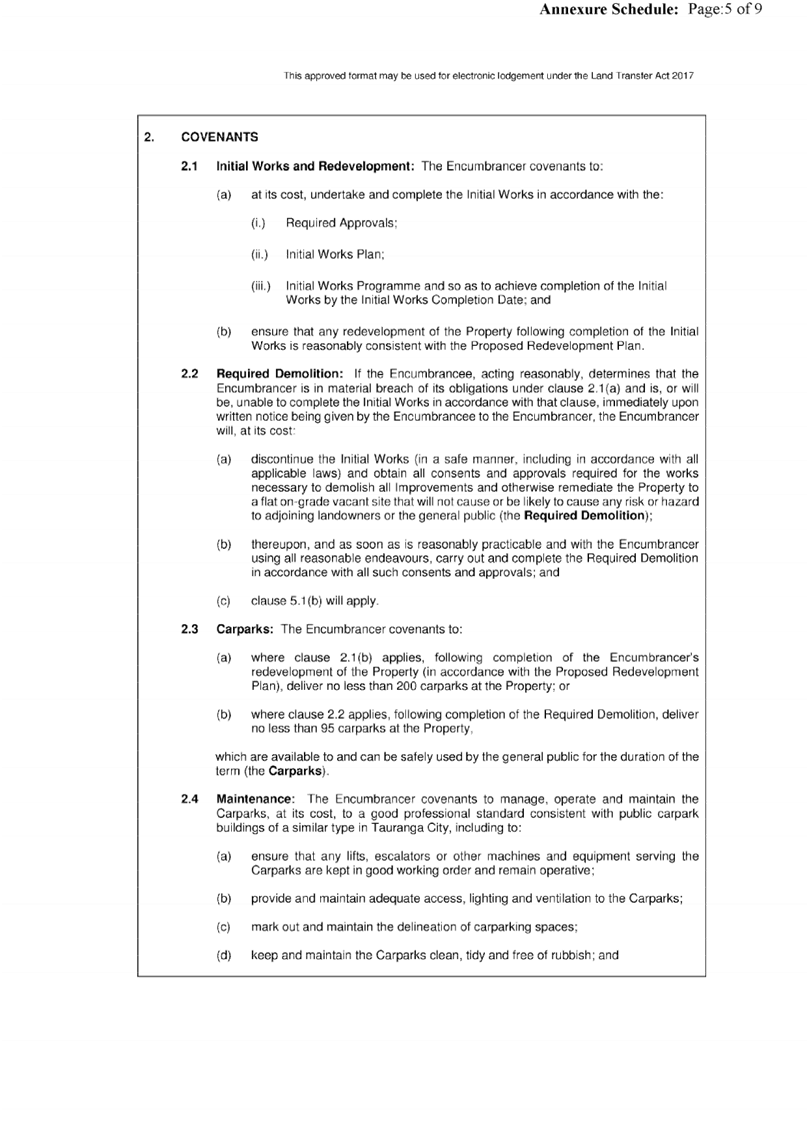
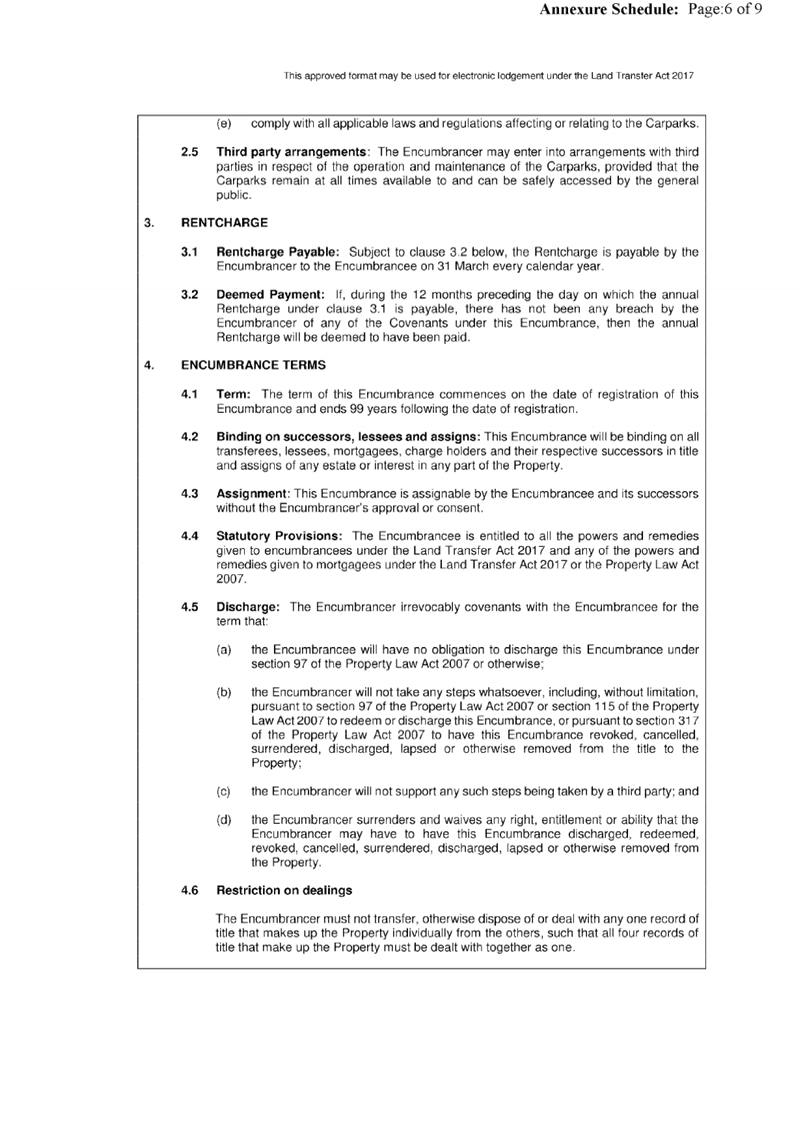
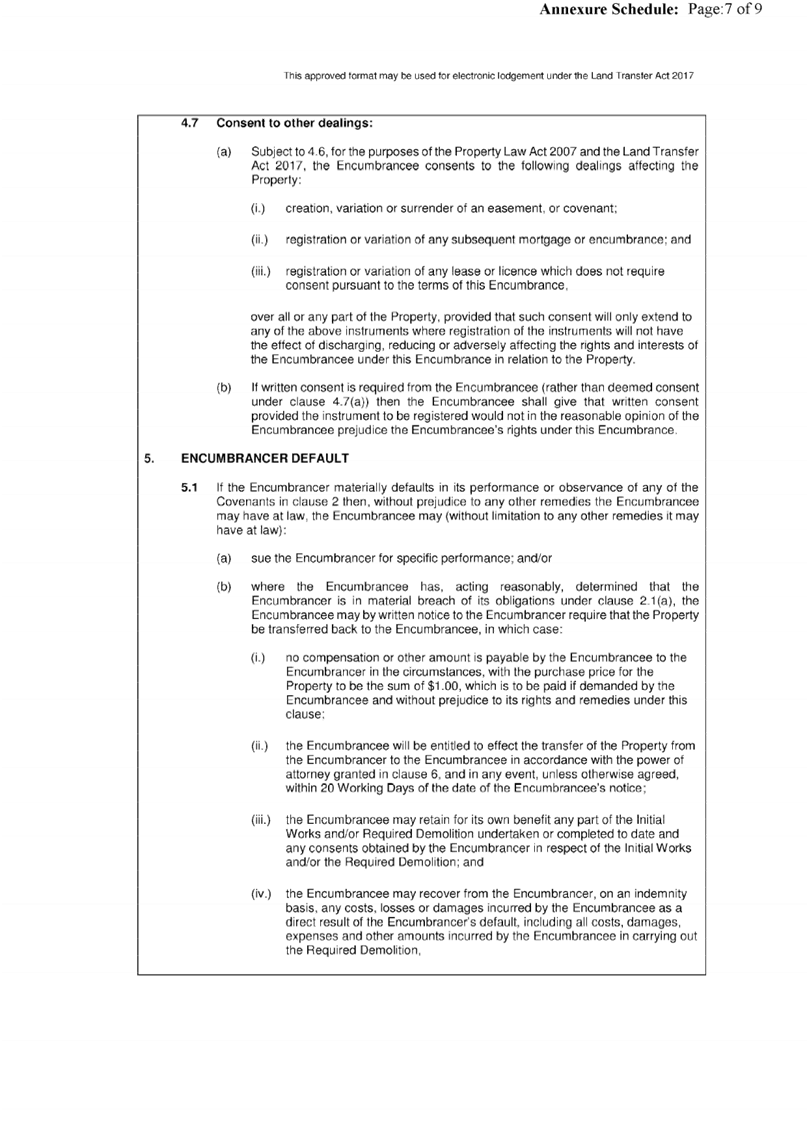
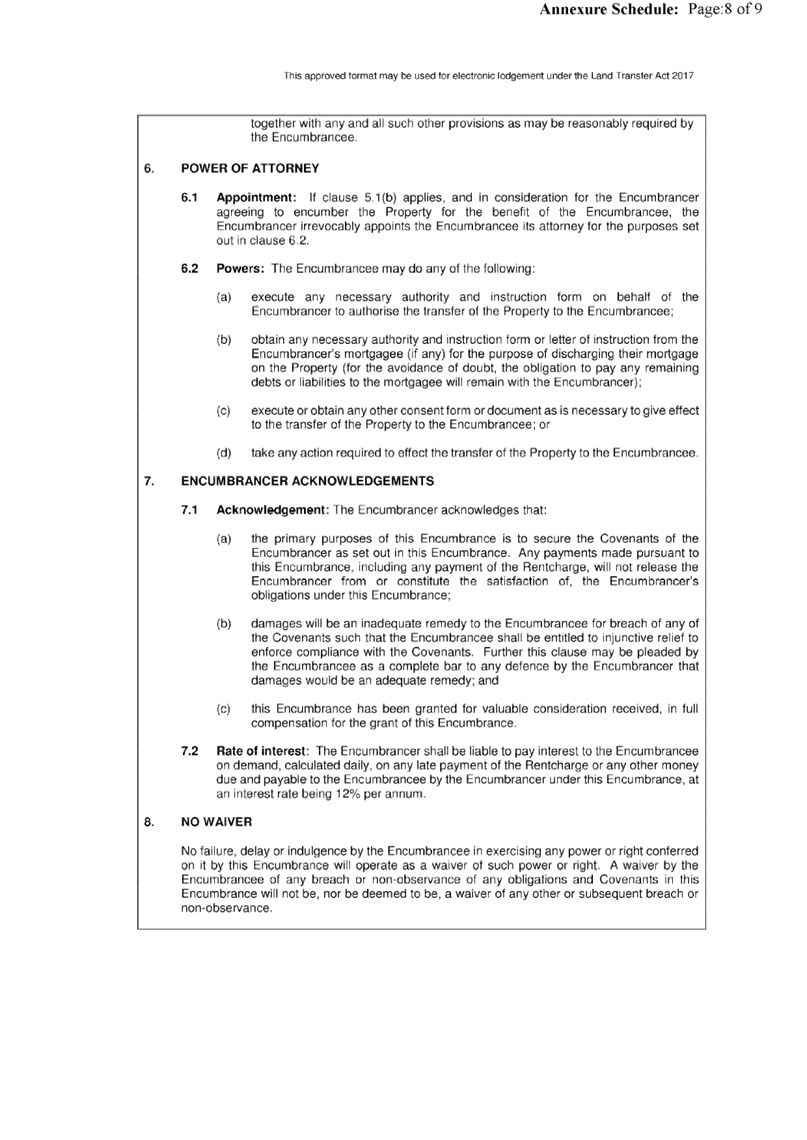
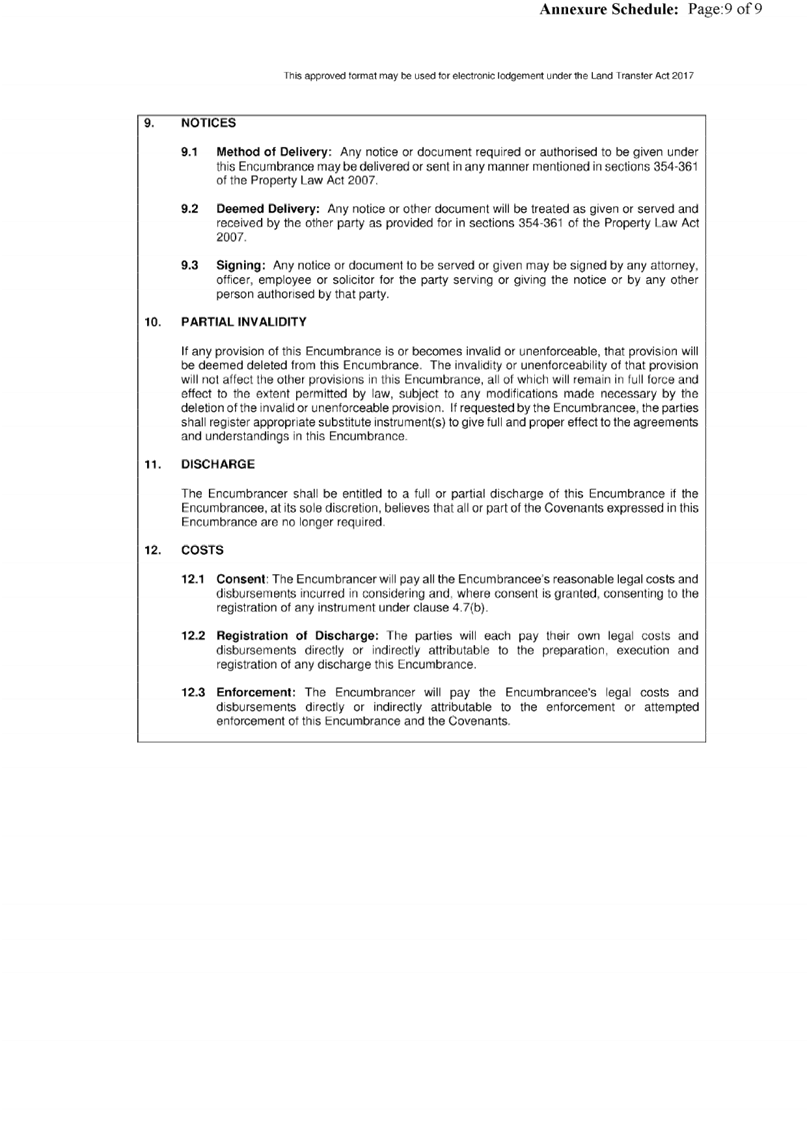
|
Ordinary
Council meeting Agenda
|
9
December 2024
|
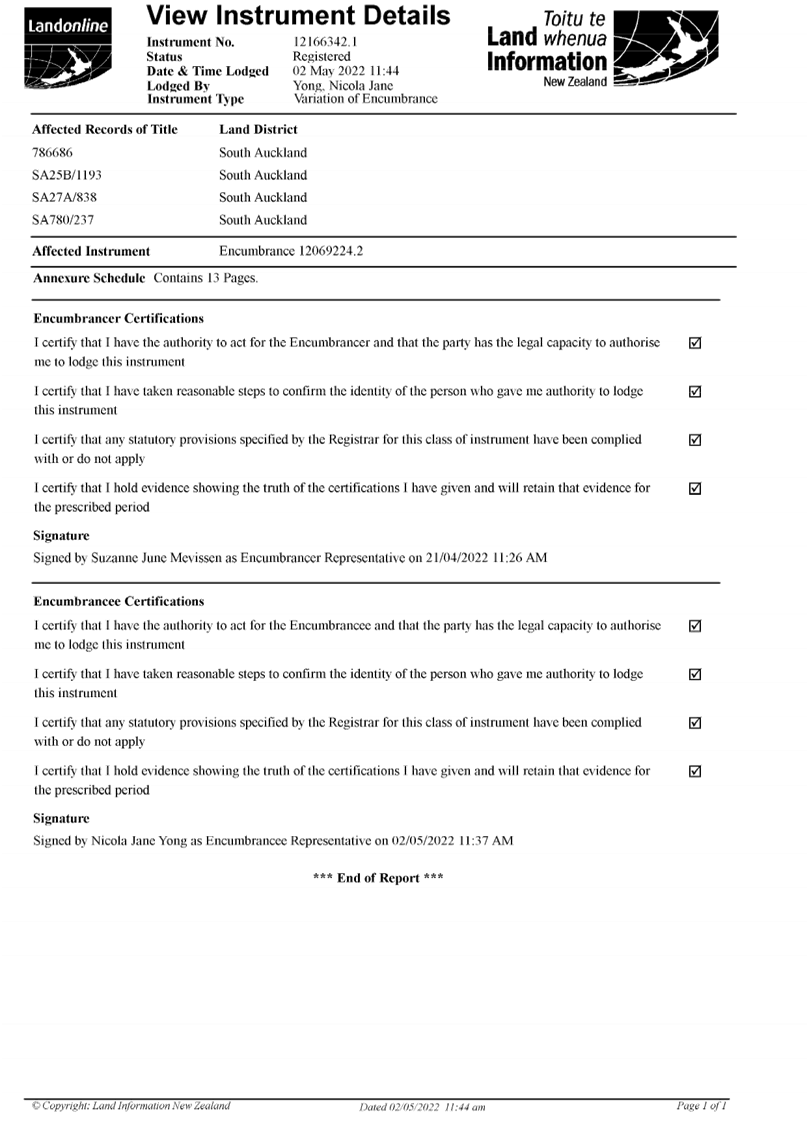
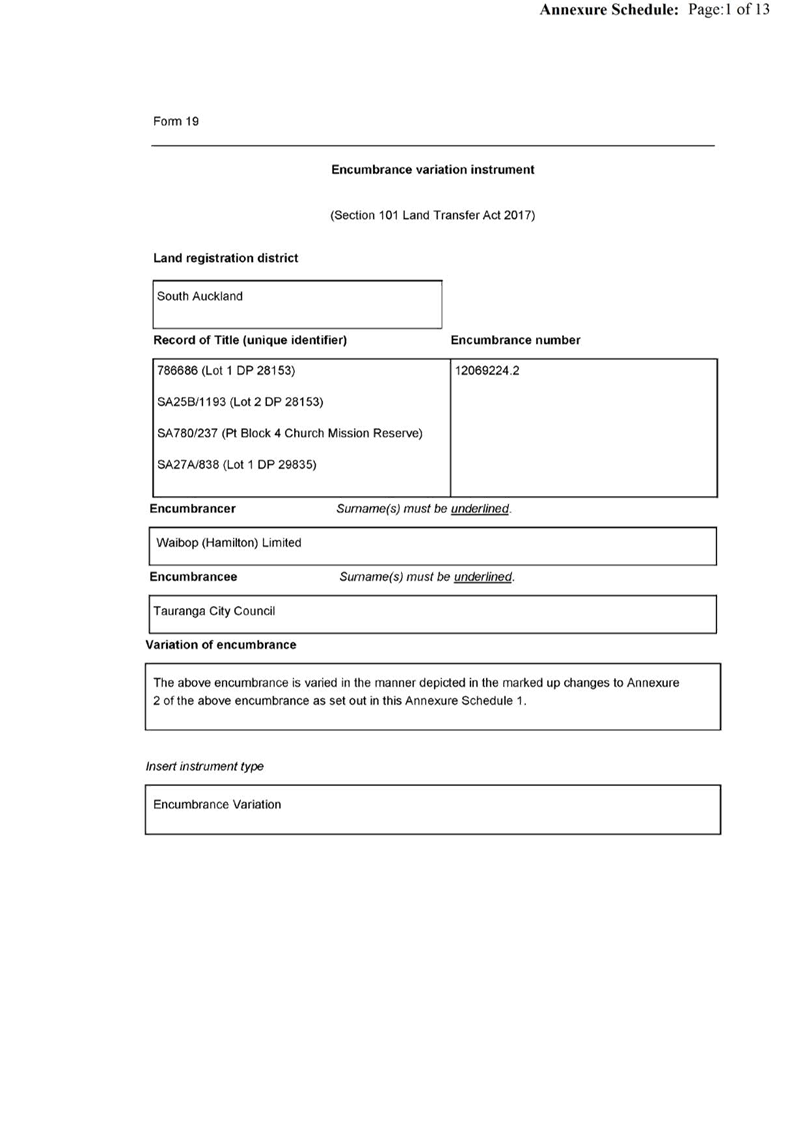
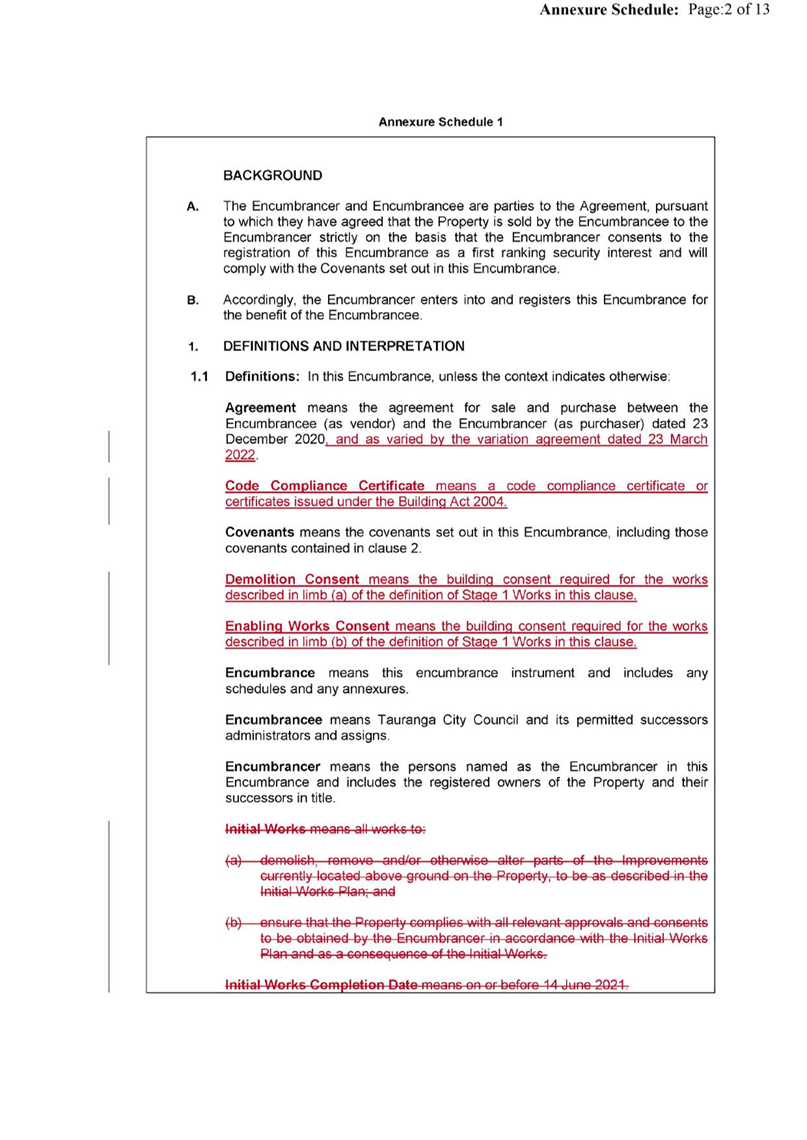
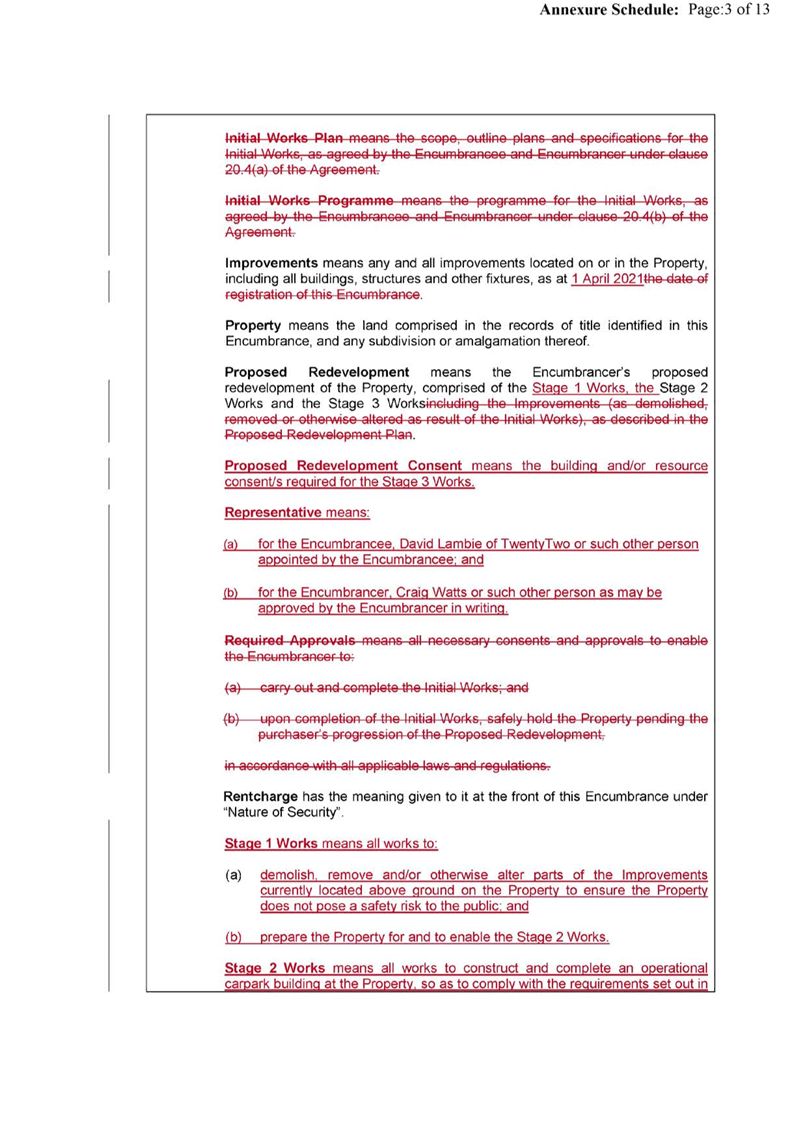
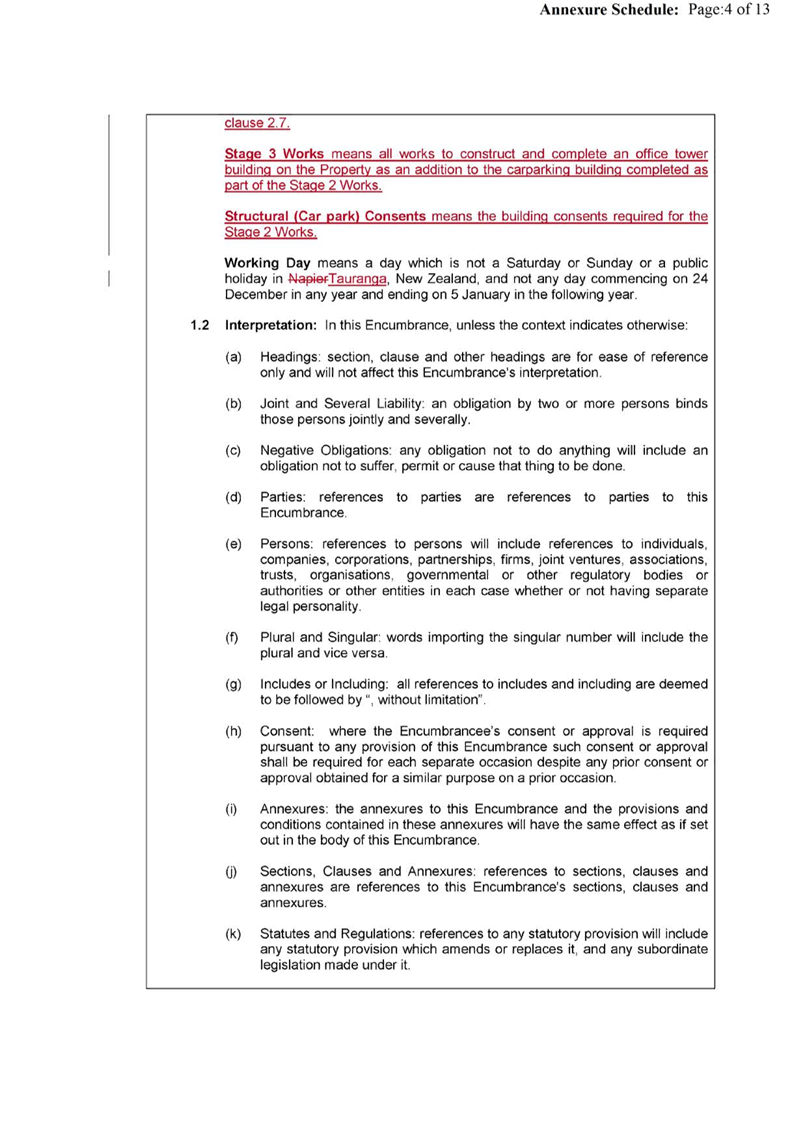
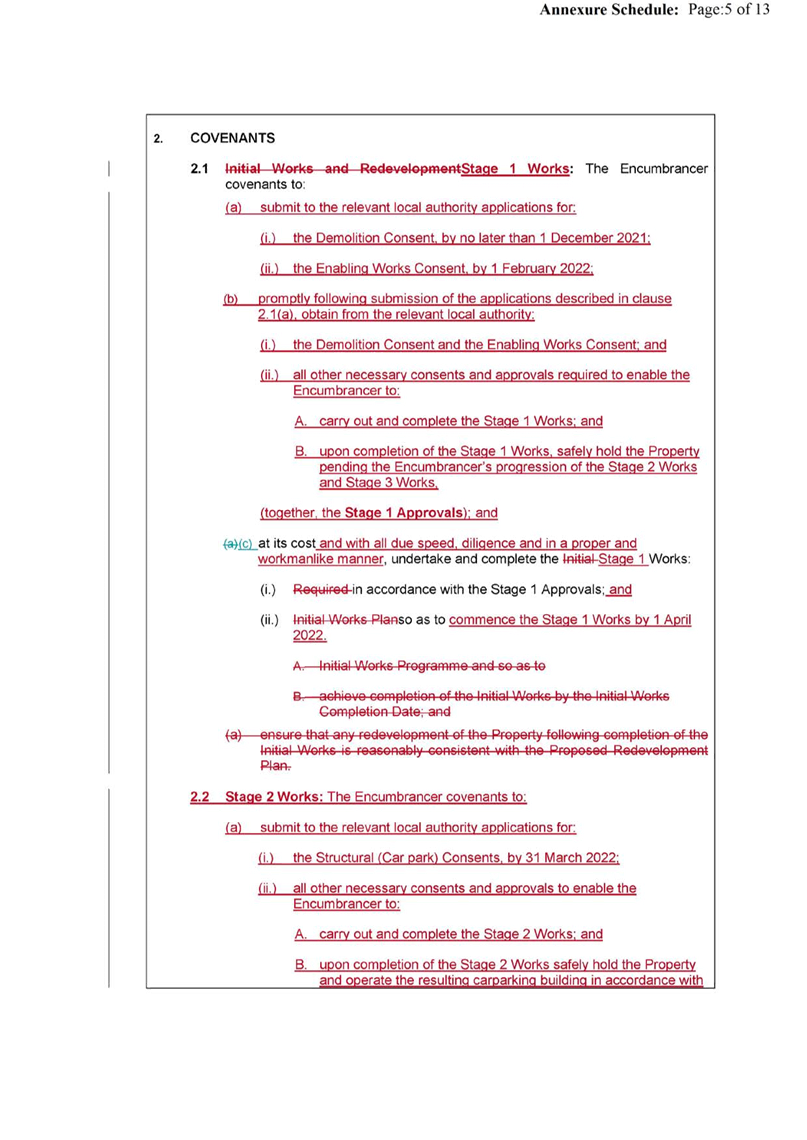

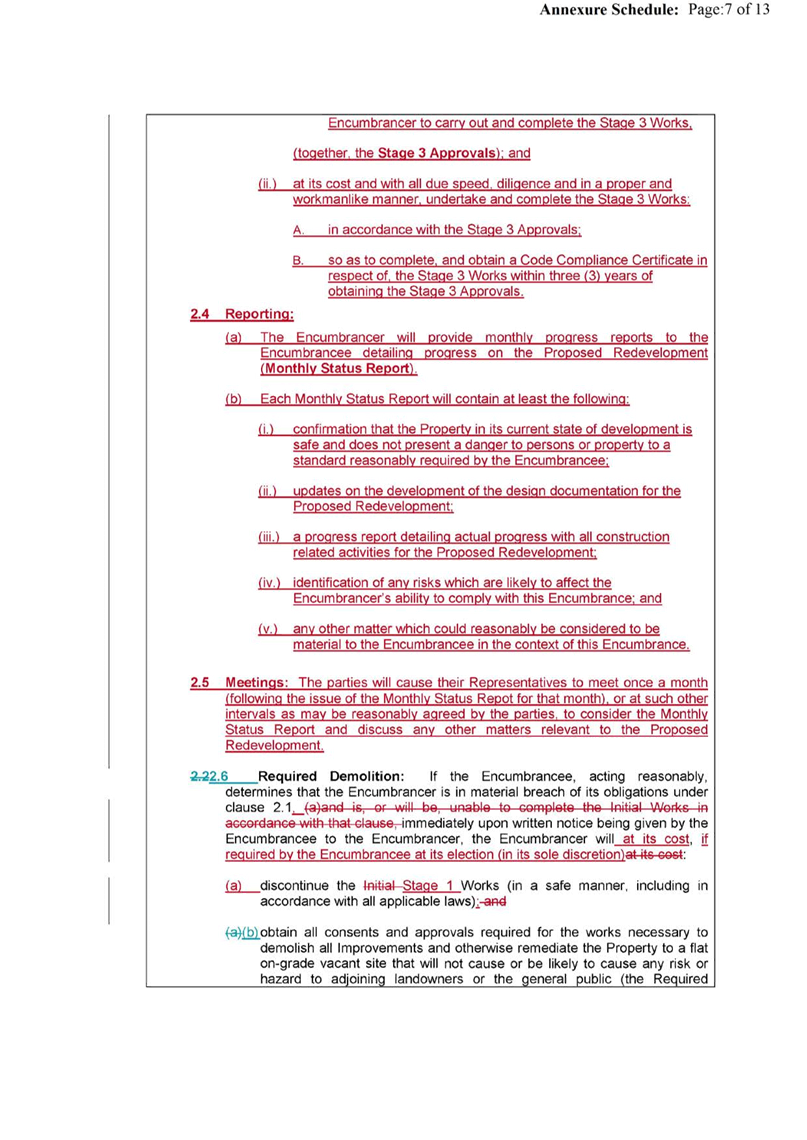
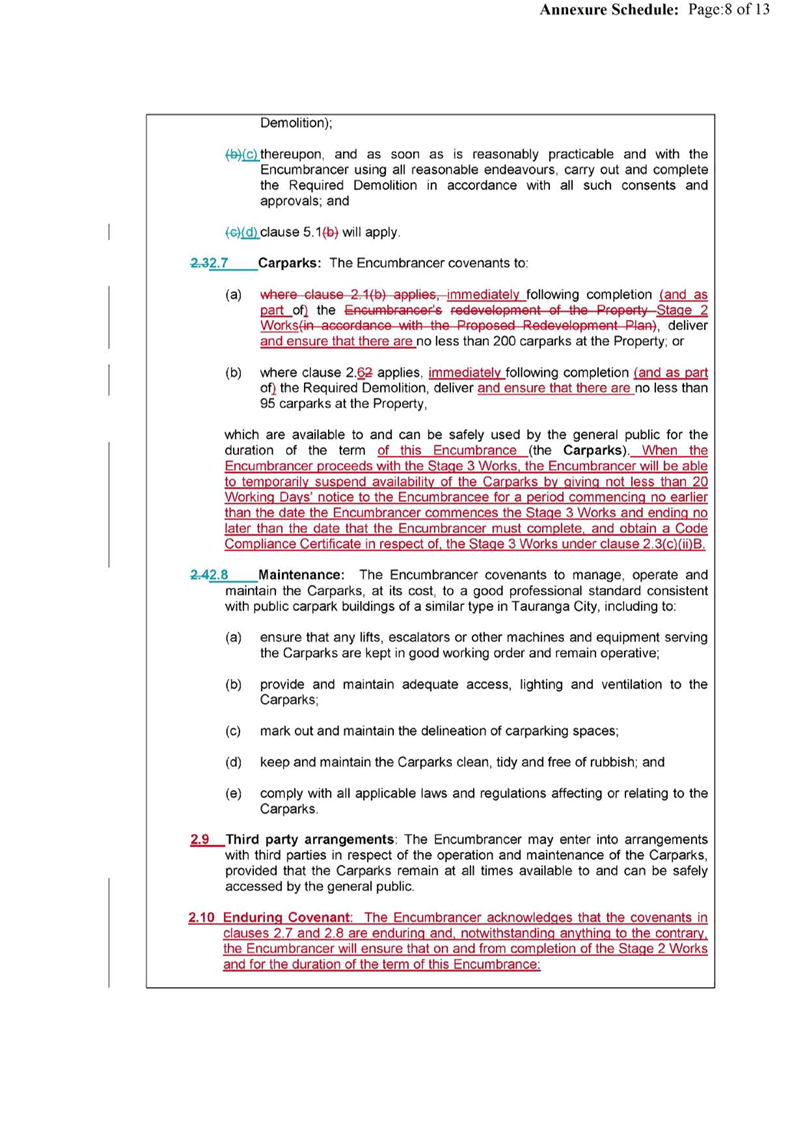
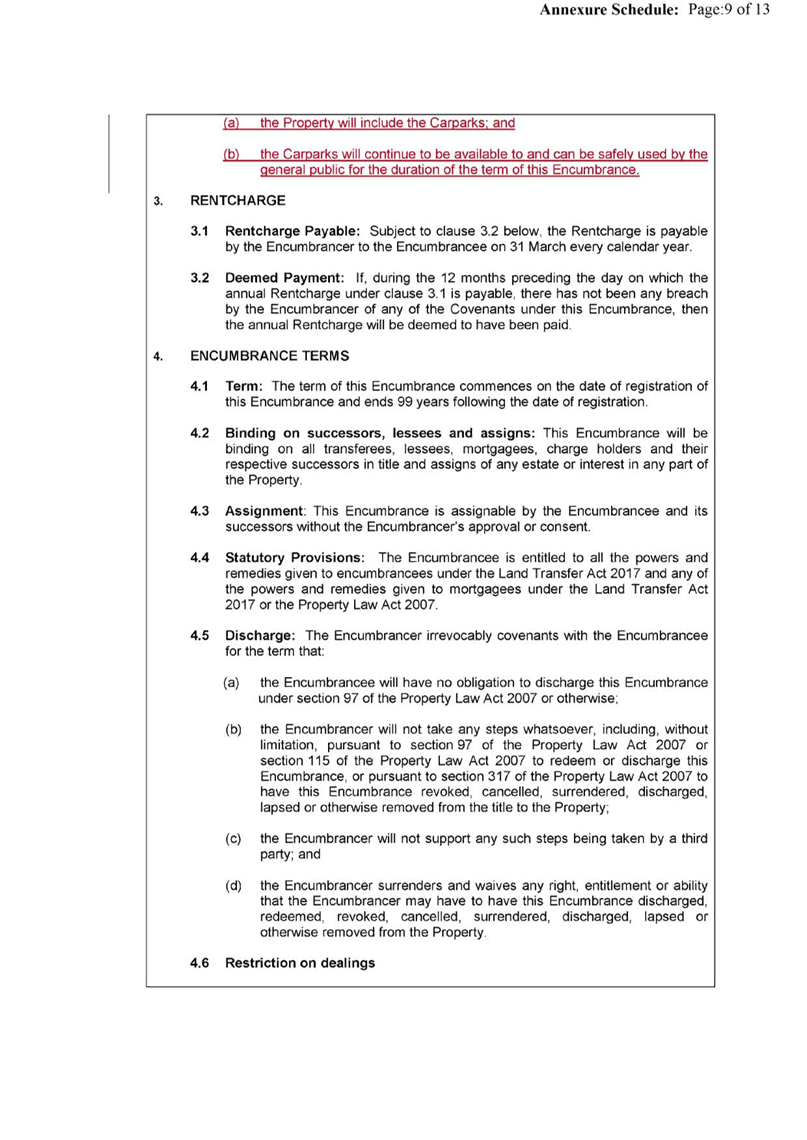
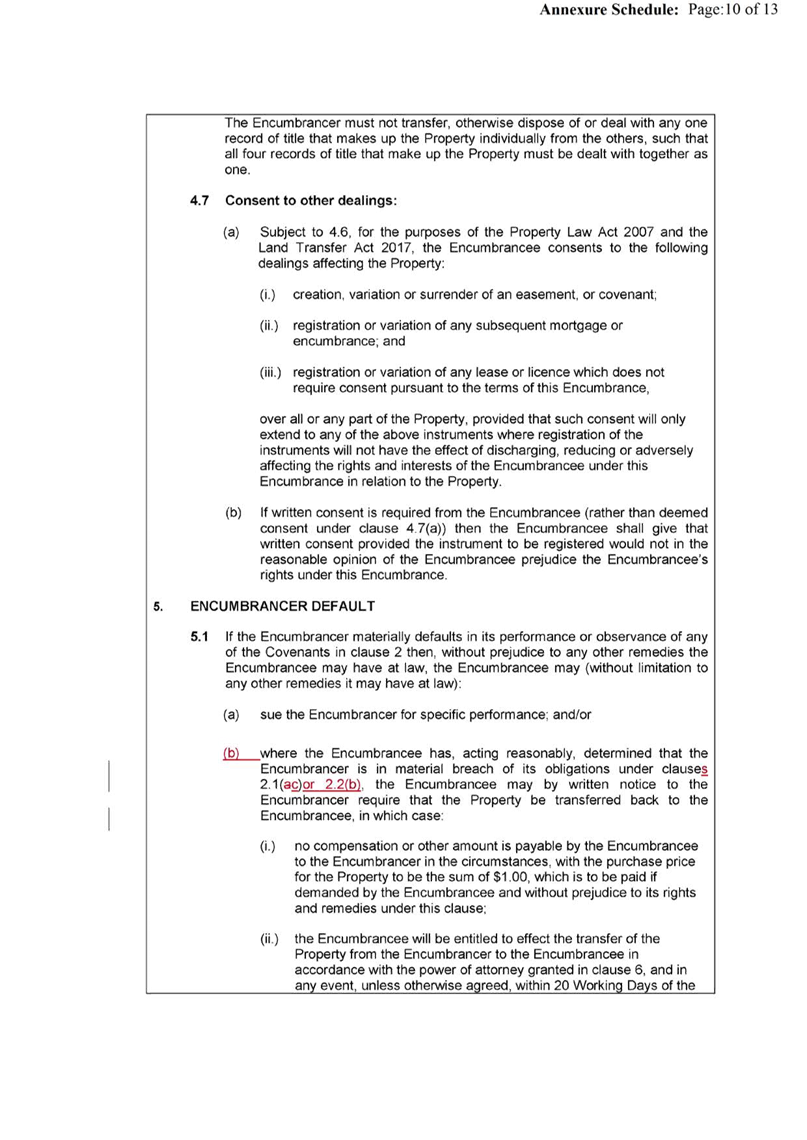
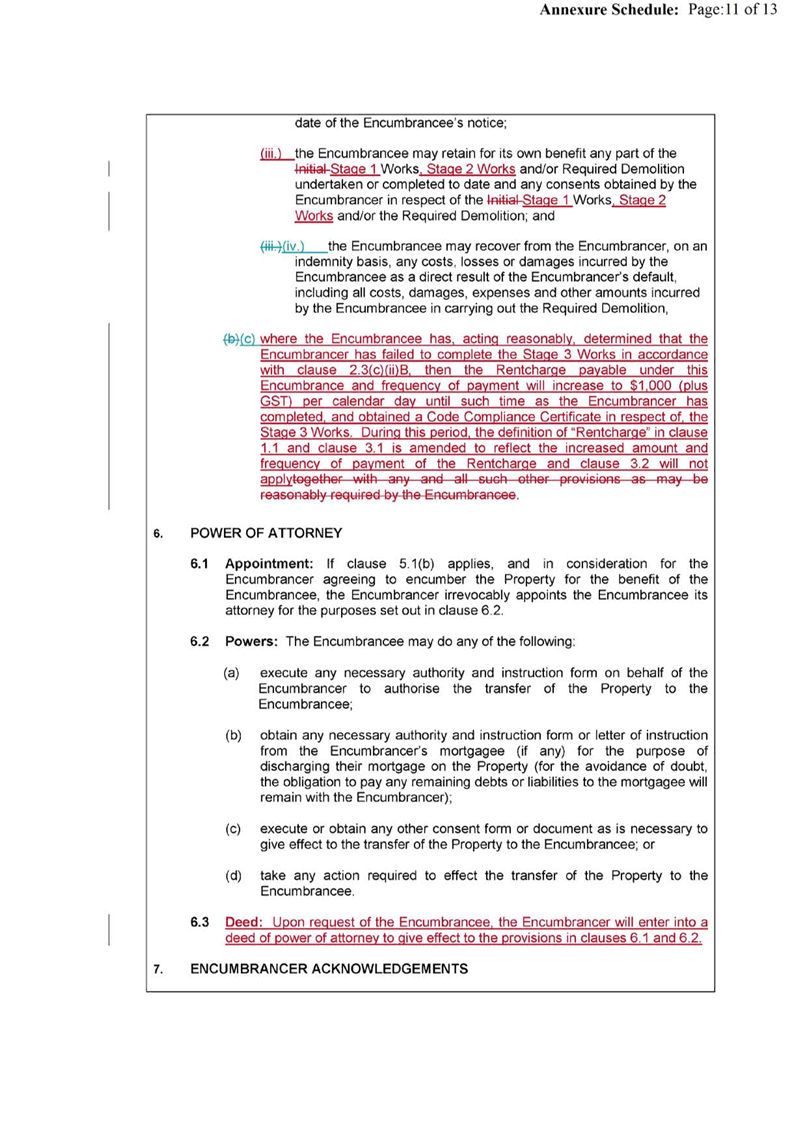
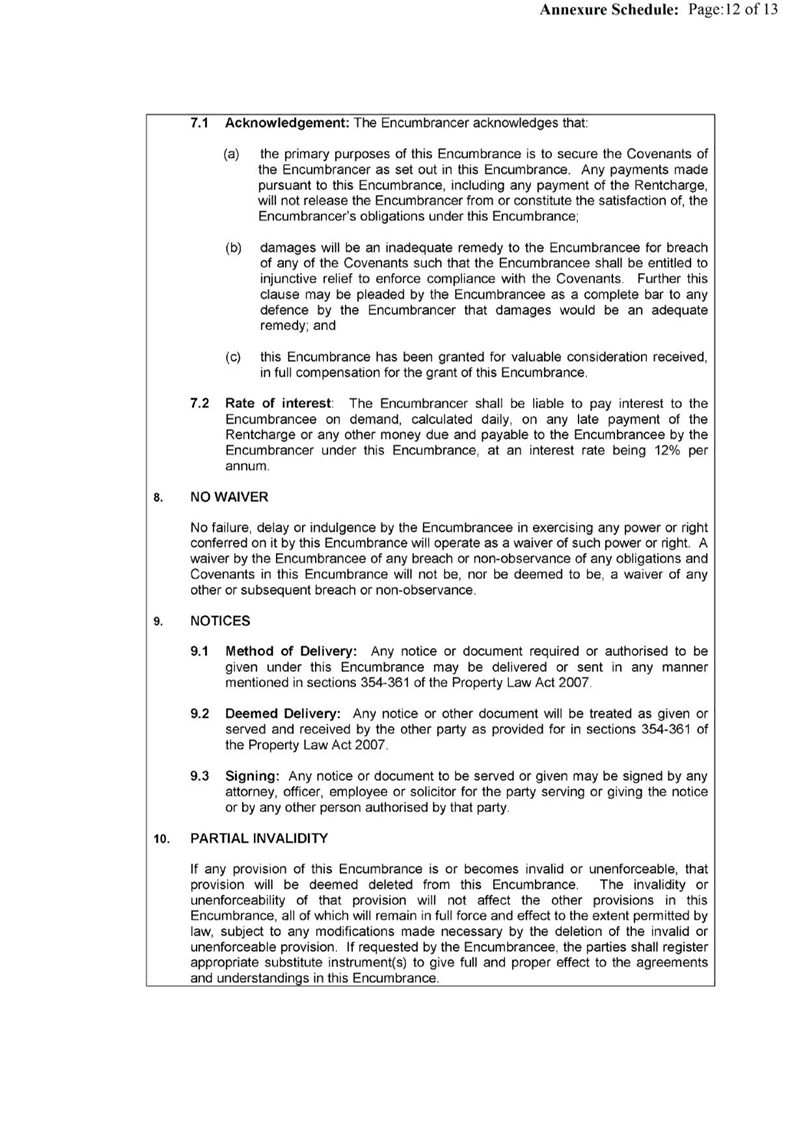
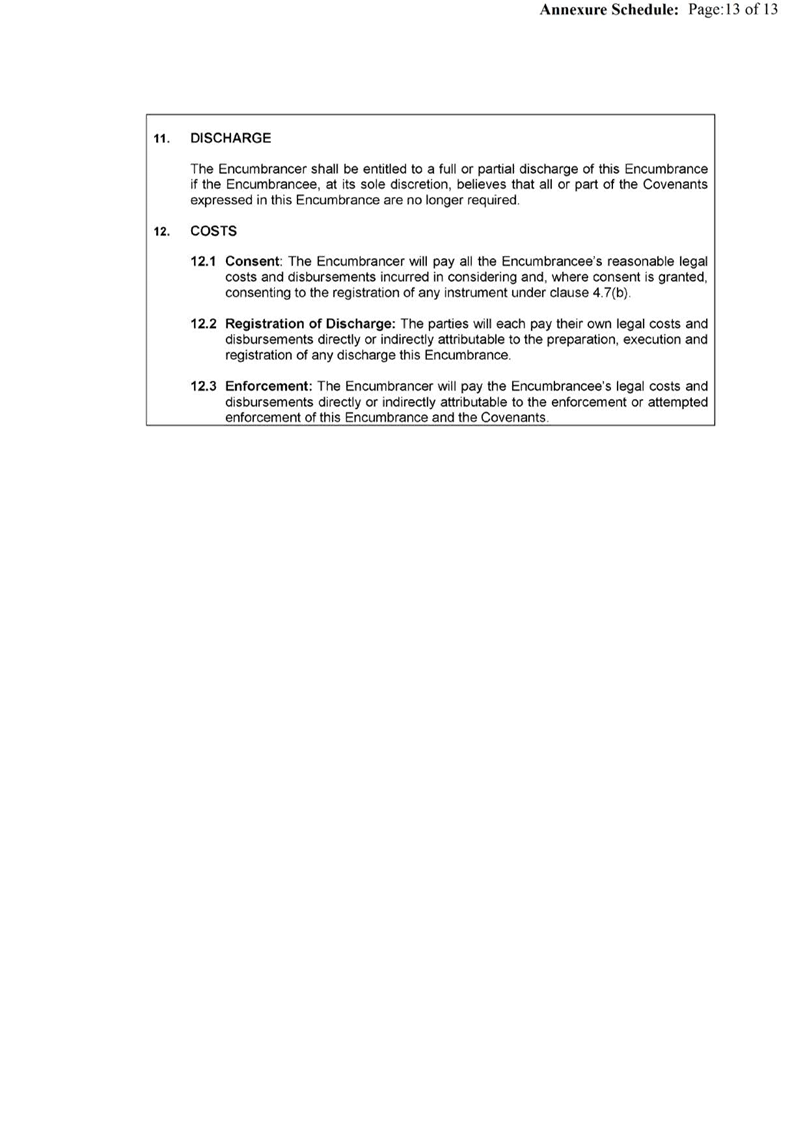
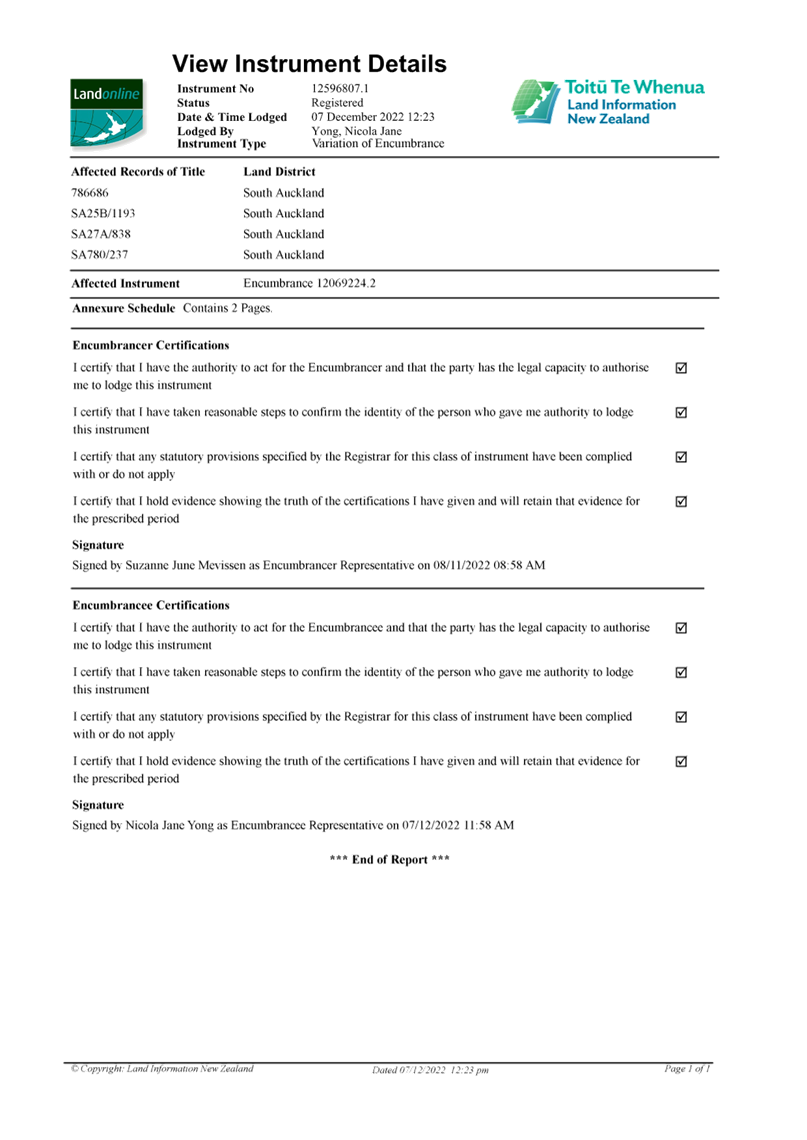
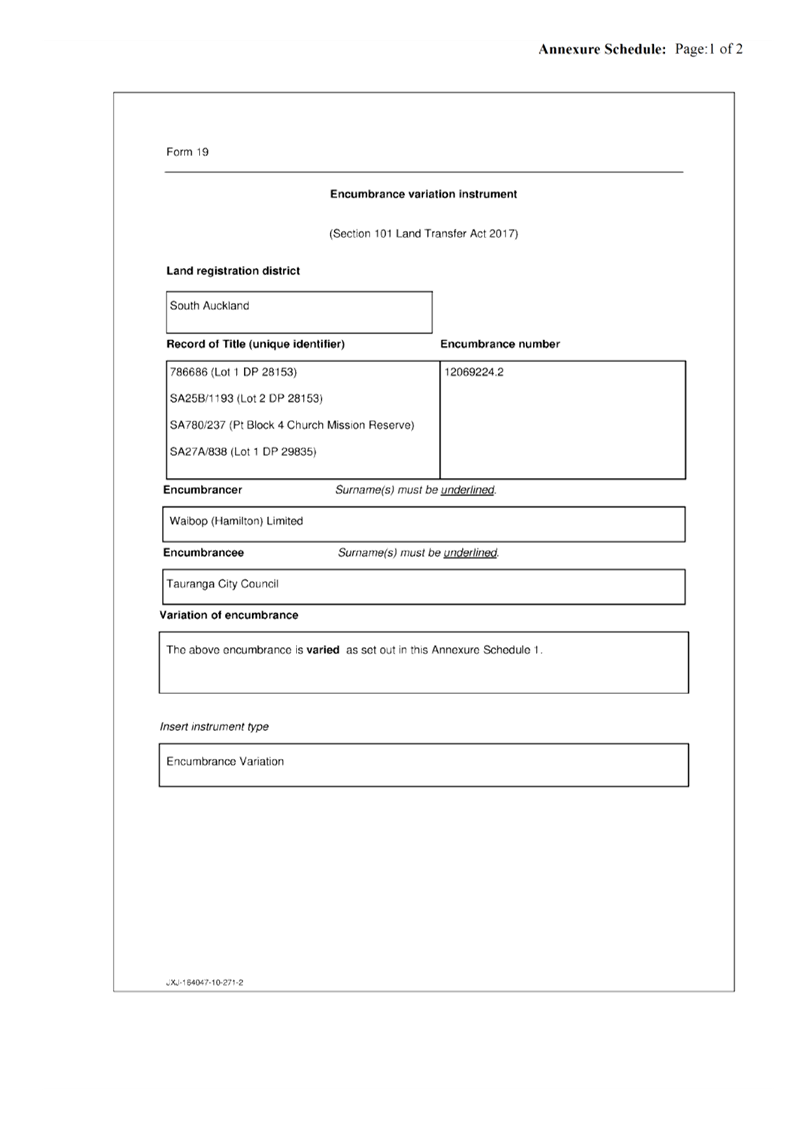

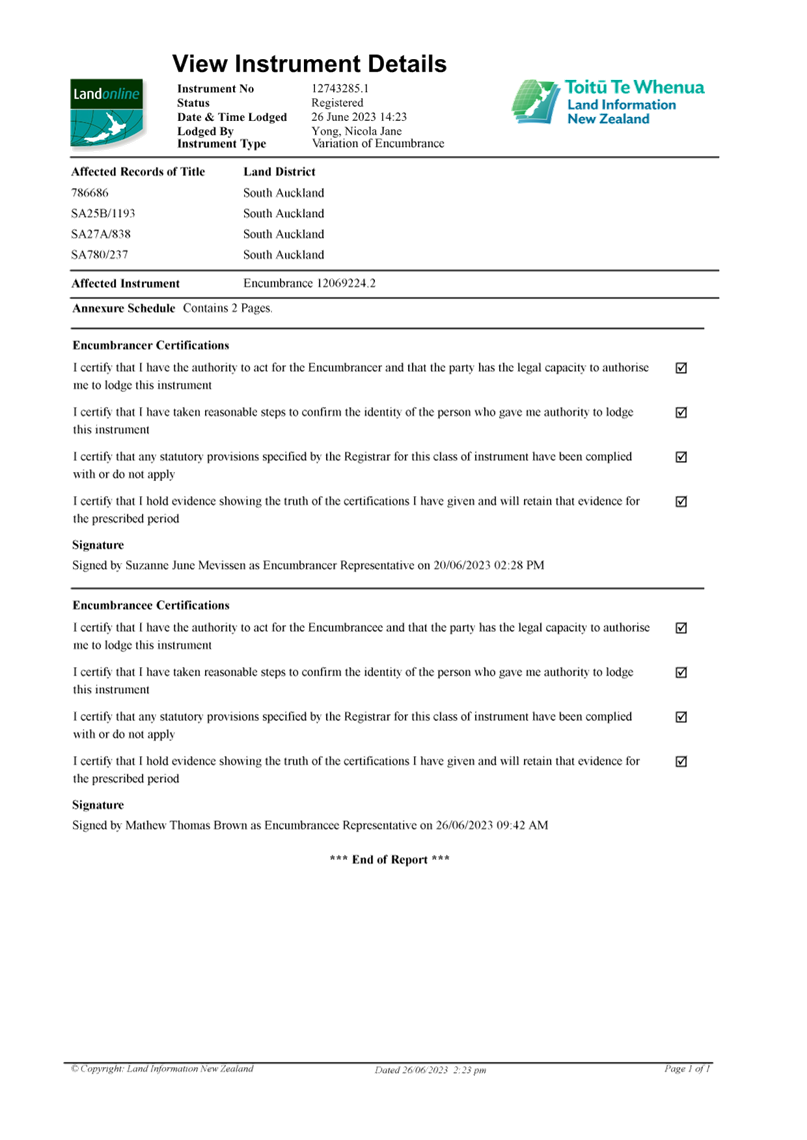
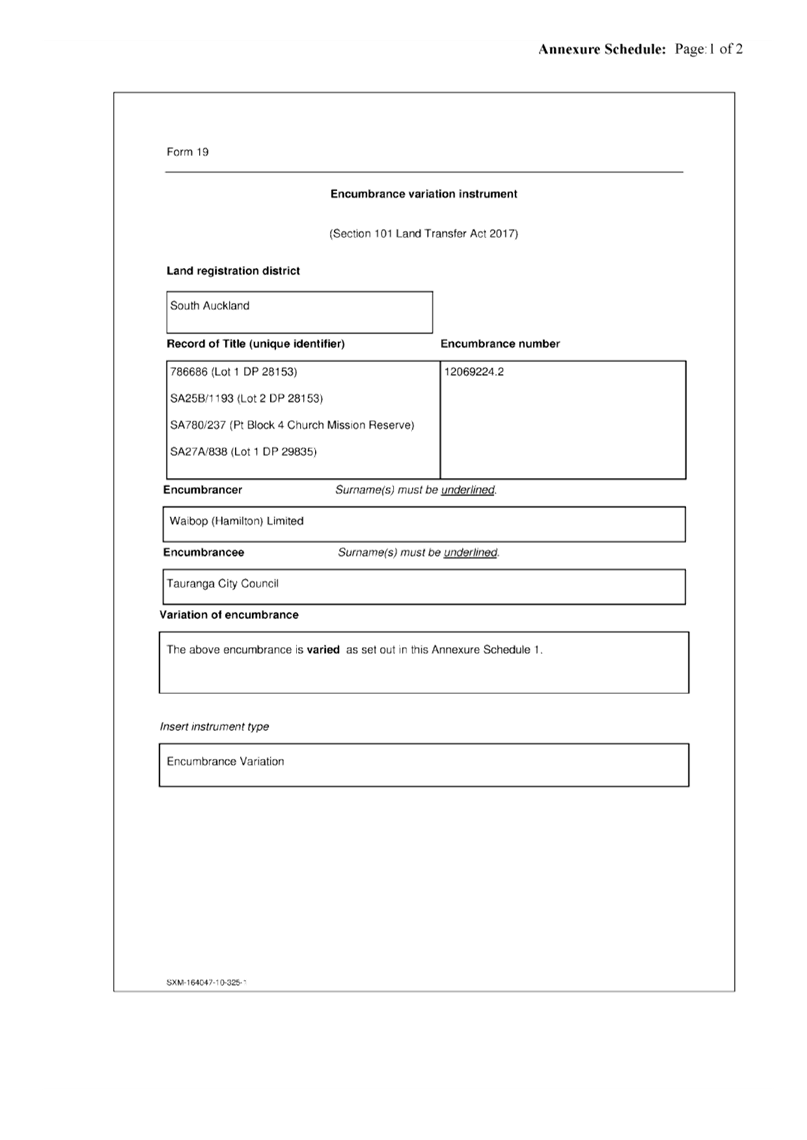

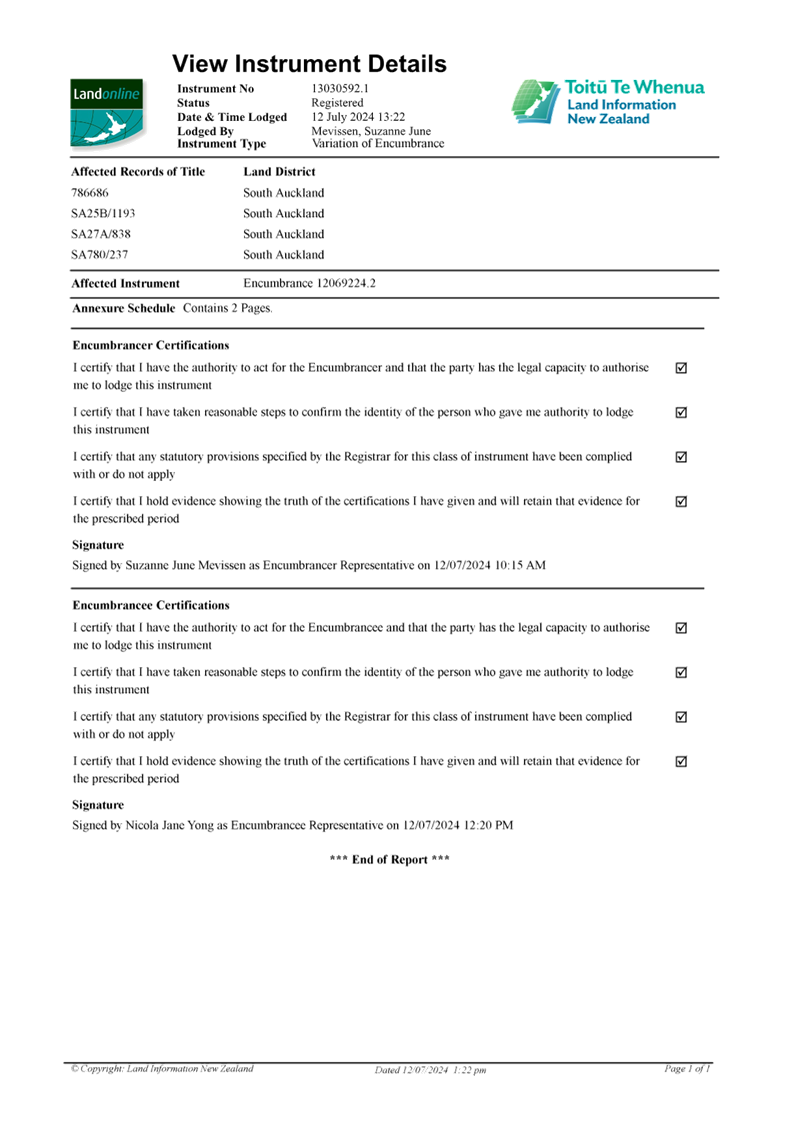
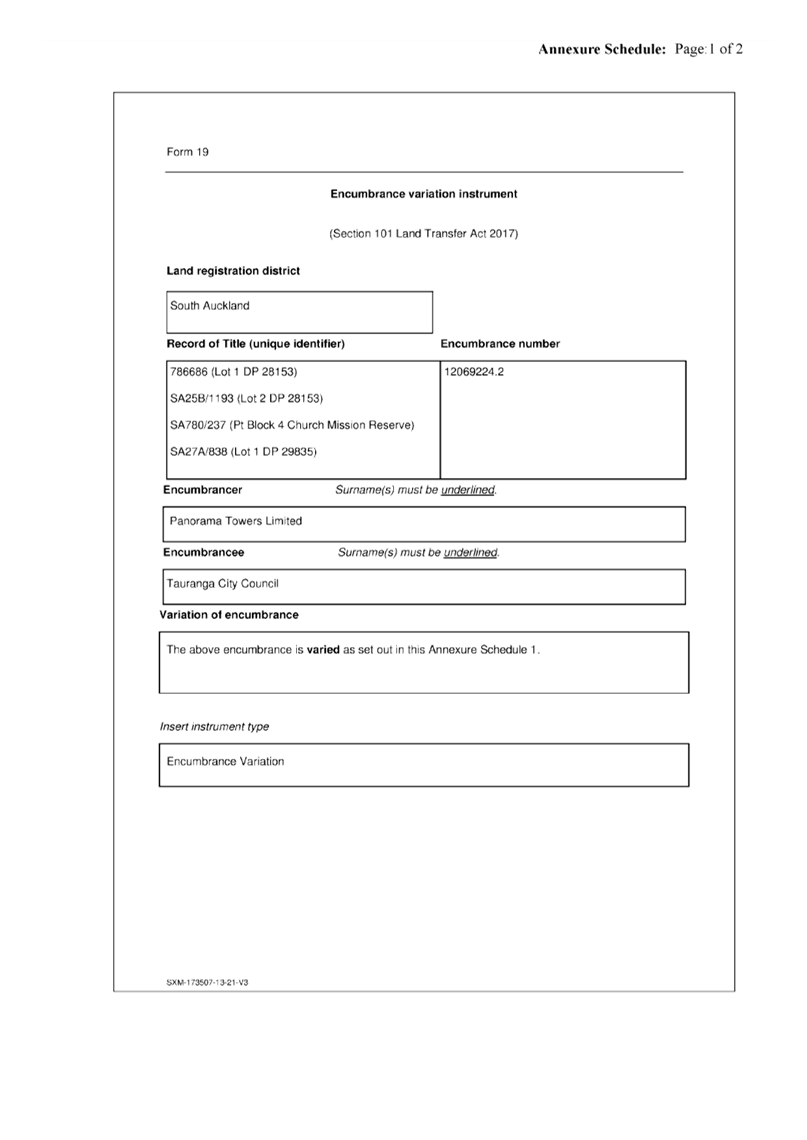

|
Ordinary
Council meeting Agenda
|
9
December 2024
|
11.4 City Centre Movement
Pilot - Lower Harington Street
File
Number: A17090642
Author: Shawn
Geard, City Centre Infrastructure Lead
Authoriser: Nic
Johansson, General Manager: Infrastructure
Purpose of the Report
1. To present options to
Council on potential actions following the petition presented to Council 12
November 2024 requesting Lower Harington Street (Willow Street to The Strand)
be returned to two-way traffic.
|
Recommendations
That the Council:
(a) Receives the report
"City Centre Movement Pilot - Lower Harington Street".
(b) Endorses the City Centre
Movement Pilot adjusting Harington Street between Willow Street and The
Strand to accommodate two-way travel, noting this will result in reduced
carparking provision.
Or;
Endorses
the City Centre Movement Pilot retaining the current Harington Street between
Willow Street and The Strand as one-way (eastbound).
(c) Requests staff provide
further reporting to Council on the City Centre Movement Pilot by May 2025.
(d) Support the current bus
stop location on Harington Street.
|
Executive Summary
2. The City Centre Movement
Pilot was implemented March 2024 as a pilot under the Land Transport Rule:
Street Layouts 2023. This enables a road controlling authority to change road
layouts as a pilot for up to two years, enabling practical adjustments and
enabling future designs to consider on the ground experience.
3. Prior to the movement
pilot was implemented there had been regular temporary traffic management
one-way restrictions on sections of Hamilton Street and Harington St, the key
outcomes desired from the pilot on Hamilton Street and Harington Street are:
(a) Consistency, enabling road
users to learn a regular pattern.
(b) An enhanced city centre feel,
increasing planting and quality of pedestrian spaces.
(c) Provision of public transport
within the northern city centre.
4. Engagement has occurred
with surrounding stakeholders between the 12 November 2024 Council meeting and
6 December 2024 specifically about the layout of lower Harington Street.
Overall 50% of respondents were neutral, 10% for lower Harington Street being one-way,
and 40% for lower Harington Street being two-way.
5. At Council on 18 March
2024 (Item 11.1) the bus stop provided on Lower Harington Street was included
within the Civic Centre split-stop arrangement, this location provides for
harbour bridge bound bus services as close as reasonable to the civic precinct
at an accessible grade.
6. Two options of either
retaining one-way at this location or accommodating two-way travel are
presented with pros and cons respectively. Feedback from a drop-in session on 6th
December will be tabled for Council’s consideration at the meeting on the
9th December.
Background
7. The City Centre Movement
Pilot was endorsed for implementation by Council 12 February 2024 (Item 10.10).
8. The City Centre Action
and Investment Plan adopted on 15 August 2022 includes a City Centre Movement
Framework, this was revised 12 February 2024 to provide focus and increase
deliverability as it was found implementation of the previous framework was highly
aspirational.
9. A street layout pilot
acknowledges that road arrangement changes are difficult to understand during
engagement, require change of behaviour, and are not always right. A key
element of the trial is to ensure we get the road arrangement right for the
future, enabling permanent works to be based on lessons learnt during the
pilot.
10. At the time of implementation upper
Hamilton Street and Harington Street were often one way due to temporary
traffic management, this presented difficult to communicate variability to road
users, an issue Tauranga City Council were sought to address based on feedback
during construction of Cameron Road Stage 1.
11. Harington Street forms the northern
most connection in the city centre between Cameron Road, Durham Street, and The
Strand, with the roundabout intersection of Harington Street and The Strand
providing re-routing options if required.
Statutory Context
12. The movement pilot is implemented
under the Land Transport Rule: Street Layouts 2023, this enables changes to
occur as lessons are learnt prior to the more standard permanent statutory
process.
STRATEGIC ALIGNMENT
13. This contributes to the promotion
or achievement of the following strategic community outcome(s):
|
Contributes
|
|
We are an inclusive city
|
ü
|
|
We value, protect and enhance the environment
|
ü
|
|
We are a well-planned city
|
ü
|
|
We can move around our city easily
|
ü
|
|
We are a city that supports business and education
|
ü
|
Options Analysis
14. Two predominant options exist for
Harington Street Between Willow Street and The Strand, these being summarised
in the below table.
|
|
One-way
|
Two-way
|
|
Adjacent business
Sentiment
|
This option is likely
to result in a net negative sentiment
|
This option is likely
to result in a net positive sentiment
|
|
Road user impacts
|
This option is likely
to maintain the increased consistency of travel experienced.
|
This option is likely
to result in increase travel variability as it is likely temporary traffic
management will be required to shut to westbound lane at times.
|
|
Carparking
|
Retention of the 21
carparks on the southern side of Harington Street.
|
Provision for 11
carparks expected to increase to 15 by June 2025 on the southern side of
Harington Street.
|
|
Events
|
Closure of The Strand
between Devonport Road and Hamilton Street is supported by this option
|
Closure of The Strand
between Devonport Road and Harington Street is supported by this option
|
15. The bus stop provided on lower
Harington Street has limited options for relocation, the only alternative being
onto The Strand outside 31 The Strand. This location is not recommended due to
its further distance from key trip generators (noting the current location has
compromised on this currently), likely issues this frontage would exhibit due
to it’s open nature, and the adjacent motel.
Consultation / Engagement
16. Community engagement has included
in person letter drops to businesses on Harington Street, Mclean Street, and
The Strand requesting feedback at the time and by email. This has been
supported by a public drop-in session set for 6 December 2025.
17. Key themes from the engagement have
been (It is noted that this report will be published prior to closing of this
targeted engagement ending):
(a) Predominantly customer facing
businesses have indicated they often receive negative feedback from visitors
who do not travel to the city centre often, these businesses are predominantly
negative about having Harington Street one-way.
(b) Regular vehicle users are
typically ambivalent, with some being positive or negative in their response to
the Harington Street one-way.
(c) Pedestrian users are
predominantly supportive of the one-way changes due to the increased amenity
and space provided.
(d) Generally, feedback on
carparking along lower Harington Street has been ambivalent due to parking
often being occupied by construction workers, (it has been noted that without
this issue, changes to carparking would be a significant concern).
(e) Feedback
from the drop-in session on 6th December will be tabled for
Council’s consideration at the meeting on the 9th December.
Significance
18. The Local Government Act 2002
requires an assessment of the significance of matters, issues, proposals and
decisions in this report against Council’s Significance and Engagement
Policy. Council acknowledges that in some instances a matter, issue,
proposal or decision may have a high degree of importance to individuals,
groups, or agencies affected by the report.
19. In making this assessment,
consideration has been given to the likely impact, and likely consequences for:
(a) the current
and future social, economic, environmental, or cultural well-being of the
district or region
(b) any persons who are likely to be
particularly affected by, or interested in, the issue.
(c) the capacity of the local authority
to perform its role, and the financial and other costs of doing so.
20. In accordance with the
considerations above, criteria and thresholds in the policy, it is considered
that the issue is of medium significance.
ENGAGEMENT
21. Taking into consideration the above
assessment, that the issue is of medium significance, officers are of the
opinion that no further engagement is required prior to Council making a
decision.
Next Steps
22. Next steps are dependent on the
resolution with two-waying of Harington Street to occur early 2025 if that is
the option decided.
23. Council will undertake a workshop
in March to workshop options and next steps for city centre streets.
Attachments
Nil
|
Ordinary
Council meeting Agenda
|
9
December 2024
|
11.5 Options for access to
un-fluoridated water
File
Number: A16585999
Author: Peter
Bahrs, Manager: Water Services
Fiona Nalder,
Principal Strategic Advisor
Rodney Clark, Water
Treatment Manager
Authoriser: Nic
Johansson, General Manager: Infrastructure
Purpose of the Report
1. The purpose of this
report is to present a range of options to Council for the supply of
un-fluoridated water for those who choose it, and to provide a recommended
approach for Council’s consideration.
|
Recommendations
That the Council:
(a) Receives the report
"Options for access to un-fluoridated water".
(b) Proceeds to prepare and
publish education resources providing residents with information and guidance
on how to remove fluoride from their own drinking water, at an estimated cost
of $20,000 or less (one-off opex).
(c) Works further with Western
Bay of Plenty District Council regarding the potential of providing Tauranga
residents with access to un-fluoridated water at a supply point within
Western Bay District, but close to Tauranga city boundaries (estimated cost
of $30,000 in 2024/2025, capex, plus ongoing opex of $5,000 per annum).
(d) Notes that the funding
required in the 2024/2025 year, $50,000 as per recommendations (b) and (c)
above, would be sourced via a prioritisation exercise in
order to offset the cost within the existing water infrastructure budget, as
there is no existing budget available.
|
Executive Summary
2. Council requested staff
to investigate options to provide a non-fluoridated water supply for those who
choose it, and to report back on identified options (CO18/24/1,
26 August 2024).
3. This
report responds to that decision. Six options (some with sub-options) are
presented in this report, with an options analysis completed for three
shortlisted options.
· Option
(i): Self-help guidance
· Option
(iv)(b): Treated water from an alternative raw water source – rainwater
· Option
(vi): Enabled access to a communal source of un-fluoridated water outside of
Council boundaries
4. The
report recommends proceeding with Options (i) and (vi) above, as these provide
an approach which is cost effective and lower risk. This approach recognises
Council’s constrained financial position and the expected low uptake of
an un-fluoridated water supply, whilst still providing access to an
un-fluoridated water supply for those who want it. (Noting that in Hamilton
there is an estimated uptake of ~1000 litres per day for un-fluoridated water
via tap access in central Hamilton, since 2016, and that the average daily
household usage in Tauranga is ~500 litres.)
5. The
cost of implementing the recommended options is $50,000 in 2024/2025 plus
$5,000 opex annually. As there is no existing budget available, a
prioritisation exercise would be required to offset the cost within the
existing water infrastructure budget.
6. If Council adopts the
recommendations of this report, the next steps would be to:
· Prepare
and publish education resources providing residents with information and
guidance on how to remove fluoride from their own drinking water.
· Work
with Western Bay of Plenty District Council regarding the potential of
providing Tauranga residents with access to un-fluoridated water at a supply
point within Western Bay District, but close to Tauranga city boundaries.
7. There is no legal
requirement for Council to provide residents with access to un-fluoridated
water.
Background
8. On 14 October 2024
Council resolved to ‘comply with the directive of the Director-General
of Health to fluoridate the potable water system of Tauranga, starting on 24
October 2024 to meet the directive deadlines.’ (CO20/24/2). As per this decision, and
legislative requirements, Tauranga’s water supply is now fluoridated.
9. Whilst fluoridation of
public water supplies is viewed as a safe and beneficial community health
measure by many individuals, groups and organisations, including the Ministry
of Health, others oppose fluoridation due to a range of different concerns.
10. Acknowledging this, prior to the 14
October 2024 decision Council requested staff to investigate options to provide
a non-fluoridated water supply for those who choose it, and to report back on
identified options (CO18/24/3, 26 August 2024).
11. Note that the
local level of demand for un-fluoridated water has not been assessed. In
Hamilton there is an estimated uptake of ~1000 litres per day for
un-fluoridated water (provided by a communal source of un-fluoridated water,
via tap access in central Hamilton, since 2016). The average daily household
usage in Tauranga is ~500 litres.
The meaning of
‘Un-fluoridated’ Water
12. In this report the term
‘un-fluoridated’ water is used to refer to all the following
categories.
13. Fluoride free water, water with no
fluoride in it, either:
· from
a source that has no natural occurring fluoride, and no fluoride added to it,
or
· treated
through a method that will remove the majority of fluoride from the water (e.g.
reverse osmosis).
14. Fluoride reduced water, referring
to fluoridated water which either:
· is
from a fluoridated network supply that is treated to remove fluoride from the
water using a means that is known to remove most fluoride, but may not remove
all fluoride (such as absorption filters), or
· is
from a non-fluoridated supply containing naturally occurring fluoride.
Options for the provision of an
Un-Fluoridated Water Supply
15. Council identified two approaches,
broken down into five options, and asked Beca Limited (Beca) to complete
further work investigating the costs, risks and feasibility of each of these
options. Beca’s final report is provided as Attachment 1.
16. Council can either support
individuals to access a personal supply of un-fluoridated water and/or
provide (within Tauranga city) a communal source of un-fluoridated water which
individuals can access. Each of these two approaches can be broken down further
as below.
17. Approach 1: Support individuals to
access a personal supply of un-fluoridated water.
· Option
(i) – Self-help guidance
· Option
(ii) – Self-help guidance and subsidy towards the cost of a fluoride
removal system
18. Approach 2: Provide, within
Tauranga city, a communal source of un-fluoridated water which individuals can
access. The Options under Approach 2 are based on providing a community water
supply at a single location with a water collection point, consisting of a
bottle filling station and a tap for filling larger containers.
19. The Beca report assumes a location
based on or around the Mercury Baypark stadium grounds, however this is for
example only. If Council decided to proceed with one of Options (iii) to (v),
further work would be done prior to finalising the location of the collection
points. Note that Beca’s costs are also based on providing only one
collection point (i.e. not multiple locations across the city).
· Option
(iii): Centralised fluoride removal plant
(a) Fluoride removal treatment plan with
re-chlorination from the potable water network.
(b) Fluoride removal treatment plan without
re-chlorination from the potable water network.
· Option
(iv): Alternative raw water source and treatment system
(a) Bore water treatment system
(b) Rainwater treatment system
· Option
(v) Tanker delivery of un-fluoridated water from one of Council’s
sources.
(a) From a local water supply, located outside
Council’s boundary, without fluoride added (i.e. Mclaren Falls).
(b) From Oropi water treatment plant with fluoride
dosing turned off.
20. Two further alternative options
have since been identified. These options were not analysed by Beca or included
in their report.
· Option
(vi): Enable access, outside of the city’s jurisdiction, to a communal
source of un-fluoridated water.
· Option
(vii): Provide communal access to un-fluoridated water, via a simple filter
system.
21. Each of these options is discussed
below.
Option (i): Self-help guidance
22. This option focuses solely on
education, providing residents with information and guidance on how to remove
fluoride from their own drinking water. It does not provide the means of
obtaining un-fluoridated water, only the knowledge of how to do so. It is a low
cost, low risk approach.
Option (ii): Self-help guidance plus subsidy
23. This option includes the education
aspect of Option (i) and partners it with a one-off subsidy towards a fluoride
removal system (for example, an under-bench filter system). To provide
financial certainty for Council, it is recommended that if this initiative is
adopted, it is capped. The estimated cost, based on an uptake of 2000
households, with a subsidy of $300 per system/household is $600,000 (one-off
opex). This is a higher cost approach, although it has no ongoing operational
costs.
Option (iii): Centralised fluoride removal plant
24. This option involves removing
fluoride via building a fluoride removal system. This system would take in
fluoridated water from Council’s water supply and treat it via a series
of filtration processes. It includes the following steps.
· Activated
carbon filtration (removes residual chlorine, necessary to provide the reverse
osmosis membranes).
· Cartridge
filtration (removes suspended solids).
· Reverse
osmosis (removes fluoride and other dissolved substances).
· UV
disinfection (or sodium hypochlorite dosing).
25. Once these steps were completed,
Council could choose to re-chlorinate the water (Option (iii)(a)) or leave it
as is (Option (iii)(b). This is a high-cost approach, with significant ongoing
operational considerations as well as initial capital expenditure.
Option (iv): Treated water from an alternative raw water
source
26. This option looks at sourcing water
from either an in-ground source (bore water) or via rainwater collection. For
illustrative purposes, the Beca analysis considered utilisation of an existing
borehole in Truman Lane or the collection of rainwater from the roof of the
Mercury Baypark Stadium. However, if Council chose to proceed with either bore
water or rainwater collection, these may not be the final locations. Both these
sub-options would require construction of a water treatment system and incur
ongoing operational costs.
27. Option (iv)(a) Bore water
treatment: Involves a series of processes, including media filtration (to
remove iron and manganese), cartridge filtration and UV disinfection. The
quality of bore water is unknown until a hole is drilled and may result in
complex treatment challenges. There are potential issues regarding consent
requirements, waste management and ultimately the outcome of this option is
dependent on the bore (i.e. multiple bore holes may be required before a
suitable one is obtained).
28. Option (iv)(b) Rainwater treatment:
Involves a series of processes, including cartridge filtration, UV disinfection
and pH adjustment (as the pH of rainwater tends to be below the guideline value
of 7, i.e. slightly acidic). This solution relies on access to a large roof
area which would require carefully planned maintenance to ensure there are no
negative impacts on water quality (e.g. applied treatments for issues such as
moss and mould would need to be avoided or carefully managed). Supply issues
during dry periods could be an issue.
Option (v): Tanker delivery of un-fluoridated water from
an existing Council source
29. This option involves transporting
un-fluoridated water to a collection point. Water could be either sourced from
Oropi water treatment plant (with the fluoride dosing turned off), this is
Option (v)(b), or from an existing un-fluoridated, but otherwise compliant,
water supply outside of Council’s boundaries (such as McLaren Falls
Park), this is Option (v)(a).
30. This approach would incur
significant ongoing operational costs. It is likely that, regardless of the
source, the water would require further treatment to ensure it was safe to
drink (sodium hypochlorite dosing). Water sourced from Oropi water treatment may
have residual fluoride and the requirement to manage fluoride dosing would add
complexity and risk to regular water treatment operations.
Option (vi): Enabled access to a communal source of
un-fluoridated water outside of Council boundaries
31. This option was not included in the
Beca assessment. It was only recently identified, as work originally focussed
solely on identifying options for an un-fluoridated water supply within
Tauranga city.
32. Western Bay of Plenty District
Council (WBoPDC) will be fluoridating water at two of its water treatment
plants (Athenree and Wharawhara), in compliance with direction received from
the Director-General of Health. However other water treatment plants within
WBoPDC remain un-fluoridated at this stage.
33. This option involves facilitating
access to treated but un-fluoridated water from one of the WBoPDC
un-fluoridated water treatment plants. Access would be via a metered communal
tap, with the water usage then charged back to Council.
34. High level conversations regarding
this possibility have occurred with WBoPDC. However, further work is required
before WBoPDC are willing to support the implementation of this approach.
35. Further work would include
identifying potential location/s, considering factors such as traffic
management, safety and potential conflicts with existing users, assessing
infrastructure requirements (and costing this), and confirming arrangements to
charge-back water usage to Council.
Option (vii)
36. This option would remove fluoride
via a whole of house reverse osmosis filter. Water would be sourced from
Tauranga’s treated water supply. Chlorine would be re-added to the water
to increase safety. Other alternative fluoride removal systems have not been
considered due to their lower reliability in removing fluoride sustainably.
37. Access would be via a communal tap,
location to be determined.
38. This is a higher risk option in
terms of health and safety, as the technology used would be the same as used in
home filter systems, rather than the engineered treatment system envisaged by
Options (iii)(a) and (iii)(b) above. While this is a lower cost option, this is
not recommended as it results in higher risks to consumers. To undertake a
system with all the appropriate controls, testing, redundancy, alarming,
operational and maintenance interface needed to protect public health see
option (iii). If Council were to consider this option, there would be a need to
evaluate the health risk and level of service that would be provided from such
a system.
High-Level Options Analysis
39. Given the large number of options,
the table below prioritises three possibilities for further analysis. There is
further detail on the pros and cons of each of these options (except for Option
(vi)) in the Beca report (Attachment 1).
|
Option
|
Estimated cost and comments
|
Shortlist (Y/N)
|
|
(i)
Self-help guidance
|
Estimated
cost: $20,000 (one-off cost, opex)
Low
risk, low intervention option. However, does not directly deliver
un-fluoridated water. Note that the Beca report allocates an estimated
ongoing annual opex cost of $2,000, however it is likely that an additional
targeted budget for this work will not be required.
|
Yes
|
|
(ii)
Self-help guidance plus subsidy
|
Estimated
cost: $600,000 (2,000 units at $300 subsidy per unit – one-off cost,
opex)
This
would be a one-off initiative and be complex to administer. Additionally, it
would be managed on a first-in, first-served basis. Given the capped numbers,
not all households would be able to access it, and some households who are
not opposed to fluoridation may take advantage of the scheme to access the
subsidy for other reasons. There would also still be initial and ongoing
costs for participants to meet.
|
No
|
|
(iii)(a):
Centralised fluoride removal plant with re-chlorination
|
Estimated
cost: $614,000 capex plus $24,300 opex per annum. 20-yr NPV estimate:
$960,000.
This
is a high-cost initiative, generates higher waste than some other options,
and would require careful management to ensure compliance with drinking water
regulations.
|
No
|
|
(iii)(b):
Centralised fluoride removal plant without re-chlorination
|
Estimated
cost: $604,000 capex plus $24,000 opex per annum. 20-yr NPV estimate:
$946,000.
This
is a high-cost initiative, generates higher waste than some other options,
and would require careful management to ensure compliance with drinking water
regulations.
|
No
|
|
(iv)(a):
Treated water from an alternative raw water source – bore water
|
Estimated
cost: $815,000 to $1,158,000 capex plus $24,800 opex per annum. 20-yr NPV
estimate: $1,196,00 to $1,495,000.
This
is a high-cost option, as bore water frequently needs treatment to mediate
potentially high-levels of iron and manganese. Shallow bores are unlikely to
provide suitable drinking water. Consent may be required. May generate higher
waste than some other options.
|
No
|
|
(iv)(b):
Treated water from an alternative raw water source – rainwater
|
Estimated
cost: $558,000 capex plus $23,800 opex per annum. 20-yr NPV estimate:
$898,000.
This
is a more environmentally sustainable option as it generates little to no
liquid wastes and takes advantage of a resource (rainwater) which would
otherwise be unused. There is a higher degree of operational complexity to
ensure the safety of the water supply and availability may be an issue during
periods of low rainfall. This option costs less than many others.
|
Yes
|
|
(v)(a):
Tanker delivery of un-fluoridated water from an existing Council source,
outside of Council’s boundaries
|
Estimated
cost: $560,000 capex plus $34,900 opex per annum. 20-yr NPV estimate:
$1,066,000.
This
option has higher operational costs and generates a higher carbon footprint
due to transport requirements.
|
No
|
|
(v)(b):
Tanker delivery of un-fluoridated water from an existing Council source, from
one of Council’s water treatment plants
|
Estimated
cost: $505,000 capex plus $35,000 opex per annum. 20-yr NPV estimate:
$1,015,000.
This
option has higher operational costs and generates a higher carbon footprint
due to transport requirements. It adds complexity and risk to the daily
operations at the water treatment plant.
|
No
|
|
(vi):
Enabled access to a communal source of un-fluoridated water outside of
Council boundaries
|
Estimated
cost: $30,000 capex 2024/2025, plus $5,000 opex annually.
This
is a lower cost model, with limited operational costs, however further work
is required to clarify and confirm costs. The advantage of this option is
that it utilises an existing water supply treated to high standards, so there
is less risk regarding the safety of the water supply.
|
Yes
|
|
(vii)
Water with fluoride removed via reverse osmosis (filter system).
|
Estimated
cost: $60,000 capex 2024/2025 plus ongoing annual opex costs ($10,000+).
This
is a lower cost model, however the risks to Council are higher than other
options, as it utilises a technology designed for home use, rather than more
sophisticated technology. This model uses simple technology without failsafe
systems or safety alerts in place. This places the community and Council at
risk should the water supply become unsafe. Council does not have experience
with home-based systems therefore it has been challenging to apply these to a
commercial installation and operation for accurate costing.
|
No
|
Analysis of Shortlisted Options
Option (i): Self-help guidance (Recommended)
40. Delivery of educational resources,
providing residents with information and guidance on how to remove fluoride
from their own drinking water.
41. Estimated cost: $20,000 (one-off
opex)
42. Key risk: this is a low-risk
option. The primary risk with this option is a negative reception from the
relatively small, but vocal, number of people who oppose fluoridation, as this
option (on its own) does not directly provide un-fluoridated water for those
who want it.
|
Advantages
|
Disadvantages
|
|
Low
cost
Has a
minimal financial impact on ratepayers.
Low
risk.
Low
complexity.
Enables
people to make their own choices, via the provision of information.
Given
its low cost, does not need consideration of user-pays avenues.
|
Does
not deliver un-fluoridated water, people would still need to source this
independently.
|
Option (iv)(b): Treated water from an alternative raw
water source – rainwater (Not recommended)
43. Collection and treatment of
rainwater. This option would require a large roof area. For illustrative
purposes, the Beca report (Attachment 1) considered Mercury Baypark Stadium.
44. Estimated cost: $558,000 capex plus
$23,800 opex per annum. 20-yr NPV estimate: $898,000.
45. Key risks: this option would
require careful management to ensure the safety of the drinking water (i.e. the
condition and maintenance of the roof is a key consideration, and the use of
chemicals to control mould etc. would need to be either avoided or programmed
with care). Supply may be an issue during dry periods.
|
Advantages
|
Disadvantages
|
|
Lower
cost than many of the un-fluoridated water supply options within Tauranga
city.
More
environmentally sustainable than many of the other options.
Directly
provides an un-fluoridated water supply that is under Council’s full
control.
|
Has
initial set up costs and ongoing operational costs.
Would
be complex to manage.
Either
requires a user-pays approach or imposes increased costs on the wider
ratepayer base (most who will have no interest in this service). See
financial considerations for more discussion.
Supply
may be an issue during dry periods.
Requires
further work to identify and confirm a suitable location (Mercury Baypark
Stadium is a possibility but not a confirmed location).
Would
be at a single location to which users would need to travel.
|
Option (vi): Enabled access to a
communal source of un-fluoridated water outside of Council boundaries
(Recommended)
46. This option was not included in the
Beca assessment. Preliminary discussions with WBoPDC have occurred, however
further work would be required prior to confirming the feasibility of this
approach. It involves facilitating access to treated but un-fluoridated water
from one of WBoPDC un-fluoridated water treatment plant. Access would be via a
metered communal tap, with the water usage then charged back to Council.
47. Estimated cost: $30,000 capex
2024/2025 plus $5,000 opex annually.
48. Key risks: That no agreement can be
reached with WBoPDC and that, in the future, this supply becomes fluoridated
(this would occur if, for example, WBoPC were directed to fluoridate all of
their water treatment plants).
|
Advantages
|
Disadvantages
|
|
A
lower cost option for the supply of un-fluoridated water.
Operationally
simple.
Directly
provides an un-fluoridated water supply.
More
environmentally sustainable than many of the other options.
|
Requires
further negotiation with WBoPDC before an agreement is reached.
The
water supply would not be under direct Council control (as outside of
Tauranga city).
Would
be at a single location to which users would need to travel.
|
Financial Considerations
49. All three shortlisted options
require funding, and no budget has been allocated towards this initiative.
Council’s financial capacity is severely constrained and prioritising
new, unfunded initiatives will require other planned projects to either reduce
their scope, be deferred, or be cancelled.
50. From a financial perspective,
taking into account the estimated low uptake of an un-fluoridated supply (based
on Hamilton’s actual usage), the most prudent option for Council would be
to do nothing. There is no legal requirement for Council to provide an
un-fluoridated water supply.
51. The second lowest cost approach is
education only. However, this approach does not directly provide access to an
un-fluoridated water supply.
52. If Council does wish to provide an
un-fluoridated water supply, it could theoretically consider a user-pays
approach. This could be viewed as more equitable than spreading the cost over
all ratepayers, as a relatively small proportion of the community is expected
to utilise the option of un-fluoridated water. For example, in Hamilton, the
average total daily uptake of their central city un-fluoridated water supply is
~1,000 litres. For comparison purposes, the average four-person household in
Tauranga uses a total of ~500 litres per day. (Note that expectations that
uptake in Tauranga will be low is an assumption based on Hamilton’s
actual uptake, and until usage occurs here and is monitored, the local demand
cannot be accurately determined.)
53. However, adopting a user-pays
approach would be difficult to implement and demand may decrease if users were
required to pay. If demand was lower than expected, this means either
Council’s share of the costs would increase, or the cost for the individuals
would need to increase.
54. This report recommends Council
fully funds a combined approach of education and provision of access to an
un-fluoridated water supply located in WBoPDC. A user pays approach is not
recommended. Financial, operational and safety considerations are the drivers
behind the approach recommended in this report, along with environmental
sustainability.
RECOMMENDED APPROACH
55. This report recommends proceeding
with options (i): Self-help guidance and (vi): Enabled access to a
communal source of un-fluoridated water outside of Council boundaries.
56. The
expected cost for this approach in 2024/2025 is $50,000 ($20k opex, $30k
capex), plus $5,000 opex annually. As there is no existing
budget available to use for this cost, a prioritisation exercise would be
required to offset the cost within the existing water infrastructure budget.
57. The recommended approach provides
information which enables people to source their own independent supply of
un-fluoridated water (at their own cost) as well as providing the option of an
un-fluoridated water supply for those who want it. As this approach takes
advantage of an existing water supply which is already treated to high
standards by WBoPDC, but is simply un-fluoridated, it is a lower risk option.
Legal Implications / Risks
58. Council has no legal obligation to
provide an un-fluoridated water supply.
59. If Council proceeds to provide
access to an un-fluoridated water supply within Tauranga city boundaries,
Council would first need to notify the Director-General of Health as per
section 116(f)(3) of the Health (Fluoridation of Water) Amendment Act (2021).
Council would also be responsible for the safety of this water supply.
Providing access to an un-fluoridated water supply within Tauranga city
boundaries is a higher risk option.
60. If Council facilitates access to a
water supply outside of Tauranga city boundaries, the relevant water supplier
would be responsible for the safety of this supply and notification would not
be required. Additionally, as this approach utilises an already treated and
managed supply, the risk of providing unsafe water to the community is low.
Statutory Context
61. The recommendations comply with
Council’s responsibilities as a water supplier.
STRATEGIC ALIGNMENT
62. This contributes to the promotion
or achievement of the following strategic community outcome(s):
|
Contributes
|
|
We are an inclusive city
|
☐
|
|
We value, protect and enhance the environment
|
ü
|
|
We are a well-planned city
|
☐
|
|
We can move around our city easily
|
☐
|
|
We are a city that supports business and education
|
☐
|
63. The recommended option is the most
sustainable approach, as it does not create an additional waste stream or
require the establishment of a new water supply system, or the installation of
new infrastructure.
TE AO MĀORI APPROACH
64. No engagement with tangata whenua
has occurred in relation to the provision of un-fluoridated water for those who
want it.
CLIMATE IMPACT
65. Comprehensive climate impact
assessments have not been undertaken for any of the options in this report.
Consultation / Engagement
66. No consultation has occurred
regarding the recommendations of this report.
Significance
67. The Local Government Act 2002
requires an assessment of the significance of matters, issues, proposals and
decisions in this report against Council’s Significance and Engagement
Policy. Council acknowledges that in some instances a matter, issue,
proposal or decision may have a high degree of importance to individuals,
groups, or agencies affected by the report.
68. In making this assessment,
consideration has been given to the likely impact, and likely consequences for:
(a) the current
and future social, economic, environmental, or cultural well-being of the
district or region
(b) any persons who are likely to be
particularly affected by, or interested in, the decision.
(c) the capacity of the local authority
to perform its role, and the financial and other costs of doing so.
69. In accordance with the
considerations above, criteria and thresholds in the policy, it is considered
that the decision is of low significance.
70. This assessment recognises the low
cost of the recommendations of this report and the reversibility of the
decisions. It also acknowledges that, while the issue of fluoridation is very
important to some groups and individuals in the city, the number of people
interested in this decision is estimated as low compared to the overall
population of the city, and (based on Hamilton city) the ongoing uptake of an
un-fluoridated water supply is expected to be low.
ENGAGEMENT
71. Taking into consideration the above
assessment, that the decision is of low significance, officers are of the
opinion that no further engagement is required prior to Council making a
decision.
Next Steps
72. If Council adopts the
recommendations of this report, the next steps would be to:
· Prepare
and publish education resources providing residents with information and guidance
on how to remove fluoride from their own drinking water.
· Work
with Western Bay of Plenty District Council regarding the potential of
providing Tauranga residents with access to un-fluoridated water at a supply
point within Western Bay District, but close to Tauranga city boundaries.
Attachments
1. Attachment
1 - Non-Fluoridated Water Supply Options - Beca Analysis - A17149036 (Separate
Attachments 1) 
|
Ordinary
Council meeting Agenda
|
9
December 2024
|
11.6 Speed Management Plan
and Transport Resolutions Report No.53
File
Number: A16851808
Author: Karen
Hay, Acting Manager: Safety and Sustainability
Will Hyde, Senior
Transportation Engineer
Authoriser: Nic
Johansson, General Manager: Infrastructure
Purpose of the Report
1. Seek approval to amend
previously approved and new speed limit changes in response to the enactment of
the Land Transport Rule: Setting of Speed Limits 2024.
2. Seek approval for the
introduction, removal, or amendment of traffic controls throughout the city,
relating mainly to traffic and parking controls.
|
Recommendations
That the Council:
(a) Receives the report
"Speed Management Plan and Transport Resolutions Report No.53".
(b) Approve the introduction of
30 km/h variable speed zones at 35 schools previously approved for 40 km/h
zones (see Attachment 1).
(c) Approve the development and
implementation of 30 km/h speed zones at 8 new schools as outlined in
Attachment 1, noting that funding will be considered in the annual plan.
(d) Approve the extension or
inclusion of 30 km/h variable school zones in the speed management plan map
(Attachment 2) for the following,
(i) extending the 30km/h
variable speed limit to include Queen Road, Ōtūmoetai.
(ii) extending the 30km/h
variable speed limit on Golf Road to Ranch Road.
(iii) inclusion of the 30km/h
variable speed limit on Links Avenue.
(iv) extending the variable 30km/h
variable speed limit on Te Okuroa Drive.
(e) Approve the relocation of
the urban/rural boundary on Welcome Bay Road, moving the 50 km/h/80 km/h
speed limit change 230 meters east.
(f) Approve consultation
with directly affected parties on whether Truman Lane (between Mangatawa Link
Rd and SH29) should stay at 50 km/h permanently or revert to 80 km/h once the
temporary limit expires.
(g) Resolves
to adopt the proposed traffic and parking controls relating to new
subdivisions and minor changes for general safety, operational or amenity
purposes, as per Attachment 3 of this report.
(h) The
changes are to become effective on or after 10 December 2024 subject to
installation of appropriate signs and road markings.
|
Executive Summary
Speed management plan
3. At the Council meeting on
10 June 2024, speed limits for various roads were approved. The new Speed Limit
Rule, enacted in September 2024, introduces different requirements for some of
these limits.
4. By 1 July 2026, all
schools must implement a variable 30 km/h speed limit during school pick up and
drop off times, as required by the new regulations. A list of schools is
provided in Attachment 1. The following changes are necessary to ensure
compliance with the new rule:
(a) Conversion of Existing
Speed Limits: Schools currently with existing or recently implemented 40
km/h variable speed limits will need to adjust to 30 km/h. This change is
essential to meet the new legal requirement and to maintain consistency across
the network. The current electronic variable signs are future proofed for
30km/h. An adjustment to the electronic signs and communication is required to
reflect the change.
(b) Implementation at
additional schools: Eight more schools will need to be included in the 30
km/h variable speed limit programme. These schools were not initially
prioritised but are now part of the broader plan to meet the rule’s
deadline. The estimated cost is $360,000. This budget requirement needs
consideration in the upcoming annual plan review.
(c) Updating Static Signs:
For those schools where variable speed limits are in place, requires the static
approach signs (those placed along the road before reaching the school zone) to
be updated to reflect the new 30 km/h speed limit. The cost of this is
accommodated within existing approved budget.
5. These changes will not
only ensure compliance with the Speed Limit Rule 2024 but also contribute to
improving the safety of school zones. Setting safe variable speed limits
outside schools prioritises the safety of children arriving at or leaving
schools during busy pick-up and drop-off times.
6. A permanent speed limit
change for Truman Lane is proposed as well as extending the urban/rural
boundary on Welcome Bay Road.
Resolutions
7. Attachment 3 sets out
proposed changes for general access, safety and operational reasons. Some of
these are requests from the public or other stakeholders for changes to parking
controls which have been assessed to be appropriate.
8. Some of the changes
relate to previously approved capital projects which are either recently
completed or are nearing completion and require the bylaw to be updated to
enable enforcement of the proposed controls.
9. Some of these are
controls introduced as consent conditions of recently completed subdivisions.
10. Amendments include changes to the
following Attachments to the Traffic & Parking Bylaw (2023):
(a) Attachment 7.1: No
Parking Behind Kerb
(b) Attachment 7.2:
No Stopping at Any Time
(c) Attachment 7.7 Mobility
Parking
(d) Attachment 7.27: Passenger
Vehicle Stands (Tourist Vehicles)
(e) Attachment 7.29: Passenger
Service and Other Vehicle Stands (Amusement
Background
Speed management plan
11. At its meeting on 10 June 2024[32], Council passed a
resolution CO13/24/11, receiving the Speed Management Plan and approving the
following actions:
(a) City Centre Speed Limit: The
area currently covered by a temporary 30 km/h speed limit (between McLean
Street and Second Avenue) will be made a permanent 30 km/h zone.
(b) School Speed Zones: The
approval of 40 km/h variable speed zones for the schools listed in Attachment
1, with these zones applying 30 minutes before school starts and 20 minutes
after school ends.
(c) Prioritisation of School
Zones: The roll-out of speed limits will follow the order outlined in (b),
with high-risk priority schools being addressed first. The timing of this
roll-out will depend on funding availability.
(d) Marae Speed Limits: Based
on feedback from local marae, the following locations will be adopted as
permanent 40 km/h zones, as shown in the attachment:
(i) Waimapu Marae: Waimapu
Pa Road, extending 200 meters east from the marae.
(ii) Waikari Marae &
Hungahungatoroa Marae: Waikari Road, Hungahungatoroa Road, and Matapihi Road
between Waikari Road and Hungahungatoroa Road.
(e) Deferred Speed Limit
Changes: Proposed changes to speed limits on Domain Road, Tara Road, Te
Puke Highway, and Parton Road are deferred until future development alters the
current road environment. These changes will be decided by a future Council.
(f) Delegation to Chief
Executive: The Chief Executive is delegated the authority to confirm and
implement the speed management plan, in line with the Land Transport Rule:
Setting of Speed Limits 2022, including the 2023 amendment.
12. Staff are seeking approval for some
changes to the above resolutions, including:
(a) Truman Lane - The current
permanent speed limit on Truman Lane is 80 km/h, but a temporary 50 km/h limit
has been in effect for several years to reduce risks associated with the high
volume of traffic bypassing the Baylink overpass project. Meanwhile, development
in this area of Truman Lane has increased.
With
the completion of the Baylink project, the temporary speed limit is now due to
be lifted, and a permanent limit needs to be established. It is proposed to
consult with residents of the papakāinga at the southeastern end of Truman
Lane, as well as the businesses operating along this section of the road.
(b) Adjustment of variable speed
limits outside schools (as per Attachment 2) from 40 km/h to 30 km/h, including
the following updates:
(i) Inclusion of Queen Road
for a variable 30 km/h speed limit, as part of the Ōtūmoetai school
cluster. This follows additional feedback from the local community, requesting
the inclusion due to the road being a heavily used school route.
(ii) Amend the map to reflect the
30km/h variable speed limit on Links Avenue to support Mount Maunganui
Intermediate.
(iii) Extension of variable
30 km/h school zones within the map for clarity, including Golf Road to Ranch
Road and Te Okuroa Drive, to cover the crossing near Te Manawa ō
Pāpāmoa.
(c) Approve extension of the
50km/h speed limit for a section (230m) on Welcome Bay Road, which was
previously consulted on but not confirmed in the Council resolution.
Resolutions
13. The
Traffic and Parking Bylaw 2023 includes attachments which list various traffic
and parking restrictions. Council can amend the attachments by Council
resolution.
14. As the city grows and changes, the
demands on the road network also change. Often there can be conflict
between the need to keep traffic lanes clear to enable an efficient network,
the need to provide on-street parking and loading to support nearby activities,
and the need for vulnerable road users such as pedestrians and cyclists to move
around the city safely.
15. The Council regularly adds, removes
or amends traffic and parking controls to reflect and support operational and
safety needs on the road network. The proposed amendments in Attachment A are
minor changes to parking restrictions across the city which have arisen through
requests from the public, transportation staff, or other stakeholders; or
changes resulting from approved developments.
Statutory Context
Speed management plan
16. The Speed Limit Rule 2024[33] came into force on
the 28th of September 2024. The objective of this Rule is to
contribute to an effective, efficient and safe land transport system by:
(a) providing
for an approach to speed management that considers speed limits alongside
safety infrastructure and safety camera enforcement; and
(b) empowering
or requiring road controlling authorities to set speed limits for roads under
their control, generally after considering safety, economic impacts and the
views of road users and the community; and
(c) setting out
requirements road controlling authorities must comply with when setting speed
limits.
Resolutions
17. The
amendments help to achieve the vision
and strategic transport priorities of making our network safer and easier for
people to get around the city.
STRATEGIC ALIGNMENT
This contributes to the
promotion or achievement of the following strategic community outcome(s):
|
Contributes
|
|
We are an inclusive city
|
☐
|
|
We value, protect and enhance the environment
|
☐
|
|
We are a well-planned city
|
ü
|
|
We can move around our city easily
|
ü
|
|
We are a city that supports business and education
|
ü
|
18. The speed limit changes are
designed to enhance student safety outside schools thereby supporting
sustainable transport options.
19. The recommendations address a
number of minor issues affecting safety and/or amenity and contribute to the
safe and efficient operation of the city’s transport network. The
provision of mobility parking enables a more inclusive city by making our
amenities more accessible to less-abled members of our community.
Options Analysis
20. This report seeks approval to amend
a previous Council decision in response to the new legislative requirements,
with no alternative options available.
21. For the proposed changes related to
general operations and resolutions the reasons for each proposal are described
in Attachment 3. In each case the problem identified is expected to
continue if the proposed amendment is not adopted.
22. The proposals are independent of
each other, and Council may resolve to adopt some, all or none of them.
Financial Considerations
23. Meeting rule obligations for the 14
existing schools with 40 km/h variable speed zones, as well as the 21 new
schools, will involve updating both static and variable signs.
(a) The variable electronic signs
are future-proofed for either 40 km/h or 30 km/h variable limits and can be
easily adjusted.
(b) Amendments to the static
signs to reflect the new speed limit is an estimated at $6k, which will be
covered within this year’s approved speed management funding.
24. The rule mandates that all schools
must have 30 km/h variable speed limits in place by 1 July 2026. The estimated
cost to install electronic 30 km/h variable speed zones at the eight new
schools is $360K ($45K per school). This funding will need to be included in
the upcoming annual plan.
25. NZTA funding for the speed
management plan implementation was allocated for the previous and this
financial year. No additional funding has been approved for the eight new
schools in the NLTP. Staff will seek potential contributions from NZTA due to
the mandated requirement.
26. The signs and markings costs
associated with general operational changes are minor in nature and
accommodated and prioritised within available funding.
Legal Implications / Risks
27. The Council must comply with the
legislative requirements of the rule. The risk is low, given previous
consultation on speed limits and 30 km/h variable speed limits in school zones,
which was supported.
28. The
resolution proposals are required in order to allow enforcement of changes
deemed necessary for safety and network operational purposes.
TE AO MĀORI APPROACH
29. Staff have previously engaged
closely with local hapū regarding the proposed speed limit changes, with
no further changes proposed at this time.
CLIMATE IMPACT
30. Variable speed limits outside
schools at peak school traffic times provides a safer road environment thereby
supporting sustainable transportation choices.
Consultation / Engagement
31. As part of the June decision, the Council
considered engagement with the community to understand their view on the speed
management plan. 1038 responses with the following outcomes:
(a) 71.7% are in
favour of the 30km/h speeds restrictions around schools as proposed,
(b) 52.6% are in
favour of the 30km/h speed restrictions within the city centre as proposed,
(c) 37% are in
favour of the speed limit changes proposed on Domain Road and the roundabout
intersection with State Highway 2,
(d) 36.1% are in
favour of the speed limit changes on Parton Road.
Significance
32. The Local Government Act 2002
requires an assessment of the significance of matters, issues, proposals and
decisions in this report against Council’s Significance and Engagement
Policy. Council acknowledges that in some instances a matter, issue,
proposal or decision may have a high degree of importance to individuals,
groups, or agencies affected by the report.
33. In making this assessment,
consideration has been given to the likely impact, and likely consequences for:
(a) the current
and future social, economic, environmental, or cultural well-being of the
district or region
(b) any persons who are likely to be
particularly affected by, or interested in, the decision.
(c) the capacity of the local authority
to perform its role, and the financial and other costs of doing so.
34. In accordance with the
considerations above, criteria and thresholds in the policy, it is considered
that the decision is of low significance.
ENGAGEMENT
35. Taking into consideration the above
assessment, that the decision is of low significance, officers are of the
opinion that no further engagement is required prior to Council making a
decision.
36. This
decision is of low significance as extensive consultation on the 30 km/h school
speed limits has already been completed and supported. The report seeks
approval to meet legislative requirements, except for Truman Lane, where
consultation will occur.
Next Steps
37. Submit the proposed speed limit
changes (from the previous and current Council approvals) to NZTA for Director
approval.
38. Once the Director approves the
changes, Council will activate the 30 km/h school zones and notify the local
community, along with other approved or amended speed limits.
39. Submit to the annual plan for the
2026 financial year funding of $360k to meet regulatory requirements.
Attachments
1. Attachment
1 Schools prioritised for variable speed zones. - A17099830 ⇩ 
2. Attachment
2 Speed Management Plan - A17099829 ⇩ 
3. Attachment 3
Resolutions report traffic controls - A17093773 ⇩ 
|
Ordinary
Council meeting Agenda
|
9
December 2024
|
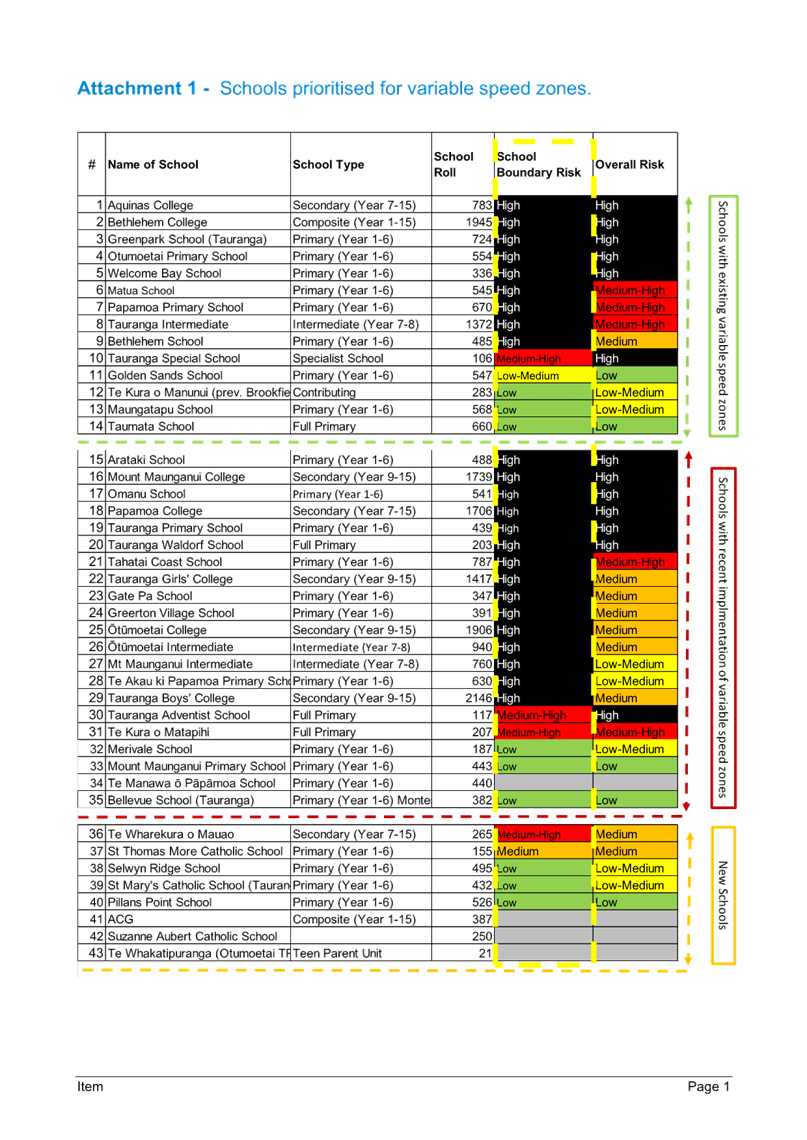
|
Ordinary
Council meeting Agenda
|
9
December 2024
|
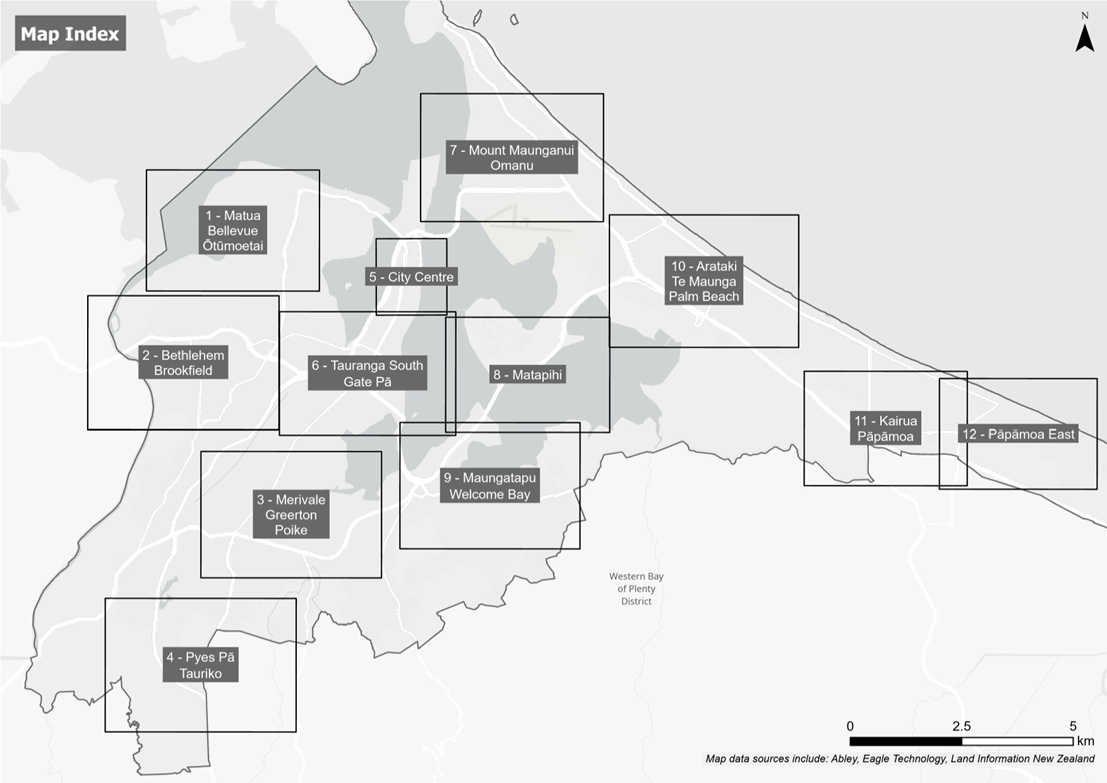
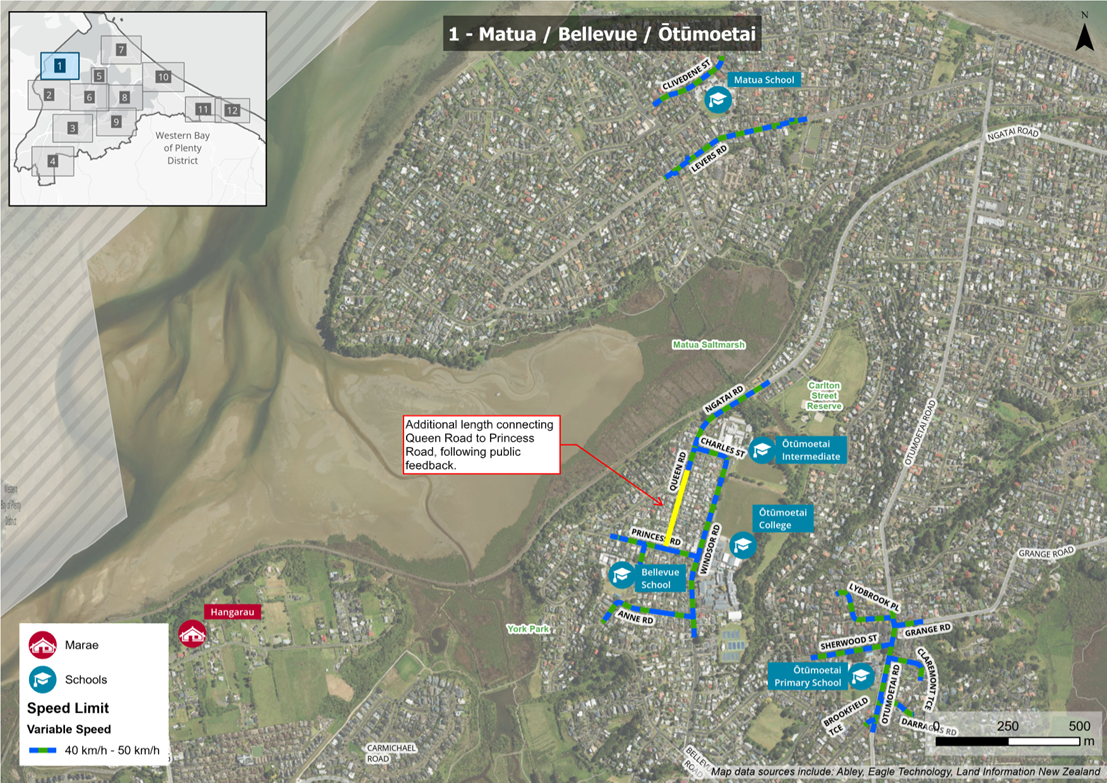
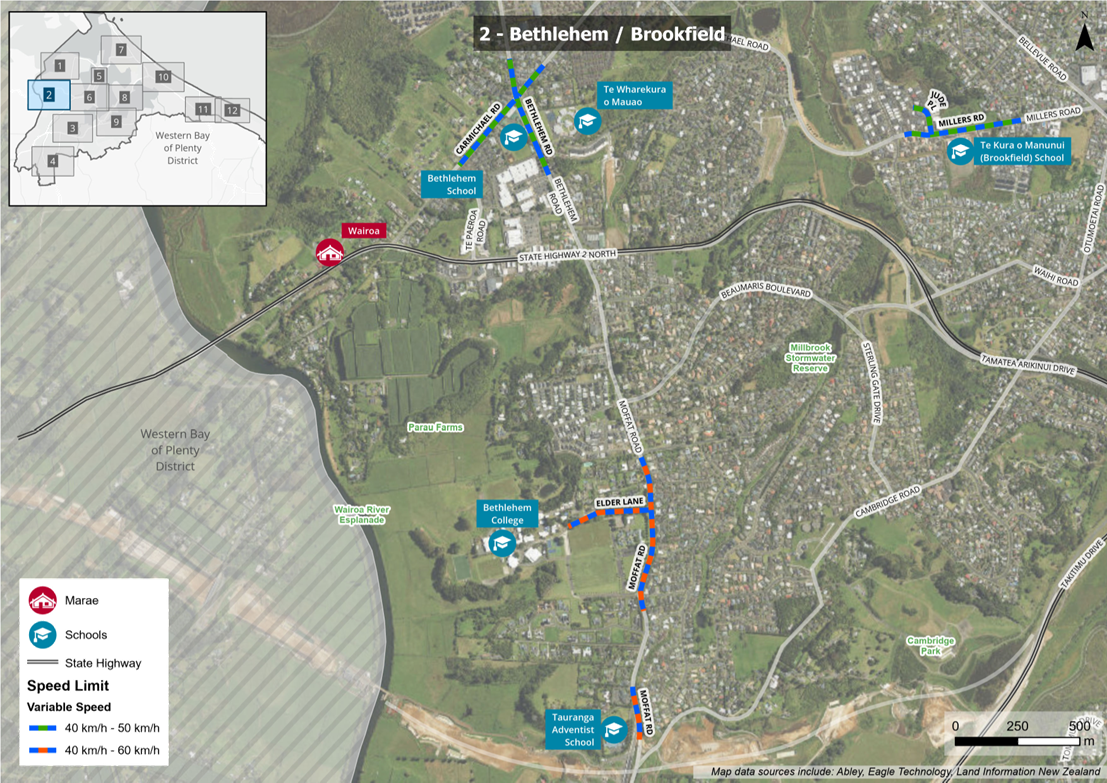
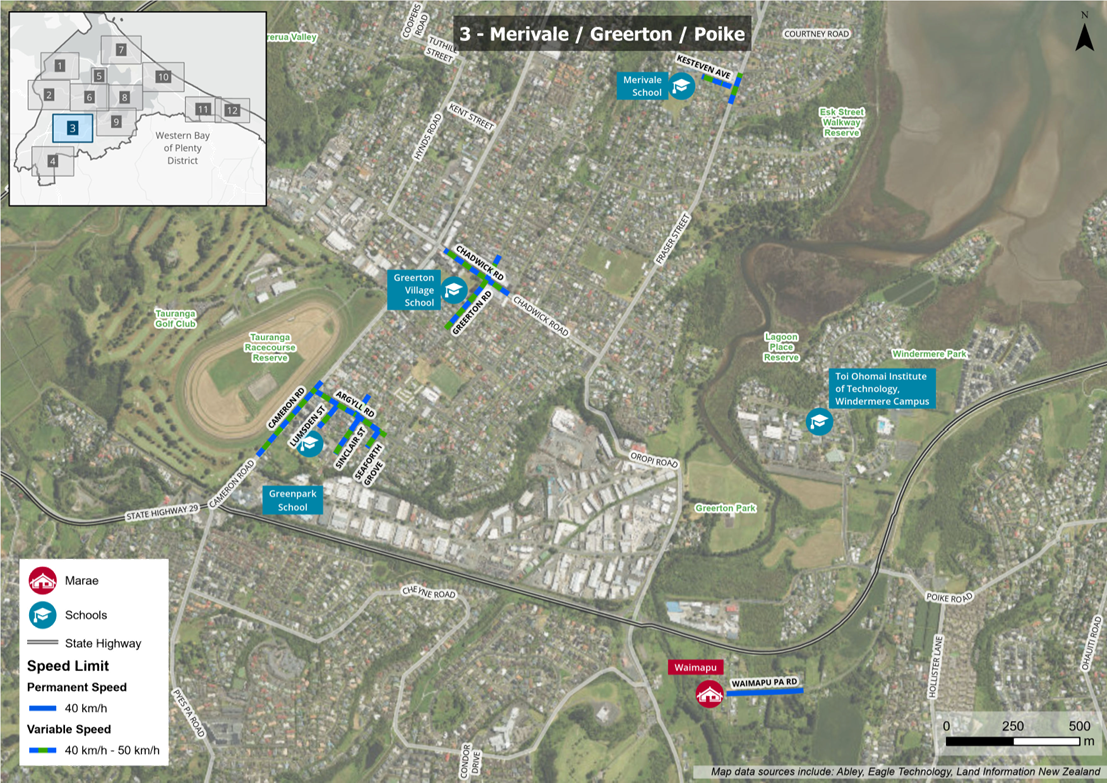
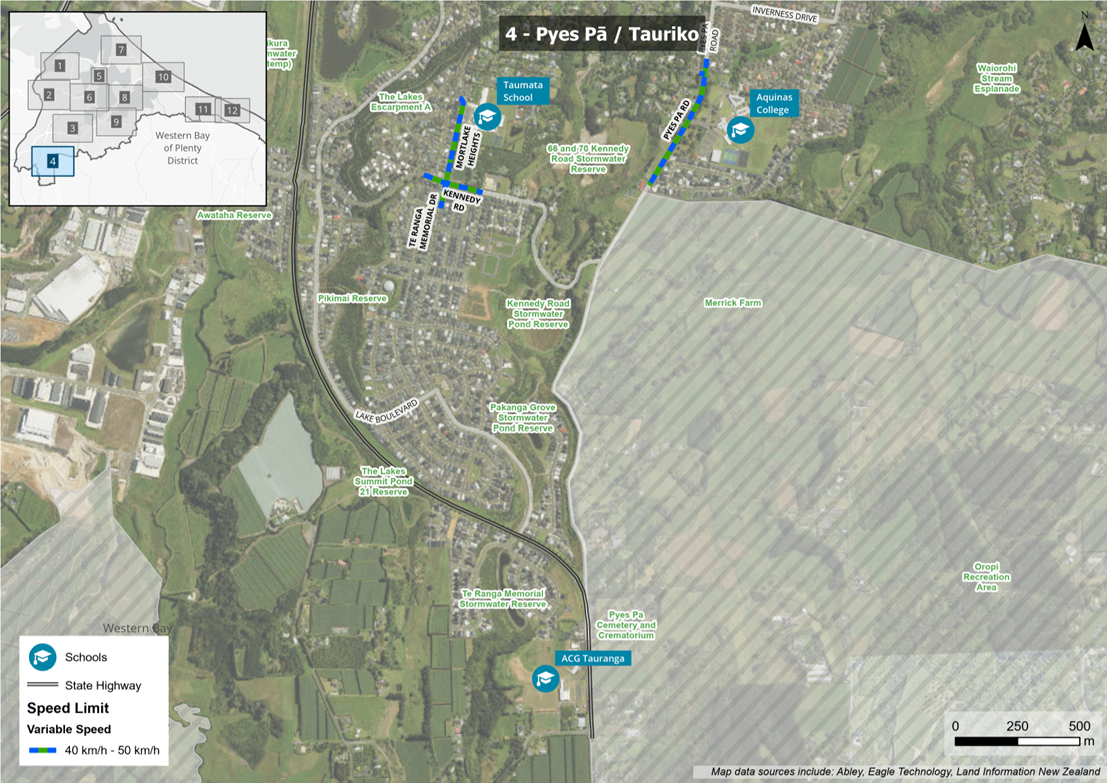
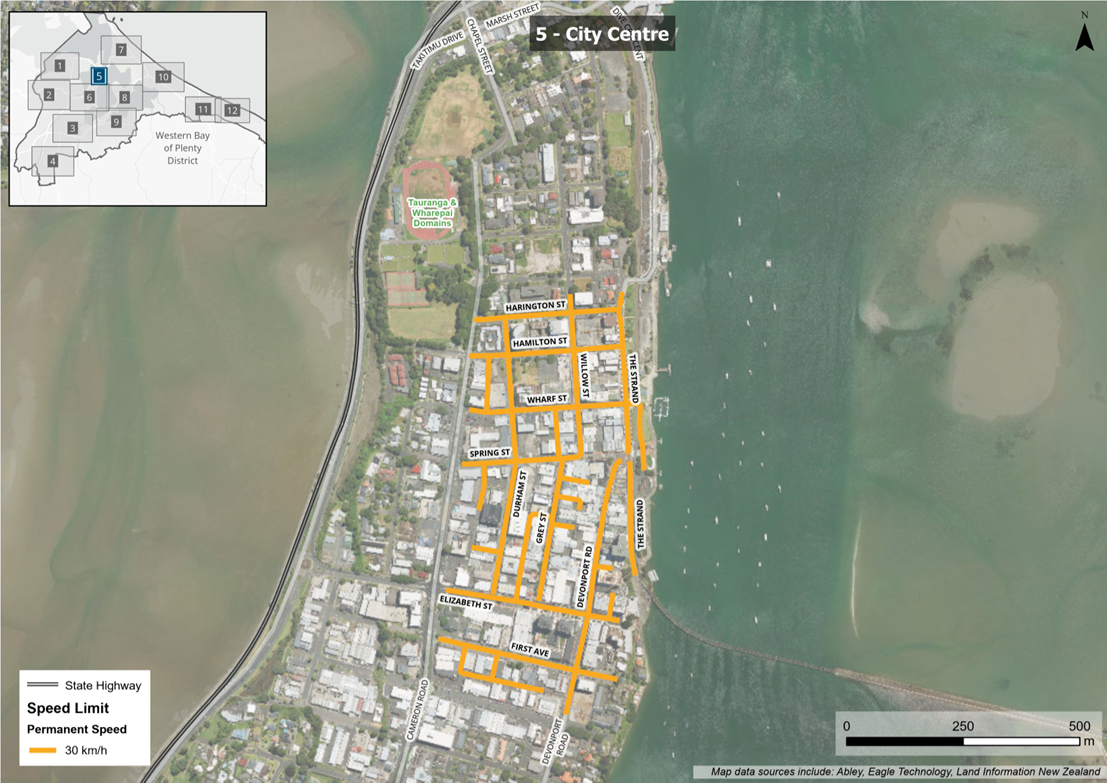
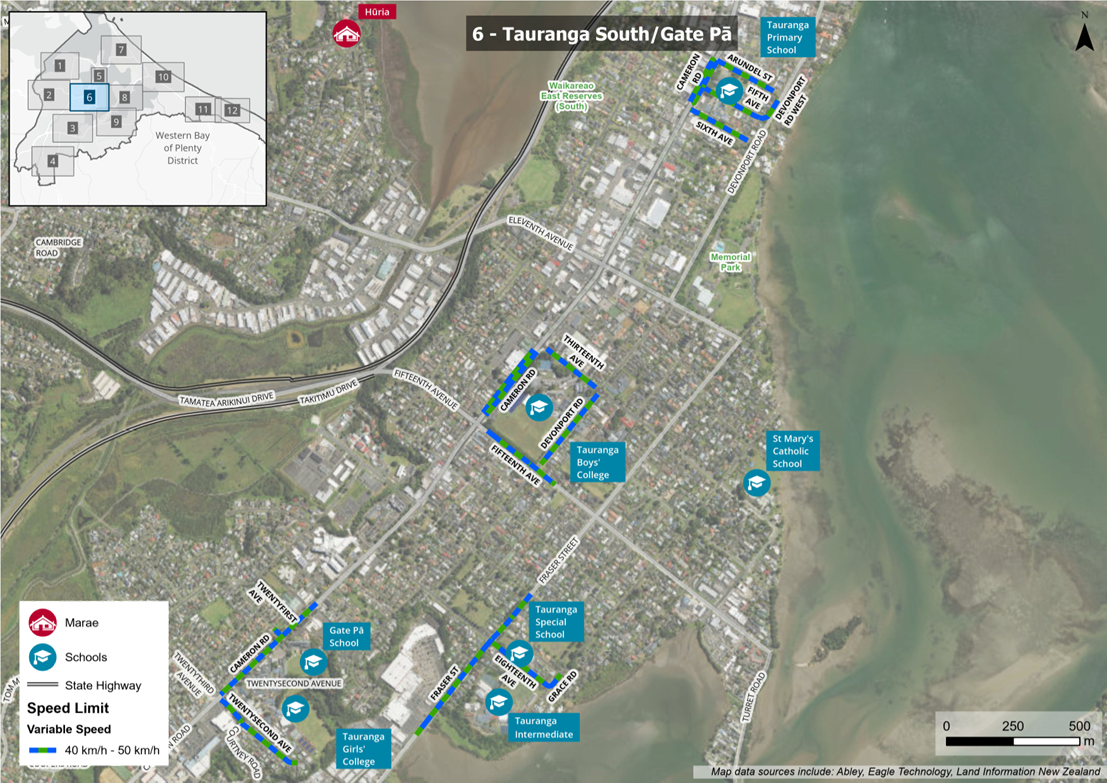
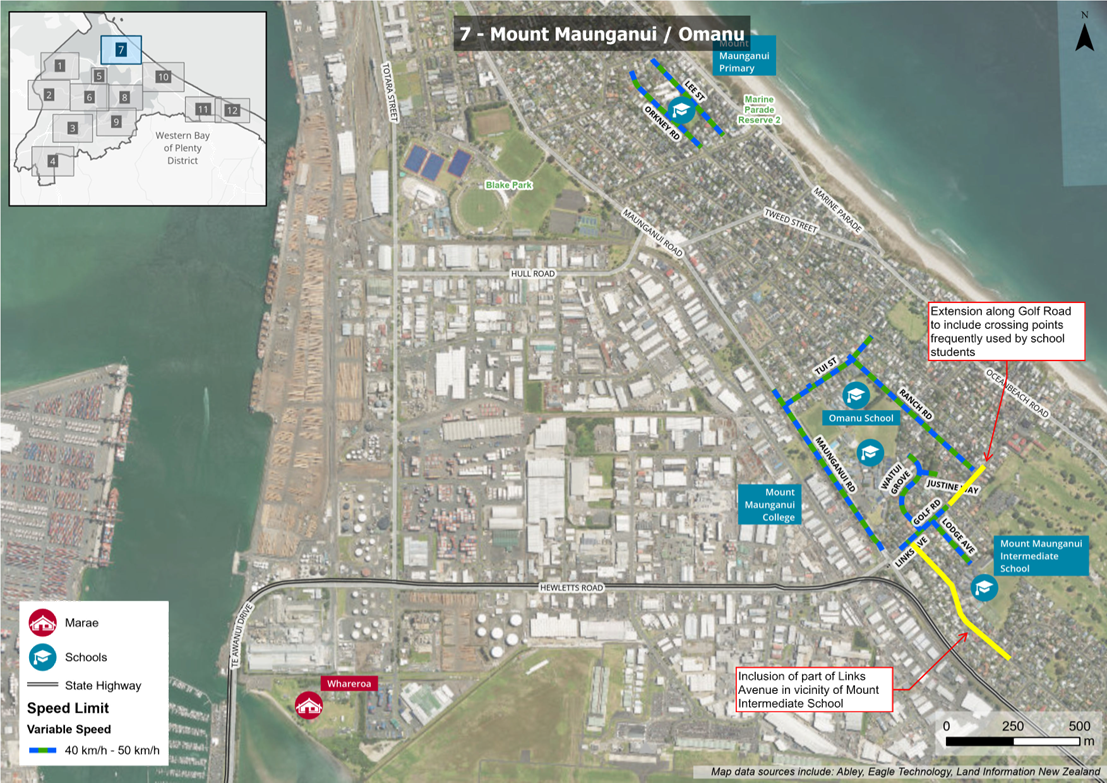
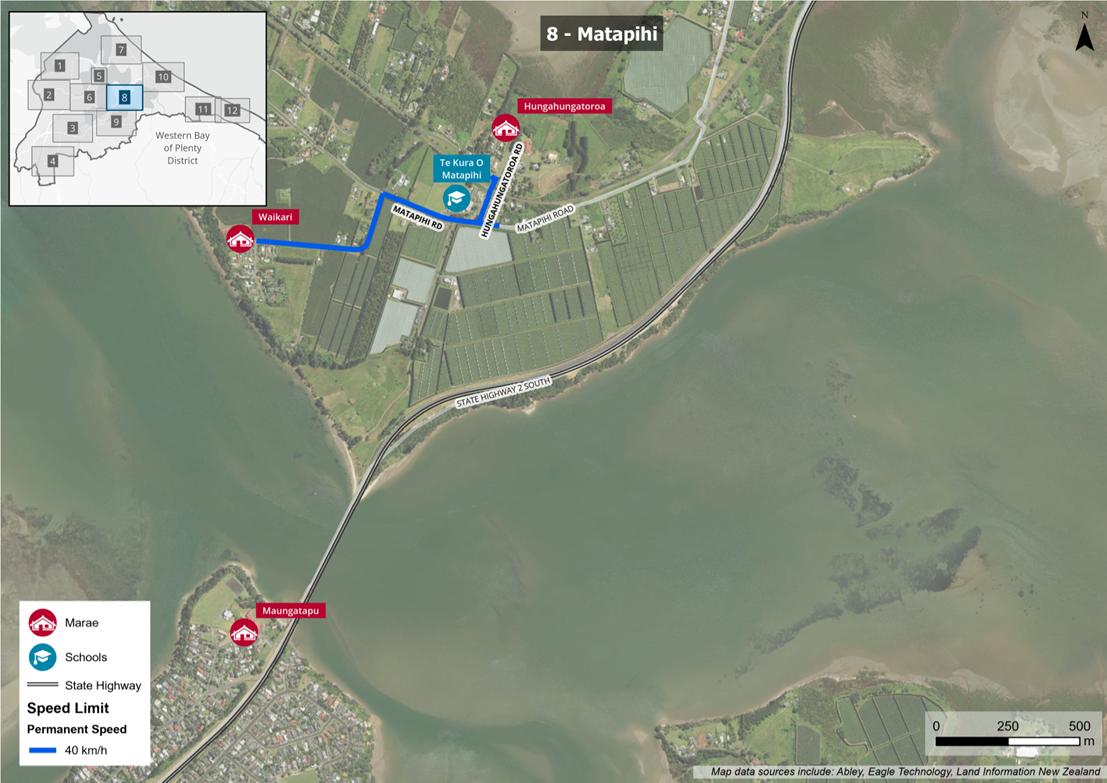
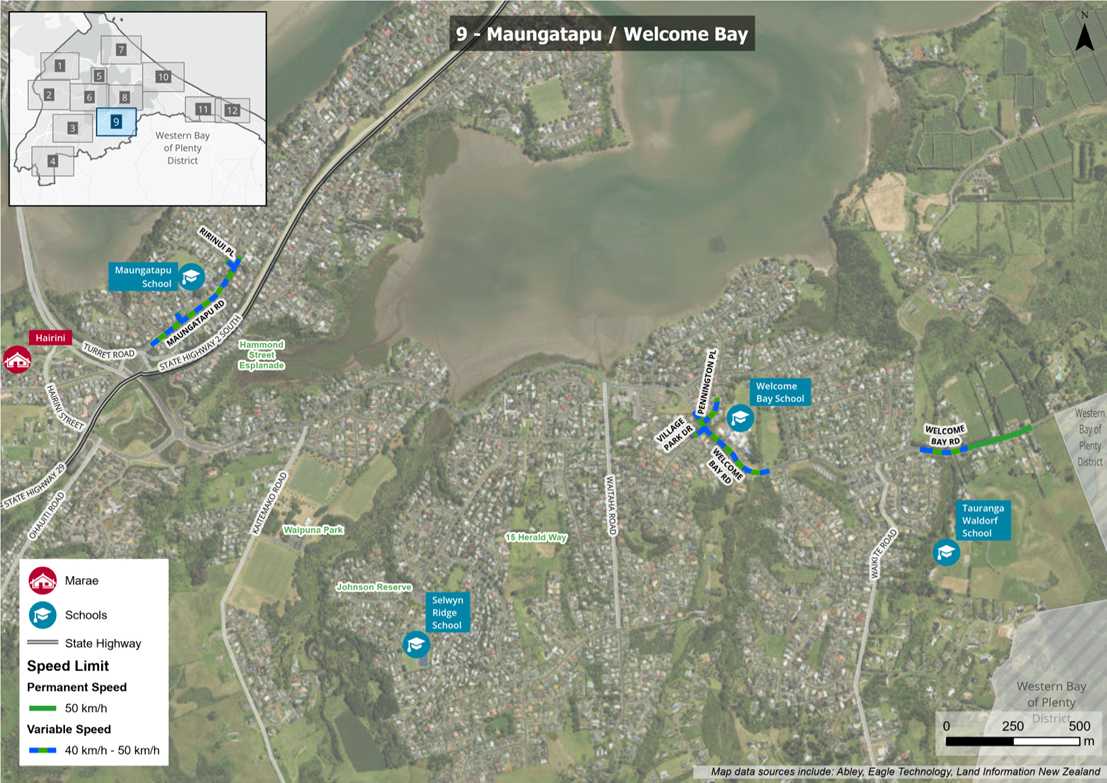
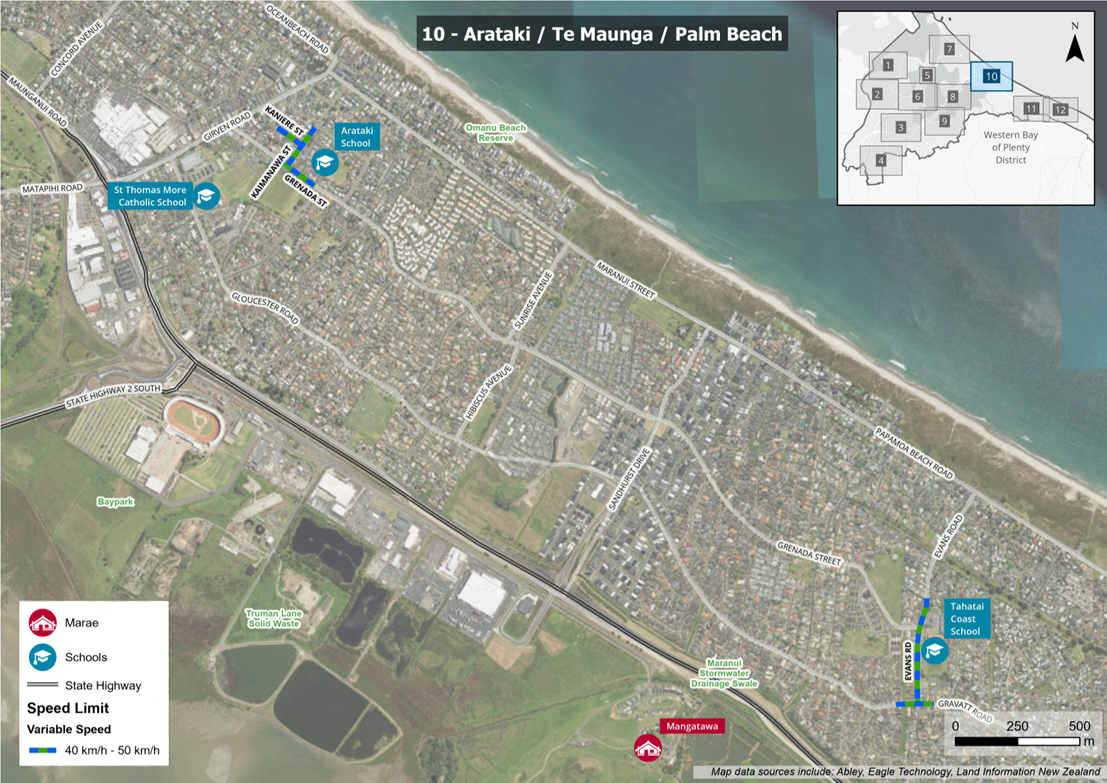
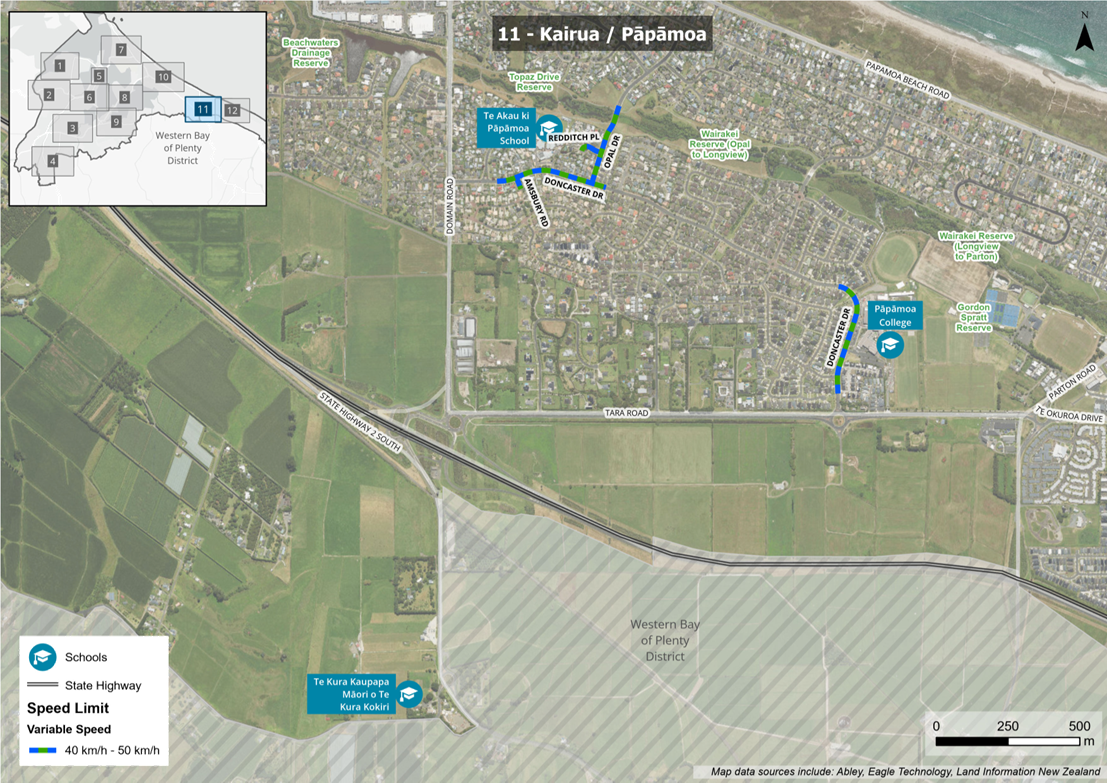
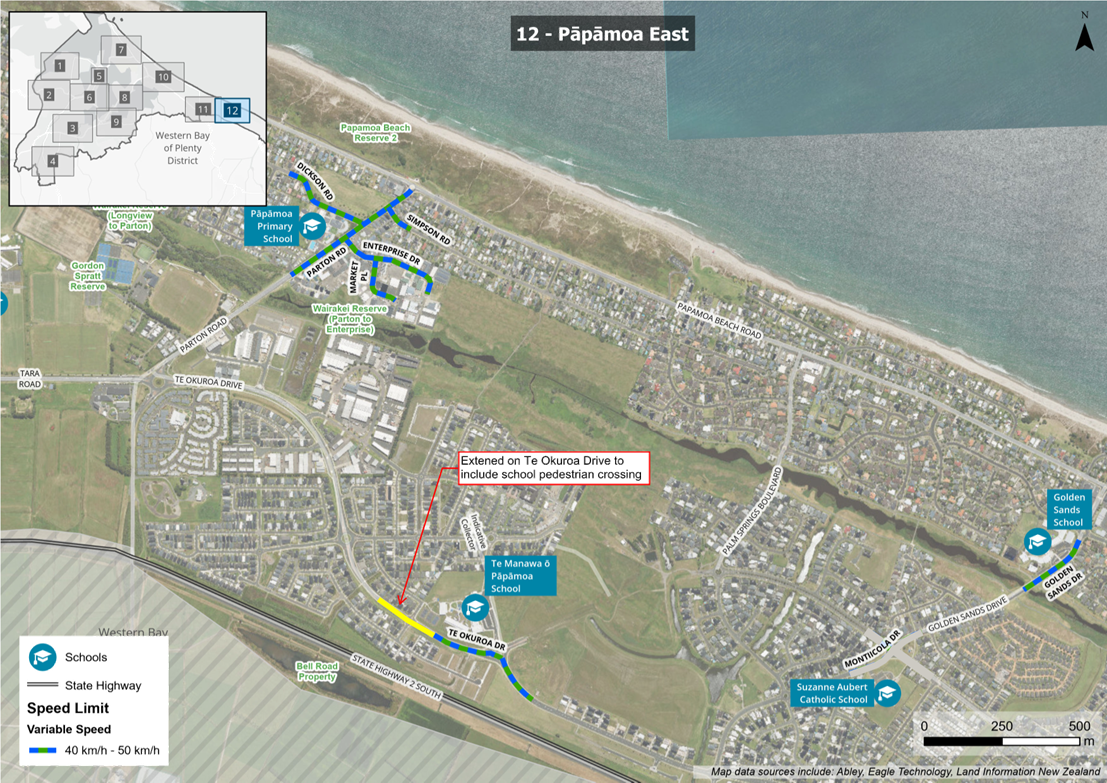
|
Ordinary
Council meeting Agenda
|
9
December 2024
|
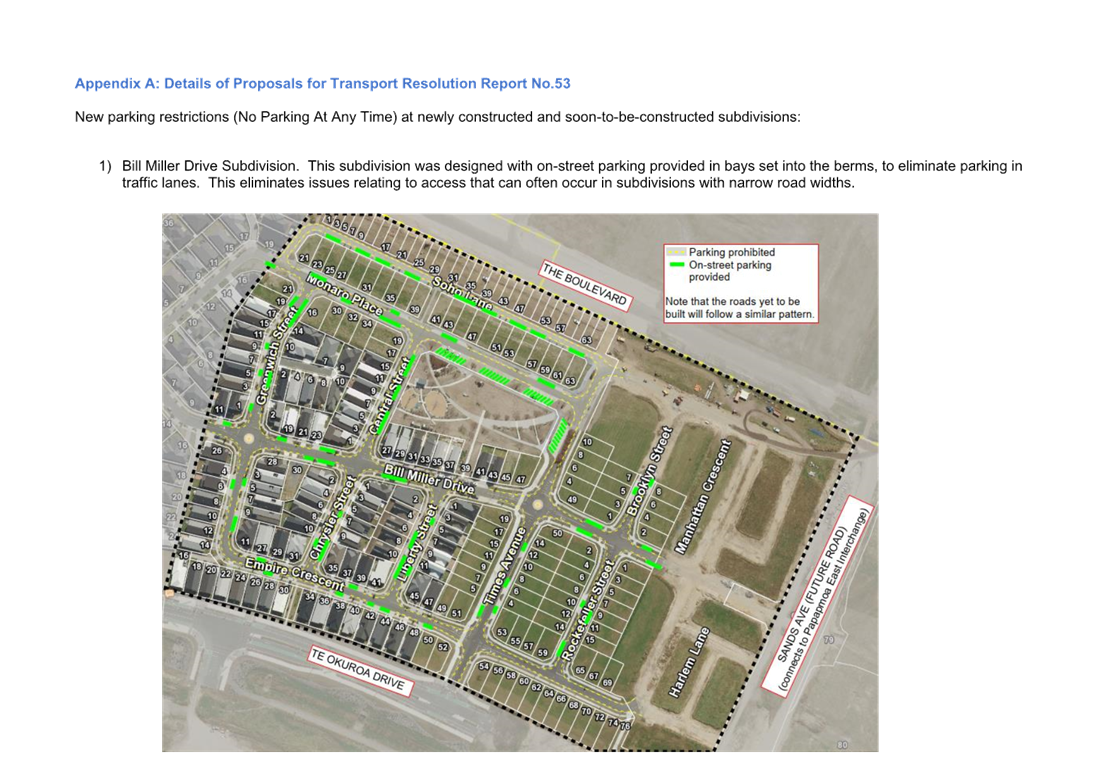
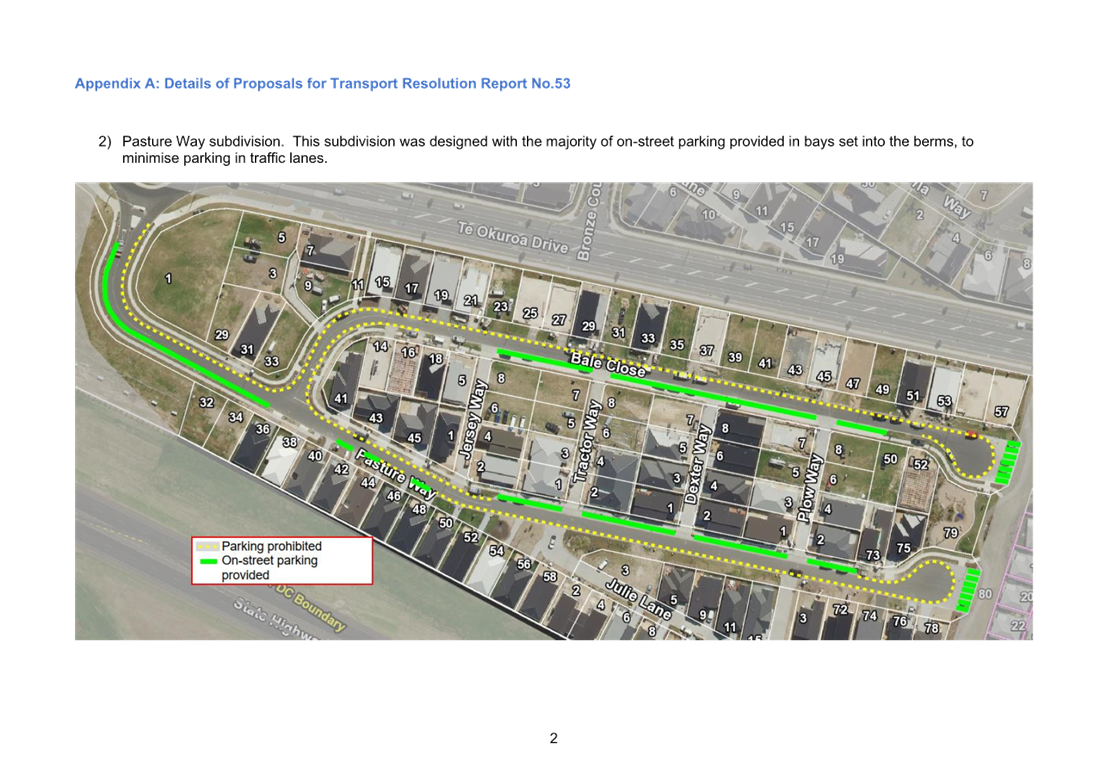
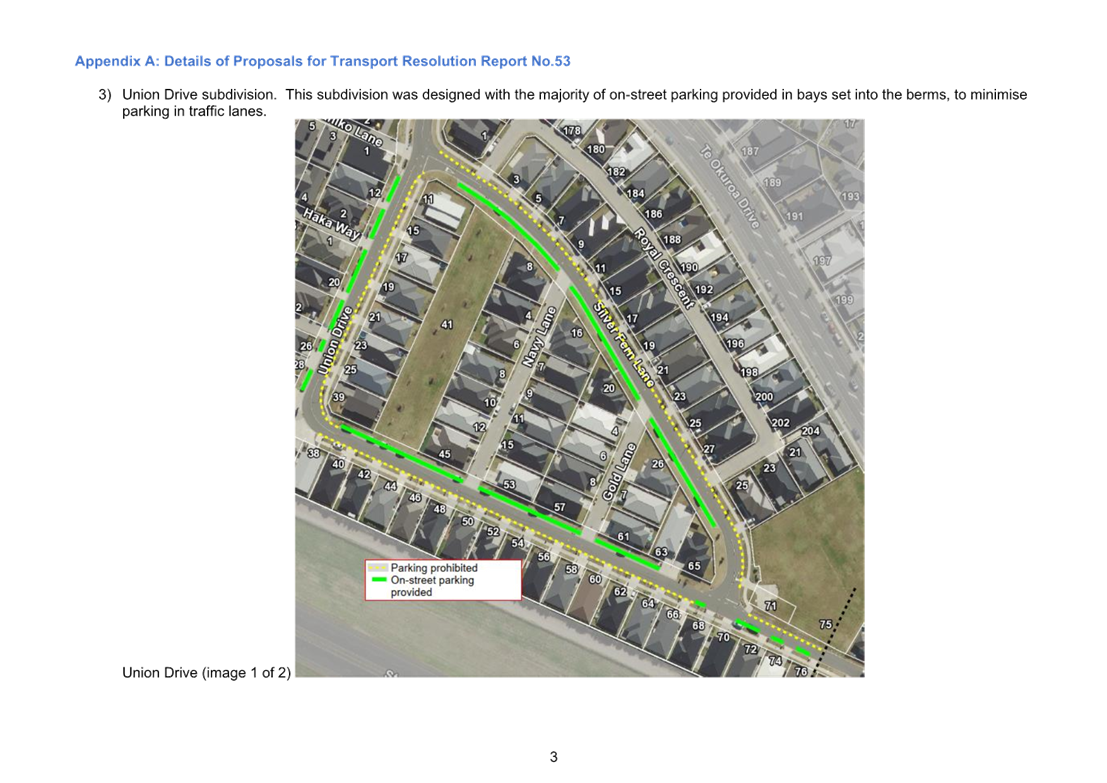
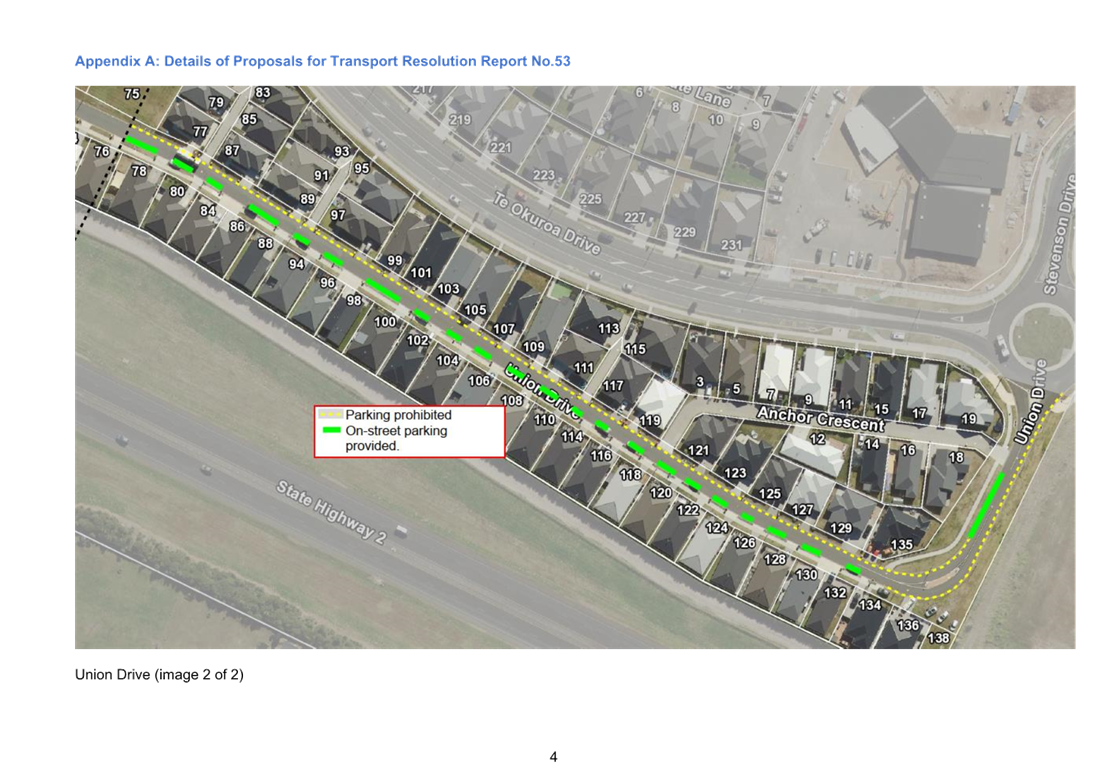
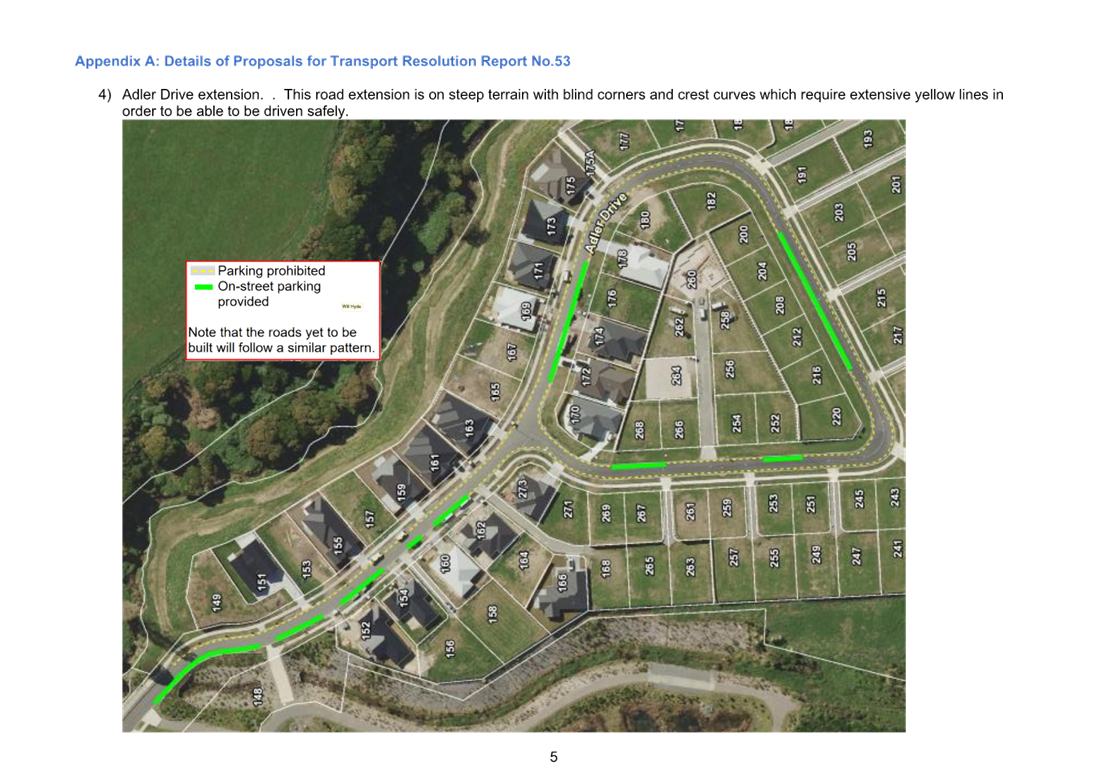
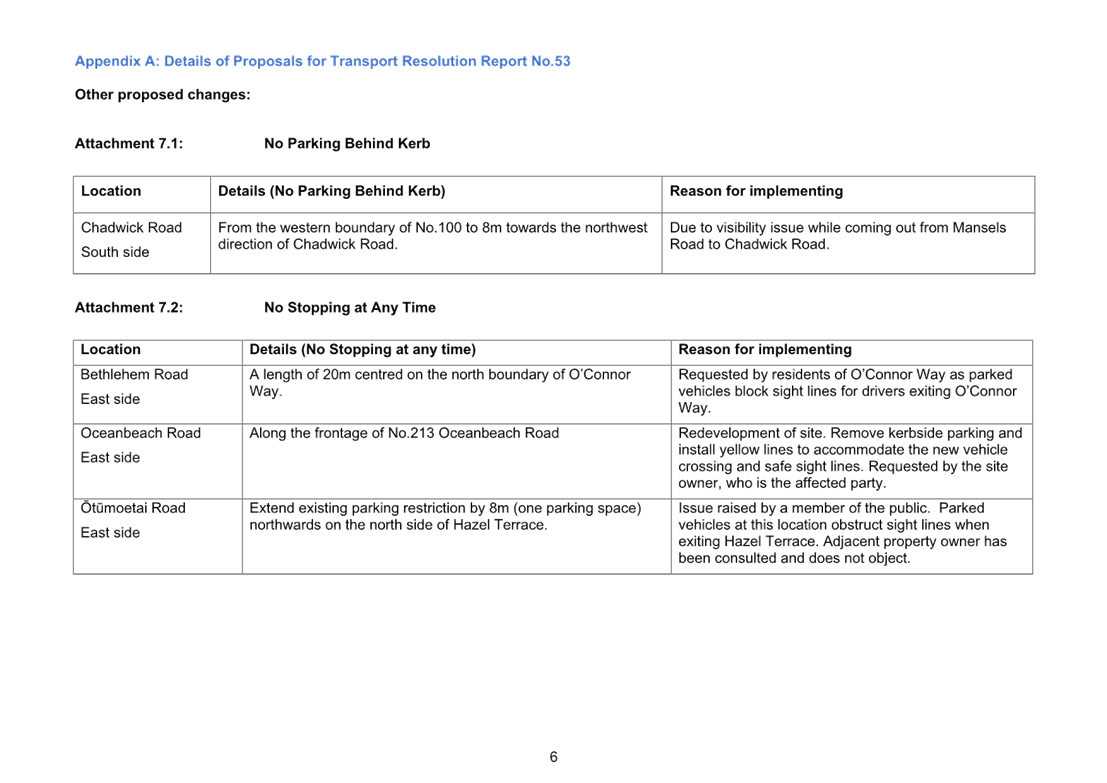

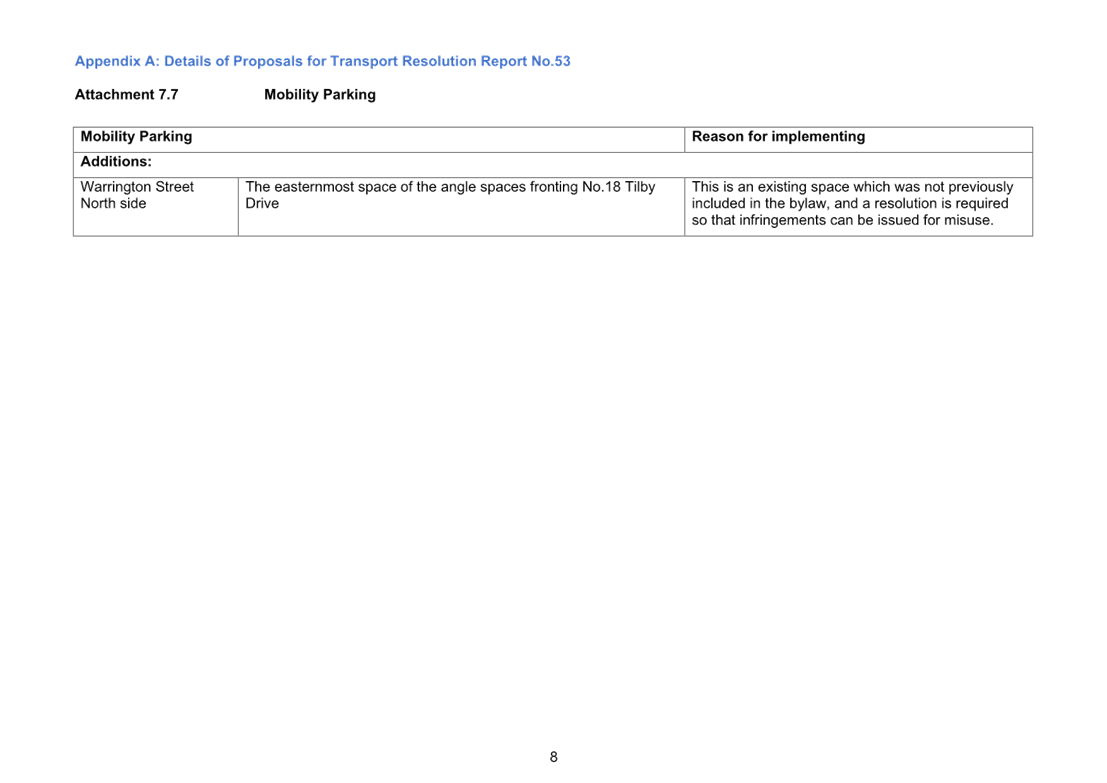
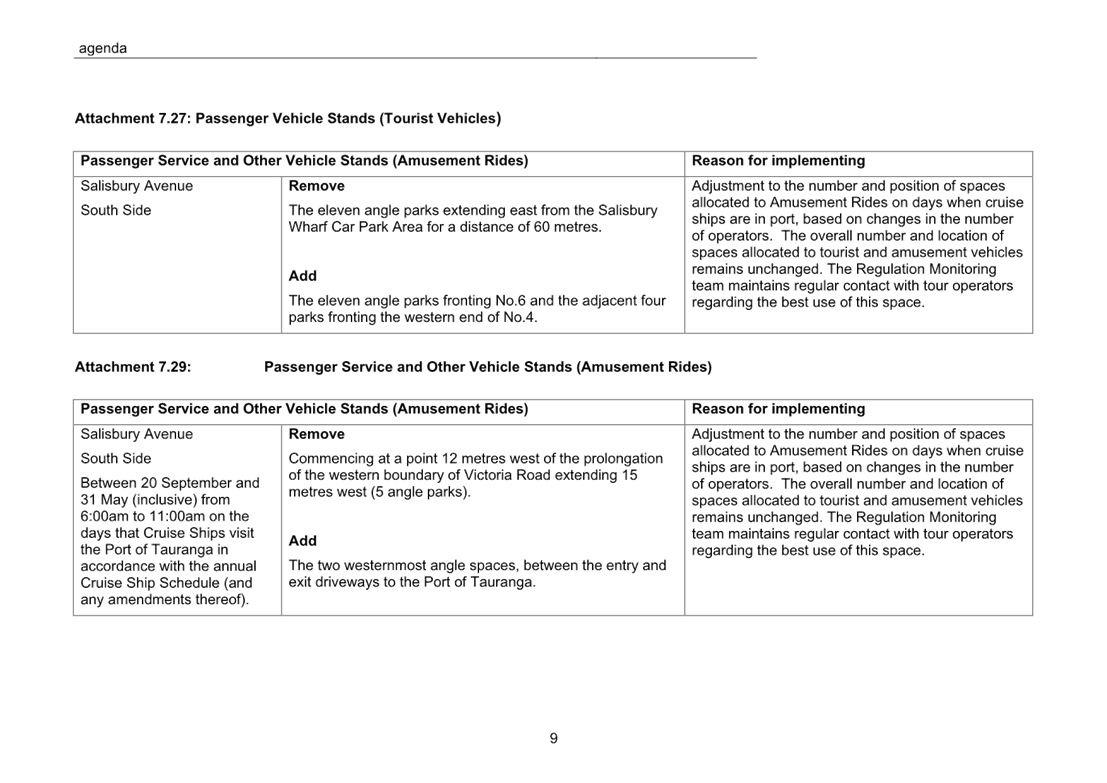
|
Ordinary
Council meeting Agenda
|
9
December 2024
|
11.7 Proposed Plan Change
39 - Upper Ohauiti Land Rezoning - Adoption and Notification of Decisions
File
Number: A17223626
Author: Brad
Bellamy, Project Leader: Urban Planning
Authoriser: Christine
Jones, General Manager: Strategy, Growth & Governance
Purpose of the Report
1. The purpose of this
report is to seek adoption of the recommendations and reasons of the
Independent Hearing Commissioner on Proposed Plan Change 39 – Upper
Ohauiti Land Rezoning (PPC 39).
|
Recommendations
That the Council:
(a) Receives the report
"Proposed Plan Change 39 - Upper Ohauiti Land Rezoning - Adoption and
Notification of Decisions".
(b) Pursuant to clause 29(4) of
Schedule 1 of the Resource Management Act 1991, accepts and adopts as its
decision the recommendations and reasons of the Independent Hearing
Commissioner on Proposed Plan Change 39 Upper Ohauiti Land Rezoning included
as Attachment 1 - Recommended Proposed Plan Change 39 Provisions, and
Attachment 2 - Recommendations on Submissions and Further Submissions.
(c) Delegates authority to the
General Manager Strategy, Growth & Governance to notify the decision in
accordance with clause 10 of Schedule 1 of the Resource Management Act.
(d) Delegates authority to the
General Manager: Strategy, Growth & Governance to approve any minor and
technical changes to the plan content set out in the recommended Proposed
Plan Change 39 Provisions (Attachment 1).
|
Executive Summary
2. Proposed Plan Change 39
– Upper Ohauiti Land Rezoning (PPC 39) is a private plan change promoted
by Landsdale Development Limited. The plan change request seeks to create a
Medium Density Residential Zone over approximately 23.5 hectares of Rural Zone
land on Upper Ohauiti Road.
3. The Plan Change was
accepted by Council in February 2024. Public notification of the proposed plan
change and primary submissions occurred over April and May this year and a
further submission period ran until 16 August 2024.
4. A hearing on this plan
change was held on 20 November 2024 and was conducted by an Independent
Hearings Commissioner (IHC). The IHC has made recommendations to the Council
and a decision of the Council is required on these recommendations.
Background
5. Landsdale Development
Limited requested a change to the Tauranga City Plan (City Plan) in accordance
with clause 25(2)(b) of Schedule 1 of the Resource Management Act 1991 (RMA).
This private plan change request was accepted by Council on 12 February 2024.
6. This request sought to
rezone land located at 120 and 125 Upper Ohauiti Road. The total area of the
property measures 56.4 hectares and is situated on Upper Ohauiti Road at the
southern extend of the city’s territorial boundary.
7. The proposal included
the creation of a Medium Density Residential Zone measuring approximately 23.5
hectares with the intention to deliver up to approximately 470 new homes over
the next 10-15 years.
8. This land is identified
within the SmartGrowth Strategy 2024-2074 as a growth area (Ohauiti South)
where residential development is anticipated to commence within the medium term
(2027 – 2034). This land is shown in Figure 1.

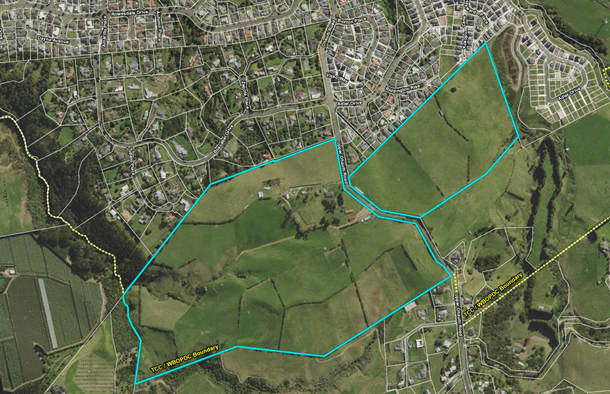
Figure 1: Aerial Photo showing land at 120 Upper
Ohauiti Road
9. PPC 39 was publicly
notified on 29 April 2024. The summary of decisions requested by submitters was
released in August and the further submission period ended on 16 August 2024.
10. A total of 32 submissions and one
further submission were received on PPC39. Several submitters requested to be
heard, and therefore Council was required to hold a hearing.
11. A report pursuant to section 42A of
the RMA (‘section 42A report’) was prepared by an independent
planning consultant and released on 30 October 2024. The section 42A report
considers the matters raised by submitters and provides recommendations in
response to those submissions. Its purpose is to assist the IHC in making
recommendations to Council in relation to the submissions and further
submissions received on the proposed plan change.
12. The Hearing for PPC 39 was held on
20 November 2024. The IHC issued his recommendations on 26 November 2024.
Attachment 3 includes the full IHC recommendation report for this proposed plan
change.
13. The IHC was not delegated the power
to make a final decision on the proposed plan change, hence the IHC’s
recommendations are required to go to Council to make a decision.
14. Several key matters raised through
submissions were considered in detail during the hearing. These matters
related to transport and stormwater management.
15. In response to traffic related
concerns raised within submissions, and based on traffic evidence the section
42A report recommended that an upgrade would need to be in place on State
Highway 29A, (specifically an additional westbound lane between Poike Road
roundabout to Oropi Road roundabout), to enable full development across the
proposed plan change area. This upgrade was identified within the
applicant’s transportation assessment as being the most suitable measure
to alleviate not only existing congestion but also the additional effects that
would likely be generated by development within the plan change area. However,
at this point the investment necessary to provide this State highway upgrade is
not planned by NZTA and there is no certainty that it will be delivered in line
with development effects being generated, or at all.
16. The recommendation within the
section 42A report was that development within the western block (stage 2,
being the larger of the two land parcels), required this upgrade to be in
place. If this was not the case, a resource consent would be required that specifically
addresses the traffic related impacts of this including the need to provide
further detailed traffic assessment and modelling. If Council was not satisfied
that adverse effects could be appropriately addressed, then it would have the
ability to decline resource consent. The recommendation of the IHC has
supported this approach to impose the additional requirement on subdivision and
development within the western block.
17. It is noted that subdivision and
development within the eastern block (stage 1, expected to yield between
110-145 homes) will not be subject to the SH29A upgrade requirement. This
staged approach was supported by technical assessment that concluded that the
additional development enabled within this smaller block could be accommodated
without generating any further significant reduction in the safety or
efficiency of the existing local road network. Any development within the plan
change area is however required to deliver an upgrade to Upper Ohauiti Road
which includes establishing new footpaths, cycle lanes and a new roundabout at
the site entrance, which will also accommodate bus manoeuvring to allow for the
potential future expansion of the public bus service to this area.
18. In respect to stormwater
management, subdivision and future development within the plan change area will
be required to connected to a Council owned stormwater system. The section 42A
report recommended that this stormwater system be designed to ensure all
relevant stormwater run-off effects from development are managed including
ensuring run-off effects on waterways are managed and that there is no increase
in flooding impact to downstream properties. The proposal included a
comprehensive stormwater management assessment that demonstrated that a
stormwater system could be constructed to support urban development of this
land and satisfy Council’s Infrastructure Development Code and Regional
Council consenting requirements. The applicant would be responsible for
obtaining any regional council consents required to develop the site including
the approval of stormwater discharge from the site. The IHC has
recommended that provisions are included that require stormwater management be
undertaken in accordance with the assessments undertaken and any relevant
stormwater discharge consents.
Statutory Context
19. PPC 39 seeks to rezone land located
on Upper Ohauiti Road within the jurisdictional boundary of Tauranga City
Council. Under section 34A of the RMA Council appointed an IHC to exercise and
perform the functions, powers or duties required to hold a hearing under the
RMA and make recommendations to the Council. The terms of this appointment did
not include the approval of the proposed plan change under clause 29(4) of
Schedule 1 of the RMA. The IHC’s recommendations have now been provided
and the Council can proceed to make a decision under clause 29(4) of Schedule 1
of the RMA.
20. The Council’s decision is
required to be made in accordance with the processes and statutory
considerations under the RMA, as set out in the Independent Hearing
Commissioner Report. However, the Council’s usual decision-making
requirements have been addressed below for completeness.
STRATEGIC ALIGNMENT
21. This contributes to the promotion
or achievement of the following strategic community outcome(s):
|
Contributes
|
|
We are an inclusive city
|
☐
|
|
We value, protect and enhance the environment
|
ü
|
|
We are a well-planned city
|
ü
|
|
We can move around our city easily
|
ü
|
|
We are a city that supports business and education
|
☐
|
22. PPC 39 aligns with many of the key
strategic outcomes being sought for the city.
23. The recommendations of the IHC have
considered the assessments provided with PPC 39 that have demonstrated how a
proposed rezoning of this site will enable development that supports the
wellbeing of the natural environment through protection and enhancement of
wetlands and freshwater bodies.
24. The recommendations of the IHC
considers that the proposed plan change enables land for housing purposes which
will be supported by open space and the delivery of neighbourhood amenities.
25. The recommendations have carefully
considered the evidence including submissions and supports the inclusion of
provisions for the upgrade of the local road network immediately adjoining the
site to support development outcomes within the plan change area including the
delivery of internal roading infrastructure that promotes transport choice and
public transport use. It also considers that subdivision and development across
the entire plan change area should only proceed on the basis of upgrades being
in place on SH29A or through separate resource consent processes that
specifically address traffic related impacts on the local road network.
Options Analysis
26. Council has two options:
(a) Accept the Independent
Hearing Commissioner’s recommendations.
(b) Not accept the Independent
Hearing Commissioner’s recommendations. Note that any intention to depart
from the Independent Hearings Commissioner’s recommendations would
require further advice, given that the Council did not conduct the hearings and
hear submitters first hand.
27. Option (a) is recommended as the
IHC has carefully weighed up the evidence including matters raised through
submissions in coming to the recommendations before Council.
Financial Considerations
28. There are no financial
considerations associated with this report. PPC 39 is a private plan
change and all costs incurred from the processing of this are recoverable from
the proponent of the plan change. This was a matter considered by Council in February
where it was resolved that full cost recovery in adherence with Council policy
was to occur.
29. Staff are currently in the process
of preparing a developer’s agreement to ensure that development enabled
through this plan change contributes to the funding of all necessary
infrastructure to service this growth area.
Legal Implications / Risks
30. PPC 39 has been prepared and
notified to meet the legislative requirements of Schedule 1 of the RMA.
In accordance with clause 29(4) and 10 of Schedule 1 of the RMA, Council is
required to make and then notify a decision on this proposed plan change.
TE AO MĀORI APPROACH
31. Consultation with relevant hapu and
iwi was undertaken by the plan change proponent as part of the preparation of
the plan change, as required by the RMA. Consultation was also undertaken by
the Council prior to notification and prior to appointment of the IHC.
CLIMATE IMPACT
32. PPC 39 has been prepared with
consideration to the effects of climate change on the use and development
enabled through this proposed plan change. Specifically, the plan change has
considered the effects of climate change in respect to assessing flooding and
other natural hazard risk, stormwater management including the use of low
impact stormwater design, and infrastructure to support transport mode choice.
Stormwater modelling has been undertaken using the latest parameters for
climate change. These matters have been considered as part of the preparation
of the recommendations by the IHC.
Consultation / Engagement
33. Schedule 1 of the RMA requires plan
changes to be publicly notified for submissions and further submissions. This
is in addition to the engagement process that occurred as part of the
development of PPC 39 by the proponent.
34. The applicant undertook
consultation with relevant hapu and iwi prior to the proposed plan change being
submitted to Council. Open days were also carried out and helped inform the
content of the request. All parties then had the opportunity to participate in
the submission and hearing process in accordance with the RMA.
Significance
35. The Local Government Act 2002
requires an assessment of the significance of matters, issues, proposals and
decisions in this report against Council’s Significance and Engagement
Policy. Council acknowledges that in some instances a matter, issue,
proposal or decision may have a high degree of importance to individuals,
groups, or agencies affected by the report.
36. In making this assessment,
consideration has been given to the likely impact, and likely consequences for:
(a) the current
and future social, economic, environmental, or cultural well-being of the
district or region
(b) any persons who are likely to be particularly
affected by, or interested in, the decision.
(c) the capacity of the local authority
to perform its role, and the financial and other costs of doing so.
37. In accordance with the
considerations above, criteria and thresholds in the policy, it is considered
that the decision is of medium significance.
ENGAGEMENT
38. Taking into consideration the above
assessment, that the decision is of medium significance, given the engagement
undertaken as part of the preparation of the plan change and the subsequent
public submission and hearing process. Officers are of the opinion that no
further engagement is required prior to Council making a decision.
Next Steps
39. Council’s decision on the
proposed plan change is publicly notified.
40. There is a 30-working day period
where a submitter can appeal Council’s decision to the Environment Court.
41. If no appeals are received, then
the plan change is beyond challenge, and it is made operative and incorporated
into the City Plan. In that instance a report will come to Council in the New
Year, seeking approval of the plan change.
Attachments
1. Recommended
PPC 39 Provisions - 26 November - A17228022 (Separate Attachments 1) 
2. Recommendations
on Submissions and Further Submissions - A17228026 (Separate Attachments 1) 
3. IHC Recommendation
Report - PPC 39 - 26 November - A17228021 (Separate Attachments 1) 
|
Ordinary
Council meeting Agenda
|
9
December 2024
|
11.8 Local Water Done Well
- Indicative Business Case on the Future for Water Service Delivery
File
Number: A16475737
Author: Stephen
Burton, Transformation Lead - Water Services
Cathy Davidson,
Manager: Directorate Services
Sarah Stewart,
Principal Strategic Advisor
Kathryn Sharplin,
Manager: Finance
Authoriser: Christine
Jones, General Manager: Strategy, Growth & Governance
Purpose of the Report
1. This report presents the
‘Indicative Business Case on the Future for Water Service Delivery’
(Indicative Business Case) for adoption (Attachment 1).
2. The purpose of the
Indicative Business Case is to assist the Council to develop a response to
Local Water Done Well and to recommend a preferred way forward – a
jointly owned three-water Council Controlled Organisation (CCO) that is
mutually beneficial to both partners and can grow to include multiple councils
over time.
3. Consultation
and engagement with Iwi and Hapū partners and with our communities are
critical next steps to inform future decision-making on the intention for the
future of water service delivery (refer Attachment 2).
|
Recommendations
That the Council:
(a) Receives the report "Local
Water Done Well - Indicative Business Case on the Future for Water Service
Delivery" and the accompanying Indicative Business Case (Attachment 1).
(b) Rescinds resolution
CO11/24/5 made at the Council meeting on 20 May 2024 that “Approves
the preferred option of establishing a Council Controlled Organisation (CCO)
model with Western Bay of Plenty District Council”.
(c) Adopts the
Indicative Business Case and approves that the preferred way forward for the
future of water service delivery is:
(i) The
establishment of a three-water jointly owned Tauranga City Council and
‘debt capacity council’ CCO; and
(ii) If no
suitable ‘debt capacity council’ is ready to proceed with
establishing a jointly owned CCO by 1 July 2026, then a Tauranga City Council
independent CCO should be established with a view to moving to the preferred
joint or multiply owned CCO in the future.
(d) Delegates the General
Manager Strategy, Growth & Governance to make minor changes to the
Indicative Business Case prior to its finalisation.
(e) Notes that Council is
willing to engage with any council that has a formal mandate, shared vision
and that can demonstrate mutually beneficial outcomes through a
joint/multiply owned water service delivery CCO.
(f) Notes that staff will
develop and report back to Council with a set of establishment principles,
criteria, and safeguard mechanisms to apply to any joint or multiply owned
CCO to ensure beneficial arrangements are able to be identified and
implemented, including:
(i) The establishment of
fair and equitable outcomes
(ii) That due diligence is
undertaken, including:
· that
current and future investment requirements are adequately identified
· that
financial and asset positions are independently verified to ensure mutual
benefit
· that
risks are identified, understood, and mutually agreed to be manageable within
available mitigation mechanisms and funding
· that
current and future debt capacity is understood and is sufficient to allow for
the establishment of a viable joint CCO.
(iii) That there is mutual
agreement that costs will be ring-fenced in the short to medium term (5-10
years) before transitioning to pricing alignment.
(g) Approves that staff
continue to have informal conversations with other councils, including
Western Bay of Plenty District Council, to progress the considerations listed
in (f) above, while noting that a final decision on whether to proceed (or
not) with a CCO option will be made after engaging with Iwi and Hapū and
with our communities.
(h) Approves the ‘Summary
communication and engagement approach’ (Attachment 2), which will be
undertaken in compliance the new consultation mechanisms provided for in
Sections 61-64 of the Local Government (Water Services
Preliminary Arrangements) Act 2024.
(i) Approves
that Council publicly consults alongside the Annual Plan on the:
(i) Current
delivery model (Status Quo); and
(ii) Jointly
owned three-water CCO involving Tauranga City Council and a
‘debt-capacity’ council, with the option to set up a stand-alone Tauranga
City Council CCO that other councils can join later if there is no suitable
or ready partner to proceed by 1 July 2026.
(j) Approves that based
on the preferred option, planning on the implementation phase will commence
immediately to ensure business readiness for future water services delivery.
(k) Notes
that the initial unbudgeted cost to establish
a CCO for 2025/26 and 2026/27 is estimated at $7 million (based on high level
Department of Internal Affairs advice).
(l) Notes that there is
projected to be a stranded cost disbenefit to the remaining organisation
(initial estimate between $7-10 million), with the potential for a
significant portion of this cost to be recovered in the short to medium term
through transitional arrangements between Council and the CCO.
Further work is required on potential stranded costs.
|
Executive Summary
4. Local Water Done Well
presents Tauranga City Council with an opportunity to explore alternative water
service delivery models. Changing the model for delivering water will
bring additional benefits to our already high-performing waters service. It may
also help to alleviate Council’s funding and financing challenges that
constrain investment in our fast-growing city.
5. The Indicative Business
Case (Attachment 1) aims to assist the Council to develop a response to Local
Water Done Well. The Executive Summary of the Indicative Business Case (pages 7
to 17) provides a summary picture of the work completed and the conclusions
reached. It recommends a preferred way forward being through a
council owned CCO. Analysis shows greater benefit in a jointly owned CCO based
on a second council with ‘debt capacity’ that could be utilised for
capital expenditure for the sub-region, for example growth projects. For
the purpose of the Indicative Business Case, a ‘debt-capacity
council’ represents councils that have capacity before reaching the Local
Government Funding Agency’s borrowing limits. The ability to achieve
mutually beneficial outcomes will be a priority consideration when selecting
partner organisations and, over time it is envisaged that this could grow to
include multiple councils.
6. Initial assessment
demonstrates that a jointly owned CCO may provide a positive path
forward. Next steps will include further discussions and due diligence to
establish mutual benefits; and engagement with both Iwi and Hapū and with
our communities to inform any future decision on water service delivery under
Local Water Done Well.
BACKGROUND
7. To date, Council has
received three reports on Local Water Done Well.
· On
29 April 2024, Council received an update on legislative developments and
planned work to support the new Government initiative.
· On
20 May 2024, a preferred structure for the future of water service delivery was
discussed, and the following resolution made:
(d) Approves the preferred option of establishing
a Council Controlled Organisation (CCO) model with Western Bay of Plenty
District Council.
This
resolution was made prior to the Local Government (Water Services Preliminary
Arrangements) Act which established the Local Water Done Well framework on 3
September 2024. Detailed analysis was not presented prior to this
resolution being made and therefore it is recommended that it be rescinded.
· On
26 August 2024, a further update was presented to Council that outlined
significant legislative and policy changes released by Central
Government. It also outlined Council’s approach to develop an
Indicative Business Case to explore future service delivery models under the
Local Water Done Well framework.
Indicative business case and key
points for consideration
8. An Indicative Business
Case, guided by The Treasury’s Better Business Case model, has been
developed and is presented for Council adoption. It provides an early
indication of the preferred option and is used to seek approval to move forward
with more planning and analysis. The attached Indicative Business Case takes a
holistic approach to investigate options for both water service delivery and
the Tauranga City Council organisation (including impacts on the remaining
Council if the water activity is to be transferred).
9. Staff have been working
in collaboration with ‘Rationale Ltd’, investment management
specialists, to support this work. This has been overseen by an Executive
Oversight Group consisting of four General Managers and relevant staff.
Investment logic mapping and multi-criteria analysis are core tools used to
develop the Indicative Business Case. Investment logic maps are used to help
understand a problem, its impacts, and desired benefits before looking at
solutions. Multi-criteria analysis is used to identify and compare
different options by assessing their effects, costs, impacts and
trade-offs.
10. Financial modelling across options
has also been fully developed to provide greater understanding of the financial
costs and benefits for managing waters. The modelling was based on
2024-34 Long-term Plan data for Council and data provided for the purpose of
this analysis by potential future water CCO partners. Council’s Long-term
Plan data was the only consistent and reliable data available for analysis at
the time this Indicative Business Case was prepared. The financial data
for Council is being updated as part of the annual planning process and some
updates to Council only analysis has been included in the annual plan update to
this meeting (refer 2025-26 Annual Plan Key Financial Update and LGFA Borrowing
Covenant Implications and Options). A cross check with recent financial
projections was carried out and conclusions were not materially different.
11. The Indicative Business Case
highlights the advantages of CCOs versus a ring-fenced in-house business unit,
including that the move towards a CCO model:
· provides
a pathway to slight improvements to financial sustainability but no option is
considered financially sustainable under Local Water Done Well parameters
(refer Financial Considerations Section).
· provides
a slight uplift in local and regional economic development with improvements in
debt capacity.
· improves
efficiency and effectiveness through focussed and experienced governance, and
through capital investment and management decision-making that solely focuses
on delivering the requirements of water services.
· will
have greater scrutiny from regulators, professional governors and shareholders
which will increase investment certainty.
· improves
access to more capital through Local Government Funding Agency’s
financing framework.
· aligns
with Central Government’s direction.
12. The Indicative Business Case also
outlines that the transfer of the waters’ activities will have an impact
on the remaining Council organisation. Stranded costs refer to the costs
that will remain with the organisation after the waters’ activities have
been transferred (and that would otherwise be attributed to the waters
activity). Further analysis is required to refine stranded costs, but an
initial estimate is between $7-10 million. It should be noted that a
significant portion of this cost may be recovered in the short to medium term
through transitional arrangements between Council and the CCO,
particularly in relation to digital services.
13. If the right partnering council(s)
can be identified and appropriate arrangements agreed, a jointly owned CCO
offers the most benefit with the view to grow to include multiple councils over
time. Further details about assets and financial arrangements will still
need to be developed before deciding on whether a joint arrangement is mutually
beneficial. It is proposed that the underlying principles and criteria
for partnering with another council will be further developed and reported back
to Council, along with findings from public consultation and engagement with
Iwi and Hapū.
14. Staff have been working with Western
Bay of Plenty District Council to consider if there are mutual benefits of
partnering in a joint CCO. This work is progressing and further due
diligence is required, particularly around financial information and the
ability to establish mutually beneficial outcomes. Non-financial benefits of
working with our neighbouring council are, however, evident and include:
· Partnering
on growth and transport planning through SmartGrowth
· Shared
services and joint arrangements across the water activities
· Recognising
Council’s strategic approach of ‘working beyond Tauranga’
– acknowledging that we are an integral part of the wider Bay of Plenty
region, and we have a key role in making a significant contribution to the
social, economic, cultural and environmental wellbeing of the region.
local water done well
15. Local Water Done Well is the
Coalition Government’s plan to address New Zealand’s longstanding
water infrastructure challenges. It was announced as part of the
Coalition Government’s 100-day plan, replacing the former government’s
Three Waters Reform Programme. A key feature of Local Water Done Well is to
provide councils with the flexibility to determine the optimal structure and
delivery method for water services, including the establishment of new,
financially separate water organisations with greater access to funding.
16. Significant changes in the operating
environment for water services is expected to occur over time in New Zealand
through Local Water Done Well. Adoption of new service delivery models,
new regulatory requirements, and new structural and financing tools are all
part of the Government’s Local Water Done Well policy, along with
economic regulation.
17. Legislation is currently being
progressed and the third and final Bill is planned to be introduced in early
December 2024. Until that legislation is enacted there will be
uncertainty over the specific provisions, however policy announcements highlight
the following principles underpinning the Government’s Local Water Done
Well:
· Greater
central government oversight, economic and quality regulation
· Fit-for-purpose
service delivery models and financing tools
· A
strong emphasis on meeting rules for water quality and investment in
infrastructure
· Ensuring
water services are financially sustainable.
18. Under the Local Water Done Well
framework, Council can continue delivering water services directly (such as
through in-house business units) or can establish a new water organisation that
is more financially and operationally independent of Council. For all
options, assets will remain in public ownership, either being owned by Council,
through a CCO, or a community trust.
19. New water organisations are intended
to enable enhanced access to long-term borrowing for water infrastructure
– supporting infrastructure development, while managing costs for
consumers. Local Government Funding Agency Limited has confirmed it will
provide financing to support water CCOs established under Local Water Done Well
and will assist high growth councils with additional financing. Local
Water Done Well policy also intends to make it easier for councils who wish to
enter joint arrangements to achieve cost savings, improve efficiency and
affordability.
20. All councils will need to develop a
Water Services Delivery Plan to publicly demonstrate the intention and
commitment to deliver water services in ways that are financially sustainable,
meet regulatory quality standards for water infrastructure and water quality,
and unlock housing growth. This approach will provide transparency to
communities in relation to costs and financing of water services. These plans
need to be submitted to the Government agency by 3 September 2025.
21. Another feature of Local Water Done
Well is that councils have a choice about separating stormwater services.
Stormwater services can be retained in-house, while drinking water and
wastewater services are provided through a water organisation.
Additionally, a water organisation can provide all three water services.
STRATEGIC ALIGNMENT
22. This contributes to the promotion
or achievement of the following strategic community outcome(s):
|
Contributes
|
|
We are an inclusive city
|
ü
|
|
We value, protect and enhance the environment
|
ü
|
|
We are a well-planned city
|
ü
|
|
We can move around our city easily
|
|
|
We are a city that supports business and education
|
ü
|
23. The social, cultural,
environmental, and economic wellbeing of our communities rely on adequate,
reliable, and resilient water networks. Waters service delivery are therefore
key contributors to the community outcomes that Council strives to achieve.
24. We are an inclusive city
– Water services are fundamental to social wellbeing and provide a daily
necessity. The health and social wellbeing of our communities rely on
adequate, reliable, and resilient water networks. Tangata Whenua have a
significant relationship with water that also needs strong consideration, no
matter which future water service delivery model is decided on.
25. We value, protect and enhance
the environment – Water supply, wastewater and stormwater management
can have a direct impact on the environment. How impacts are mitigated
and managed are vital to protecting our environment. Water services are
currently subject to significant environmental regulation, and Local Water Done
Well will introduce further regulations relating to stormwater management and
national standards for wastewater discharges, providing further environmental
protection for all future water service delivery models.
26. We are a well-planned city
– Planning for the implementation, renewing and upgrading of water
infrastructure is an inherent part of the long-term planning and asset
management process required by legislation. The way in which water
services are delivered may provide an opportunity for Council to deliver
investment that is required to support growth, contributing to a well-planned
city. Ensuring the ongoing integration of growth planning with water
services management will need to be a key consideration for any future model.
27. We are a city that supports
business and education – Water services are fundamental to economic
activity and social wellbeing, including businesses and schools. Approximately
10% of our water users are commercial users and water services play a
significant role in many of these businesses. Ensuring that businesses
are educated, supported, and contribute fairly towards water services is
important for any future water service delivery model.
Options Analysis
28. The Council has
two options for consideration:
(a) Option 1: Adopt the Future for
Water Service Delivery Indicative Business Case. (Recommended)
(b) Option 2: Do
not adopt the Future for Water Service Delivery Indicative Business Case. (Not
Recommended)
|
OPTION
ONE: Adopt the Indicative Business Case – Future for Water
Service Delivery
|
|
|
Benefits
|
Disadvantages
|
|
|
· Provides a robust and evidence-based framework to assess the
Department of Internal Affairs’ options under Local Water Done Well, enabling
the identification of a preferred way forward.
· Utilises a holistic methodology assessing and considering both the
waters activity and the impact on the remaining organisation (with
waters’ activities transferred).
· Provides a preferred way forward for consultation and engagement
with Iwi and Hapū and with the community.
|
· None.
|
|
|
|
|
OPTION
2: Do not adopt the Indicative Business Case – Future for Water
Service Delivery.
|
|
Benefits
|
Disadvantages
|
|
· None.
|
· No framework for robust and evidence-based decision-making on the
preferred way forward under Local Water Done Well.
· Council will need to identify a preferred way forward for public
consultation and for the development of a Water Service Delivery Plan, which
is legislatively required to be lodged with Central Government by 3 September
2025 under the Local Government (Water Services Preliminary Arrangements) Act
2024. Timeframes will be unmanageable if it is decided to
re-investigate alternative options under Local Water Done Well.
· Lost efficiencies in terms of work completed to date.
|
Financial Considerations
29. The financially sustainable
definition used in analysis in the Indicative Business Case is set by the Local
Water Done Well policy. Specifically, it requires that there is
sufficient:
(a) revenue to cover the
costs (including servicing debt) of water services delivery.
(b) investment projected
to meet regulatory requirements and provide for growth.
(c) finance to cover the
costs of a project or investment. It involves checking if the funds you
have or can get (loans investments and savings) are enough to meet all the
expenses needed to complete the project successfully.
30. For all options, financial
sustainability for waters is challenged by the high level of future capital
investment required. Future capital investment is needed to meet the
level of growth expected under the National Policy Statement – Urban Development
and to meet current understandings of regulatory requirements. This is
particularly difficult when the waters activity already carries a large amount
of debt relating to growth investment, such as the new Waiāri water
supply, future wastewater treatment costs, as well as providing lead infrastructure
to multiple growth areas.
31. Financial sustainability under
Local Water Done Well requires that there is adequate revenue able to be raised
to pay the operating costs of the business, to meet borrowing requirements, and
over time to repay debt to provide headroom for future investment.
Growth-related debt is repaid over a long timeframe through development
contributions with the annual interest charges capitalised until it is repaid
(meaning debt grows year on year). Revenue for large infrastructure, such
as Waiāri water treatment plant, is collected through city-wide
development contribution charges as new dwellings are built over the next 30
years. Operating costs for water services, including paying interest on
non-growth debt, are covered through charges to users. Revenue for services is
provided directly by consumers for wastewater and water services making these
operations akin to other utility services such as electricity. Stormwater
on the other hand is currently rate funded as services are not readily associated
with individual consumers. For this reason, revenue is likely to remain
as some form of rating through Council.
32. None of the options assessed in the
Indicative Business Case provide revenue sources other than those mentioned
above that come from ratepayers or consumers. Therefore, the ability to charge
enough to meet ongoing operating and borrowing requirements is limited to
assumptions around affordability for users. Under all scenarios, the cost of
three waters to consumers is expected to increase significantly over time.
33. CCO options provide a better
overall access to debt at competitive prices through the Local Government
Funding Agency by providing a higher borrowing limit overall (500% on waters
activities and 280-350% overall on other activities) without the Council having
to accommodate higher waters debt within its total borrowings.
34. The extra debt headroom can be
utilised through lower water charges to consumers than the current delivery
model. This is not a silver bullet as both the current delivery model and CCO
options are likely to be debt constrained. The Long-term Plan, that was based
on waters remaining within council, required higher charges to consumers to
create an operating surplus to retire debt in the last five years of the LTP.
An alternative to this higher charging for debt retirement may be off-balance
sheet funding of a portion of new projects through other funding mechanisms,
such as through the Infrastructure Funding and Financing Act 2020[34].
35. Set-up costs for a waters CCO have
been estimated at about $7 million. This figure is a high-level estimate
with no agreed breakdown and is based on Department of Internal Affairs
advice. The $7 million has been included in the debt figures in the
separate ‘2025-26 Annual Plan Key Financial Update and LGFA Borrowing
Covenant Implications and Options’ report to this meeting. It would be
expected that these costs would be loan funded by the new CCO. The amount
is modest in relation to the existing and future debt levels of the three
waters activity, with three waters debt projected to be $525m by 30 June 2025.
36. For the remaining Council (with
waters transferred), there would be a loss of revenue associated with three
waters (totalling $125 million in the year to 30 June 2025). Stranded
overhead costs have also been estimated at between $7 to $10 million for
services such as finance, people and capability, communications, legal and
procurement, and digital expenditure as well as existing allocation of
governance and executive overheads against the water revenue streams. A
portion of these overheads are likely to be recovered (at least initially) by
Council providing these services to the CCO and charging the CCO for
them. However, there would be some costs unable to be recovered,
impacting the cost of delivering the remaining services of Council.
Legal Implications / Risks
37. Local Water Done Well is being
implemented in three stages, each with its own piece of legislation.
38. The Water Services Acts Repeal Act
(enacted in February 2024) repealed the previous Government’s water
services legislation and restored continued council ownership and control of
water services and water assets.
39. The Local Government (Water
Services Preliminary Arrangements) Act was enacted on 3 September 2024. This
established the Local Water Done Well framework and the preliminary
arrangements for the new water services system. Key areas are:
(a) Requirements for councils to develop a WSDP
within 12 months of enactment.
(b) Requirements for councils to include in
those plans baseline information about their water services operations, assets,
revenue, expenditure, pricing, and projected capital expenditure, as well as
necessary financing arrangements, as a first step towards future economic
regulation (also refer to below section ‘Water Service Delivery
Plans’).
(c) Streamlined consultation and
decision-making processes for setting up council-controlled organisations
(CCOs) that deliver water services, and joint local government arrangements,
both of which are currently provided for in the Local Government Act 2002.
(d) Interim changes to the Water Services Act
2021 that means Te Mana o te Wai[35]
hierarchy of obligations in the National Policy Statement for Freshwater
Management (NPS-FM) will not apply when Taumata Arowai[36] sets wastewater standards.
40. The proposed Local Government Water
Services Bill is in development and is planned to be introduced to Parliament
in December 2024. It will establish the enduring settings for the new water
services system. Until that legislation is enacted there will be uncertainty
over the specific provisions that apply to the delivery of water services,
however, policy announcements in early August 2024 signalled changes to both
the water services delivery system and to the water services regulatory system.
TE AO MĀORI APPROACH
41. In Te Ao Māori - the
Māori worldview – humans are connected physically and spiritually to
land, water, air and forests. People are an integral part of ecosystems, and
ecosystems are an essential part of heritage and genealogy (whakapapa).
For Māori, talking about the well-being of waterbodies also means talking
about the well-being of people.
42. Under Local Water Done Well, the
use of a more independent entity to manage water service delivery may have an
impact on the ability to contribute to decision making impacting the principles
of rangatiratanga (self-determination) and kaitiakitanga (stewardship of the
natural environment). Any new CCO will need to outline how tangata whenua
participation will be developed to ensure the significant relationship between
tangata whenua and water is maintained and that provision is made for continued
involvement.
43. Iwi and Hapū may perceive the
option for a joint Western Bay of Plenty CCO as providing better alignment with
Iwi and Hapū boundaries and with improved environmental outcomes through a
wider catchment approach.
44. It should be noted that engagement
with Iwi and Hapū are vital next steps to inform future decisions about
water service delivery.
CLIMATE IMPACT
45. The built environment, including
water networks, play a crucial role in the resilience of our city. Water
infrastructure is a long-term investment and the infrastructure built today may
still be operating 100 years from now. Any future service delivery model
needs to consider sustainability to be of upmost importance.
46. The water management challenges of
Tauranga are strongly connected to the city’s growth, land use and its
reliance on stream-based water supply. Growth over a relatively short timeframe
has put increased pressure on the city’s infrastructure and on our
natural environment. Negative environmental outcomes, such as pollution
of waterways, sedimentation and a loss of biodiversity are some of these.
47. There is still more work to do to
protect and enhance our water resources and environments. Any future water
service delivery model will need to align and take steps to achieve the goals
of becoming a ‘water sensitive city’ and a ‘climate resilient
city’ as set out in the Council’s Tauranga Taurikura –
Environment Strategy. A water sensitive city encompasses the principles
of providing a healthy natural environment for water, a range of quality
sources and ways to use it and having a community which have the knowledge and
desire to make wise choices about water.
Consultation / Engagement
48. Engagement with Iwi and Hapū
and consultation with our communities are vital next steps in the process to
decide on the future of water service delivery.
49. Council has two
legislative options for decisions for consultation if Council decides that a
CCO arrangement is the preferred way forward:
(a) Local
Government Act (2002) pathway - Deciding whether to establish or join a
Water Service CCO or a joint local government arrangement under the Local
Government Act 2022 using Part 6 and the consultation and decision-making
requirements.
(b) Local
Government (Water Services Preliminary Arrangements) Act 2024 pathway -
Deciding whether to establish a Water Service CCO under the new legislation
using the alternative requirements as set out in sections 61-64.
50. Key differences
are summarised in the table below. For both pathways, information must be made
publicly available, including:
· Explanation
and reasons why the proposed model is preferred
· Analysis
of options
· How
proceeding (or not, would affect council rates, debt charges etc).
|
Local Government Act 2002
|
Local Government (Water Services Preliminary Arrangements) Act
2024
|
|
· Consultation
would need to occur across all reasonably practicable options and adhere to
section 82 principles.
|
· One consultation
round is mandatory, but may consult further
|
|
· Consultation on
the Water Service Delivery Plan.
|
· Consult on one
option and status quo (can do more)
|
|
· Consultation on
the Long-term Plan Amendment (triggered by the transfer of assets if decision
is made to go forward with a CCO model).
|
· Only consult on
the Water Service Delivery model i.e. not the WSDP and not the Long-term Plan
Amendment (although this still needs to be developed) if consultation already
occurred.
|
51. It is recommended
that new legislation be utilised as this provides the
most tailored pathway for consultation on water service delivery models. It
will enable communities to understand the new service delivery model proposal,
the reasons for proceeding with change, and its impacts on rates, debt, and charges.
52. If a jointly owned
CCO with a debt-capacity council is Council’s preferred approach, it is
assumed that consultation and engagement, and Water Service Delivery Plan
development, could occur in a collaborative and joined-up manner with the
partnering council, if both Councils are ready and, in a position, to do
so.
53. For further detail
and timeframes, refer to the attached ‘Summary communication and
engagement approach’ (Attachment 2)
Significance
54. The Local Government Act 2002
requires an assessment of the significance of matters, issues, proposals and
decisions in this report against Council’s Significance and Engagement
Policy. Council acknowledges that in some instances a matter, issue,
proposal or decision may have a high degree of importance to individuals,
groups, or agencies affected by the report.
55. In making this assessment,
consideration has been given to the likely impact, and likely consequences for:
(a) the current
and future social, economic, environmental, or cultural well-being of the
district or region
(b) any persons who are likely to be
particularly affected by, or interested in, the decision.
(c) the capacity of the local authority
to perform its role, and the financial and other costs of doing so.
56. In accordance with the
considerations above, criteria and thresholds in the policy, it is considered
that the decision is of high significance.
ENGAGEMENT
57. Taking into consideration the above
assessment, that the decision is of high significance, officers are of the
opinion that the following consultation/engagement is required under the Local Government (Water Services Preliminary Arrangements) Act 2024.
Next Steps
58. There are several steps needed
before a final decision is made on the future of water service delivery.
Planning and implementing the following next steps are essential ingredients
for a successful move towards a jointly owned CCO.
59. The following next steps are
recommended for progressing the decision for future water service delivery:
· Engaging
with Iwi and Hapū through Te Rangapū Mana Whenua o Tauranga Moana
· Engaging
and consulting with our communities and key stakeholders
· Continued
discussions and due diligence with other councils, including Western Bay of
Plenty District Council, with the view to finding appropriate partner/s with
which to establish a jointly owned waters CCO by 1 July 2026
· Developing
the Water Service Delivery Plan (including an implementation plan) and lodging
with Central Government by 3 September 2025
· Transition
and change management planning for both the establishment of a CCO by 1 July
2026 and for the remaining Tauranga City Council (with waters transferred).
Attachments
1. Indicative
Business Case - Future for Water Service Delivery - A17250174 (Separate
Attachments 1) 
2. LWDW Summary
communication and engagement approach - A17250992 (Separate Attachments 1) 
|
Ordinary
Council meeting Agenda
|
9
December 2024
|
11.9 Remuneration Fees for
External Representatives on Council Committees - Benchmarking with other
Councils
File
Number: A16980636
Author: Coral
Hair, Manager: Democracy and Governance Services
Authoriser: Christine
Jones, General Manager: Strategy, Growth & Governance
Purpose of the Report
1. The Council requested
benchmarking information from other councils before making a decision on
remuneration for external representatives on Council Committees. This report
sets out the benchmarking information.
|
Recommendations
That the Council:
(a) Receives the report
"Remuneration Fees for External Representatives on Council Committees -
Benchmarking with other Councils".
(b) Approves the remuneration
of $1,430 per day, $800 per half
day, to maximum of 30 days per financial year for the Independent
Chairperson of the Audit and Risk Committee.
(c) Approves the remuneration
of $8,500 per annum for the Independent Chairperson of the Tangata
Whenua/Tauranga City Council Committee.
(d) Approves the remuneration
of $605 per meeting for the Tangata Whenua representative appointed to the
Chairperson or Deputy Chairperson role on the Wastewater Management Review
Committee.
(e) Approves the remuneration
of $435 per meeting for Tangata Whenua members appointed to the Wastewater
Management Review Committee.
(f) Approves the
remuneration of $297 per meeting for the Tangata Whenua members appointed to
the Tangata Whenua/Tauranga City Council Committee.
(g) Approves changes to the
Tangata Whenua Remuneration Policy 2021 as follows:
(i) Levels of
remuneration - section 5.1.2 – a meeting fee set at $297 will be paid
to tangata whenua representatives appointed to all other governance
committees, advisory groups with joint tangata whenua and elected member
membership.
(ii) Te Rangapū Mana
Whenua o Tauranga Moana section 5.2.5 – Council will pay a meeting fee
of $297 per individual mandated member (except the chairperson) (one per iwi
or hapū) per meeting.
(iii) Te Rangapū Mana
Whenua o Tauranga Moana section 5.2.6 – The Chairperson will be paid a
meeting fee of $402 in recognition of the extra duties undertaken by the
Chairperson.
|
Executive Summary
2. The Council considered a
report at its meeting on 29 October 2024 (see Attachment 1) on remuneration
fees for external appointees to council committees and requested further
information on benchmarking against other councils before making a decision.
3. The remuneration
consultant firm Strategic Pay was engaged to review the remuneration of the
following positions:
· Independent
Chairperson of the Audit and Risk Committee (this is a new position)
· Independent
Chairperson of the Tangata Whenua/Tauranga City Council Committee
· Tangata
Whenua members of the Wastewater Management Review Committee (review
· Tangata
Whenua members of the Tangata Whenua/Tauranga City Council (TW/TCC) Committee
4. The position of
Independent Chairperson of the Audit and Risk Committee is new, and the
recommendation was to remunerate at the upper end of the range recommended by
Strategic Pay. The Council indicated at the 29 October 2024 meeting that it
would look to pay a meeting fee based on the Cabinet Fees Framework of $1,430 per day, $800 per half day, to
maximum of 30 days per financial year.
5. Increases in
remuneration are recommended for all members, based on the Strategic Pay advice
as set out in Attachments 2-4. The remuneration for the Tangata Whenua
members of the Wastewater Management Review Committee (WWMRC) and the Tangata
Whenua/Tauranga City Council Committee (TW/TCC) is recommended to increase by
10%. The Independent Chairperson of the TW/TCC is recommended to increase
by 30.7% which is at the upper end of the range recommended by Strategic Pay
and recognises the role requires significant consultation across the Māori community.
6. The Council can decide
on the remuneration levels for these positions. It is recommended these are
within the higher ranges provided by Strategic Pay and are not set below the
current levels.
benchmarking information
7. A variety of councils
were contacted including metros, regional and district councils and provided
information on their remuneration to external appointees to committees.
8. The majority of councils
aligned with the New Zealand Government’s State Services
Commission’s Cabinet
Fees Framework. Auckland Council has its own fees framework and expense
policy for appointed members which aligned with the Cabinet Fees
Framework. Many of the councils looked at what other councils were
paying. Some councils paid mileage of $1.04 per km and travel time in
addition to remuneration. TCC does not pay mileage or time travel unless
specified in individual agreements.
9. This is consistent with
the specialist advice from Strategic Pay who scored the Wastewater Management
Review Committee (WWMRC) at SSC Level 3 and Tangata Whenua/TCC Committee at SSC
Level 4 using the Cabinet Fees Framework and recommended these be set at the
upper end of the ranges.
10. Strategic Pay used a variety of
data sets and approaches to arrive at their recommendations for the Independent
Chair of the Audit and Risk Committee and the Independent Chair of the Tangata
Whenua/TCC Committee. Strategic Pay reports are set out in Attachments 2-4 of
this report.
11. There were no similar committees to
the WWMRC. The closest comparison was to the Water Management Committee at
Christchurch City Council and therefore there is limited data for comparison.
12. The table below sets out the
remuneration levels for the various positions which are stated as per meeting
unless there otherwise stated as per annum (pa).
|
|
Chair Audit & Risk Committee
|
Independent Chair Tangata Whenua/TCC
|
Tangata Whenua/TCC Member
|
WWMRC
Chair
|
WWMRC member
|
Iwi reps on standing committees
|
|
Auckland Council
|
$9,000 + hourly rate of
$330 per hour for additional work
|
See Note 1
|
See Note 1
|
|
|
|
|
Wellington City
|
$3,000 + monthly retainer
of $1,000 +$275-$300 per hour for additional work
|
|
|
|
|
$105,283 pa
See Note 2
|
|
Christchurch City
|
$27,000 pa + $330 per
hour for additional work + expenses (6 meetings)
|
|
|
|
$4,000 pa (Water Management Committee)
|
|
|
Dunedin City
|
$25,000 pa
|
|
|
|
|
$750
|
|
Hamilton City
|
$54,000 pa for Chair
and Deputy Chair
|
|
$100 per hour for
external members
|
|
|
$48,000 pa
|
|
Palmerston North City
|
$20,000 pa
|
|
|
|
|
$250
|
|
Greater Wellington
Regional
|
$1,300 + mileage and
$13,500 pa honorarium
|
$8,000 pa
See Note 3A
|
$400
See Note 3A
|
|
|
$2,500 pa honorarium
and meeting fee of $235 + mileage
See Note 3B
|
|
BOP Regional
|
|
|
$200 (+GST) and
expenses (see note 4)
|
|
|
|
|
Rotorua Lakes
|
$15,000 pa
|
|
|
|
|
See note 5 below
|
|
Tauranga City
|
New position
|
$6,500 pa
|
$270
|
$550
|
$395
|
|
Note 1: Auckland Council
Chair Māori Statutory Board $140,931, Member $78,295
Chair Tupuna Maunga Authority $34,680,
Member $13,055, Ngāti Whatua Orakei Board Chair $575, Member $350
Note 2: Wellington
City Council Tākai Here partners paid the same as one a councillor with no
additional responsibilities. Both have seats on all committees of the whole and
are individually appointed to the committees of the part, excepting CE
Performance Review Committee.
Note 3A: Greater
Wellington Regional Council Ara Tahi Advisory Group (currently in
abeyance).
Note 3B: Mana
whenua members on Wellington Regional Leadership Committee receive $2,500 pa
and $235 per day + mileage
Note 4: BOP Regional Council Elected and Appointed
Members’ allowances and expenses policy 2022-2025 includes payment for vehicle mileage and travel time. These
will be reviewed after 2025 local government elections.
Note 5: Rotorua
Lakes Council contribute $428,575 pa Te Tatau o Te Arawa Board comprising 14
members
Statutory Context
13. Refer to report to Council on 29
October 2024.
Options Analysis
14. Refer to report to Council on 29
October 2024.
Next Steps
15. The Council sets the fees for
external representatives on Council Committees.
Attachments
1. Report
to Council 29 October 2024 Remuneration fees for external representatives on
Council Committee - A16704997 (Separate Attachments 1) 
2. Report
on fees Independent Chair of Audit and Risk Committee - A16733548 (Separate
Attachments 1) 
3. Report
on fees Tangata Whenua-TCC Committee Independent Chair - A16733550 (Separate
Attachments 1) 
4. Report
on fees for members of Wastewater Management Review Committee and Tangata
Whenua-TCC Committee - A16704867 (Separate Attachments 1) 
5. Tangata Whenua
Remuneration Policy 2021 - A12397942 (Separate Attachments 1) 
|
Ordinary
Council meeting Agenda
|
9
December 2024
|
11.10 Review of Governance Structure
and Appointments 2025
File
Number: A17228562
Author: Mahé
Drysdale, Mayor
Authoriser: Mahé
Drysdale, Mayor
Purpose of the Report
1. To present a revised
governance structure and appointments to begin in 2025.
|
Recommendations
That the Council:
(a) Receives the report
"Review of Governance Structure and Appointments 2025".
(b) Acknowledges that the Mayor
has exercised his powers under section 41A(3)(b) and (c) of the Local
Government Act 2002 to review the standing committees of Council and appoint
committee chairpersons and has revoked the following standing committees:
(i) Accountability,
Performance and Finance Committee
(ii) Community, Transparency
and Engagement Committee
(iii) Project Planning and
Monitoring Committee
(iv) Vision, Planning and Growth
Committee
And
replaced those standing committees revoked above with the following two
committees:
(i) City Futures
Committee
(ii) Community and Performance
Committee
(c) Adopts the terms of
reference for and makes the delegations to the City Futures Committee and the
Community and Performance Committee and the amended delegations to the
Council as outlined in Attachment 3.
(d) Confirms committee
membership as follows:
|
Committee
|
Membership
|
|
City Futures
Committees
|
Chairperson:
………………
Deputy Chairperson:
………………….
All councillors
Mayor Mahé
Drysdale (ex officio)
Tangata Whenua
representative (subject to decision by Council 9 December 2024)
|
|
Community and
Performance Committee
|
Chairperson:
………………………
Deputy Chairperson:
…………………..
All councillors
Mayor Mahé
Drysdale (ex officio)
Tangata Whenua
representative (subject to decision by Council 9 December 2024)
|
(e) Confirms the Te
Rangapū Mana Whenua o Tauranga Moana members appointed to the Tangata
Whenua/Tauranga City Council Committee are Matire Duncan, Puhirake Ihaka,
Destiny Leaf, Whitiora McLeod, Kura Martin and Buddy Mikaere.
|
Executive Summary
2. The committee structure
established on 15 August 2024 is requiring some changes to optimise the governance
structure for ongoing efficient and effective decision-making. I am
revoking four of the standing committees and replacing them with two standing
committees.
3. I am revoking the
following standing committees:
(i) Accountability,
Performance and Finance Committee
(ii) Community, Transparency and
Engagement Committee
(iii) Project Planning and
Monitoring Committee
(iv) Vision, Planning and Growth
Committee
4. Replacing them with the
following two standing committees that are committees of the whole:
(i) City Futures Committees
(ii) Community and Performance
Committee
5. A diagram showing an
overview of the delegations that have transferred from four to two committees
or to the Council is set out in Attachment 1.
6. An updated governance
structure diagram showing all the committees and advisory boards is set out in
Attachment 2. There are no changes to the other standing committees or to the
rest of the governance structure.
7. The full terms of
reference and delegations to the Council and the new committees are set out in
Attachment 3.
8. I will announce the
appointment of the chairs and deputy chairs of these two new committees at the
meeting.
9. The appointment of
Tangata Whenua representatives to the standing committees is the subject of a
separate report on the agenda, and, if approved, will impact the membership of
the two new committees and the Audit and Risk Committee.
10. Section
41A of the Local Government Act 2002 (LGA) provides for the Mayor to establish
committees of Council and to appoint the chairperson of each committee. This
report is formal notification that I have exercised this power after consulting
with elected members.
11. Te
Rangapū Mana Whenua o Tauranga Moana held their elections on 10 October
2024 and made one change to their six representatives on the Tangata
Whenua/Tauranga City Council Committee with Kura Martin replacing Nathan James
on the committee.
Background
12. After
four months it’s a good chance to assess the effectiveness and efficiency
of Council and the Committees. The Committees are currently effective and are
achieving the objectives they were set up to do.
13. We
need to be more efficient and with that in mind we are reducing the number of
committees. This will reduce the number of meetings allowing Councillors and
staff more time to prepare and drive efficiency. The committees will continue
to carry out the same objectives with the new Committees doing more in less.
14. I
have been very happy with the committees and what they have delivered so far.
We need to continue to evolve and will continue to look for efficiencies
and make changes if we feel things can be improved. Council meetings will be
more regular, meeting three-weekly. Both new committees will be of the whole
and meet in six weekly cycles. As Council we need to continue to drive
efficiency and prioritise what’s important for the city.
15. I am revoking the following
standing committees:
(i) Accountability,
Performance and Finance Committee
(ii) Community, Transparency and
Engagement Committee
(iii) Project Planning and
Monitoring Committee
(iv) Vision, Planning and Growth
Committee
16. Replacing them with the following
two standing committees that are committees of the whole:
(iii) City Futures Committees
(iv) Community and Performance
Committee
17. The change will take effect from
February 2025. This is reflected in the meetings schedule for 2025 which
is a separate report on the agenda.
18. The diagram in attachment 1 shows
the delegations that have been transferred from the revoked standing committees
to the newly established standing committees and to the Council.
19. The main changes are:
· Key
strategic financial issues (and city deals) moves to Council.
· The
Chief Executive’s performance review moves to Council.
· One
committee is ‘future focused’ and the other committee is
‘current focused’.
· The
future focused committee – City Futures Committee covers policies as
these typically are linked up with strategy and generally implement strategic
thinking. This Committee will develop, engage, hold hearings and deliberate on
the matters it has been delegated.
· The
current-focused committee Community and Performance Committee covers:
o community
issues, concerns, feedback, trust & confidence
o current
project development and delivery
o the
organisation’s financial and other performance reporting
20. An updated governance structure
diagram showing all the committees and advisory boards is set out in Attachment
2.
21. The full terms of reference and
delegations to the Council and the new committees are set out in Attachment 3.
22. There are no other changes proposed
to the governance structure that was adopted on 15 August 2024.
23. Te
Rangapū Mana Whenua o Tauranga Moana held their elections on 10 October
2024 and reappointed Matire Duncan as Chairperson and appointed Whitiora McLeod
as Deputy Chairperson. Te Rangapū Mana Whenua o Tauranga Moana made one
change to their six representatives on the Tangata Whenua/Tauranga City Council
Committee with Kura Martin replacing Nathan James on the committee. The six
representatives are Matire Duncan, Puhirake Ihaka, Destiny Leaf, Whitiora
McLeod, Kura Martin and Buddy Mikaere and this report confirms these
appointments. They also confirmed the reappointment of Anthony Fisher as the
Independent Chairperson of the Tangata Whenua/Tauranga City Council
Committee.
Statutory Context
24. Section
41A of the Local Government Act 2002 (LGA) provides for the Mayor to establish
committees of Council and to appoint the chairperson of each committee. This
report is formal notification that Mayor Drysdale has exercised this power. The
Mayor consulted with elected members prior to exercising this power.
STRATEGIC ALIGNMENT
25. This contributes to the promotion
or achievement of the following strategic community outcome(s):
|
Contributes
|
|
We are an inclusive city
|
ü
|
|
We value, protect and enhance the environment
|
ü
|
|
We are a well-planned city
|
ü
|
|
We can move around our city easily
|
ü
|
|
We are a city that supports business and education
|
ü
|
Financial Considerations
26. There are no financial impacts of
changing the committee structure. It does not impact on the elected
members remuneration as all councillors, apart from the Deputy Mayor are
remunerated at the same level.
Legal Implications / Risks
27. The new committee structure comes
into effect in February 2025 and be publicly notified.
Significance
28. The Local Government Act 2002
requires an assessment of the significance of matters, issues, proposals and
decisions in this report against Council’s Significance and Engagement
Policy. Council acknowledges that in some instances a matter, issue,
proposal or decision may have a high degree of importance to individuals,
groups, or agencies affected by the report.
29. In making this assessment,
consideration has been given to the likely impact, and likely consequences for:
(a) the current
and future social, economic, environmental, or cultural well-being of the
district or region
(b) any persons who are likely to be
particularly affected by, or interested in, the decision.
(c) the capacity of the local authority
to perform its role, and the financial and other costs of doing so.
30. In accordance with the
considerations above, criteria and thresholds in the policy, it is considered
that the decision is of low significance.
ENGAGEMENT
31. Taking into consideration the above
assessment, that the decision is of low significance, officers are of the
opinion that no further engagement is required prior to Council making a
decision.
Next Steps
32. New committee structure begins in
February 2025.
Attachments
1. Diagram
showing delegations that have been transferred from four to two committees and
to the Council - A17231815 ⇩ 
2. Governance
Structure 2025 Diagram - A17231814 ⇩ 
3. Proposed terms of
reference and delegations to City Futures Committee and Community and
Performance Committee and Council - 9 December 2025 - A17236705 ⇩ 
|
Ordinary
Council meeting Agenda
|
9
December 2024
|
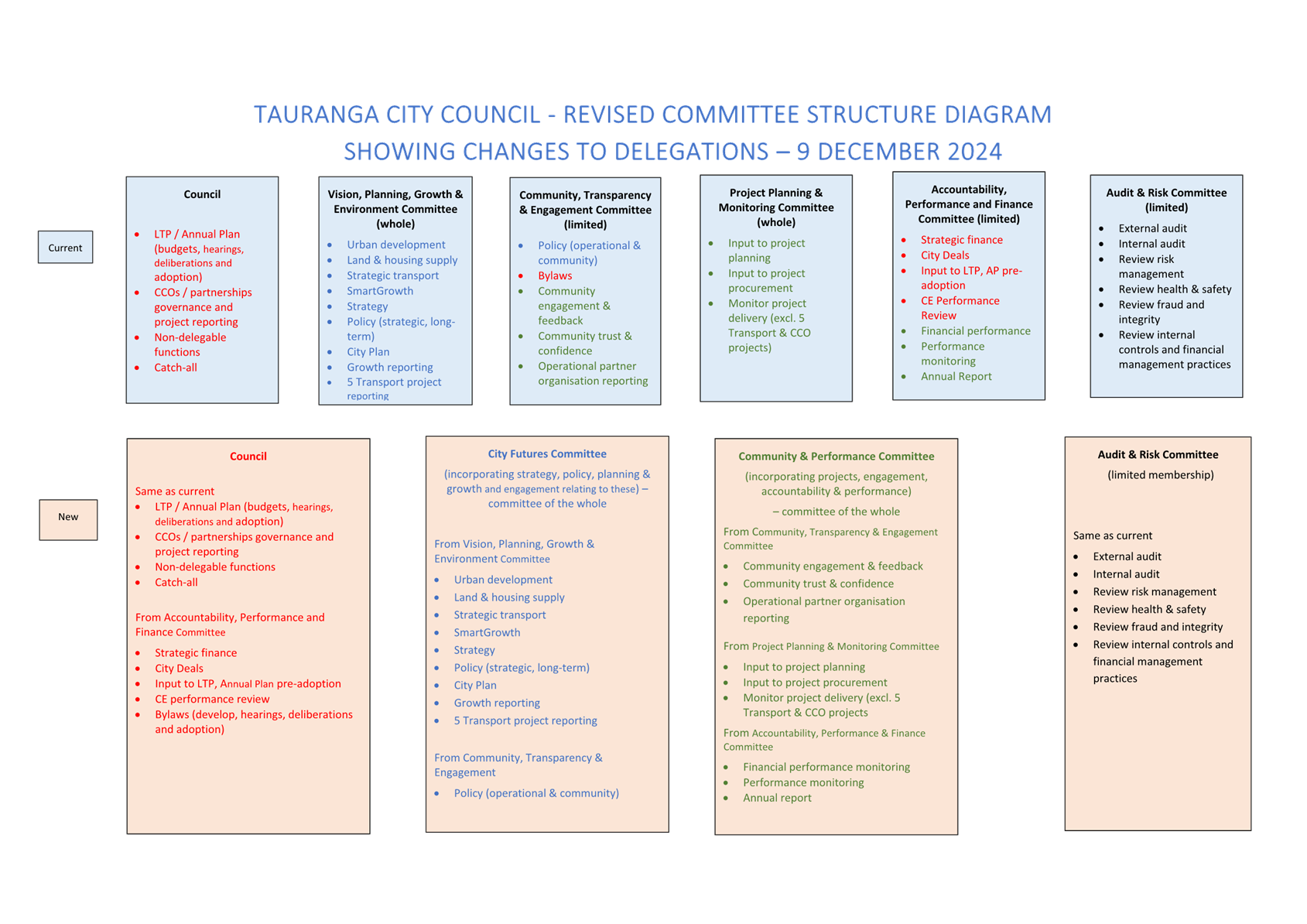
|
Ordinary
Council meeting Agenda
|
9
December 2024
|
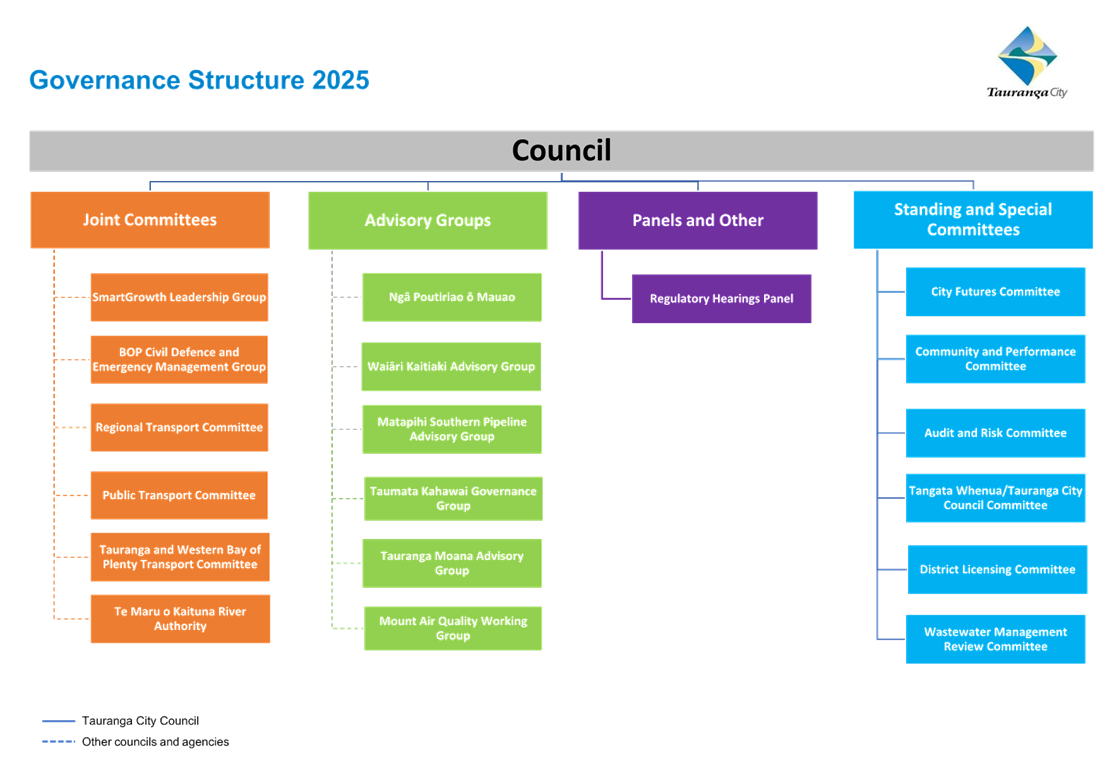
|
Ordinary
Council meeting Agenda
|
9
December 2024
|
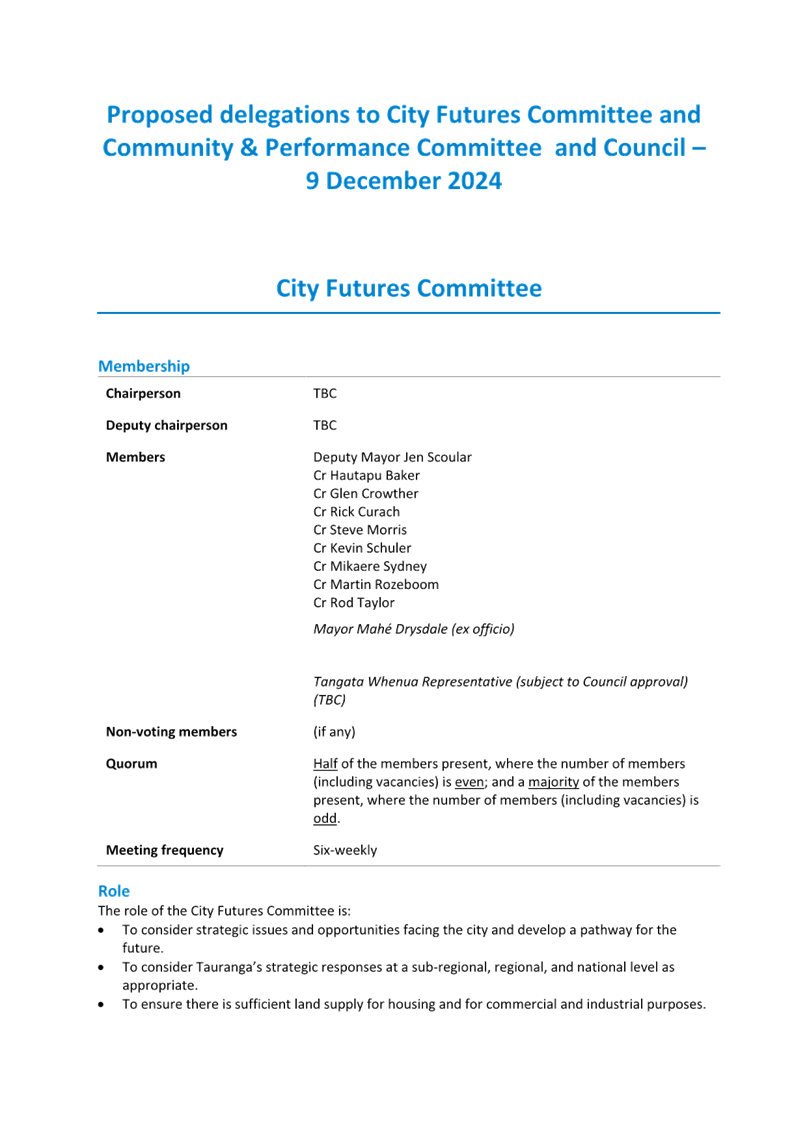
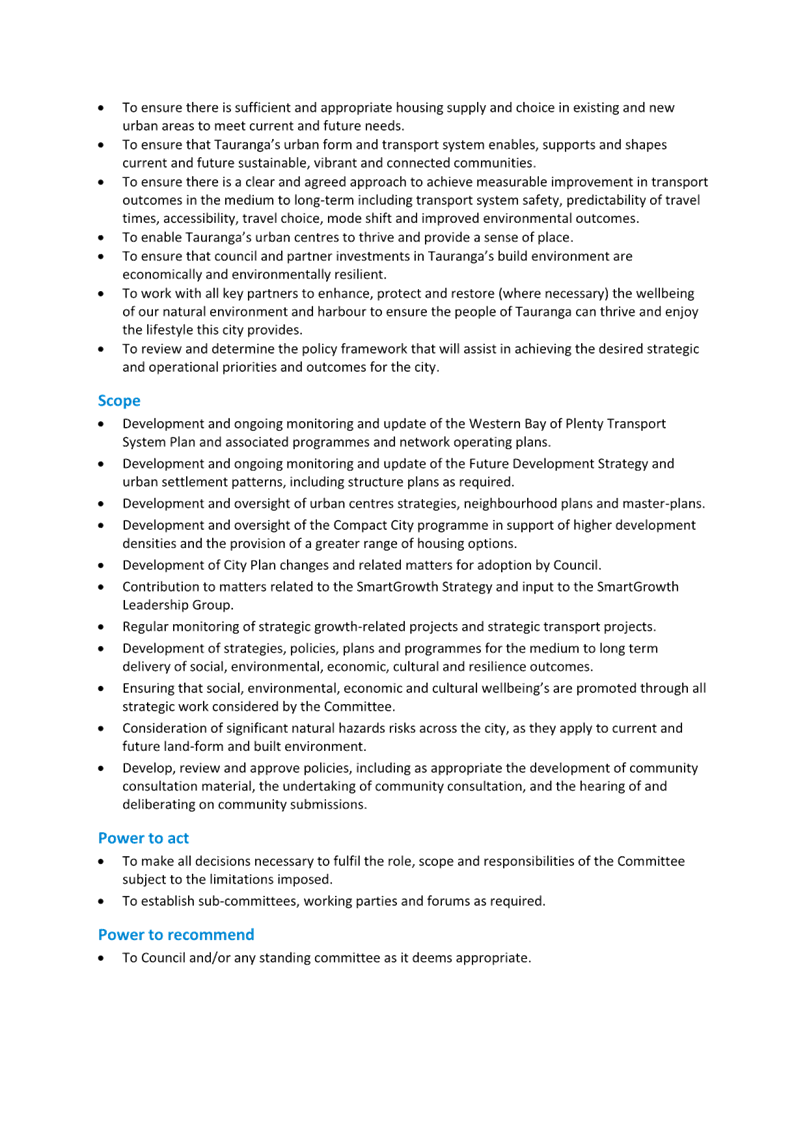
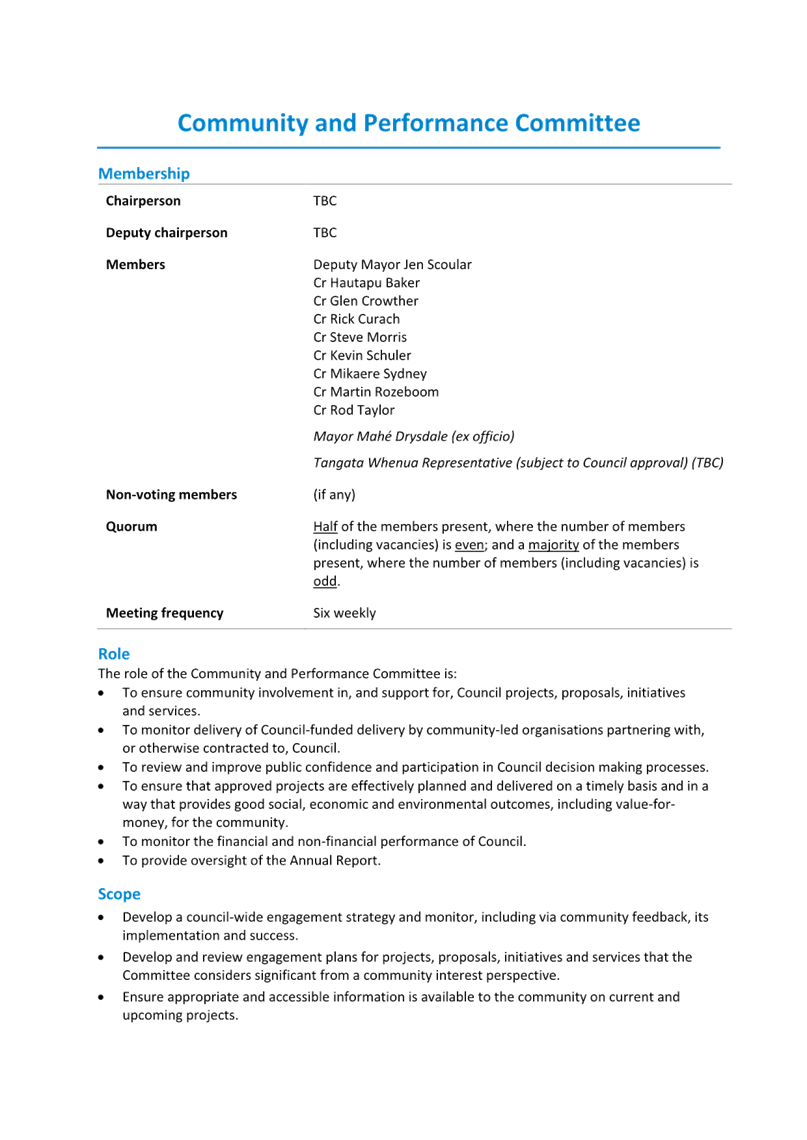
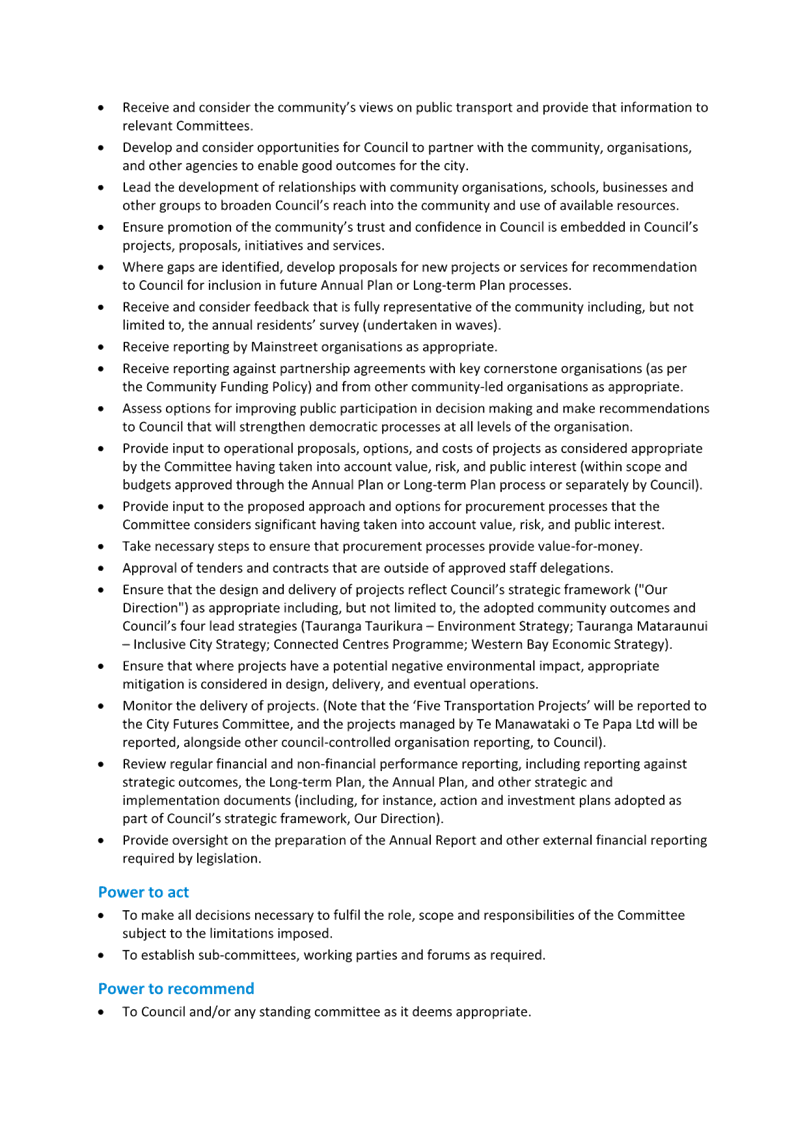
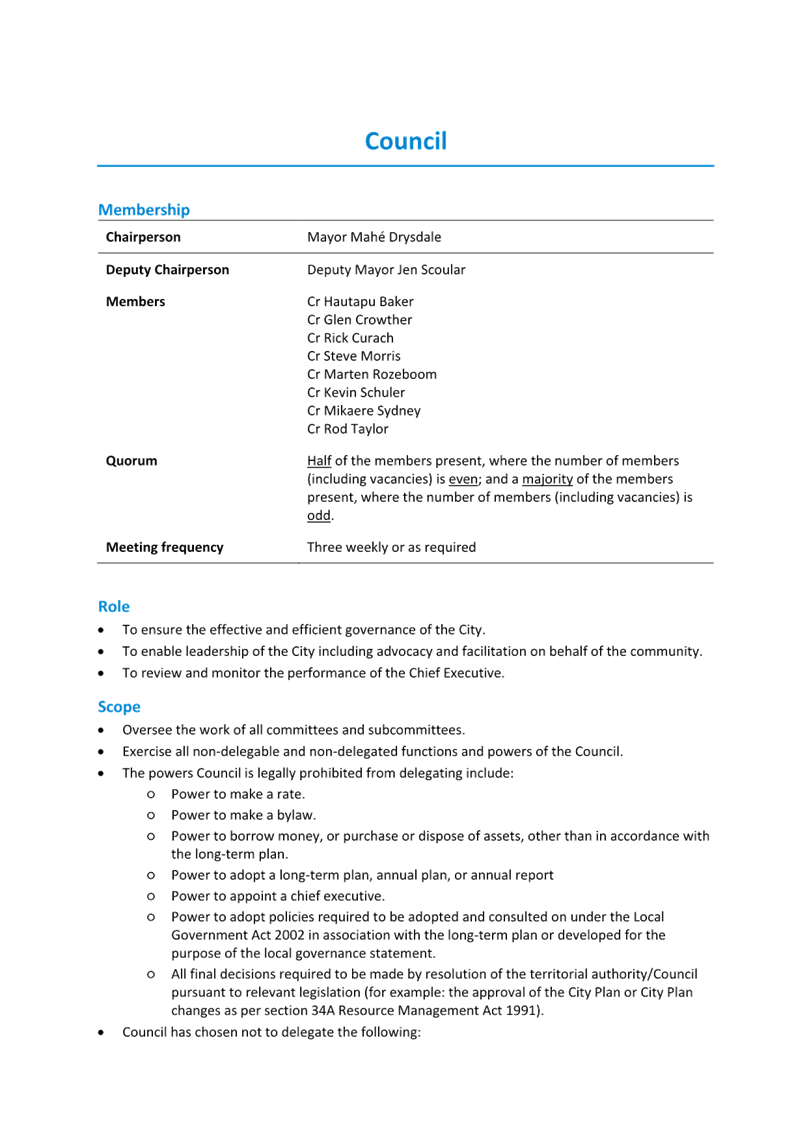
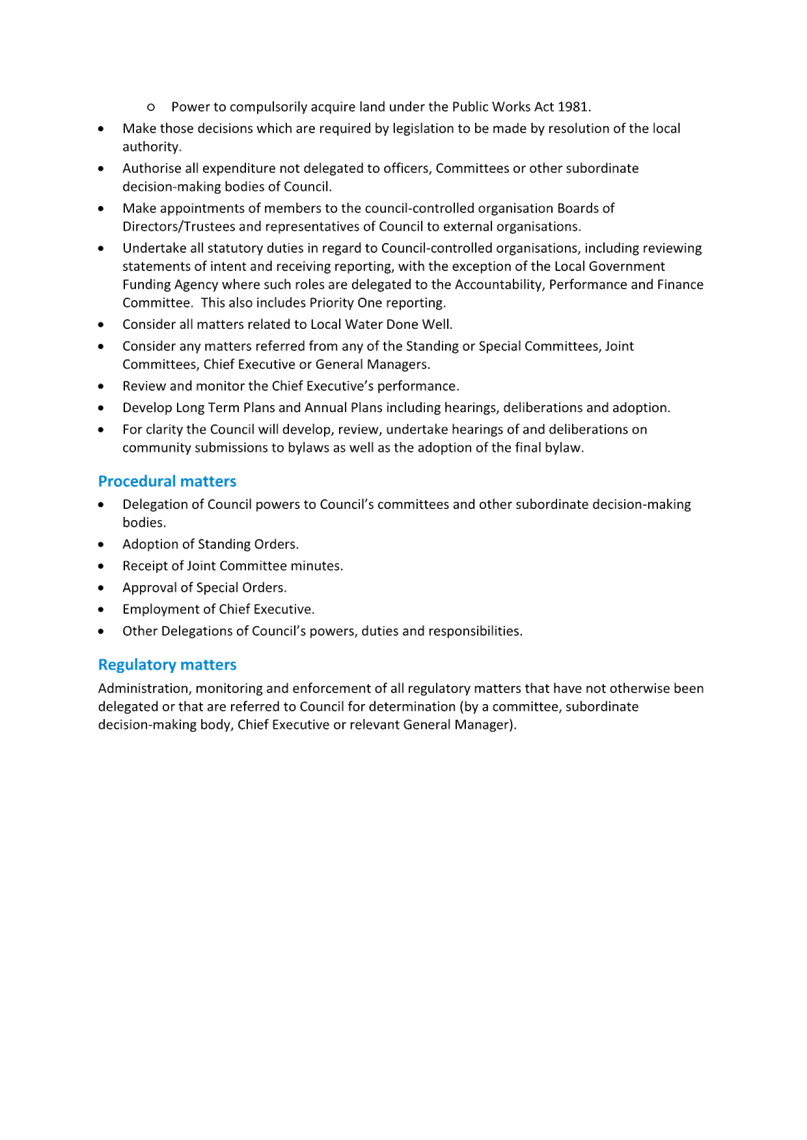
|
Ordinary
Council meeting Agenda
|
9
December 2024
|
11.11 Appointment of Tangata Whenua
Representatives to Standing Committees
File
Number: A17099776
Author: Coral
Hair, Manager: Democracy and Governance Services
Authoriser: Mahé
Drysdale, Mayor
Purpose of the Report
1. The report recommends the
appointment of Tangata Whenua representatives to three of the Council’s
Standing Committees with full voting rights.
|
Recommendations
That the Council:
(a) Receives the report
"Appointment of Tangata Whenua Representatives to Standing Committees".
(b) Approves the appointment of
one tangata whenua representative to each of the following Standing
Committees:
(i) Audit and Risk
Committee
(ii) City Futures Committee
(iii) Community and Performance
Committee
(c) Approves that the
appointees will be nominated and endorsed by Te Rangapū Mana Whenua o
Tauranga Moana based on the skill sets, attributes and knowledge appropriate
to each Standing Committee.
(d) Approves voting rights for
the tangata whenua representatives on each of the Standing Committees.
(e) Notes that the term of
appointment of tangata whenua representatives will be subject to any future
changes to the committee structure during the term of the Council.
(f) Notes that the Chief
Executive will report back to the Council on the remuneration for each of the
tangata whenua representatives on the standing committees informed by an
independent expert advisor.
|
Executive Summary
2. I received an email from
Matire Duncan, Chair of Te Rangapū Mana Whenua o Tauranga Moana (Te
Rangapū), on 1 October 2024 requesting that tangata whenua representation
be made on the newly established Council committees and that the positions are
remunerated accordingly and have full voting rights.
3. This followed the request made at the hui between
elected members and Te Rangapū on 25 September 2024, where Te Rangapū
presented the importance of the appointment of tangata
whenua representatives and the process to take into consideration the
specific skill sets, that would add value to each committee.
4. Te Rangapū Mana
Whenua o Tauranga Moana are clear about the distinction between tangata whenua
representation on committees and the elected representation via Te Awanui Māori
ward.
5. Te Rangapū have a longstanding and valued relationship
with Council and have been represented on previous elected council committees
and under Commissioners. After due consideration I now ask that the Council
support the appointment of tangata whenua representatives to the three standing
committees with appropriate remuneration and full voting rights.
Background
6. The 2019-2021 elected
Council adopted the same committee structure as the outgoing Council 2016-2019
and retained the provision for a non-voting tangata whenua representative on
each of its four main standing committees. Those initial appointments were
subsequently made in late 2019 and mid-2020 based on the recommendation of Te
Rangapū who recruited and interviewed skills-based applicants for each of
the standing committees.
7. In August 2020, the
Council amended its committees’ terms of reference to provide voting
rights to the tangata whenua representatives on each committee.
Previously these had been non-voting positions.
8. The 2021-2024 appointed
Commission disestablished the four main standing committees and, in April 2021,
established the Strategy, Finance and Risk Committee. This Committee
included as voting members the four commissioners, three tangata whenua members,
again appointed on the recommendation of Te Rangapū, and one other
external member. In addition, the chair of Te Rangapū was appointed
as a non-voting member. Those appointments were made in May 2021 and the
members continued until July 2024 when the Commission’s term ended.
9. Te Rangapū Mana
Whenua o Tauranga Moana have sought representation on Council Committees and
recommend the same recruitment process be undertaken as previous, which
includes:
- Identify the skill sets,
attributes and knowledge required for each standing committee.
- Invite applications through hapū and iwi representatives.
- Candidates submit their resumes.
- Interviews conducted by the
Chairperson and Vice-Chairperson of Te Rangapū Mana Whenua o Tauranga
Moana and the Manager: Strategic Māori Engagement.
- Chairpersons of each relevant
standing committee are consulted about the recommended candidates.
- Nominated candidates are endorsed
by Te Rangapū Mana Whenua o Tauranga Moana.
- Council endorses the
recommendations of Te Rangapū Mana Whenua o Tauranga Moana, and the
persons are appointed as tangata whenua representatives to each standing
committee.
rationale for tangata whenua
representatives
10. Te Rangapū Mana Whenua o
Tauranga Moana are clear about the distinction between tangata whenua
representation and the elected representation on council via the Māori ward Te
Awanui and I believe this distinction is critical.
11. A Māori ward provides one way
for Māori
to have a voice and be represented around the Council table and the councillor
may act independently of iwi and mana whenua and is obligated to represent the
interests of all Tauranga city residents, not only Māori residents. A Māori ward
councillor is not expected to speak on behalf of tangata whenua, they speak for
themselves when working with elected members.
12. Tangata whenua representatives have
a mandate from Te Rangapū to represent iwi and hapū
and can provide the unique perspective of mana whenua. Through the Local Government Act 2002 and the significance
and engagement policy, the Council often consults with, or requires input into
decisions from, mana whenua. Having a mana whenua voice at the table
during the decision-making process may result in better outcomes for Council and mana whenua.
Statutory Context
13. Clause
31(3) of Schedule 7 of the Local Government Act 2002 enables the Council to
appoint a person who is not an elected member to a committee, if the Council
believes the person has the skills, attributes or knowledge to assist the
committee.
14. Section
14 of the LGA 2002 requires a local authority, in performing its role, to act
in accordance with the principles specified. These principles include, in
subsection 14(1)(d), that a local authority should provide opportunities for Māori to contribute to its
decision-making processes.
15. Section
81(1)(a) and (b) of the LGA 2002 require that a local authority must (a)
establish and maintain processes to provide opportunities for Māori to
contribute to the decision-making processes of the local authority; and (b)
consider ways in which it may foster the development of Māori capacity to
contribute to the decision-making processes of the local authority.
STRATEGIC ALIGNMENT
16. This contributes to the promotion
or achievement of the following strategic community outcome(s):
|
Contributes
|
|
We are an inclusive city
|
ü
|
|
We value, protect and enhance the environment
|
☐
|
|
We are a well-planned city
|
☐
|
|
We can move around our city easily
|
☐
|
|
We are a city that supports business and education
|
☐
|
Options Analysis
17. Option 1: Accept the
recommendation of Te Rangapū Mana Whenua o Tauranga Moana and appoint
tangata whenua representatives to the respective standing committees.
|
Advantages
|
Disadvantages
|
|
· Reflects valued partnership approach between Tauranga
City Council and Te Rangapū Mana Whenua o Tauranga Moana.
· Ensures that mandated Māori voices, endorsed by Te Rangapū Mana Whenua o
Tauranga Moana, will continue to be heard at a committee of Council.
· Can attract high calibre representatives with specific
skill sets that add value to each committee.
· Enables a tangata whenua view in
decision making, aiding in mana whenua engagement and consultation.
|
· Councillors have not assessed each of the candidates.
· Non-elected members making decisions.
· Remuneration costs will increase.
|
18. Option 2: Do not appoint
tangata whenua representatives to the respective standing committees.
|
Advantages
|
Disadvantages
|
|
· Elected members only making decisions.
· Māori representation on committees via Te Awanui ward
councillor.
· Reduce remuneration costs for external appointees.
|
· Does not reflect the valued partnership approach between
Tauranga City Council and Te Rangapū Mana Whenua o Tauranga Moana.
· Mandated Māori voices distinct
from elected members are not heard at committees of council.
· Miss out on the value of high calibre representatives.
|
19. Option 3: Agree to appoint
tangata whenua representative to the respective standing committees but run a
Tauranga City Council led process.
|
Advantages
|
Disadvantages
|
|
· Assume full control of all aspects of appointment
process.
|
· Indicates to Te Rangapū Mana Whenua o Tauranga Moana
that their judgement and support is not trusted leading to strained
relationships.
· Process may not attract same calibre of candidates if
trust in relationship is undermined.
· Candidates may not be endorsed by Te Rangapū Mana
Whenua o Tauranga Moana.
|
Voting rights for tangata whenua
representatives
20. The Council previously provided for
external appointees to exercise voting rights on the standing committees, and I
recommend that voting rights continue to be provided.
21. The
previous elected Council, at its meeting on 25 August 2020, resolved to provide
voting rights for tangata whenua representatives. Providing this voting
right to the tangata whenua representatives would move their participation in
decision making from passive to active. Further, such voting rights would
reflect the respect and mana of partnership at the table as intended by Te
Tiriti o Waitangi and the Local Government Act 2002 and would ensure the
tangata whenua perspective on any topic is fully represented without undue
influence, misinterpretation or misunderstanding as it would be reflected
directly in the vote.
Financial Considerations
22. The remuneration of tangata whenua
representatives to standing committees will vary depending on the type of
committee. I have asked the Chief Executive to report back on the
appropriate remuneration and that this be informed by an independent expert
advisor.
23. Depending on the remuneration
approved there should be sufficient budget in the current financial year to
cover these costs and this will be reviewed for the annual plan budget for
2025/26.
Legal Implications / Risks
24. The Council can appoint non-elected
members to a committee. There is a risk to the valued partnership between
TCC and Te Rangapū Mana Whenua o Tauranga Moana if the request to appoint
tangata whenua representatives is refused.
TE AO MĀORI APPROACH
25. The appointment of tangata whenua
representatives to standing committees is aligned with the goals in
Council’s Te Ao Māori approach, particular Whaia te Tika, doing the right thing for our community and
each other, Whanaungatanga, of working together in partnership, relationships
and network support systems, Manaakitanga in listening to show we care and
promoting and enabling fuller participation for Māori to contribute to decision-making processes.
CLIMATE IMPACT
26. This decision does not have a
climate impact.
Consultation / Engagement
27. No community engagement is
required.
Significance
28. The Local Government Act 2002 requires
an assessment of the significance of matters, issues, proposals and decisions
in this report against Council’s Significance and Engagement
Policy. Council acknowledges that in some instances a matter, issue,
proposal or decision may have a high degree of importance to individuals,
groups, or agencies affected by the report.
29. In making this assessment,
consideration has been given to the likely impact, and likely consequences for:
(a) the current
and future social, economic, environmental, or cultural well-being of the
district or region
(b) any persons who are likely to be
particularly affected by, or interested in, the decision.
(c) the capacity of the local authority
to perform its role, and the financial and other costs of doing so.
30. In accordance with the
considerations above, criteria and thresholds in the policy, it is considered
that the decision is of low significance.
ENGAGEMENT
31. Taking into consideration the above
assessment, that the decision is of low significance, officers are of the
opinion that no further engagement is required prior to Council making a
decision.
Next Steps
32. Te Rangapū Mana Whenua o
Tauranga Moana to undertake recruitment process and provide a recommendation to
Council in early 2025 for tangata representatives to three standing committees.
Attachments
Nil
|
Ordinary
Council meeting Agenda
|
9
December 2024
|
11.12 Meetings Schedule 2025
File
Number: A17031328
Author: Coral
Hair, Manager: Democracy and Governance Services
Authoriser: Christine
Jones, General Manager: Strategy, Growth & Governance
Purpose of the Report
1. This report confirms the
Council and committee meeting dates for 2025. This provides certainty for the
elected members, external appointees and staff and transparency to the public
and media on when meetings will be held and gives effect to the governance
structure.
|
Recommendations
That the Council:
(a) Receives the report
"Meetings Schedule 2025".
(b) Adopts the meetings
schedule for the period January-December 2025 as set out in Attachment 1.
|
Executive Summary
2. The
Council can adopt a schedule of meetings that covers any future period. It is
recommended that the Council adopts a meeting schedule for the period
January-December 2025. This will provide certainty to elected members,
external appointees and staff and transparency to the public and media on when
meetings will be held. The meetings schedule gives effect to the
governance structure.
Background
3. Attachment
1 sets out the meetings schedule for January-December 2025 based on the
governance structure revised in the separate report to council on this agenda
and is based on three weekly council meetings and six to twelve weekly
committee meetings depending on the terms of reference for those committees.
4. Dates for joint committee meetings are co-ordinated with the Bay of
Plenty Regional Council, the Western Bay of Plenty District Council, and other
councils in the Bay of Plenty. Due to local government elections in October
2025, there are no joint committee meetings scheduled from September 2025.
5. The
Local Government New Zealand Conference, Zone 2 and Metro meeting dates are
included in the schedule.
Statutory Context
6. Clause
19(6) of Schedule 7 of the Local Government Act 2002 provides for the Council
to adopt a meeting schedule to cover any future period.
STRATEGIC ALIGNMENT
7. This contributes to the
promotion or achievement of the following strategic community outcome(s):
|
Contributes
|
|
We are an inclusive city
|
ü
|
|
We value, protect and enhance the environment
|
☐
|
|
We are a well-planned city
|
☐
|
|
We can move around our city easily
|
☐
|
|
We are a city that supports business and education
|
☐
|
Options Analysis
Option 1 – Adopt the meetings
schedule for January-December 2025 (preferred option)
8. The Council has the option of
adopting a meetings schedule for the period January-December 2025.
9. This option enables the elected
members, external appointees, staff, media and the public to know when meetings
are scheduled which provides for openness and transparency.
Option
2 – Adopt a meetings schedule for a different time period
10. The Council has the option of adopting a
meetings schedule for a different time period; for example, until September
2025 when joint meetings stop during the local government election period.
11. This option would still provide for certainty.
However, Tauranga City Council can continue with its meetings during the local
election period. Joint meetings after October 2025 elections have not
been set and will be included after co-ordination with the other councils
involved. For this reason, this option is not preferred.
Financial Considerations
12. There are no financial
considerations to adopting a meetings schedule.
Legal Implications / Risks
13. The legislation
provides for the adoption of a schedule of meetings.
Significance
14. The Local Government Act 2002
requires an assessment of the significance of matters, issues, proposals and
decisions in this report against Council’s Significance and Engagement
Policy. Council acknowledges that in some instances a matter, issue,
proposal or decision may have a high degree of importance to individuals,
groups, or agencies affected by the report.
15. In making this assessment,
consideration has been given to the likely impact, and likely consequences for:
(a) the current
and future social, economic, environmental, or cultural well-being of the
district or region
(b) any persons who are likely to be
particularly affected by, or interested in, the decision.
(c) the capacity of the local authority
to perform its role, and the financial and other costs of doing so.
16. In accordance with the
considerations above, criteria and thresholds in the policy, it is considered
that the decision is of low significance.
ENGAGEMENT
17. Taking into consideration the above
assessment, that the decision is of low significance, officers are of the
opinion that no further engagement is required prior to Council making a decision.
Next Steps
18. Meetings schedule will be available
on the Council’s website.
19. Calendar requests will be sent out
to elected members, any external appointees and relevant staff.
Attachments
1. Draft
2025 Meetings Schedule - A17232082 ⇩ 
|
Ordinary
Council meeting Agenda
|
9
December 2024
|
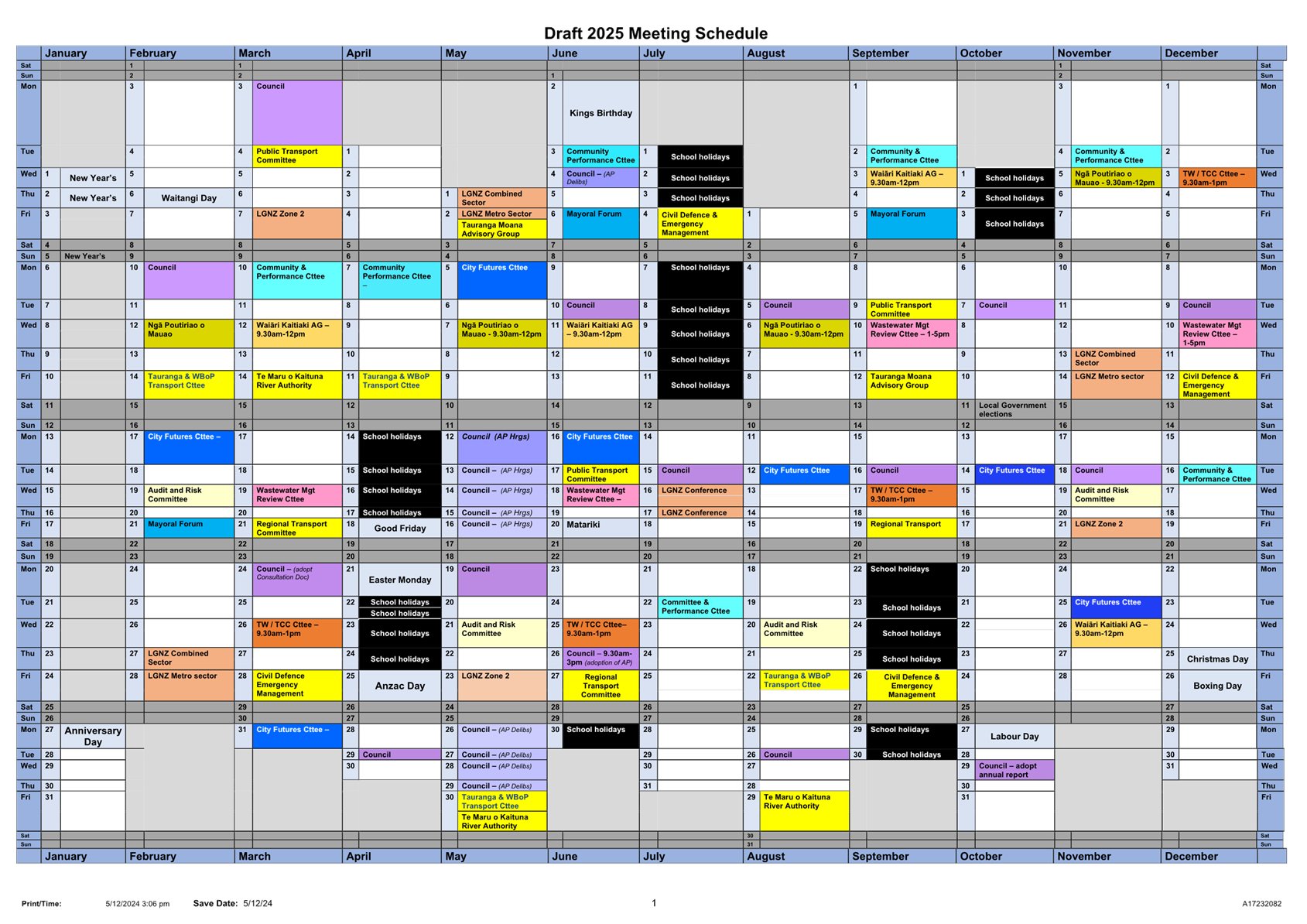
|
Ordinary
Council meeting Agenda
|
9
December 2024
|
11.13 Mayoral vehicle
File
Number: A17238727
Author: Coral
Hair, Manager: Democracy and Governance Services
Authoriser: Christine
Jones, General Manager: Strategy, Growth & Governance
Purpose of the Report
1. This report sets out
information on providing a mayoral vehicle.
|
Recommendations
That the Council:
(a) Receives the report
"Mayoral vehicle".
(b) Agrees to provide the Mayor
with a vehicle of his choice for restricted private use, up to the maximum
vehicle amount provided for by the Remuneration Authority in the Local
Government Members (2024/25) Determination.
|
Executive Summary
2. The Remuneration
Authority (the Authority) allows for councils to provide a vehicle for the
Mayor. The Authority sets the maximum purchase price that councils can purchase
vehicles based on whether the vehicle is petrol or diesel ($55,000 including
GST and on-road costs) or electric/hybrid ($68,500 including GST and on-road
costs).
3. The Mayor has indicated
he would prefer an electric car for restricted private use.
4. It is recommended that
the Council agrees to provide the Mayor with a vehicle and allow him to
exercise his choice about the type of vehicle within the limits set out by the
Authority in the Local Government Members (2024/25) Determination.
Statutory Context
5. Section 9 of the Local
Government Members (2024/25) Determination 2024 states that councils may
provide a vehicle for the Mayor and sets out the parameters. The Remuneration
Authority, through the Determination, sets the maximum purchase price that
councils can pay for a mayoral vehicle based on whether the vehicle is petrol
or diesel ($55,000 including GST and on-road costs) or electric/hybrid ($68,500
including GST and on-road costs).
6. The Authority also sets
out a formula to be applied when calculating the reduction from the
Mayor’s remuneration to reflect either full or restricted private usage
of a council provided car. There is no deduction provided for from the
Mayor’s remuneration for restricted private use under Clause 3, Section 9
of the Local Government Members (2024/25) Determination. The Authority has
advised that the Mayor is able to use a mayoral vehicle for travel to and from
his home to the council, and return, under any of the three types of private
use.
7. Definitions of full
private use, partial private use and restricted private use are set out in
Clause 7, Section 9 of the Local Government Members (2024/25) Determination:
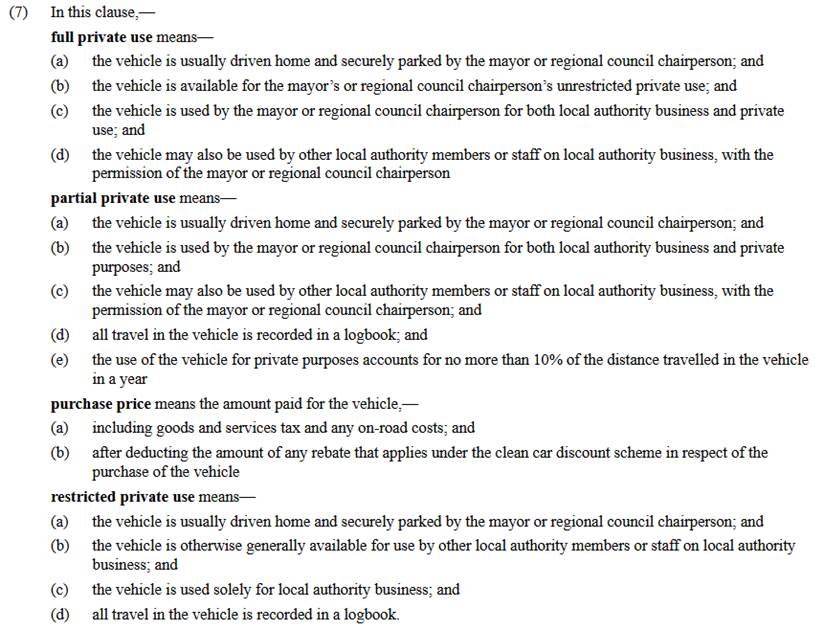
Options Analysis
8. The Council has the
option of providing the Mayor with a mayoral vehicle or declining to provide
the Mayor with a mayoral vehicle.
9. If the Council declines
to provide a mayoral vehicle, the Mayor has the options of using his own
vehicle and claiming mileage as set out in the Elected
Members’ Expenses and Resources Policy 2024 or, where convenient,
using a pool vehicle.
10. The Council needs to consider
factors including cost, convenience and support for the Mayoral function.
Section 41A of the Local Government Act 2002 states that the role of a Mayor is
to provide leadership to other members of the Council and to people in the
Tauranga City. The Mayor also has a ceremonial role and represents the Council
at meetings and occasions outside of Tauranga City on a regular basis.
Financial Considerations
11. There is budget available within
current 2024/25 year to fund the cost of an electric/hybrid vehicle up to
$68,500 including GST ($59,565.22 excluding GST).
12. The budget currently includes costs
for pool vehicles by elected members and mileage allowances. This budget would
cover the cost of operating a mayoral vehicle. The Council can sell the vehicle
after four years or trade it in for another mayoral vehicle following the 2028
election.
Legal Implications / Risks
13. There are no legal implications or
risks from providing a mayoral vehicle.
CLIMATE IMPACT
14. The Mayor has indicated a
preference for a fully electric vehicle and this will reduce emissions
associated with the Mayor’s travel.
Significance
15. The Local Government Act 2002
requires an assessment of the significance of matters, issues, proposals and
decisions in this report against Council’s Significance and Engagement
Policy. Council acknowledges that in some instances a matter, issue,
proposal or decision may have a high degree of importance to individuals,
groups, or agencies affected by the report.
16. In making this assessment,
consideration has been given to the likely impact, and likely consequences for:
(a) the current
and future social, economic, environmental, or cultural well-being of the
district or region
(b) any persons who are likely to be
particularly affected by, or interested in, the decision.
(c) the capacity of the local authority
to perform its role, and the financial and other costs of doing so.
17. In accordance with the
considerations above, criteria and thresholds in the policy, it is considered
that the decision is of low significance.
ENGAGEMENT
18. Taking into consideration the above
assessment, that the decision is of low significance, officers are of the
opinion that no further engagement is required prior to Council making a
decision.
Next Steps
19. If approved, purchase a vehicle of
the Mayor’s choice.
Attachments
Nil
|
Ordinary
Council meeting Agenda
|
9
December 2024
|
11.14 Submission to Local Electoral Reform
Issues Paper
File
Number: A17037950
Author: Coral
Hair, Manager: Democracy and Governance Services
Authoriser: Christine
Jones, General Manager: Strategy, Growth & Governance
Purpose of the Report
1. The purpose of the report
is to seek direction for a submission to the Local Electoral Reform Issues
Paper that will enable the views of the Council to be considered by Local
Government New Zealand’s (LGNZ) Local Electoral Reform Group.
|
Recommendations
That the Council:
(a) Receives the report
"Submission to Local Electoral Reform Issues Paper ".
(b) Provides direction to the
Local Government New Zealand’s Local Electoral Reform Group on Local
Electoral Reform Issues Paper for the following Issues and Questions:
(i) Issue 1 - The public’s understanding of
local government and why it’s important
Question 1: What
should be done to improve understanding of local government and its value,
and who should hold responsibility for this?
Question 2: What
should be done, given the decline in local media, to increase visibility of
local government work and local elections?
(ii) Issue 2 - Understanding candidates and their
policies
Question 3: How
should voters receive better information on candidates and their policy
positions and whose role should it be?
Question 4: Is
it important to improve candidate knowledge of local government, and if so,
how should this be done?
(iii) Issue 3. Voting
methods
Question 5: Given
the challenges outlines, what should be the future voting method (or methods)
of voting in local elections, and why?
Question 6: Should
the voting method (or methods) be nationally consistent or decided locally,
and why?
Question 7: What
short-term improvements should be made to the postal voting system, until a
permanent solution can be implemented?
(iv) Issue 4. Administration and promotion of
elections
Question 8: Who
should administer local elections, and why?
Question 9: Who
should be responsible for promoting local elections, and why?
(v) Issue 5. Four-year terms (including
transition and implementation)
Question
10: Which of the three timing options,
for a four-year term, do you prefer?
Question
11: How should councils’ budget and
planning cycles be adjusted to a four-year term?
Question
12: Do four-year terms for local councils
require increased accountability mechanisms, and if so, which do you
support?
(vi) Question 13: Do you have any other ideas or options
to improve participation in local elections?
(c) Delegates to the Mayor the
authority to approve the submission on behalf of the Council based on the
direction provided at today’s meeting in time to be lodged by 19
January 2025.
|
Executive Summary
2. Local Government New
Zealand (LGNZ) recently released a Local electoral reform – Issues
paper. Refer to attachment 1. Submissions close on 19 January 2025.
3. This is an opportunity
for the Council to provide feedback on this paper and the issues it
raises. This is one of the ways that the Council can look to influence
electoral reform.
Background
4. In
June 2024 LGNZ established an Electoral Reform Group,
chaired by Nelson Mayor Nick Smith, that will explore four key areas of reform
including:
· Increasing voter turnout.
· Implementation and transition to four-year terms.
· Considering the ways people can vote.
· Who should administer local elections, and how they are best run.
5. The Electoral Reform
Group are seeking feedback from councils on the following issues and questions:
(i) Issue 1 - The public’s understanding of local
government and why it’s important
Question 1: What
should be done to improve understanding of local government and its value, and
who should hold responsibility for this?
Question 2: What
should be done, given the decline in local media, to increase visibility of
local government work and local elections?
(ii) Issue 2 - Understanding candidates and their
policies
Question 3: How
should voters receive better information on candidates and their policy
positions and whose role should it be?
Question 4: Is
it important to improve candidate knowledge of local government, and if so, how
should this be done?
(iii) Issue 3 - Voting methods
Question 5: Given
the challenges outlines, what should be the future voting method (or methods)
of voting in local elections, and why?
Question 6: Should
the voting method (or methods) be nationally consistent or decided locally, and
why?
Question 7: What
short-term improvements should be made to the postal voting system, until a
permanent solution can be implemented?
(iv) Issue 4 - Administration and promotion of elections
Question 8: Who
should administer local elections, and why?
Question 9: Who
should be responsible for promoting local elections, and why?
(v) Issue 5 - Four-year terms (including transition and
implementation)
Question
10: Which of the three timing options, for
a four-year term, do you prefer?
Question
11: How should councils’ budget and
planning cycles be adjusted to a four-year term?
Question
12: Do four-year terms for local councils
require increased accountability mechanisms, and if so, which do you
support?
(vi) Question 13: Do you have any other ideas or options to
improve participation in local elections?
6. Feedback from the
elected members will be collated into a submission. Given there is no
further council meetings between now and 19 January 2025, when the submission
is due, it is recommended that the Mayor be delegated the authority to approve
the submission on behalf of the Council.
Statutory Context
7. There is no statutory
requirement to make a submission to LGNZ.
STRATEGIC ALIGNMENT
8. This contributes to the
promotion or achievement of the following strategic community outcome(s):
|
Contributes
|
|
We are an inclusive city
|
ü
|
|
We value, protect and enhance the environment
|
☐
|
|
We are a well-planned city
|
☐
|
|
We can move around our city easily
|
☐
|
|
We are a city that supports business and education
|
☐
|
Options Analysis
9. The Council has the
option to make a submission or not. It is recommended that the Council
does provide feedback on this paper and the issues it raises. This is one
of the ways that the Council can look to influence electoral reform.
Financial Considerations
10. There are no financial implications
from making a submission to LGNZ.
Legal Implications / Risks
11. There are no legal implications or
risks from making a submission to LGNZ.
TE AO MĀORI APPROACH
12. Any potential electoral reform
which may eventuate from a submission to LGNZ that increases voter turnout and
makes voting easier will benefit Māori enrolled on the general or Māori roll.
CLIMATE IMPACT
13. There are no climate impacts from
making a submission to LGNZ.
Significance
14. The Local Government Act 2002
requires an assessment of the significance of matters, issues, proposals and
decisions in this report against Council’s Significance and Engagement
Policy. Council acknowledges that in some instances a matter, issue,
proposal or decision may have a high degree of importance to individuals,
groups, or agencies affected by the report.
15. In making this assessment,
consideration has been given to the likely impact, and likely consequences for:
(a) the current
and future social, economic, environmental, or cultural well-being of the
district or region
(b) any persons who are likely to be
particularly affected by, or interested in, the matter.
(c) the capacity of the local authority
to perform its role, and the financial and other costs of doing so.
16. In accordance with the
considerations above, criteria and thresholds in the policy, it is considered
that the matter is of low significance.
ENGAGEMENT
17. Taking into consideration the above
assessment, that the matter is of low significance, officers are of the opinion
that no further engagement is required prior to Council making a decision.
Next Steps
18. Staff prepare a submission based on
the direction of the Council.
19. The Mayor authorises a submission
on behalf of the Council to be lodged by 19 January 2025.
Attachments
1. LGNZ
Local Electoral Reform Group - Issues Paper - A16932137 ⇩ 
|
Ordinary
Council meeting Agenda
|
9
December 2024
|
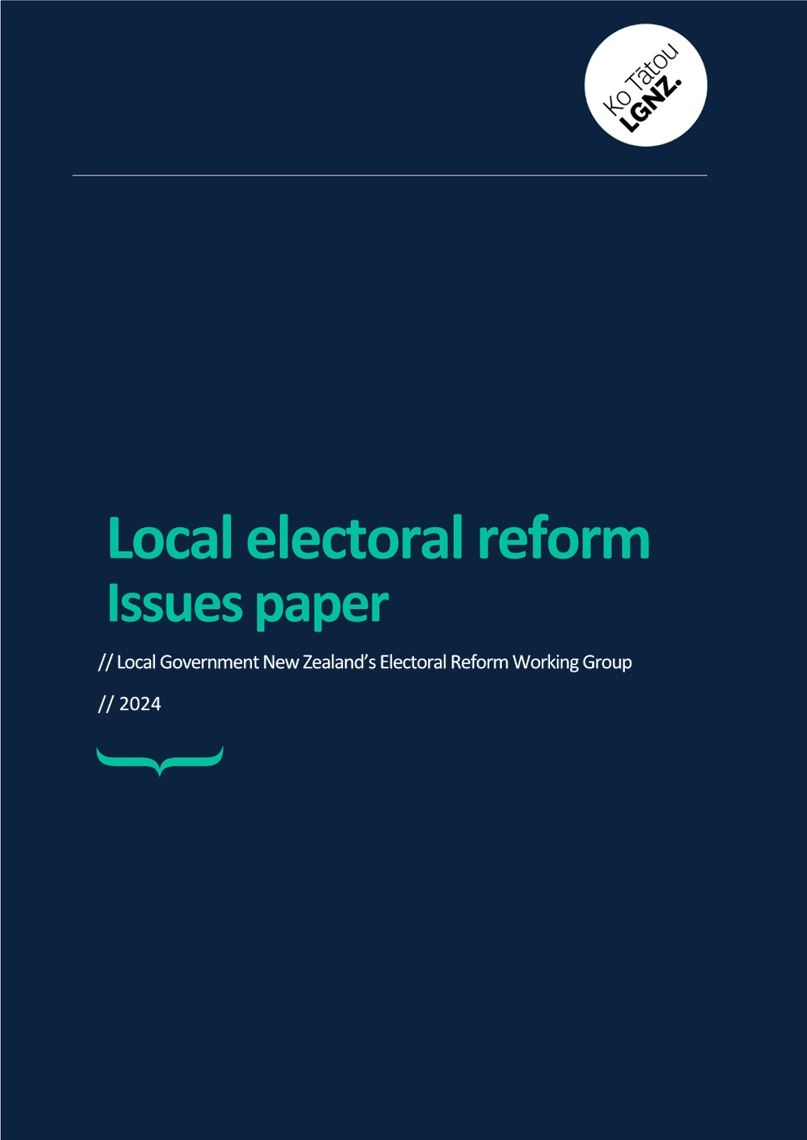
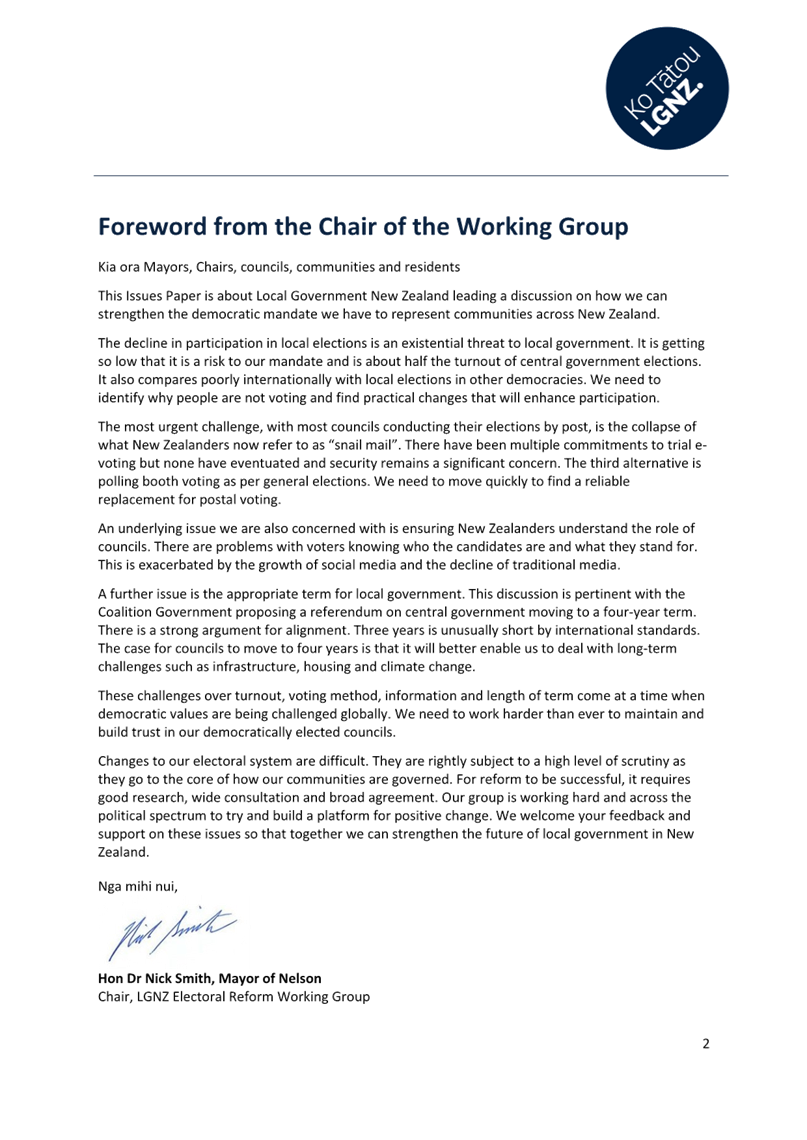
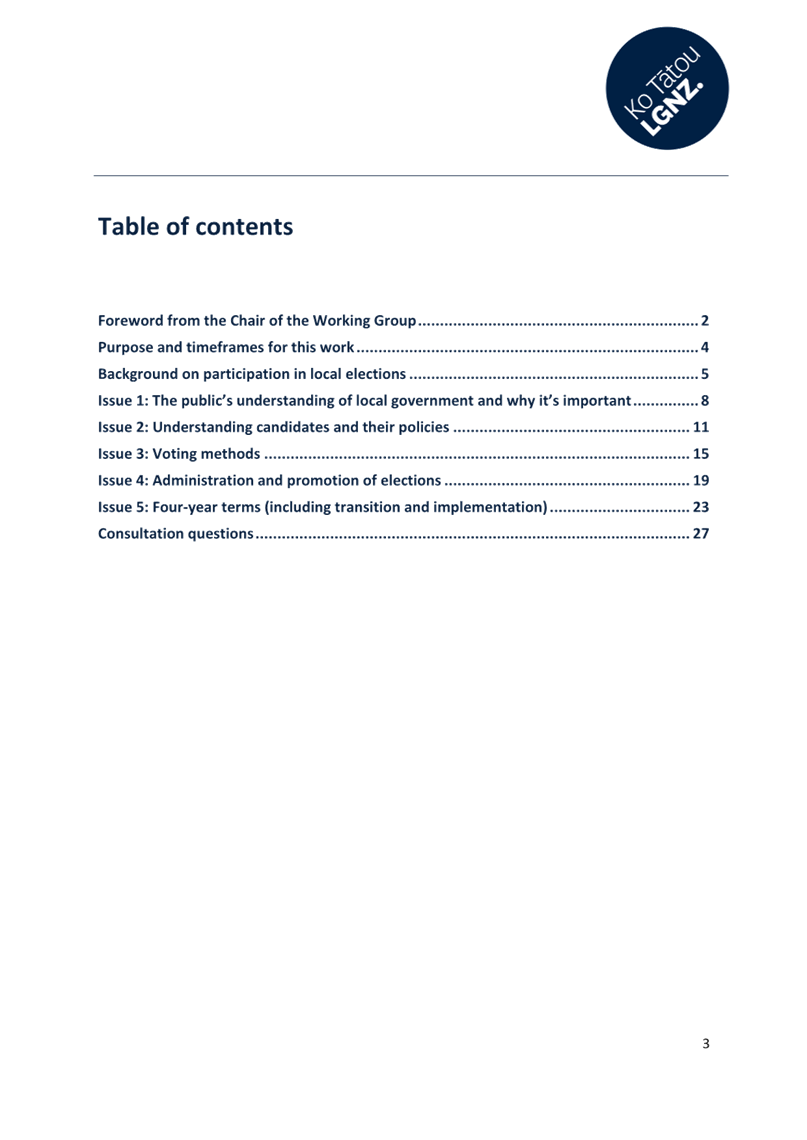
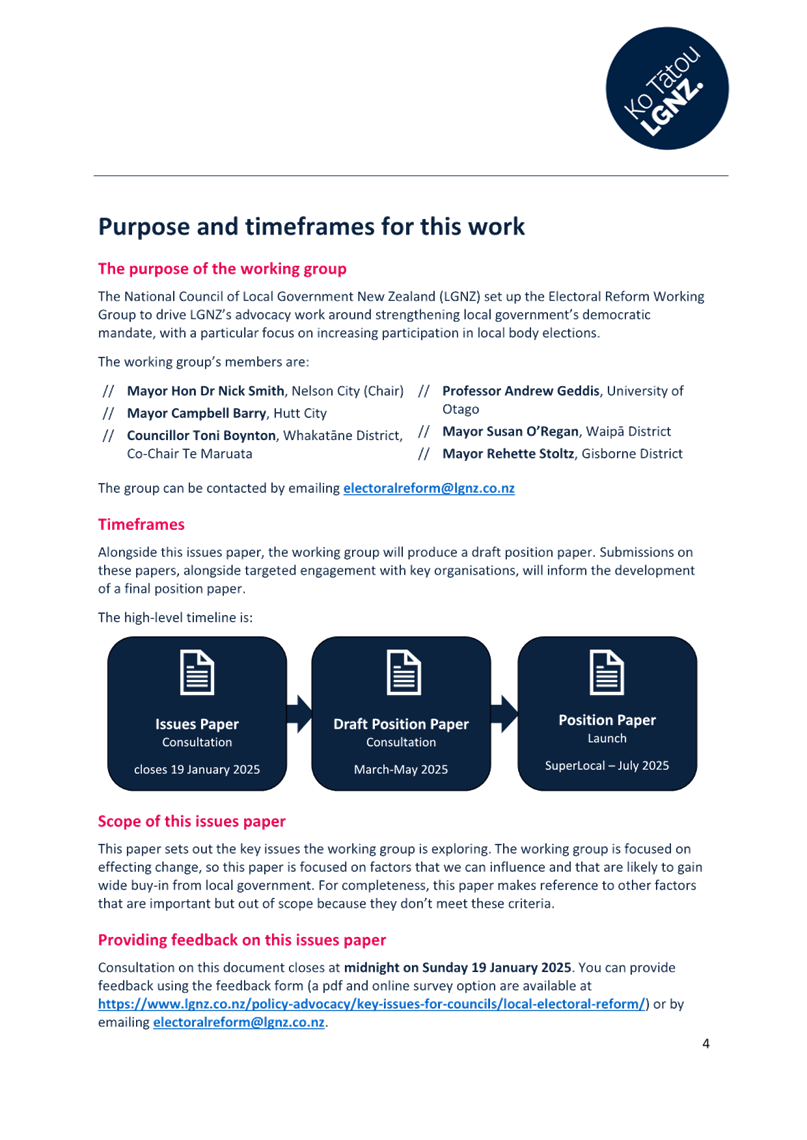
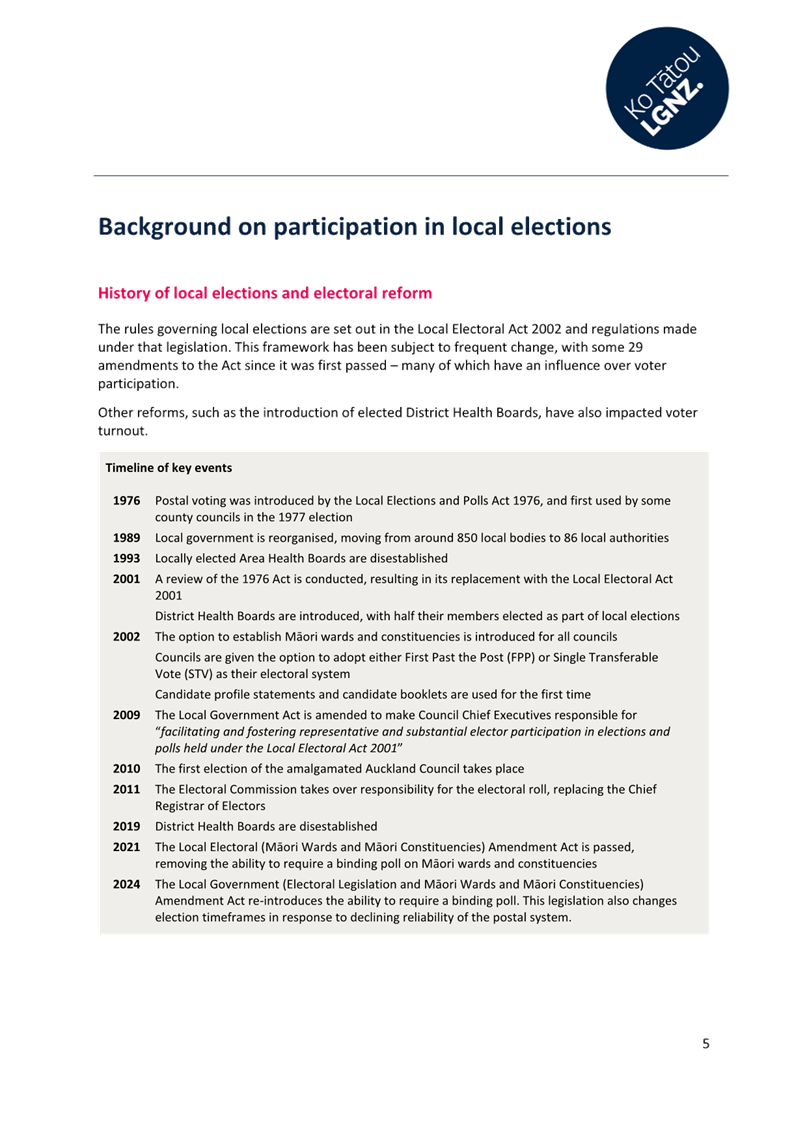
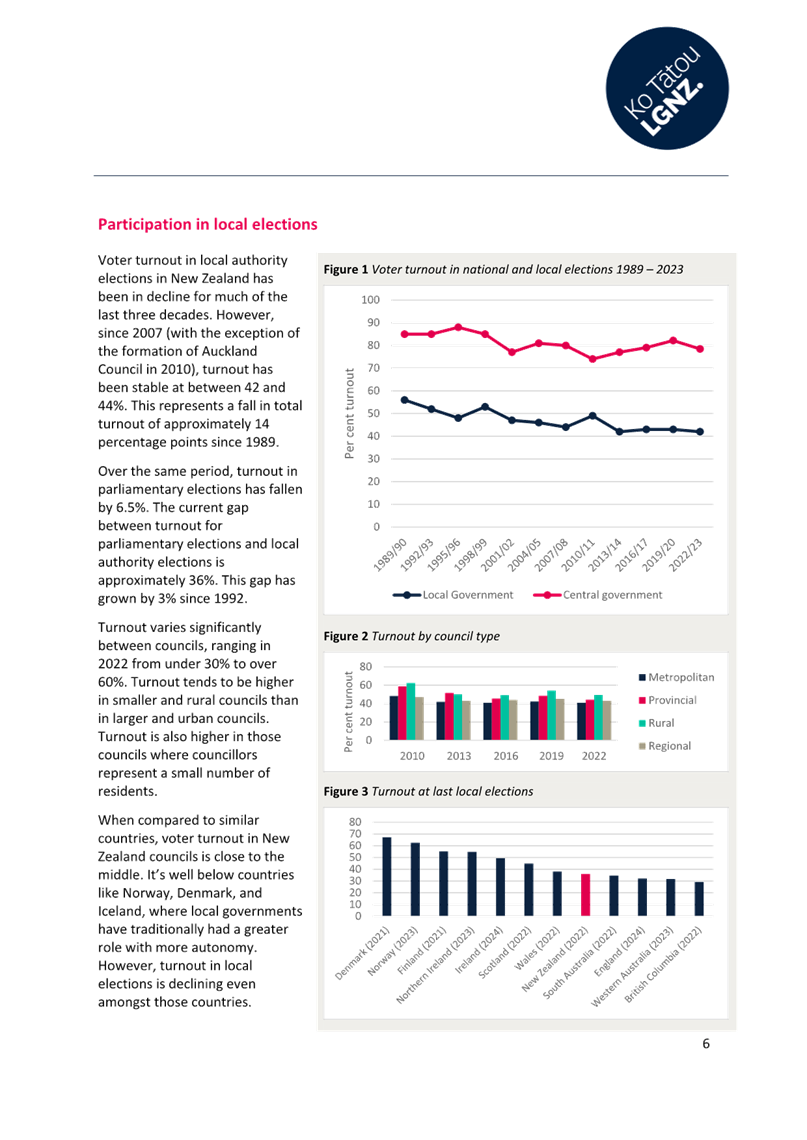
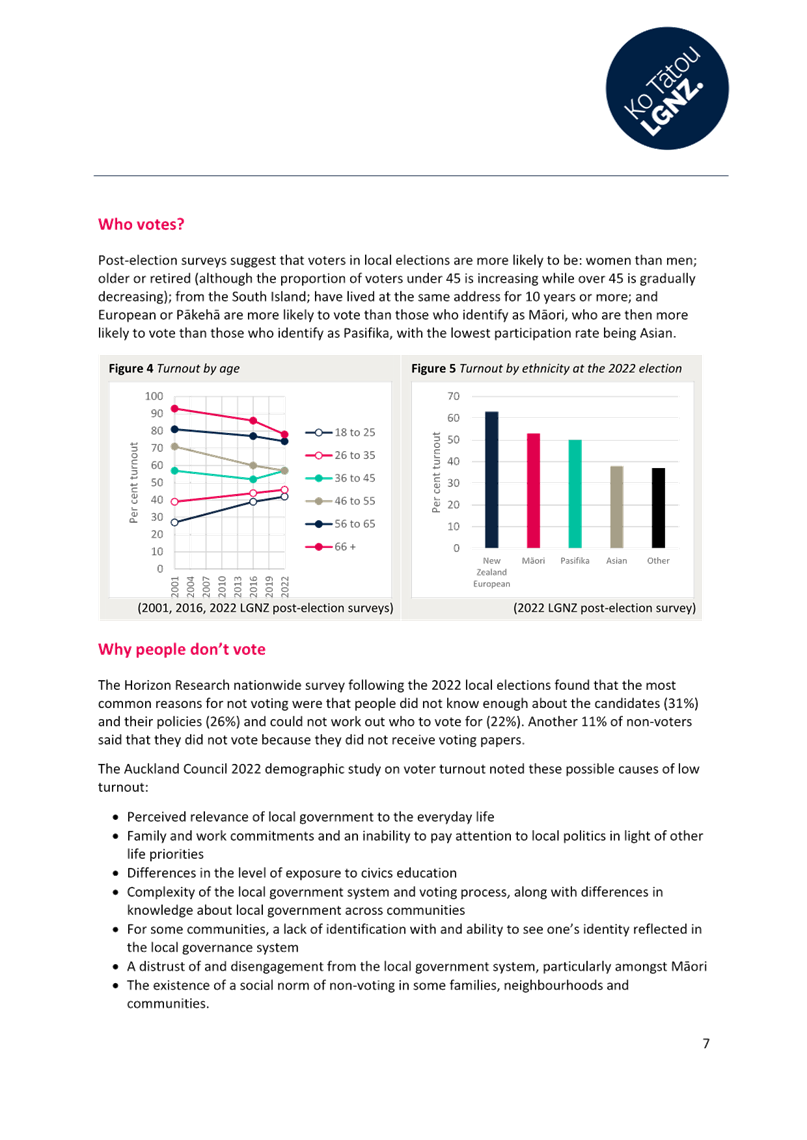
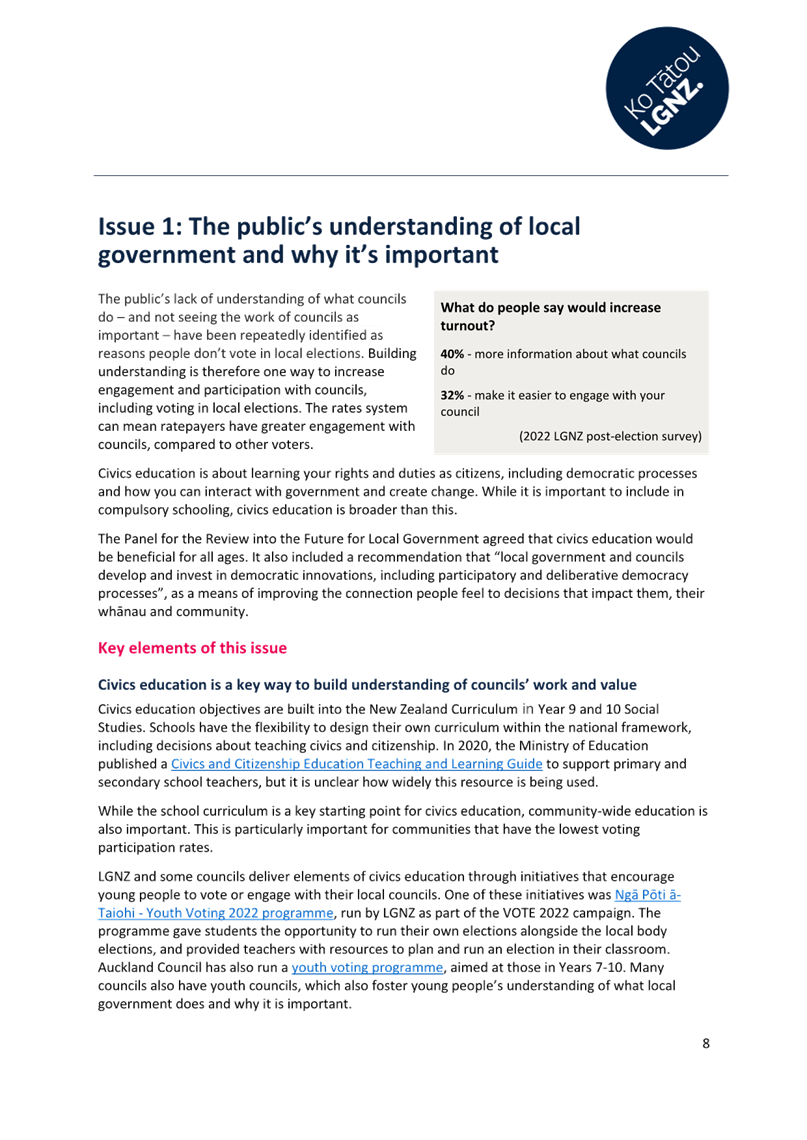
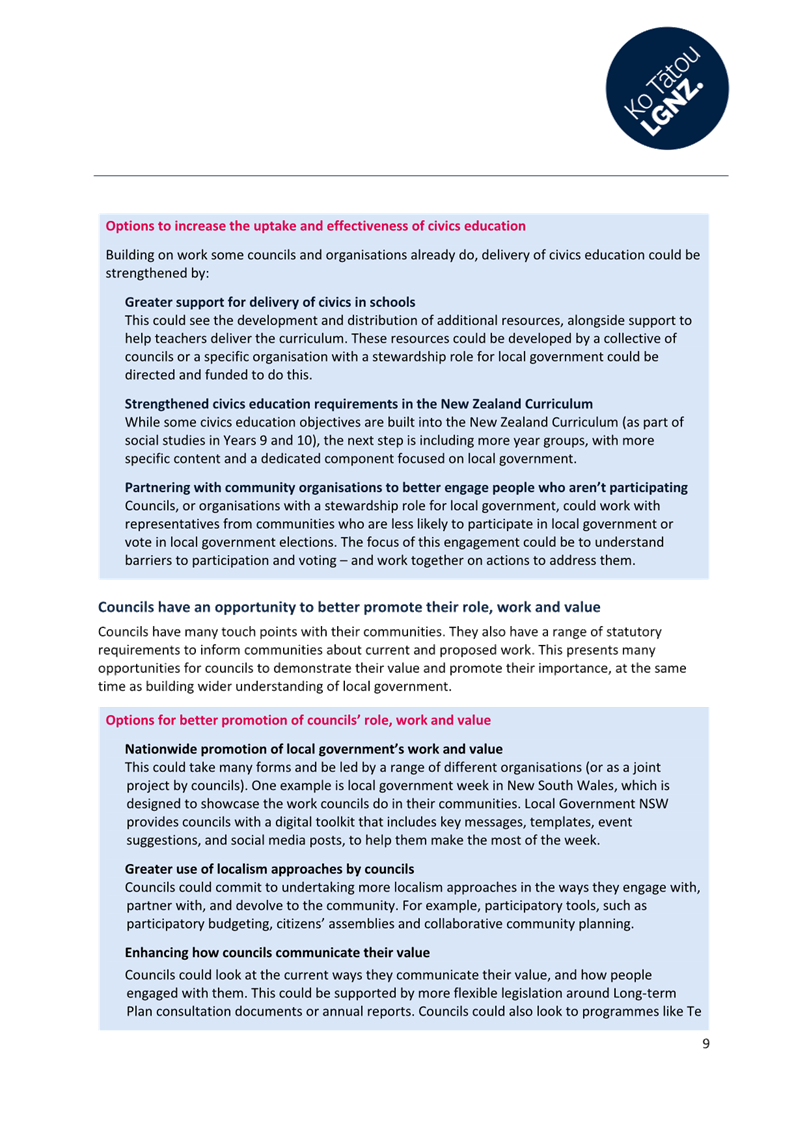
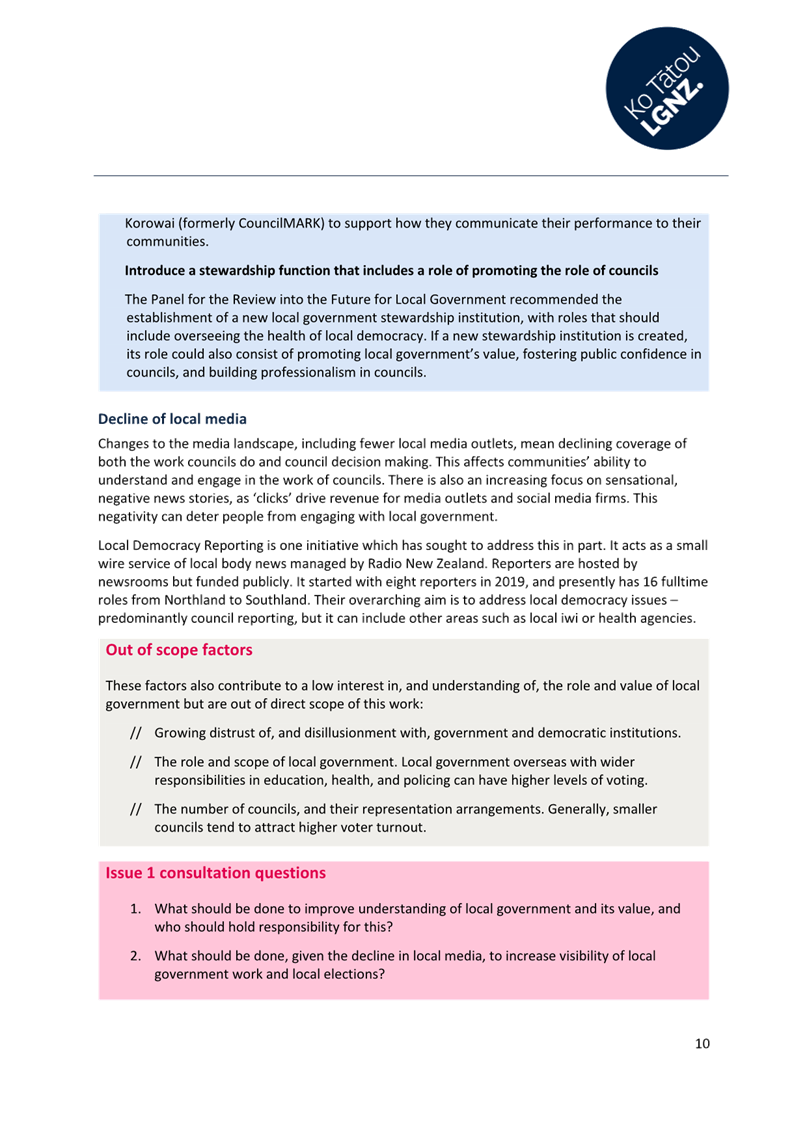
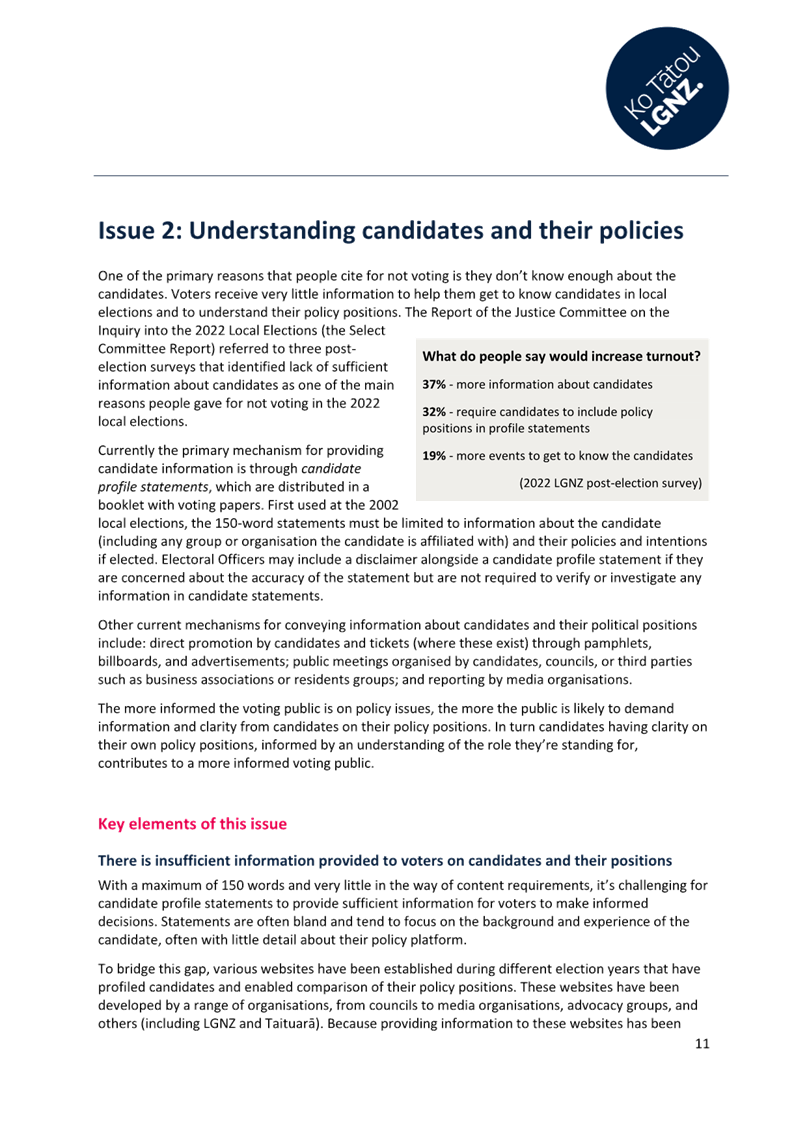
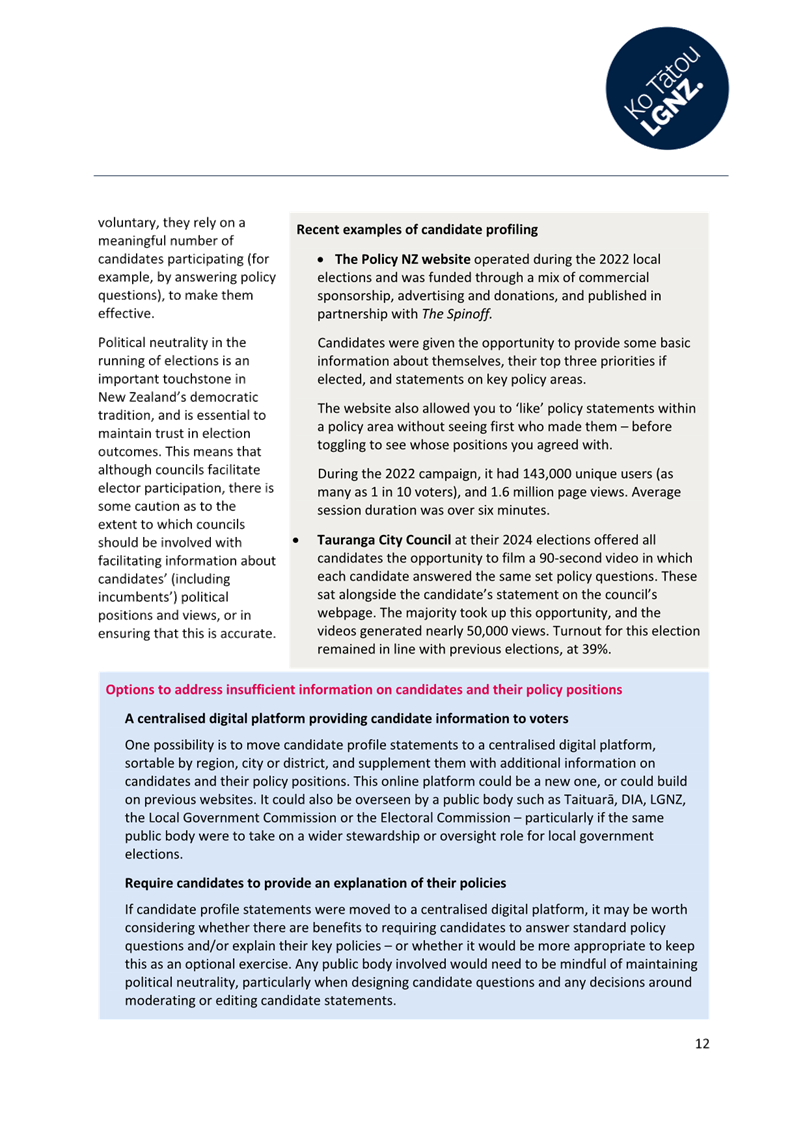
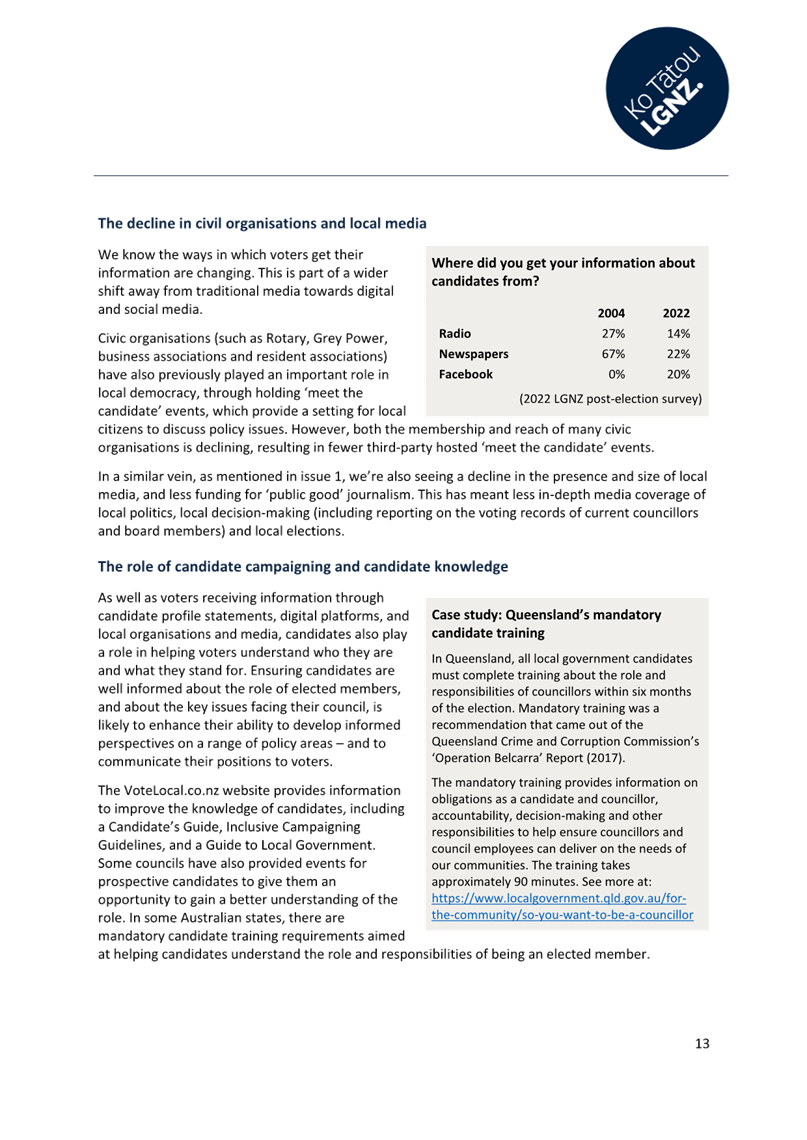
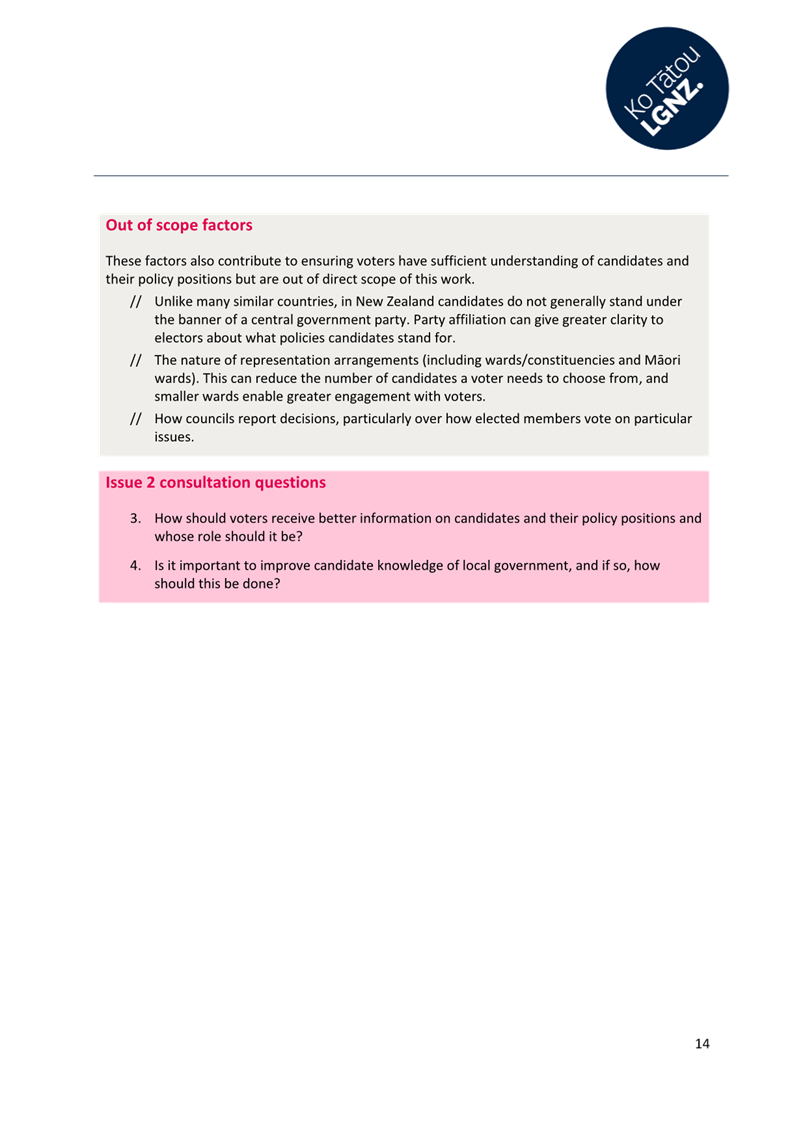
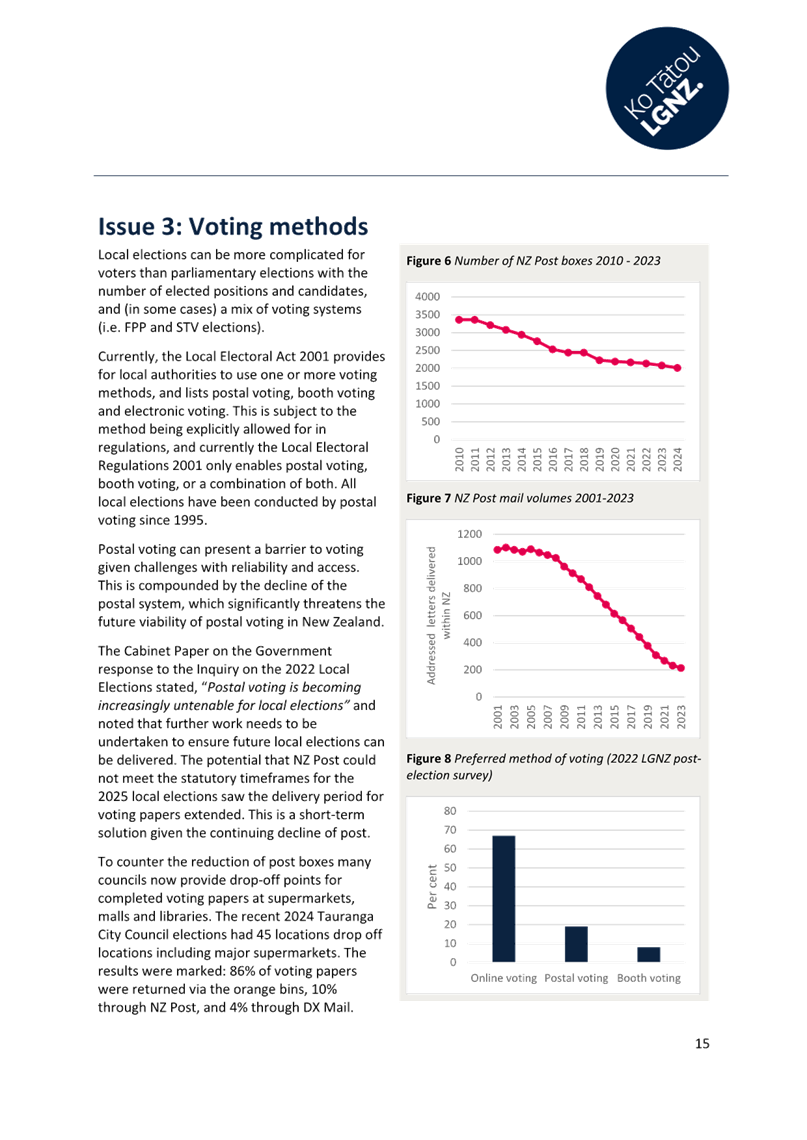
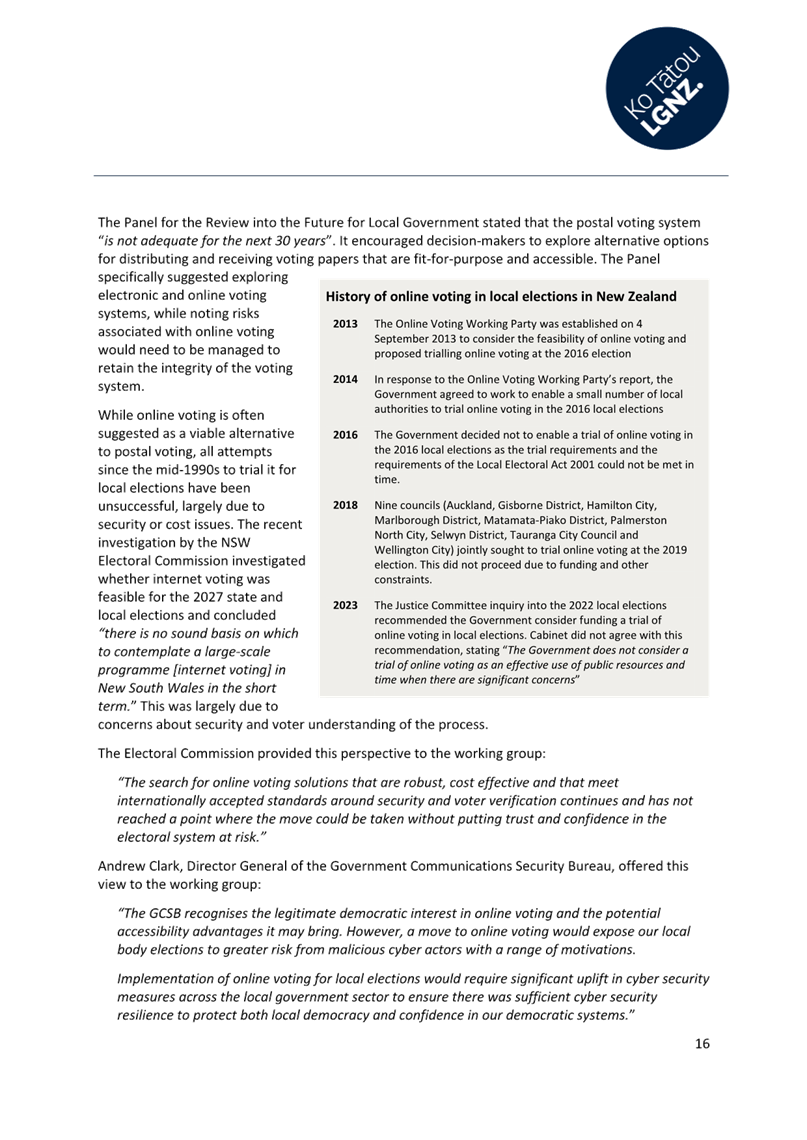
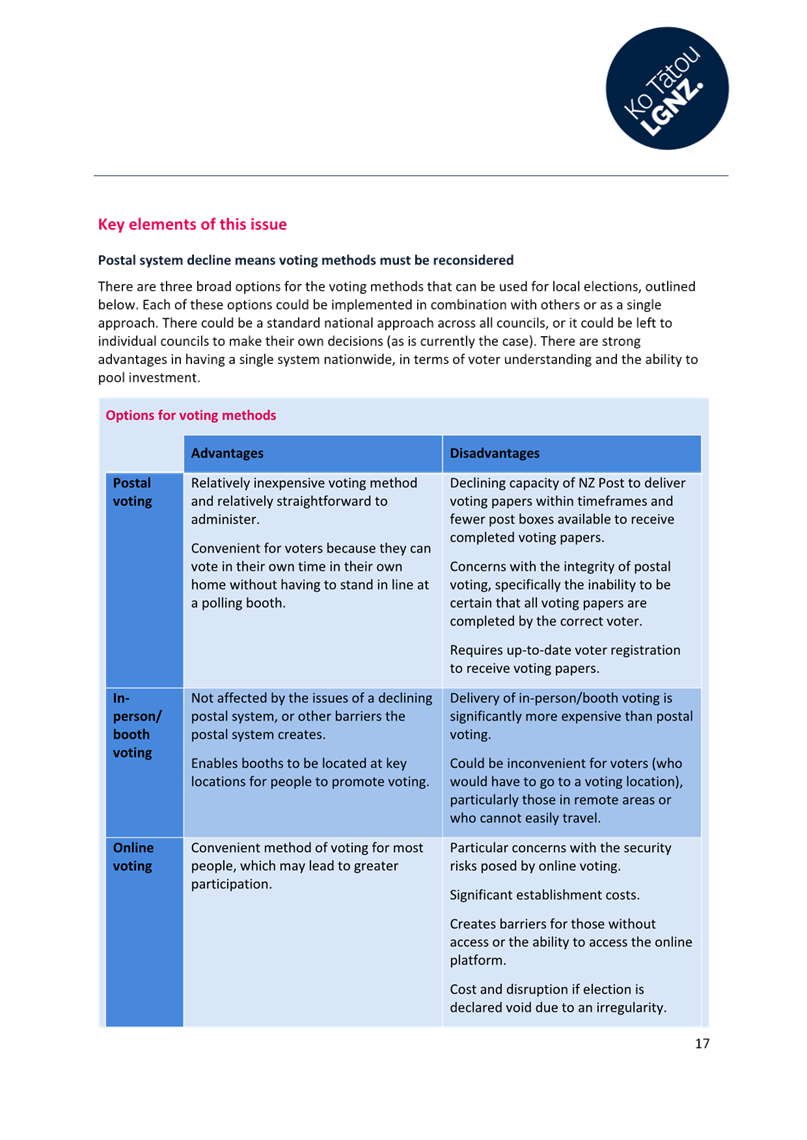
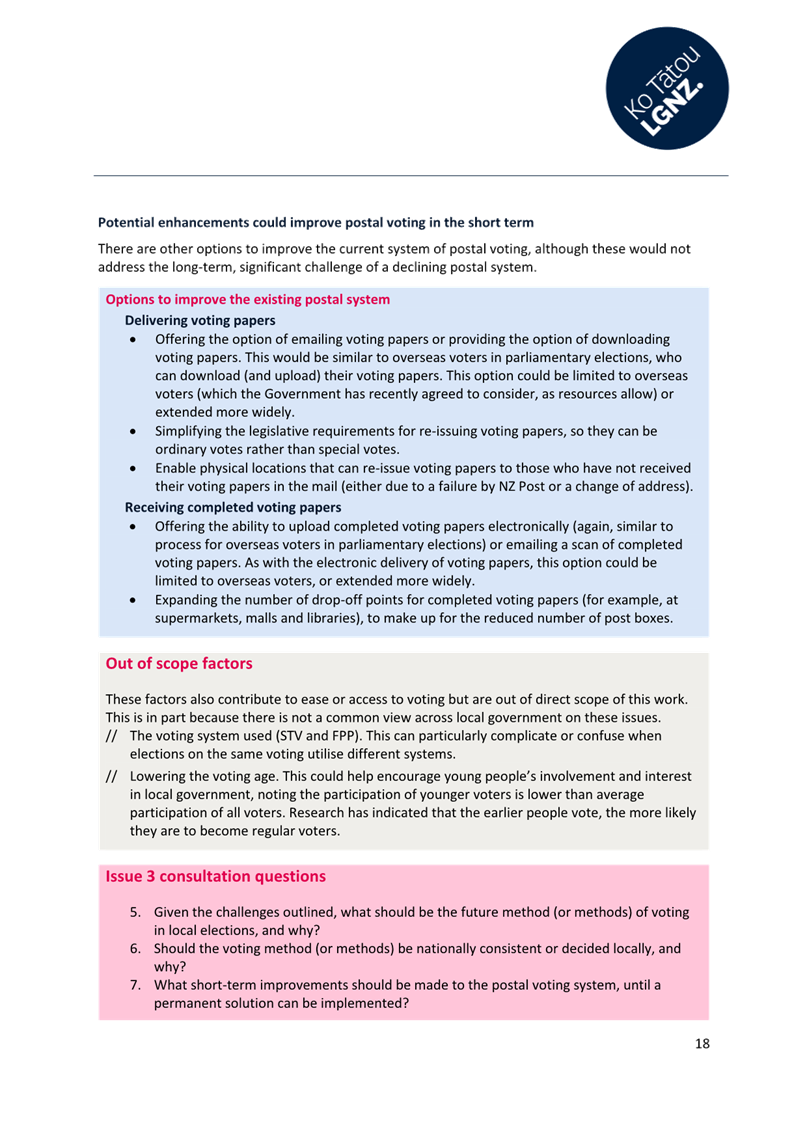
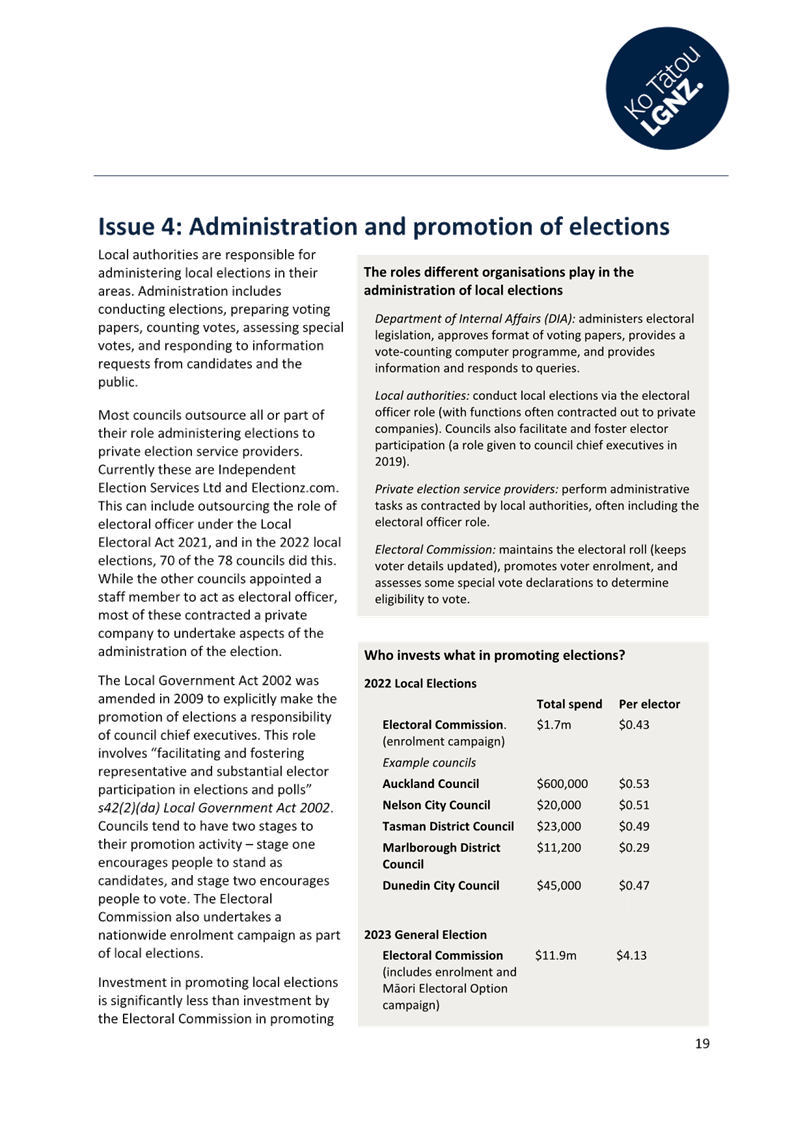
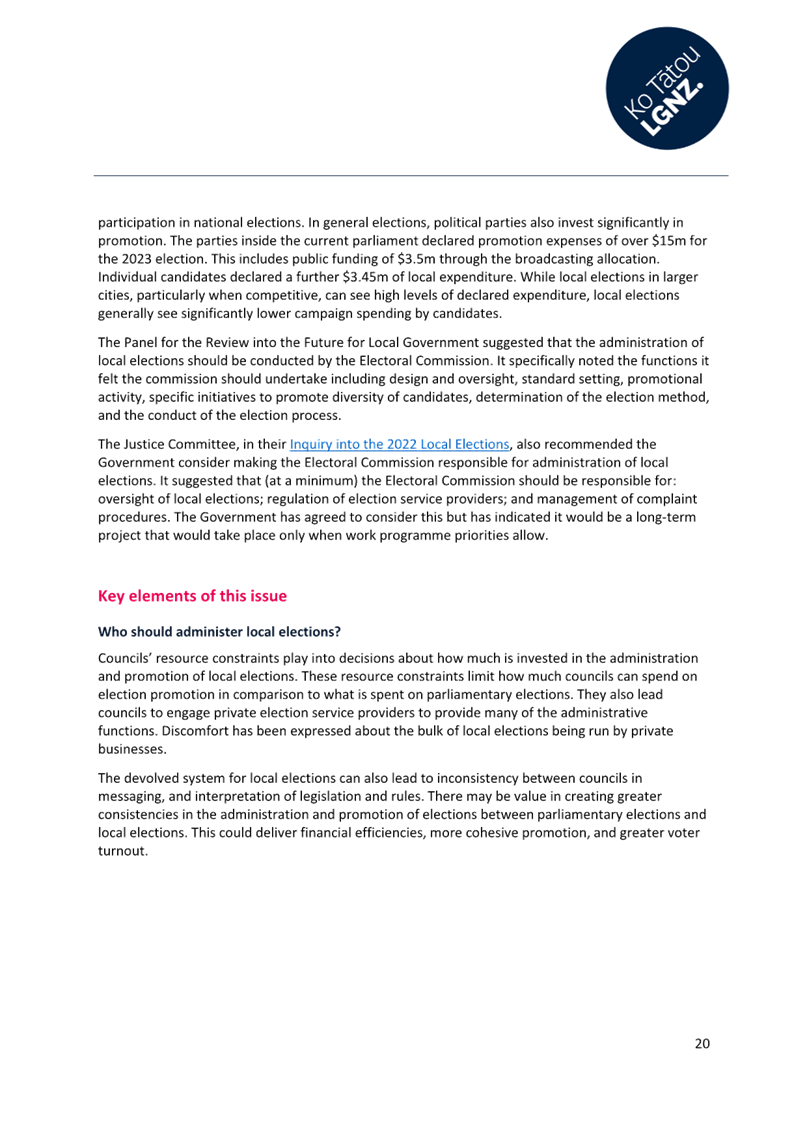
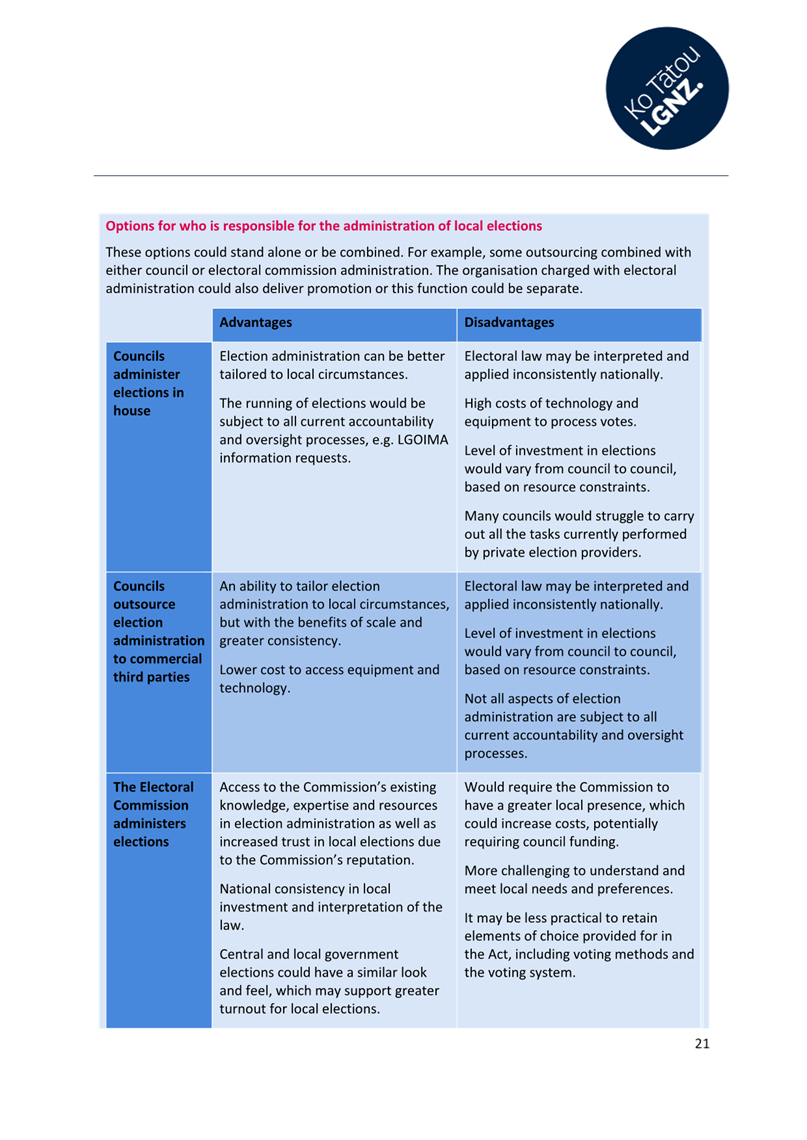
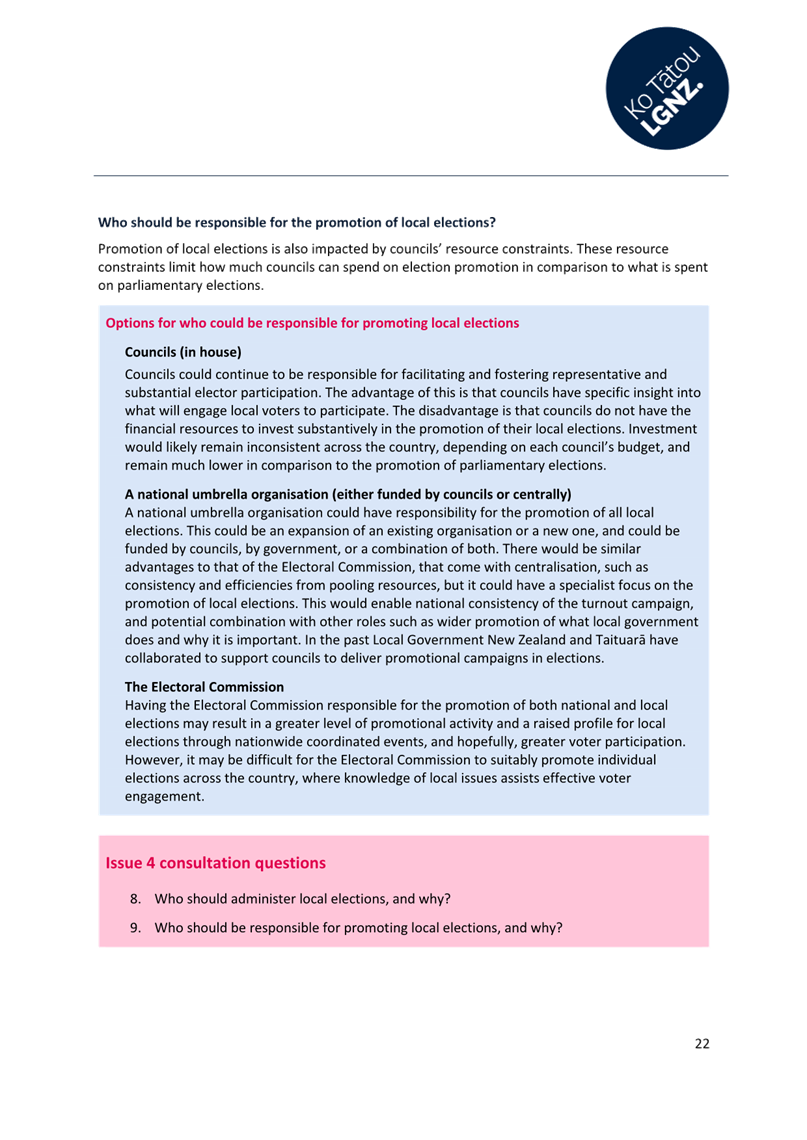
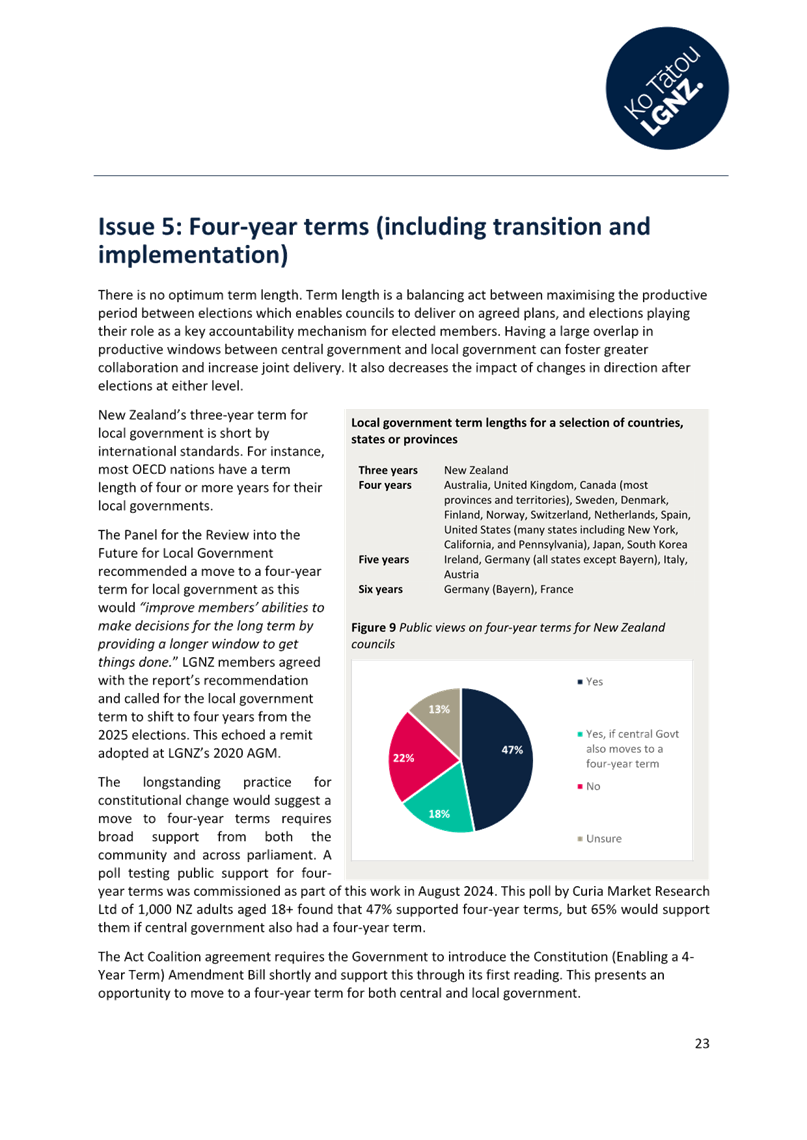
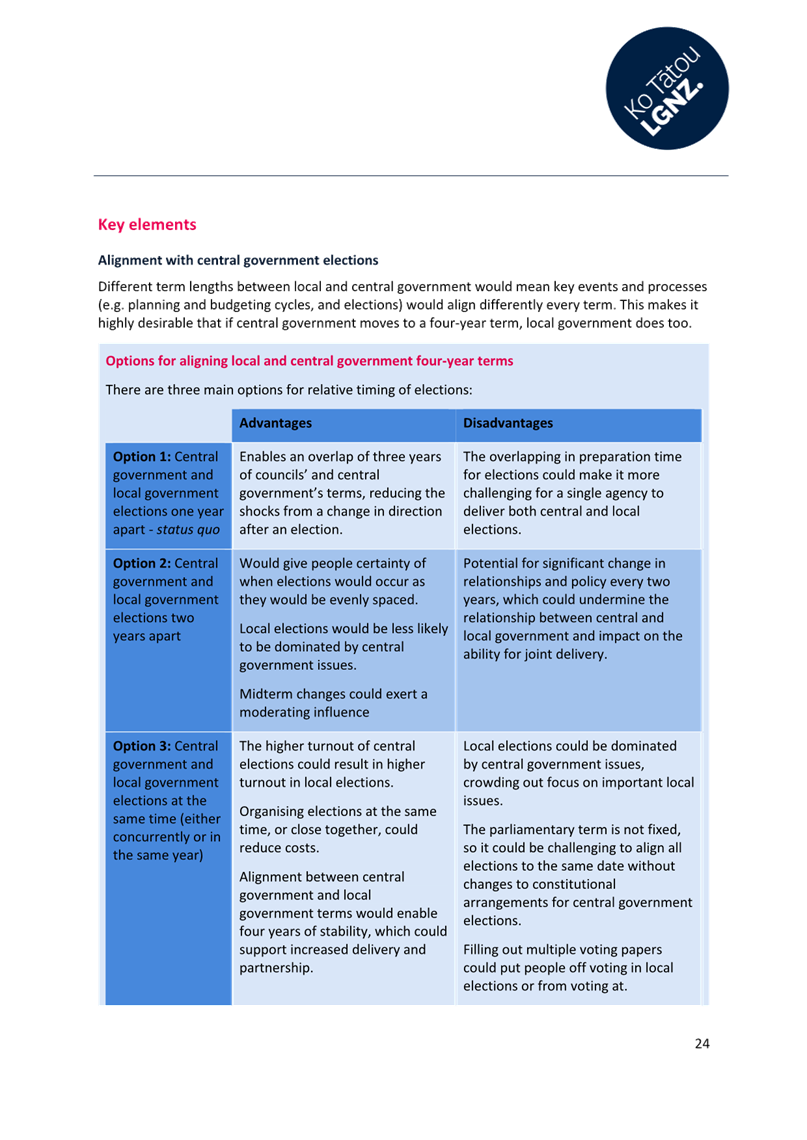
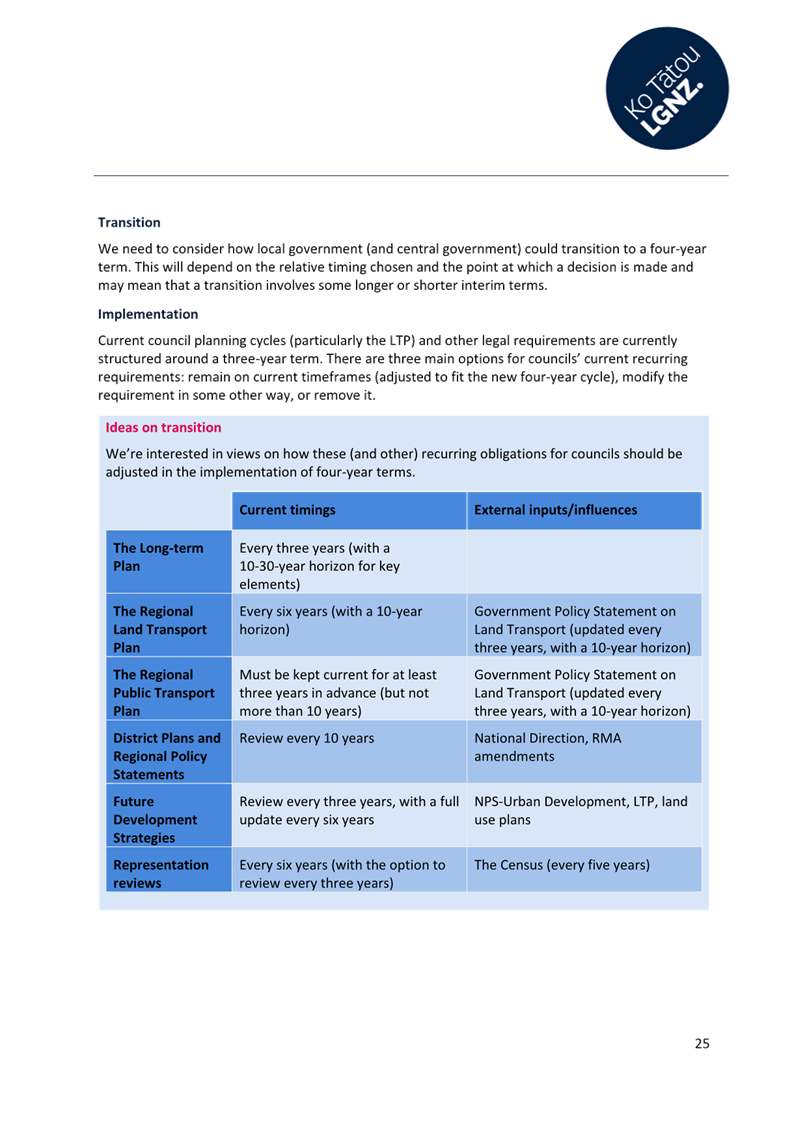
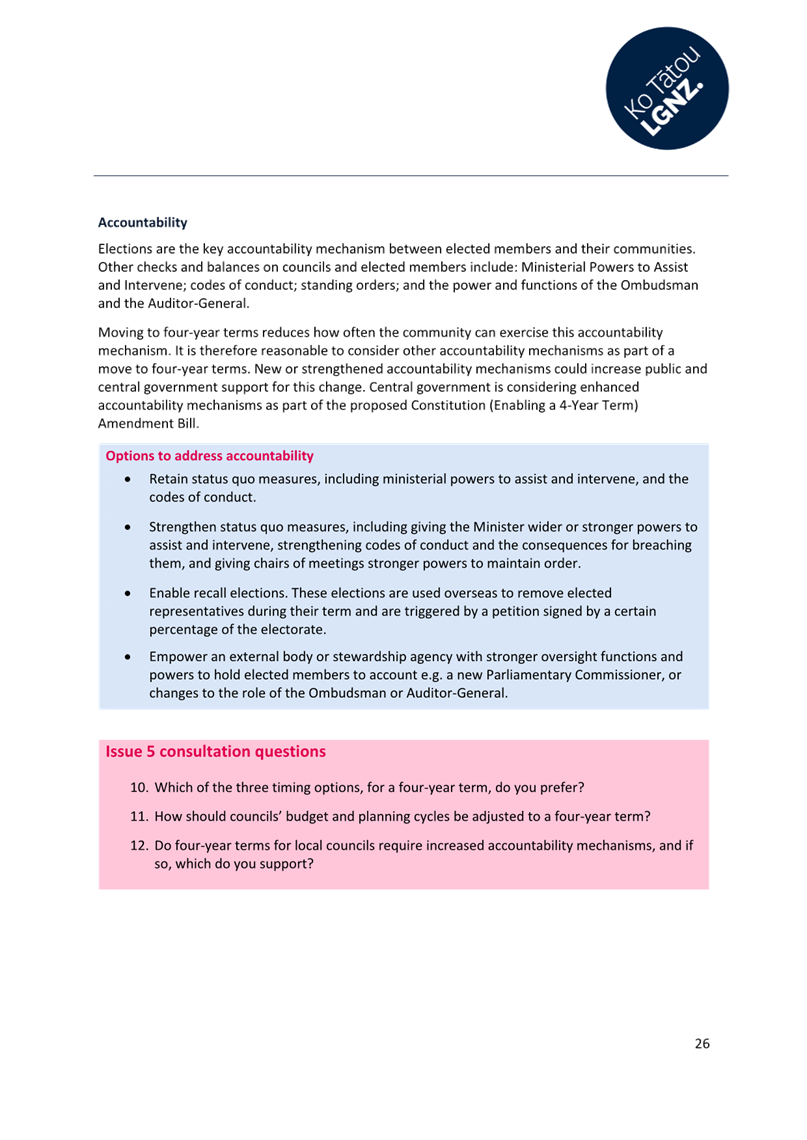
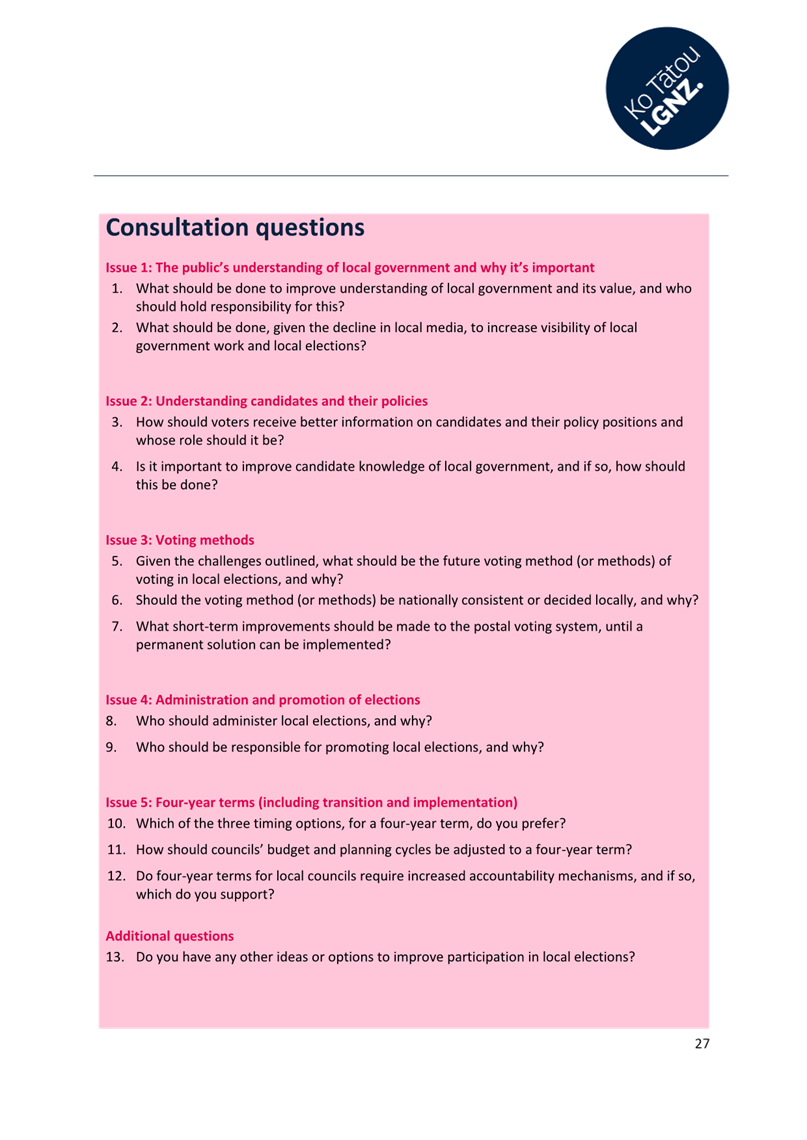

|
Ordinary Council meeting Agenda
|
9 December 2024
|
12 Discussion of late
items
|
Ordinary Council meeting Agenda
|
9 December 2024
|
13 Public excluded
session
Resolution to exclude
the public
|
Recommendations
That the public be
excluded from the following parts of the proceedings of this meeting.
The general subject
matter of each matter to be considered while the public is excluded, the
reason for passing this resolution in relation to each matter, and the
specific grounds under section 48 of the Local Government Official
Information and Meetings Act 1987 for the passing of this resolution are as
follows:
|
General subject of each matter to be
considered
|
Reason for passing this resolution in
relation to each matter
|
Ground(s) under section 48 for the
passing of this resolution
|
|
13.1 - Public Excluded Minutes of the
Council meeting held on 29 October 2024
|
s7(2)(a) - The withholding of the information is
necessary to protect the privacy of natural persons, including that of
deceased natural persons
s7(2)(b)(i) - The withholding of the information
is necessary to protect information where the making available of the
information would disclose a trade secret
s7(2)(b)(ii) - The withholding of the information
is necessary to protect information where the making available of the
information would be likely unreasonably to prejudice the commercial
position of the person who supplied or who is the subject of the
information
s7(2)(c)(i) - The withholding of the information
is necessary to protect information which is subject to an obligation of
confidence or which any person has been or could be compelled to provide
under the authority of any enactment, where the making available of the
information would be likely to prejudice the supply of similar information,
or information from the same source, and it is in the public interest that
such information should continue to be supplied
s7(2)(h) - The withholding of the information is
necessary to enable Council to carry out, without prejudice or
disadvantage, commercial activities
s7(2)(i) - The withholding of the information is
necessary to enable Council to carry on, without prejudice or disadvantage,
negotiations (including commercial and industrial negotiations)
|
s48(1)(a) - the public conduct of the relevant
part of the proceedings of the meeting would be likely to result in the
disclosure of information for which good reason for withholding would exist
under section 6 or section 7
|
|
13.2 - Public Excluded Minutes of the
Council meeting held on 12 November 2024
|
s7(2)(a) - The withholding of the information is
necessary to protect the privacy of natural persons, including that of
deceased natural persons
s7(2)(b)(ii) - The withholding of the information
is necessary to protect information where the making available of the
information would be likely unreasonably to prejudice the commercial
position of the person who supplied or who is the subject of the information
s7(2)(g) - The withholding of the information is
necessary to maintain legal professional privilege
s7(2)(h) - The withholding of the information is
necessary to enable Council to carry out, without prejudice or
disadvantage, commercial activities
s7(2)(i) - The withholding of the information is
necessary to enable Council to carry on, without prejudice or disadvantage,
negotiations (including commercial and industrial negotiations)
|
s48(1)(a) - the public conduct of the relevant
part of the proceedings of the meeting would be likely to result in the
disclosure of information for which good reason for withholding would exist
under section 6 or section 7
|
|
13.3 - Waste Infrastructure Programme
Business Case Options
|
s7(2)(b)(ii) - The withholding of the information
is necessary to protect information where the making available of the
information would be likely unreasonably to prejudice the commercial
position of the person who supplied or who is the subject of the
information
s7(2)(h) - The withholding of the information is
necessary to enable Council to carry out, without prejudice or
disadvantage, commercial activities
s7(2)(i) - The withholding of the information is
necessary to enable Council to carry on, without prejudice or disadvantage,
negotiations (including commercial and industrial negotiations)
|
s48(1)(a) - the public conduct of the relevant
part of the proceedings of the meeting would be likely to result in the
disclosure of information for which good reason for withholding would exist
under section 6 or section 7
|
|
13.4 - Digital Services Funding Update
|
s7(2)(a) - The withholding of the information is
necessary to protect the privacy of natural persons, including that of
deceased natural persons
|
s48(1)(a) - the public conduct of the relevant
part of the proceedings of the meeting would be likely to result in the
disclosure of information for which good reason for withholding would exist
under section 6 or section 7
|
|
13.5 - Appointment of Independent
Chairperson Audit and Risk Committee
|
s7(2)(a) - The withholding of the information is
necessary to protect the privacy of natural persons, including that of
deceased natural persons
|
s48(1)(a) - the public conduct of the relevant
part of the proceedings of the meeting would be likely to result in the
disclosure of information for which good reason for withholding would exist
under section 6 or section 7
|
|
13.6 - Sale of Marine Precinct - Legal
Update
|
s7(2)(g) - The withholding of the information is
necessary to maintain legal professional privilege
s7(2)(h) - The withholding of the information is
necessary to enable Council to carry out, without prejudice or
disadvantage, commercial activities
s7(2)(i) - The withholding of the information is
necessary to enable Council to carry on, without prejudice or disadvantage,
negotiations (including commercial and industrial negotiations)
|
s48(1)(a) - the public conduct of the relevant
part of the proceedings of the meeting would be likely to result in the
disclosure of information for which good reason for withholding would exist
under section 6 or section 7
|
|
Confidential Attachment 1 - 11.1 -
Civic Whare, Exhibition and Museum (CWEM) Project Update and Next Steps
|
s7(2)(h) - The withholding of the information is
necessary to enable Council to carry out, without prejudice or
disadvantage, commercial activities
|
s48(1)(a) the public conduct of the relevant part
of the proceedings of the meeting would be likely to result in the
disclosure of information for which good reason for withholding would exist
under section 6 or section 7
|
|
Confidential Attachment 3 - 11.1 -
Civic Whare, Exhibition and Museum (CWEM) Project Update and Next Steps
|
s7(2)(h) - The withholding of the information is
necessary to enable Council to carry out, without prejudice or
disadvantage, commercial activities
|
s48(1)(a) the public conduct of the relevant part
of the proceedings of the meeting would be likely to result in the
disclosure of information for which good reason for withholding would exist
under section 6 or section 7
|
|
Confidential Attachment 4 - 11.1 -
Civic Whare, Exhibition and Museum (CWEM) Project Update and Next Steps
|
s7(2)(h) - The withholding of the information is
necessary to enable Council to carry out, without prejudice or
disadvantage, commercial activities
|
s48(1)(a) the public conduct of the relevant part
of the proceedings of the meeting would be likely to result in the
disclosure of information for which good reason for withholding would exist
under section 6 or section 7
|
|
Confidential Attachment 7 - 11.1 -
Civic Whare, Exhibition and Museum (CWEM) Project Update and Next Steps
|
s7(2)(h) - The withholding of the information is
necessary to enable Council to carry out, without prejudice or
disadvantage, commercial activities
|
s48(1)(a) the public conduct of the relevant part
of the proceedings of the meeting would be likely to result in the
disclosure of information for which good reason for withholding would exist
under section 6 or section 7
|
|
|
Ordinary Council meeting Agenda
|
9 December 2024
|
14 Closing karakia






















































































































